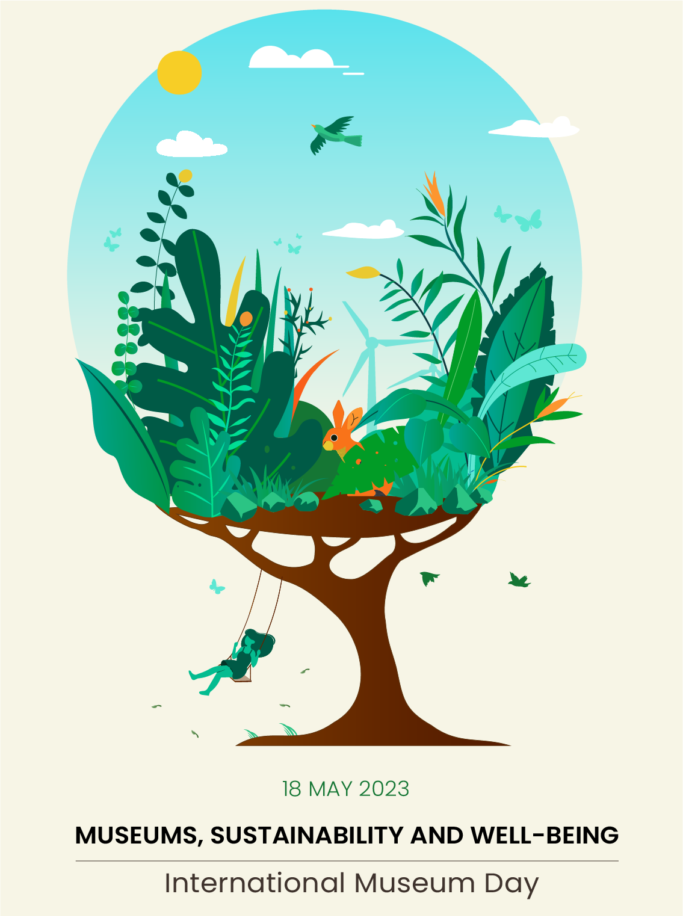

kingdom of time
Jordan is a country of hikers and historians, scientists and artists, foodies and yoga-fiends. Whatever your tribe, you’ll find a kindred spirit here.
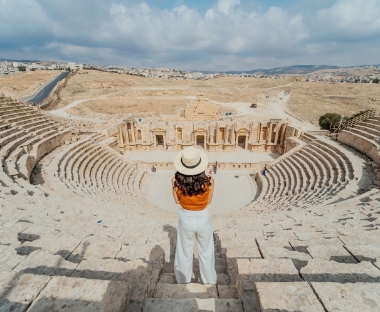
every moment, a treasure.
Explore a wide range of museums throughout the kingdom presenting the history and cultural heritage of Jordan.
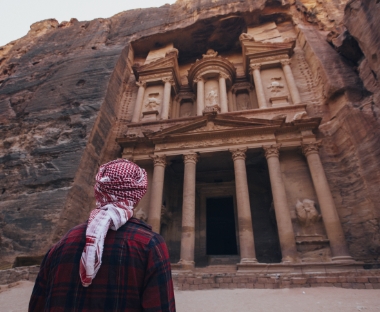
carved by millennia. braved by you.
The Jordan pass is the ultimate sightseeing package that has been especially tailor-made for visitors to the country.
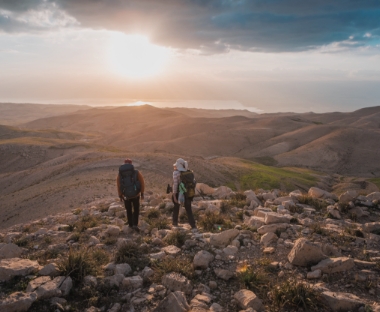
hike history. touch time.
a long-distance hiking trail in Jordan connecting the length of Jordan from Um Qais in the north to Aqaba in the south.
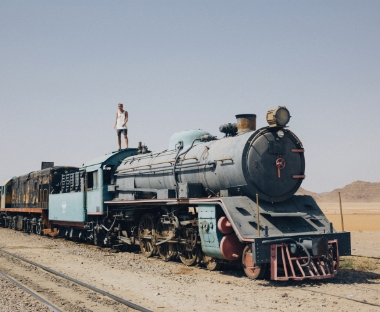
find your tribe.
A great collection of working steam locomotives, formerly used as part of a pilgrimage route and an intrinsic part of the Great Arab Revolt.
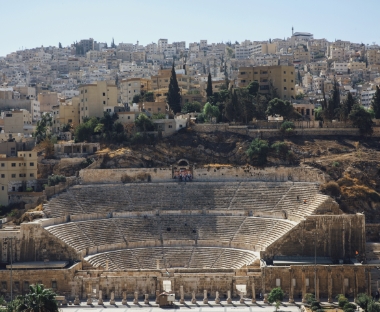
in the footsteps of myths and men.
One of the most lively and authentic parts of Amman consisting of fascinating historical sites of the Roman Theatre and Citadel.

life at your own pace.
The lowest point on earth and a natural wonder, is a warm, soothing, super salty water surrounded be desert beaches, mineral spas and oases.

Local Recommendations
Your tour to jordan via bright trip.
Everything you need to know to take your trip to the next level. In this free guide, you will learn how to travel Jordan with confidence and discover the best places to visit.
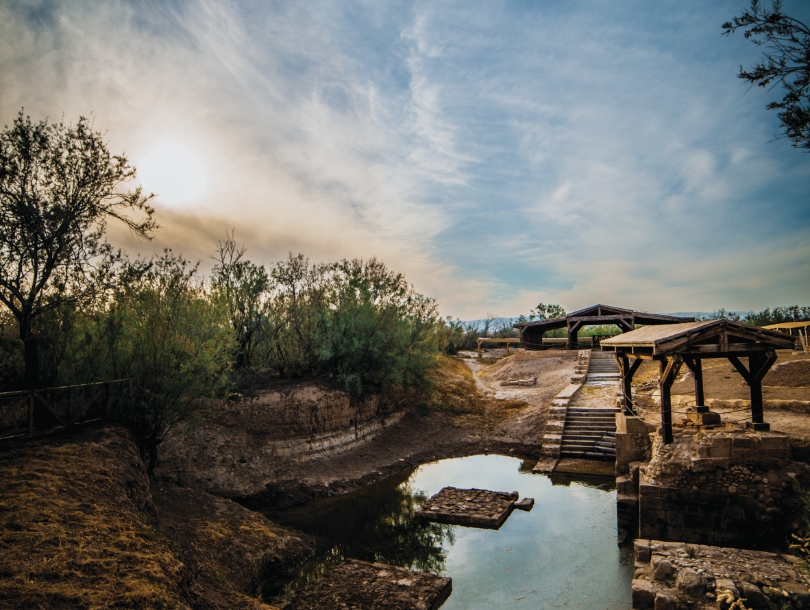
Experiencing Bethany Beyond the Jordan
Bethany Beyond the Jordan, a peaceful holy site, is a rare exception. A meditative place that is perfect for contemplation, exploration, and learning, this place is a hidden gem in the Holy Land. Read on to learn what it’s like to visit it today!
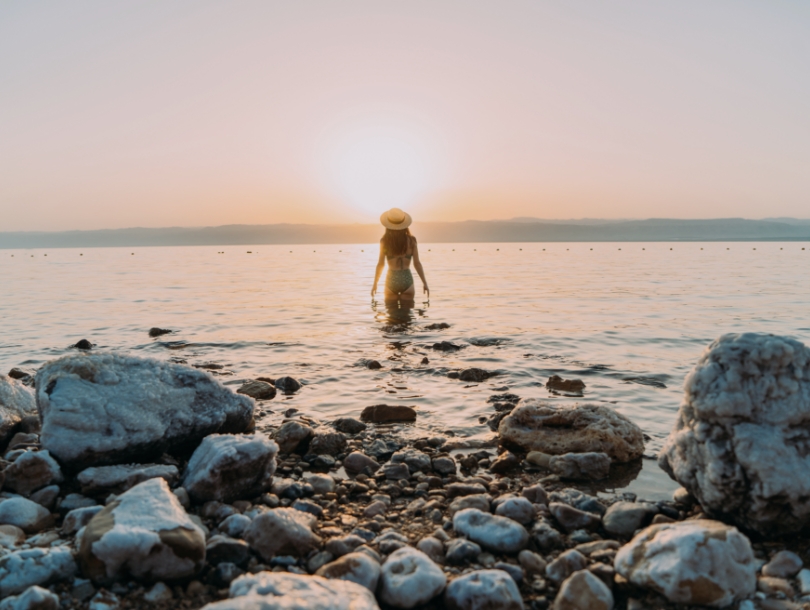
The Dead Sea Serenity & Sunshine
Time to unwind! If you’re looking to get pampered in a way unlike any other, then the Dead Sea is the spot for you. With a wide array of extravagant hotels and resorts, choosing to get your dose of relaxation here comes with its benefits.
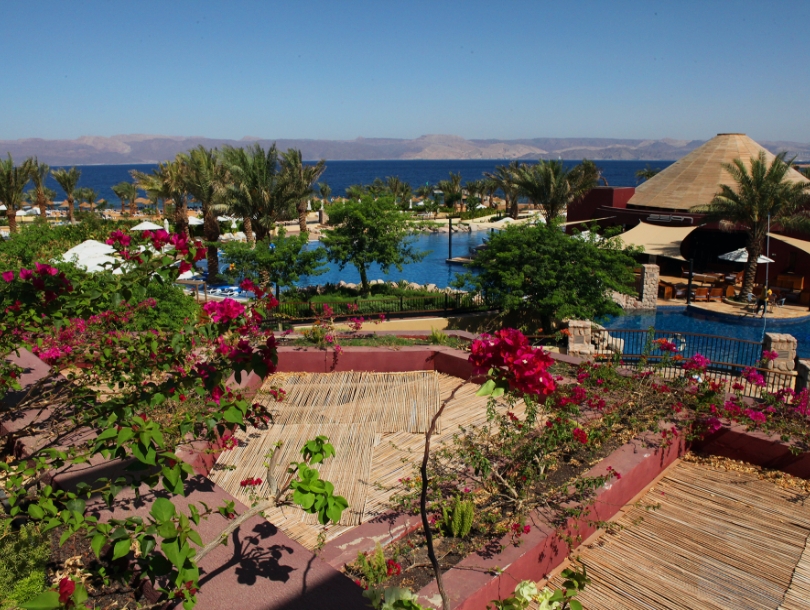
72 Hours in Aqaba
When you think of Jordan, desert landscapes and age-old cities likely come to mind. Lesser known is this country’s southernmost resort town, where the red-brown mountains are cut off by a startlingly blue sea.
plan your trip now to experience the vibrancy of contrasts that is Jordan
The Jordan Pass
Virtual Travel Assistant
Getting Around

social wall
See what other travelers are doing in Jordan right now and if you use #VisitJordan on your social media posts you might see yourself up here too!

Calendar.jo
Jordan museums
Royal Jordanian

Jordan Travel Guide
The kingdom of Jordan is emerging as one of the most popular countries to visit in the Middle East.
The highlight of any trip to Jordan is Petra , the hidden city in the rock. This is an incredible ancient town carved into the rocks in southern Jordan, and it can be explored by foot or on the back of a camel.
Another popular attraction in Jordan is the desert valley of Wadi Rum , where you can take a jeep tour around the orange sand dunes and huge granite mountains.
Read through this complete Jordan travel guide for more info on what to expect!
Quick Facts
Arabic; 'Thank you' is 'shoukran'
Jordanian Dinar (JOD)
Visa on arrival for most nationalities
Arid; hot & dry year round. Coolest months are Nov - Mar
Power Plugs
Type C / D / F / G / J
Uber, Careem
The main international airport in Jordan is in Amman (AMM), which has direct flights from many countries around the world. There's also an airport in Aqaba (AQJ) if you want to fly in closer to Petra, although it doesn't have as many flight options as Amman.
You can shop for flights to Jordan on Skyscanner.
Jordan is a relatively safe place to travel, with a very low violent crime rate from the UN of 1.6 per 100k inhabitants (75% lower than the global average). Attitudes toward foreigners are welcoming.
I'd still recommend you try to avoid crowds and practice situational awareness; terrorist attacks have occurred near some tourist areas in Jordan over the years, but it's not common.
The other thing to note is that Jordanian culture is conservative, so clothing in public should be modest.
The climate of Jordan is generally arid, with hot summers and cool, short winters. The coolest months are from November to March, and this is probably the most popular time for tourists to visit, but honestly any month of the year is fine for visiting sights in the south like Petra or Wadi Rum.
I went in October, and the heat was not an issue at all, especially in the mornings. Jordan is not nearly as hot as nearby Middle Eastern countries like Qatar and the United Arab Emirates .
Jordan can be a budget friendly travel destination, but it's a bit more expensive than Egypt. Hostels are available from 5 Jordanian Dinar ($7 USD) and private hotels from 20 Dinars . Meals cost about 6 to 10 Dinars depending on location.
Transportation in Jordan is generally by car, and these can be rented, but hiring a driver is sometimes preferable. Transportation apps like Uber and Careem are available, but use these discreetly because they're not appreciated by the taxi industry.
The best Jordan tours & activities
The Hidden City
My latest blog posts about Jordan
Wadi Rum Desert: Epic Jeep Tour In Jordan
The vast, surreal desert landscape of Wadi Rum Jordan in the Middle East has been featured in a lot of famous Hollywood movie sets. Exploring the Mars-like …
Petra Jordan Travel Guide: How To Visit The Lost City
The lost city of Petra Jordan is one of the best places to visit in the Middle East. It’s relatively safe and affordable, and there are some …
Is Jordan Safe? Is It Safe To Travel To Petra? (Yes!)
Jordan is emerging as one of the most popular countries to visit in the Middle East, with good food, a healthy dose of culture shock, amazing desert …
Get In Touch
Feel free to contact me if you have travel questions, comments, or suggestions! I'll try to get back to you!

- The Ultimate Jordan Travel Guide for First Time Visitors
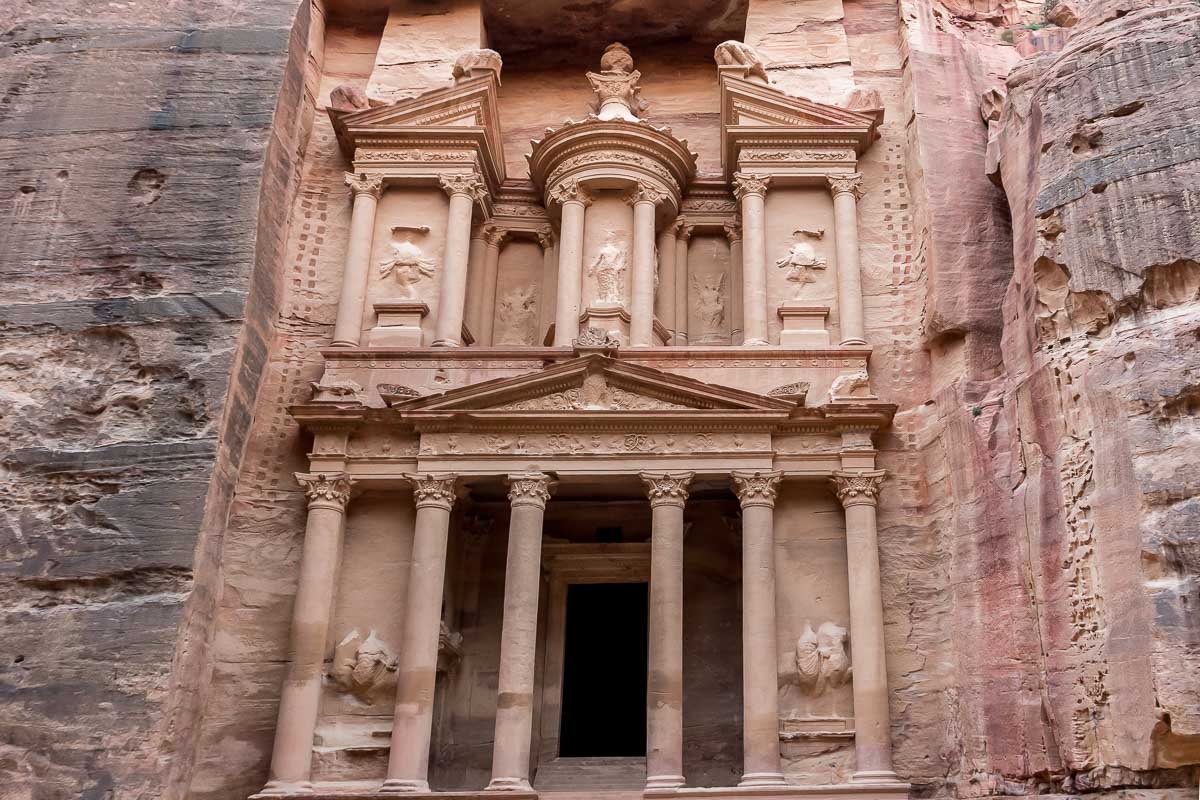
Jordan was my first trip to the Middle East and it quickly became one of my all-time favorite destinations!
This country really has it all: if you are looking for dramatic landscapes, amazing red sand dunes, one of the New Seven Wonders of the World, the lowest point on Earth, amazing local food, and friendly people then you have come to the right place!
In this Jordan travel guide, you can find all the information you need to know before visiting Jordan. Let’s get into it!
* Disclosure: This post contains a few affiliate links, which means I may receive a small commission, at no cost to you, if you make a purchase through my link. *
No time to read now? Pin it for later!
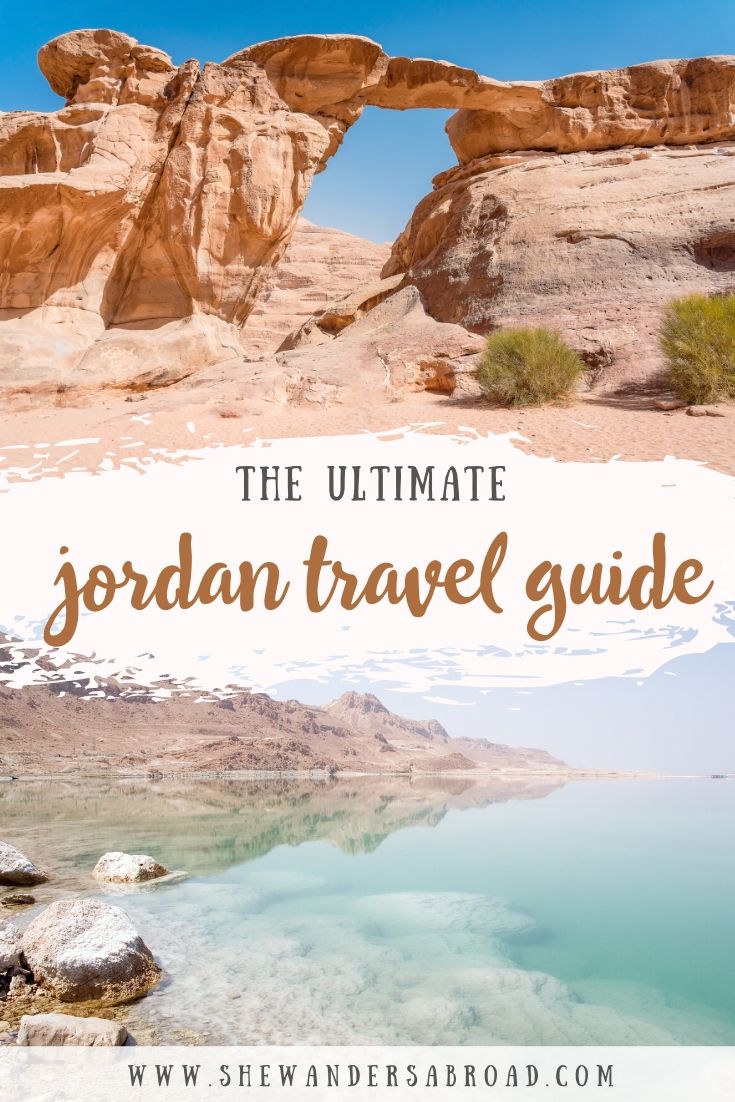
Table of Contents
How Much Time Do You Need to Spend in Jordan?
Well, this totally depends on you. Many people just want to visit Petra so they are border crossing from Israel for only one day. But Jordan deserves so much more than that! I would suggest planning at least 3-4 full days to have enough time to cover the most famous spots.
Originally I wanted to do the same and while it’s totally doable, I realized I don’t want to rush over the whole country in just a few days. I’ve decided to spend one week in Jordan instead and after having done that I would say this is definitely the best option!
You will have a decent amount of time for the must-see places plus you can include some fun activities and some relaxing time as well.
If you want to spend more than one day in Petra or the Wadi Rum desert, or you want to see some more off-the-beaten places, spending 10 days in Jordan is ideal.
To be honest, even if you would spend 2 weeks there you wouldn’t get bored so it really depends on your own preferences!
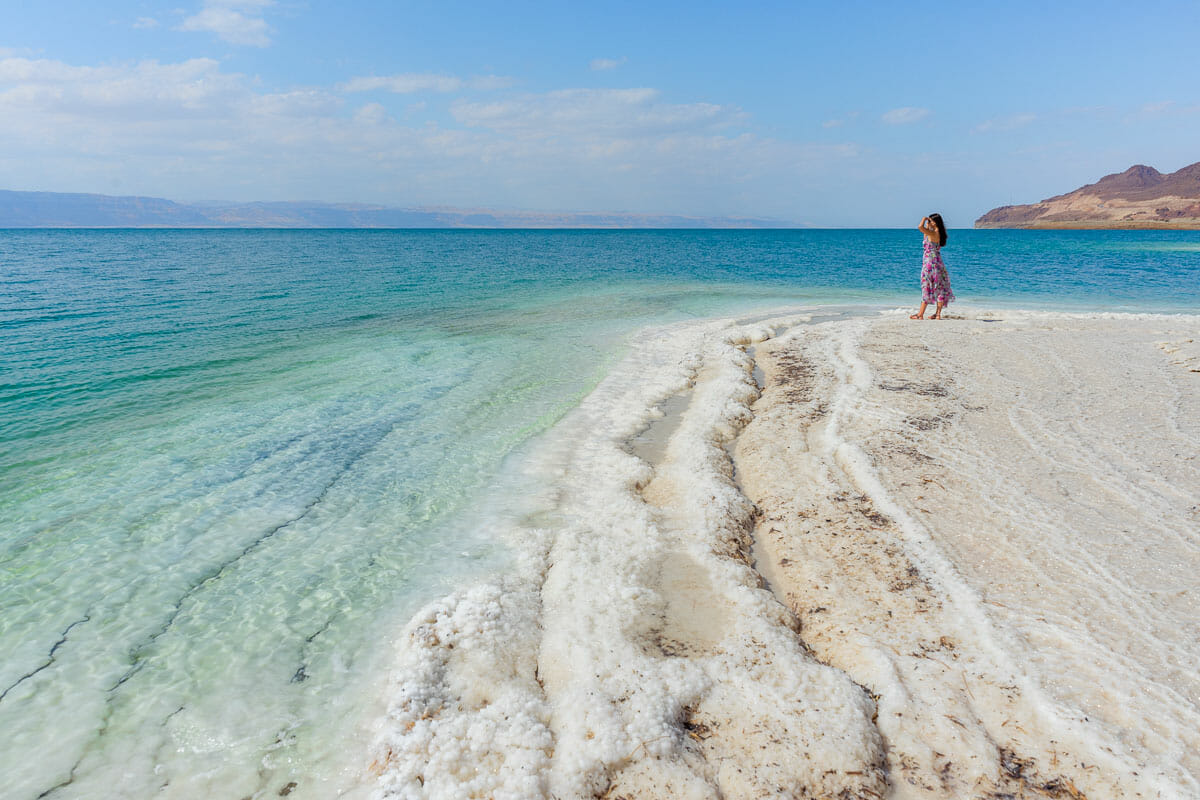
Best Time to Visit Jordan
Jordan is a year-round destination, the best time highly depends on what type of activities you’re looking for. It’s important to know that the country may be small, but due to its topography, you can expect different weather conditions across the land.
That means you can experience some rainy and chilly days in Amman but you can work on your tan at the same time in the sunny Aqaba.
Spring (March-May) is one of the best options to visit Jordan. The weather is already pleasant in the mid-20 degrees with lots of sunshine, which is perfect for hiking and sightseeing. Springtime is really magical as the whole country is carpeted with wildflowers, even the desert!
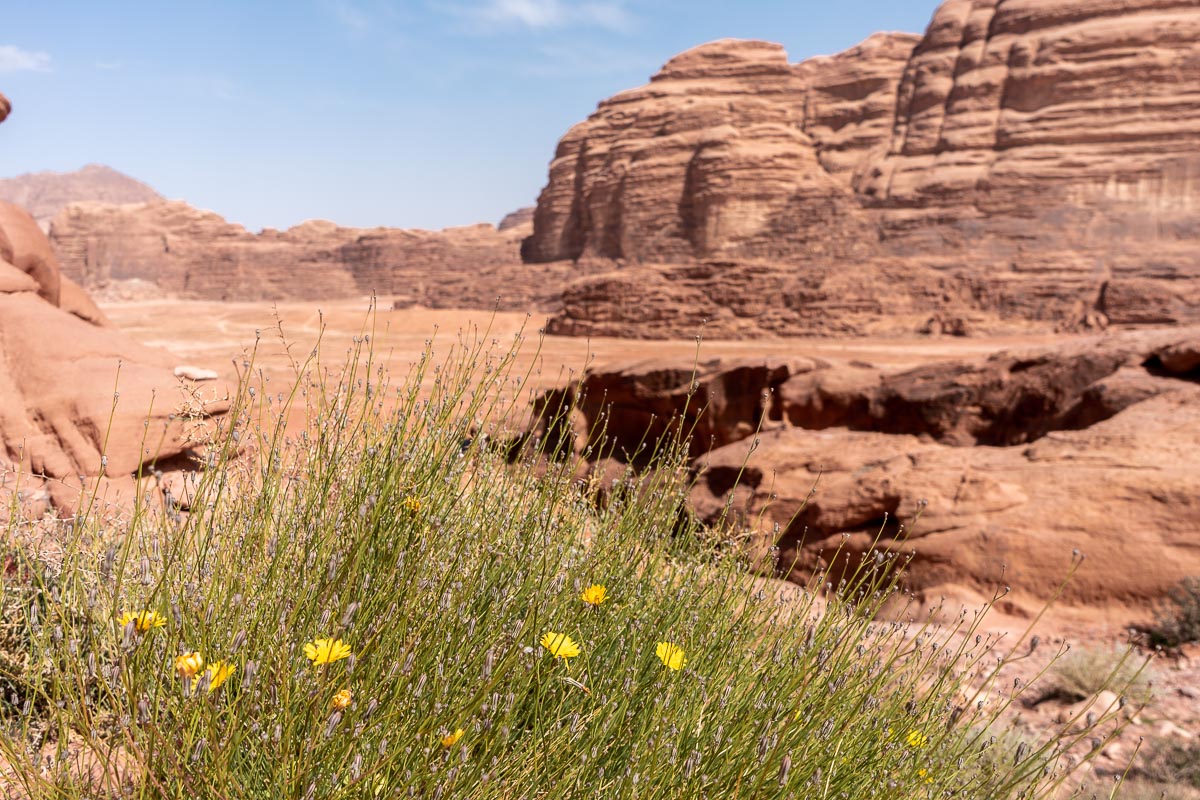
The summer months (June-August) in Jordan are insanely hot and dry, the temperature can easily rise up to 40 degrees. Unless you are planning to chill all day long by the pool, I wouldn’t recommend this time for traveling.
Autumn (September-November) can be another great time for visiting as the temperature begins to drop in mid-September. This time is especially great if you are interested in diving in Aqaba.
The winter in Jordan (December-February) is generally short and cold. The temperature usually drops below freezing in the North and snow is not uncommon either.
All the popular sites will be quite empty so if you want to explore without the crowds and you can bear the cold, winter can still be a good choice for you, especially if you would like to experience Christmas in Jordan .
Visa in Jordan
Every visitor should obtain a visa. It can be purchased at the international airports and most the land borders for 40 JD ($56 US).
However, if you decide to buy the Jordan Pass it already covers the visa and it gives you free access to many sites, including the famous Petra.
The visa fee is waived on the condition that you stay at least 3 nights in Jordan (bad news for border hoppers).
If you are planning to visit Petra I recommend choosing the Jordan Pass. If you would choose to buy the one-day Petra ticket separately, it would cost you 50 JD ($70 US).
You would pay another 40 JD ($56 US) for the visa, so your total cost would be 90 JD ($126 US). The cheapest option of the Jordan Pass is 70 JD ($100 US) and it already includes the visa and a one-day pass to Petra.
You can choose a multiple-day Pass as well if you plan to stay longer in Petra.
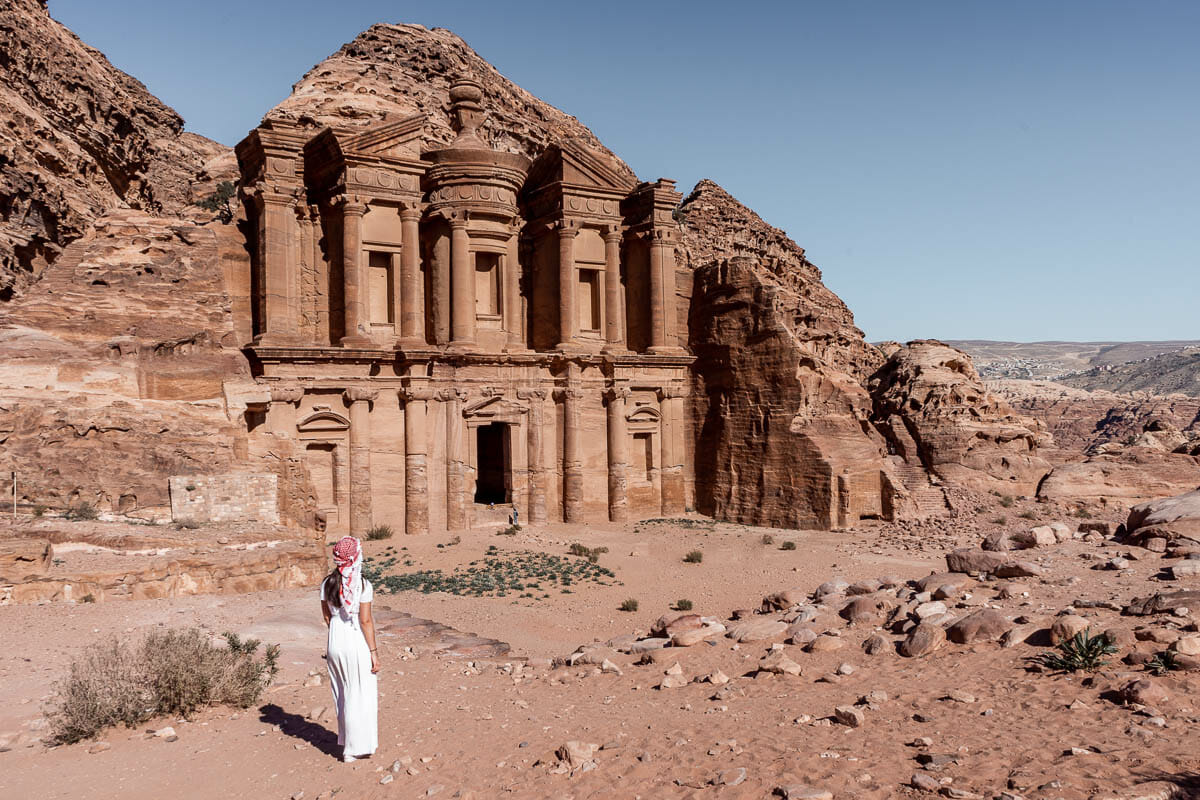
Money in Jordan
When I first heard about Jordan I thought it would be a budget destination. I couldn’t have been more wrong about that! Jordan is quite an expensive country, even comparing it to European or American standards.
The official currency is the Jordanian dinar (JD). You can change money at banks, exchange offices or even at some hotels. Most of the major currencies are accepted but it’s easier to change US dollars, Euros, or UK pounds.
The US dollar rates are fixed ( $1 US = 0.7 JD) while the other currencies are subject to the current economical conditions.
I would recommend bringing US dollars to Jordan and then changing it to dinars once you’re there. It’s possible to change dinars back to any foreign currency if you don’t need them anymore.
ATMs are available throughout the country and credit cards are widely accepted. However, there are no ATMs in places like the Wadi Rum desert or Petra and you can only pay with cash in these areas.
We brought $350 US in cash with us and it was enough for the whole week (on top of the credit card payments, of course). We used it mostly in markets, smaller restaurants, and in the desert area.
If you’re interested to know more about the travel costs in Jordan, read my post about how much does it cost to spend one week in Jordan !
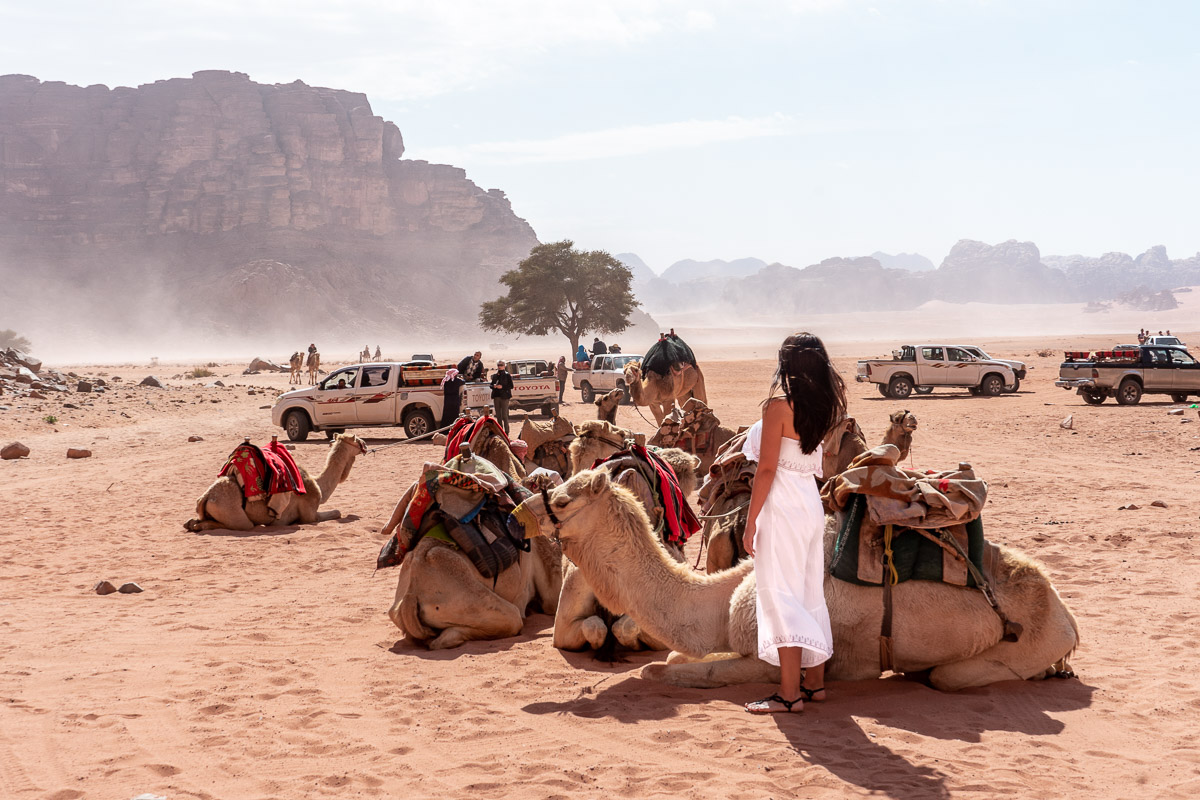
How to Get Around in Jordan
Public transportation only exists in bigger cities like Amman. Be aware that the public buses don’t follow a timetable, the bus will only depart once it’s fully loaded with passengers.
They have specific routes but there are no official bus stops. They will stop anywhere once you press the button and you can wave them down anywhere along the road if you want to get on. You can buy your tickets on the bus.
The other option is taking a tourist bus. The Jordan Express Tourist Transportation Company (JETT) operates many tourist buses across the country. They have a fixed schedule and they don’t stop en route.
If you want to travel with them, you have to purchase your ticket in advance. In case you prefer to travel privately, you can also opt for an organized tour or hire a private driver to take care of the transportation issue.
After checking many options we decided to rent a car. To be honest we were a bit afraid of driving in Jordan but as long as you can avoid the bigger cities you’ll be fine.
Most of the time you will be driving through empty highways and mountain roads. There are lots of tricky road bumps and some of the roads could be in better condition.
Oh and don’t be surprised if you find a horde of sheep (or goats) in the middle of the road! It’s just the normal traffic in the Jordan countryside.
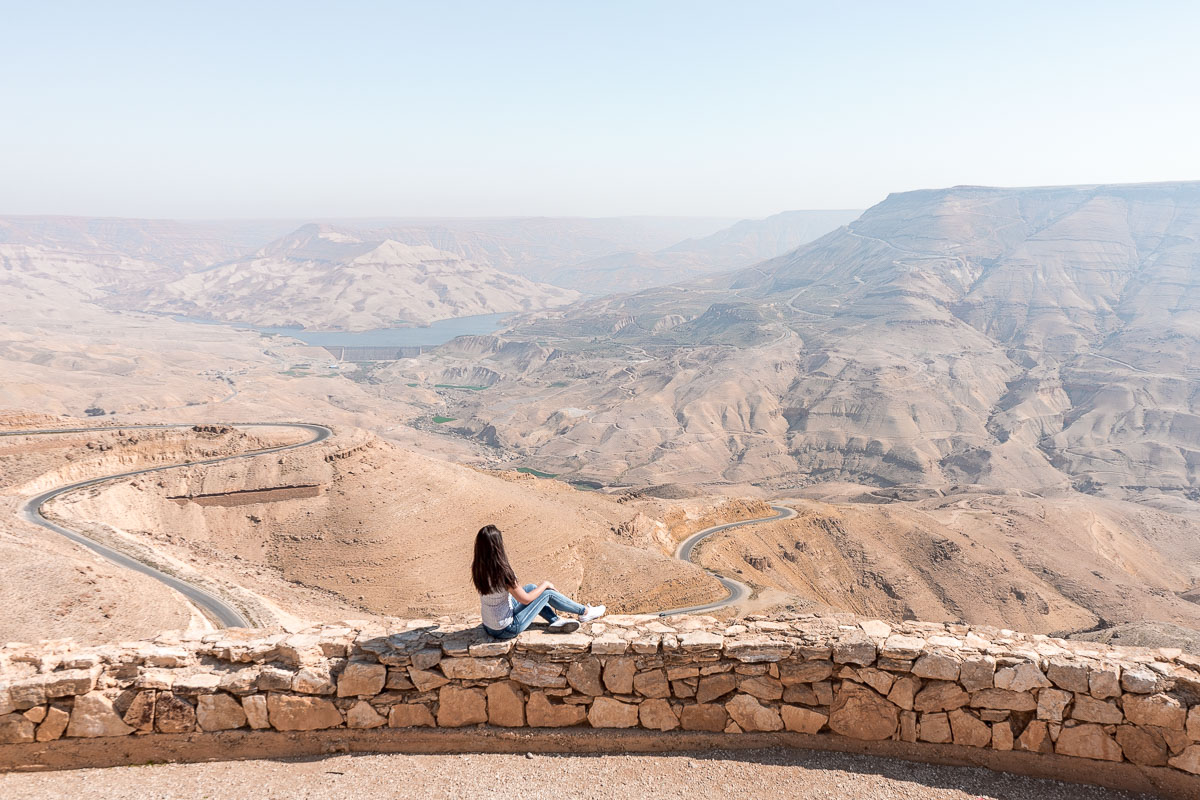
Best Places to Visit in Jordan
The rose-colored city of Petra is one of the New Seven Wonders of the Modern World. Since Petra is the most interesting site in Jordan you absolutely need to put it on your itinerary!
You can see the vast majority of the ruins in only one day but if you have more time you can easily spend 2-3 days in Petra as well.
The most famous spot is the Treasury, but there are many more interesting sites like the Street of Facades, the Roman Theatre, or the Monastery.
If you’re looking for the best viewpoints in Petra, read my article about how to find the best view of the Treasury !
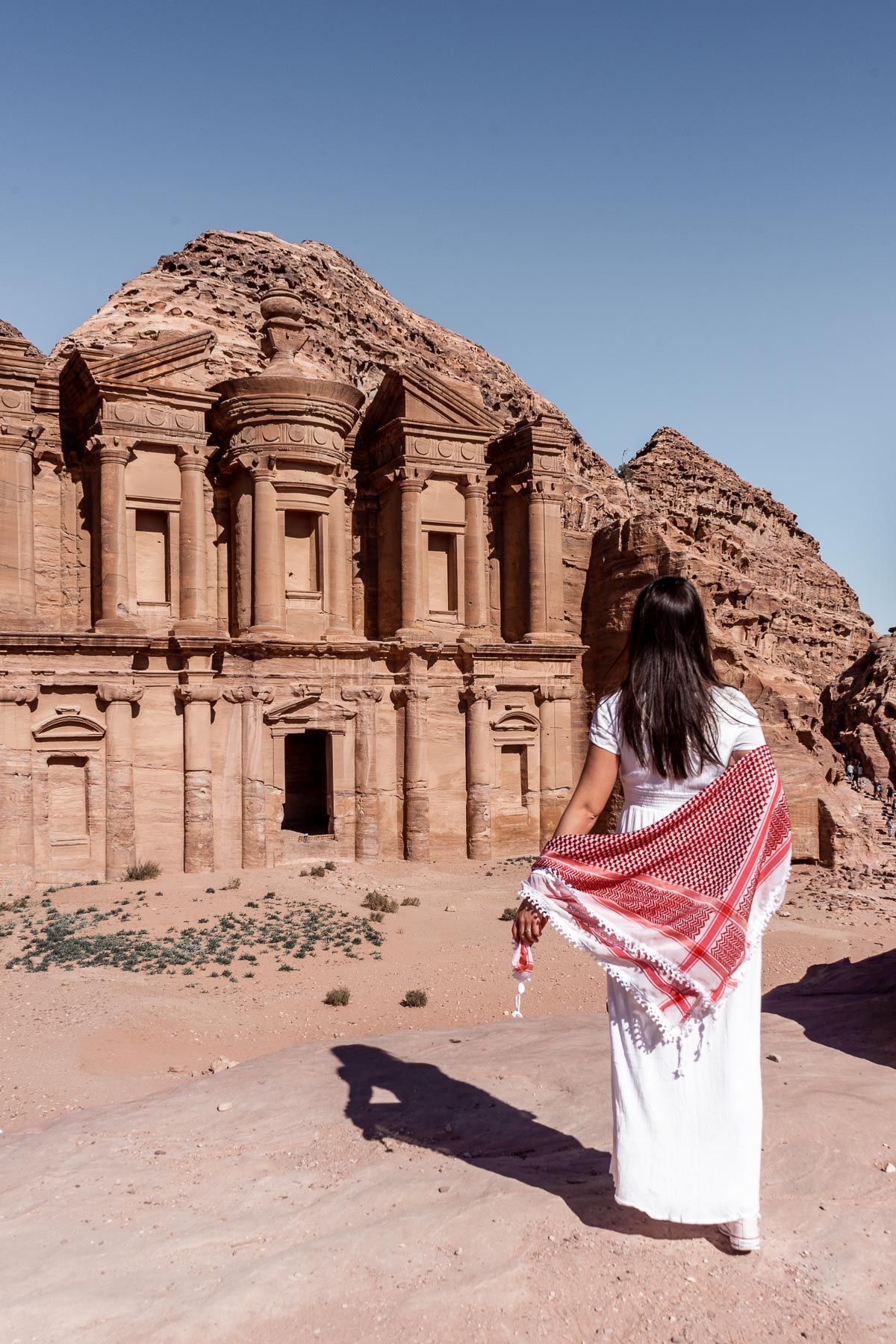
Where to stay in Petra
- Luxury: Mövenpick Resort Petra
- Mid-Range: Infinity Lodge
- Budget: La Maison Hotel
2. Wadi Rum
The Wadi Rum is a UNESCO World Heritage Site located in the southern part of Jordan. This is a huge desert area with the most amazing landscapes you’ll ever see!
If you’re into photography you will absolutely love it. Oh, and it’s definitely one of the most Instagrammable places in Jordan as well!
Try to plan at least a half-day for visiting the desert but if you have more time I would rather recommend spending one full day and a night in the Wadi Rum.
If you want to go all-in, you can even stay at one of the best luxury camps in Wadi Rum .

Where to stay in the Wadi Rum
- Luxury: Wadi Rum Bubble Luxotel
- Mid-Range: Wadi Rum Bedouin Camp
- Budget: Bedouin Nights Camp
3. Dead Sea
The Dead Sea is the lowest point on Earth and the deepest hypersaline lake in the world. It’s almost 10 times saltier than the ocean, therefore you will rather float than swim in the water.
Trust me, floating in the Dead Sea is a true bucket list experience! Although it’s really fun, there are some things you need to pay attention to. Read my best tips for visiting the Dead Sea for more information!
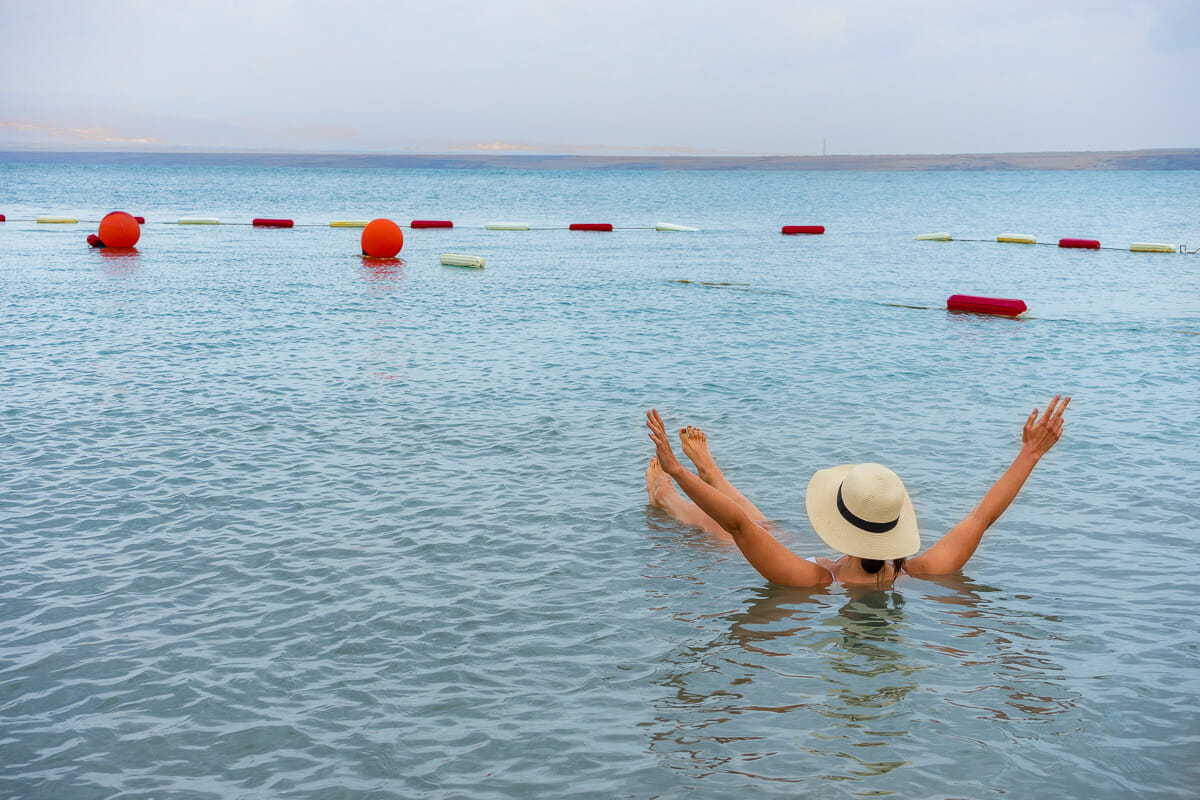
Where to stay at the Dead Sea
- Luxury: Hilton Dead Sea Resort & Spa
- Mid-Range: Dead Sea Spa Hotel
Amman is the capital city of Jordan. It’s a very modern city with many ancient ruins so it’s definitely an interesting place to visit. Unfortunately, it is often overlooked by tourists but it’s worth spending at least a day there!
Visiting the Citadel and the Temple of Hercules is definitely one of the best things to do in Amman , such as shopping in the bazaars and tasting the local food.
If you’re looking for something off-the-beaten-path and you love cars, you can also pay a visit to the Royal Automobile Museum.
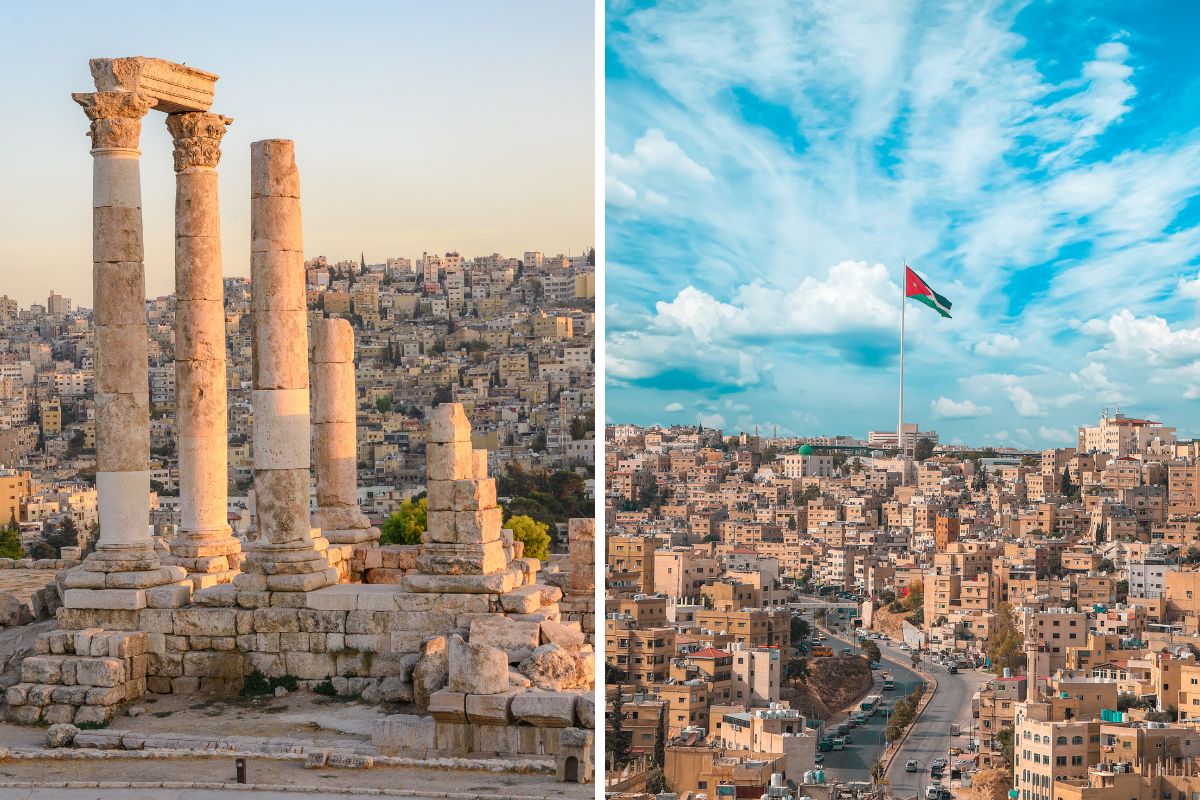
Where to stay in Amman
- Luxury: Amman Rotana
- Mid-Range: Amman International Hotel
- Budget: The Cabin
If you’re looking for the largest and most interesting Roman site in Jordan, you need to put Jerash on your itinerary.
This ancient city is packed with many temples, amphitheaters, columns, and ruined buildings. You can easily visit Jerash from Amman on a day trip so there is no need to stay there.
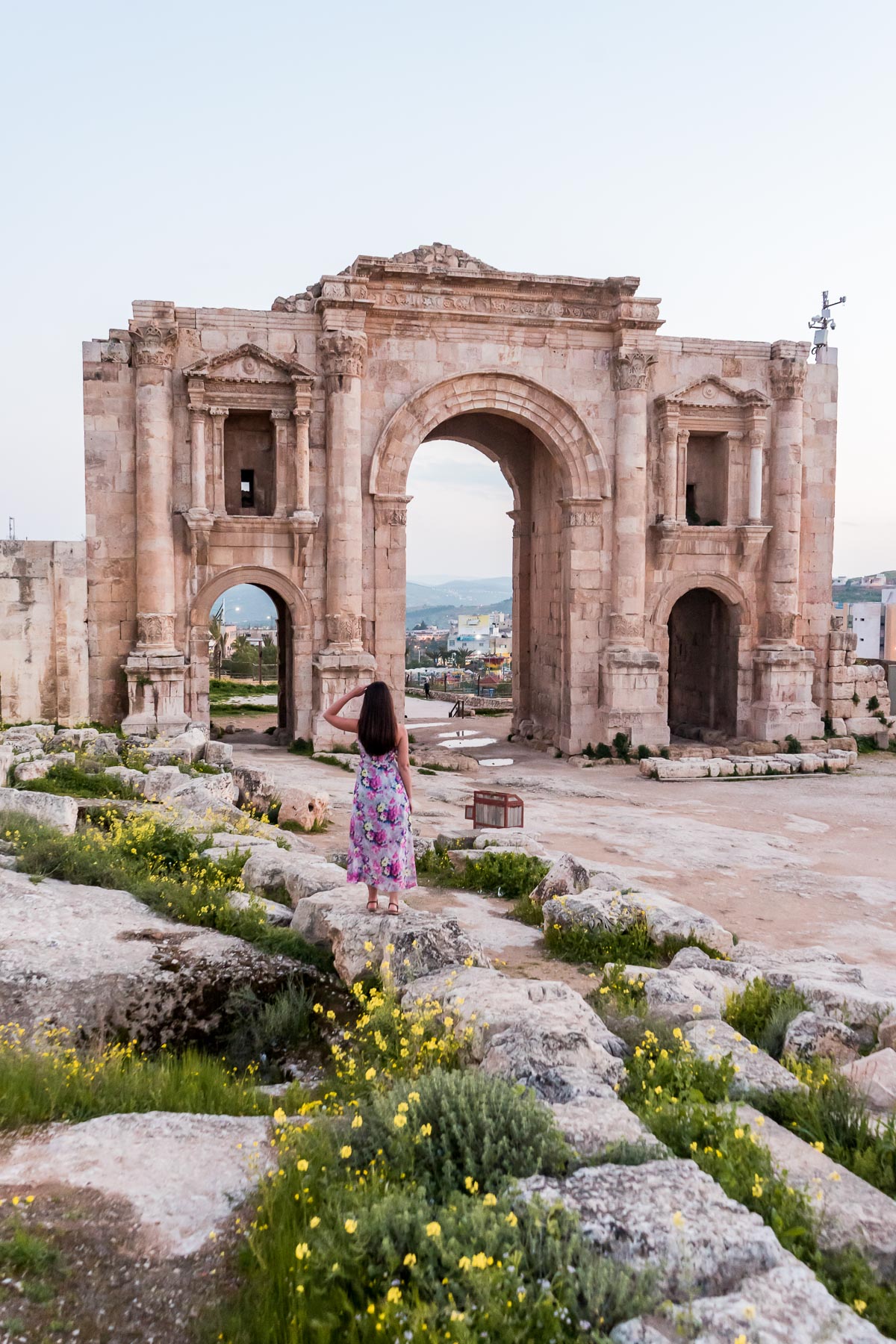
Aqaba is the only coastal city in Jordan, packed with beautiful beach resorts. The water is always warm and crystal clear which makes it the perfect place for snorkeling or scuba diving.
Unfortunately, if you’re only planning to spend a few days in Jordan you will not have time to enjoy the warm weather in Aqaba.
However, if you’re spending one week in Jordan as I suggested, you can easily plan a full-day snorkeling trip in Aqaba!
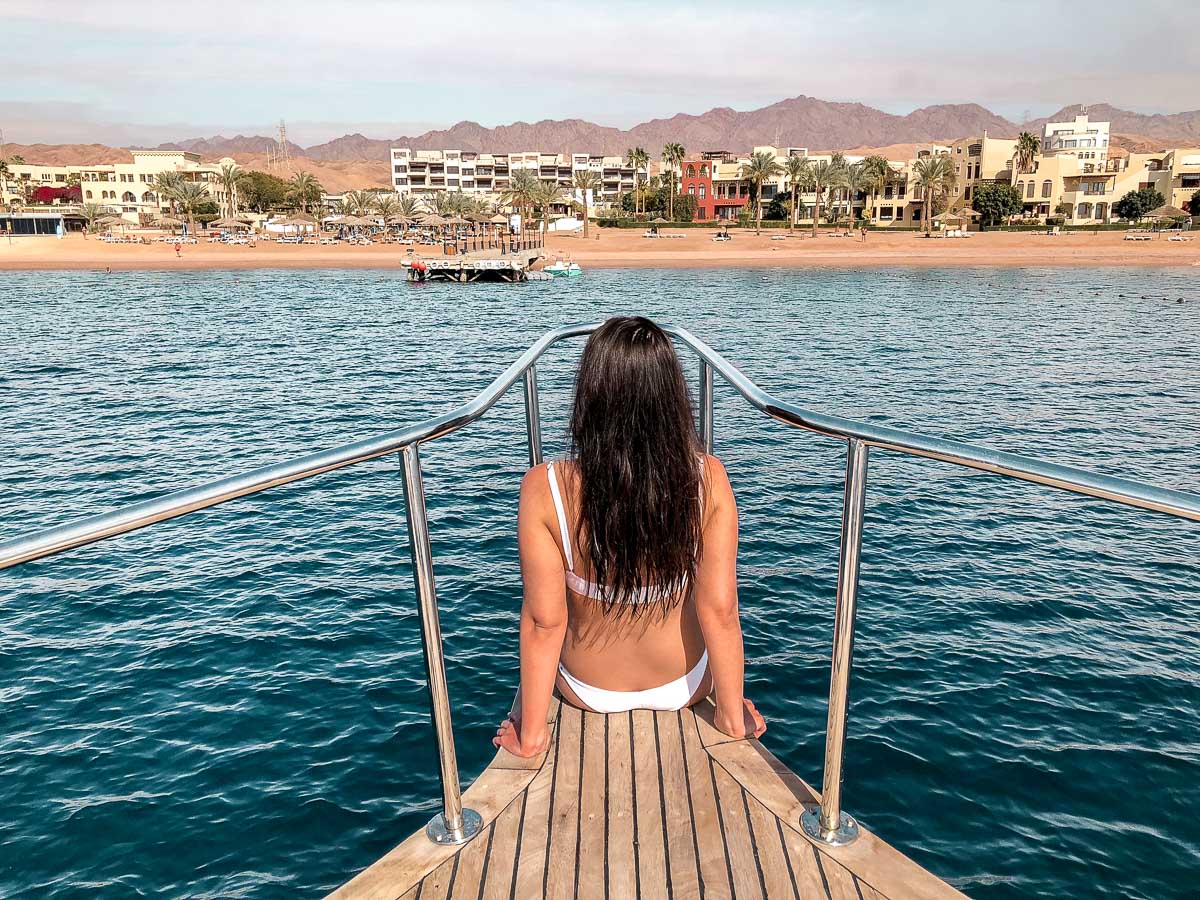
Where to stay in Aqaba
Planning a trip to jordan.
Then you might want to take a look at all our other travel guides about Jordan. I promise, they are just as awesome as this article was!
- The Perfect Itinerary for Spending One Week in Jordan
- Top 8 Most Instagrammable Places in Jordan
- How to Find the Best Viewpoint in Petra – Treasury From Above
- 10 Tips for Visiting the Dead Sea
- Hotel Review: Hilton Dead Sea Resort & Spa
Pin It for Later!
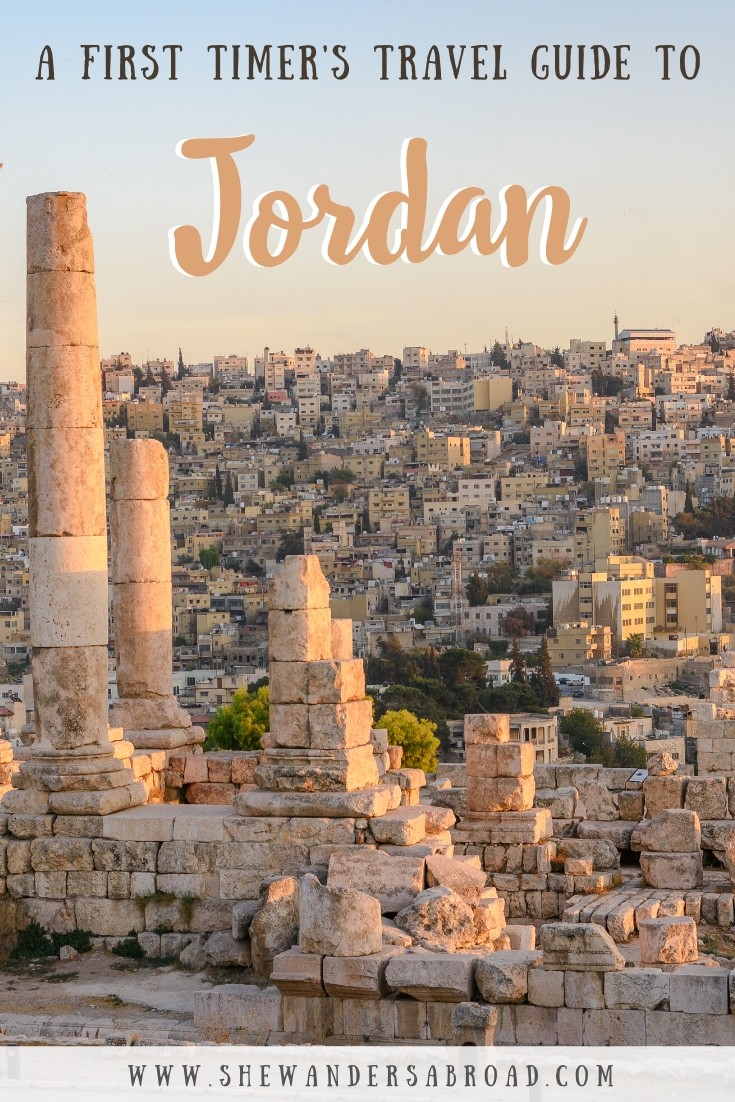
25 thoughts on “The Ultimate Jordan Travel Guide for First Time Visitors”
Jordan is so high on my bucket list! Your blog post is such an interesting read ?
Thank you so much Lina! Jordan is such an amazing country, I can only recommend visiting!
So much good info here Kristi! I am bookmarking it for when I get to visit Jordan in the future- it looks so beautiful.
Jordan is still one of my favourite travel destinations ever! I’m sure you will love it Charu! 🙂
Jordan is on my list, and I’m so happy to see more than just about Petra. I have obviously always wanted to visit Petra, I mean look at it. But there seems to be so much more to Jordan that if I were to visit I would not want to just border hop, but spend some actual time there. Good to know about some of the costs though, that’s definitely helpful information
Totally agree with you, Jordan is so much more than Petra! I’ve never understood why many people only do a day trip there from Israel when the whole country is so beautiful. I have a full blog post about our Jordan expenses if you’re interested 🙂
The desert has such beauty, with the earth tones and sand dunes. I smiled at your comment that the buses don’t follow a timetable. It’s a different culture than my city life in the US, and that’s one reason it would be so interesting to visit Jordan!
Haha yeah it’s so interesting! It’s really different from Hungary as well and it was such an amazing travel experience!
My parents went here last year but I still haven’t had a chance to visit Jordan yet! I’d love to go someday! Your photos are gorgeous! :]
Thank you Farrah! Jordan is such an amazing country, I can only recommend visiting!
Wonderful post and photos! I had such an amazing time in Jordan!!!
Thank you Charlotte! I really loved it as well 🙂
I would love to visit Jordan! It looks like an amazing country and there are so many beautiful spots! I will definitely use your tips for when I go! Your photos are stunning btw!
Thank you so much Bettina!
I have traveled to the Middle East many times, but never made it to Jordan. This is a very informative and useful guide so I’m going to save it for when we can travel again. Thanks so much for the inspiration and for the STUNNING images!
Thank you so much Michelle, I’m so happy you liked it! Jordan is really great country, it’s still one of my favourite travel destinations ever 🙂
I would love to go back to Jordan! I only got to see the Dead Sea, so it looks like there are so many other places I should explore there!!
I have had Jordan on my top places to visit for a while now and this post just adds to the desire to go. I think I need to spend the full week here. Snorkelling, history and amazing views all in one place – YES PLEASE!!!!
I think one week is the perfect amount of time! We also did a one week trip (I shared our itinerary in another blog post as well) and it was so incredible! 🙂
I never thought about Jerash and Aqaba. Jordan is high on my list. It’s a very useful guide. It will definitely come handy for when I visit.
You’re making me miss this beautiful country!! So many good tips here. I definitely want to go back!
I was supposed to visit Jordan back in 2017 and my friend got really sick and we had to cancel the trip literally the day we were supposed to leave. Ever since, I’ve been absolutely DYING to visit Jordan! I pinned this for when I can finally make that trip 🙂
Omg I’m so sorry to hear about it! Jordan is really amazing, one of my favourite trips ever! I hope you will be able to visit Jordan when we can finally travel again 🙂
Jordan is perhaps my all-time favorite country! I spent almost three weeks there years ago, taking shared taxis everywhere, hitchhiking through the desert, and camping on the beach. I found all the locals to be so friendly and helpful! The one thing I need to go back for is Wadi Rum — didn’t make it there the first time around.
Oh gosh 3 weeks in Jordan – that sounds like a dream! I absolutely loved this country as well and it’s also one of my favourite travel destinations ever 🙂
Leave a Comment Cancel reply

No products in the cart.

The Ultimate Guide to Planning a Trip to Jordan
Your complete roadmap to exploring jordan.
Planning a trip to Jordan opens the door to a world of ancient wonders, breathtaking landscapes, and rich cultural experiences. From the iconic lost city of Petra to the serene beauty of the Dead Sea, Jordan is a destination that offers something for every traveler. Whether you’re an adventure seeker, a history buff, or a wellness enthusiast, this Middle Eastern gem will captivate your heart. To help you make the most of your journey, we’ve crafted the ultimate guide to planning your dream vacation. We’ll cover everything from the best Jordan tours to essential travel tips, ensuring your experience is as smooth and unforgettable as possible.
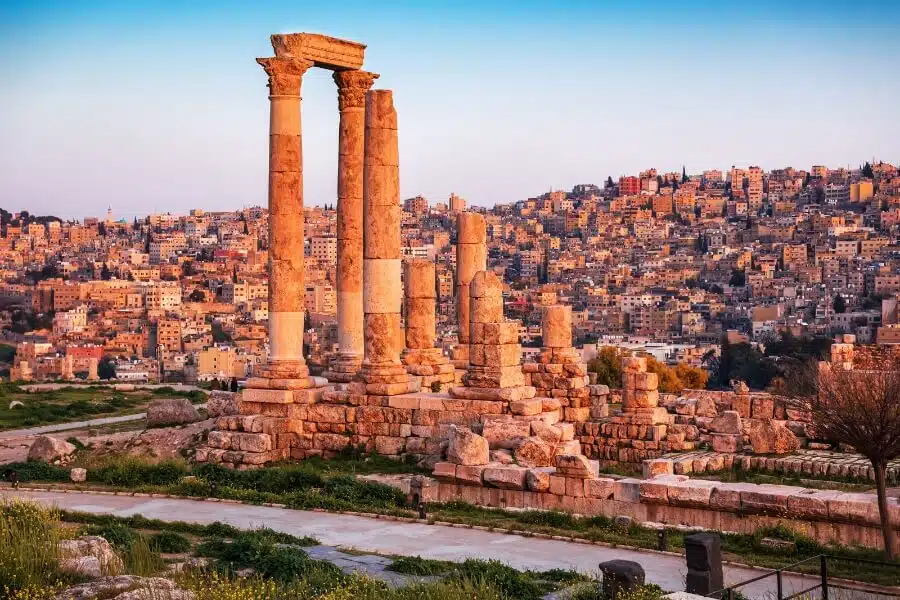
Planning a trip to Jordan opens the door to a world of ancient wonders, breathtaking landscapes, and rich cultural experiences. From the iconic lost city of Petra to the serene beauty of the Dead Sea , Jordan is a destination that offers something for every traveler. Whether you’re an adventure seeker, a history buff, or a wellness enthusiast, this Middle Eastern gem will captivate your heart. To help you make the most of your journey, we’ve crafted the ultimate guide to planning your dream vacation. We’ll cover everything from the best Jordan tours to essential travel tips, ensuring your experience is as smooth and unforgettable as possible.
Why Visit Jordan?
Jordan is a country that effortlessly blends the past and present, offering a unique glimpse into the ancient world while also embracing modernity. Its landscape is diverse, ranging from desert valleys to lush oases, making it a haven for outdoor activities like hiking, camping, and camel trekking. At the same time, cities like Amman boast a thriving culinary scene and contemporary art galleries, providing a balance between adventure and urban luxury.
Here’s a sneak peek at what Jordan has to offer:
- Petra : One of the New Seven Wonders of the World, this ancient Nabatean city carved into rose-red cliffs is a must-see.
- Wadi Rum : Known as the Valley of the Moon, this vast desert landscape is perfect for stargazing, 4×4 adventures, and learning about Bedouin culture.
- The Dead Sea : Float in the salty waters of the Dead Sea, known for its therapeutic properties and stunning sunsets.
- Jerash : Explore the ruins of one of the best-preserved Roman provincial cities outside of Italy.
- Aqaba : A gateway to the Red Sea, Aqaba is ideal for snorkeling, diving, and soaking up some sun on pristine beaches.
When is the Best Time to Visit Jordan?
Jordan’s climate varies significantly depending on the region, but in general, the best time to visit is during the spring (March to May) or fall (September to November). These periods offer mild temperatures, making it perfect for outdoor activities and sightseeing.
- Spring (March to May) : Flowers bloom across the countryside, and the weather is pleasantly warm. It’s an ideal time for exploring Petra or hiking in Dana Biosphere Reserve .
- Fall (September to November) : Cooler temperatures return, making it comfortable to roam the desert landscapes of Wadi Rum or take a dip in the Dead Sea.
Summer (June to August) can be quite hot, especially in desert regions, while winter (December to February) brings cooler temperatures and the occasional rain in higher elevations like Amman .
What You Need to Know Before You Go
1. visa requirements.
Visitors from most countries can obtain a visa on arrival at Queen Alia International Airport in Amman or at various land borders. However, it’s recommended to check the latest visa regulations before traveling. For travelers planning to visit multiple sites, consider purchasing the Jordan Pass . It covers entry fees to over 40 attractions, including Petra, and waives visa fees if you stay at least three nights.
2. Currency
Jordan’s official currency is the Jordanian Dinar (JOD) . ATMs are widely available in cities, but it’s a good idea to carry cash for small purchases, especially when visiting rural areas or markets. Credit cards are accepted in most hotels and restaurants in major tourist areas, but not always in smaller establishments.
3. Language
The official language in Jordan is Arabic, but English is widely spoken in tourist areas, hotels, and restaurants. Learning a few basic Arabic phrases can be helpful and appreciated by locals.
4. Health & Safety
Jordan is generally considered a safe country for tourists. The locals are known for their hospitality and friendliness. However, like traveling to any foreign destination, it’s wise to take standard precautions, such as being aware of your surroundings and keeping valuables secure.
When it comes to health, it’s advisable to drink bottled water rather than tap water, and travelers should ensure they have travel insurance that covers any medical emergencies.
Top Destinations & Experiences in Jordan
Jordan is packed with extraordinary experiences. Here are some of the must-visit destinations and top things to do:
No trip to Jordan is complete without exploring the fabled city of Petra. This UNESCO World Heritage site, once the capital of the Nabatean Kingdom, is a labyrinth of tombs, temples, and stunning architecture carved into sandstone cliffs. Spend at least a full day here, and if you have time, don’t miss the night-time visit to Petra by Night , where the Treasury is illuminated by candlelight, creating an ethereal atmosphere.
2. Wadi Rum
Wadi Rum offers a truly otherworldly experience. Often described as the Valley of the Moon , this desert landscape features towering rock formations, vast sand dunes, and ancient petroglyphs. Opt for a 4×4 desert tour, a camel ride, or spend a night in a traditional Bedouin camp under the stars for an authentic experience.
3. The Dead Sea
Renowned for its high salt content and mineral-rich mud, the Dead Sea is the lowest point on Earth and a natural spa. Float effortlessly on the surface of the water and enjoy the serene surroundings, perfect for relaxation after a day of sightseeing.
This ancient Roman city is one of the best-preserved in the world. Wander through its colonnaded streets, visit the grand amphitheater, and marvel at the Temple of Artemis . The annual Jerash Festival of Culture and Arts is held here, featuring performances by local and international artists.
5. Dana Biosphere Reserve
For nature lovers, the Dana Biosphere Reserve is a must. It’s Jordan’s largest nature reserve, offering opportunities for hiking through stunning landscapes of mountains, valleys, and desert wilderness. Birdwatchers will also appreciate the reserve’s diverse wildlife.
For those seeking sun and sea, Aqaba is the perfect escape. Located along the Red Sea, it’s known for its beautiful beaches and world-class diving and snorkeling spots, where you can explore coral reefs teeming with marine life.
Adventurer’s FAQ
Q: What are the best Jordan tours for first-time visitors? A: For first-time visitors, popular tours often include stops at Petra, Wadi Rum, the Dead Sea, and Jerash. Multi-day tours with a professional guide ensure you cover all the highlights efficiently.
Q: How many days do you need in Jordan? A: A 7 to 10-day trip is ideal for seeing the major sights like Petra, Wadi Rum, the Dead Sea, and Aqaba without feeling rushed.
Q: Is Jordan safe for solo travelers? A: Yes, Jordan is considered one of the safest countries in the Middle East for solo travelers. The people are known for their hospitality, and crime rates are low.
Q: What should I wear when visiting Jordan? A: Jordan is a conservative country, so modest dress is recommended, especially when visiting religious or rural areas. For women, it’s best to wear loose-fitting clothing that covers the shoulders and knees. Men should also avoid wearing shorts in less touristy areas.
Q: Can you visit Jordan on a budget? A: Yes! While Jordan offers luxury accommodations and experiences, it’s also possible to travel on a budget by staying in guesthouses, eating at local eateries, and using public transportation.
Top Experiences & Tours in Jordan
4-Day Amazing Jordan Tour Explore Jordan’s rich history and breathtaking landscapes in just four days. Visit Amman , the capital, wander through the ancient ruins of Petra , and marvel at the serene beauty of the Dead Sea . Perfect for travelers seeking a quick yet unforgettable adventure. Start Your Journey Now
5-Day Jordan Highlights Tour: Amman, Petra, Wadi Rum & Dead Sea Adventure Dive deeper into Jordan’s cultural and natural wonders with this 5-day tour. Experience the vibrant city of Amman , explore the majestic Petra , ride through the dramatic desert of Wadi Rum , and relax at the Dead Sea . Discover Jordan’s Best
6 Days Amman, Petra, Wadi Rum and The Dead Sea Tour Spend six days soaking in Jordan’s historical treasures and natural beauty. Wander through Amman , take in the awe-inspiring sights of Petra , ride camels in Wadi Rum , and enjoy the therapeutic waters of the Dead Sea . Explore This Tour
7-Day Highlights of Jordan Tour Spend a week discovering the best of Jordan. From the bustling streets of Amman to the enchanting rose-red city of Petra , the endless dunes of Wadi Rum , and the rejuvenating Dead Sea . This tour covers it all. See Full Itinerary & Book
8 Days Discovering the Wonders of Jordan Take your time exploring Jordan’s iconic sites and hidden gems over eight unforgettable days. This immersive journey includes visits to Amman , Petra , Wadi Rum , and the Dead Sea , offering a perfect balance of adventure and relaxation. Join This Adventure
An Epic Ending to Your Jordan Adventure
Jordan is more than just a vacation—it’s a journey through time and nature, where each step uncovers layers of history, culture, and raw beauty. From the magic of Petra to the serenity of the Dead Sea, Jordan has a way of making you feel connected to something much larger than yourself. As you plan your trip, embrace the spirit of exploration and immerse yourself fully in the experiences that await. Whether you’re traversing the vast desert of Wadi Rum or standing in awe before Petra’s Treasury, every moment in Jordan will leave an indelible mark on your heart.
Similar Posts
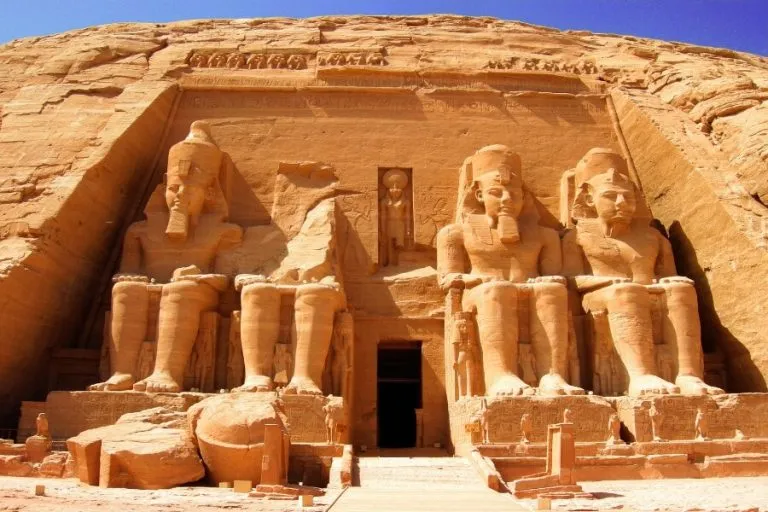
The Most Popular Destinations for US Travelers
Embark on a journey through favored locales by American adventurers. Experience a blend of cultural richness and natural splendor.
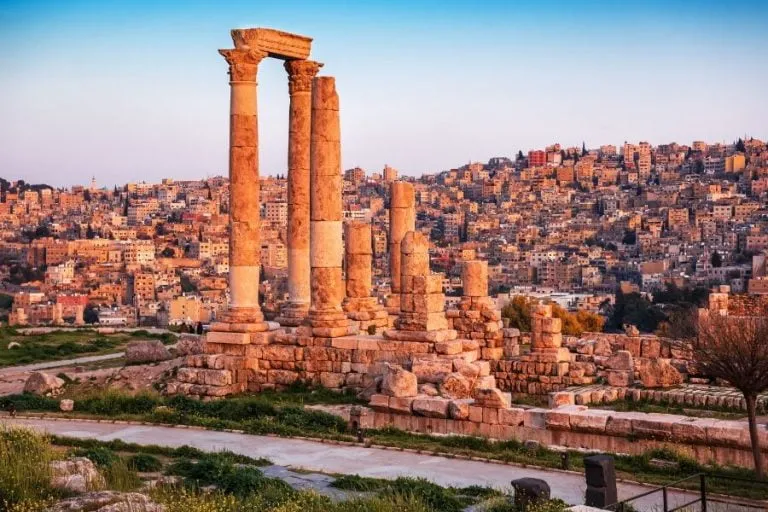
Top 10 Must-See Attractions in Jordan: A Journey Through Time and Wonder
Discover the top 10 must-see attractions in Jordan, from Petra to the Dead Sea, and embark on an unforgettable adventure with Jordan Tours.
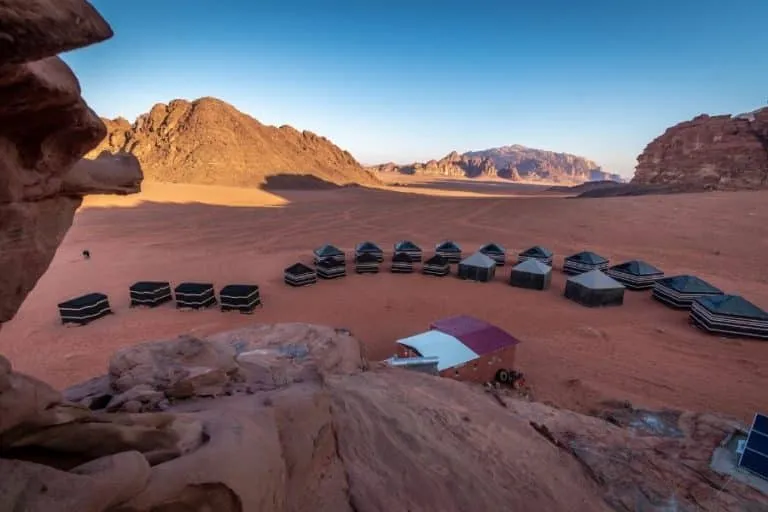
Is It Safe to Travel to Jordan: Insights and Tips for 2024
Explore the safety of traveling to Jordan, from local guidelines to travel advisories, and confidently experience this captivating country’s wonders.

Petra Tour from Amman: A Journey into the Ancient World
Discover the ancient city of Petra with our tour from Amman. Unearth Jordan’s archaeological treasures and experience breathtaking desert landscapes.
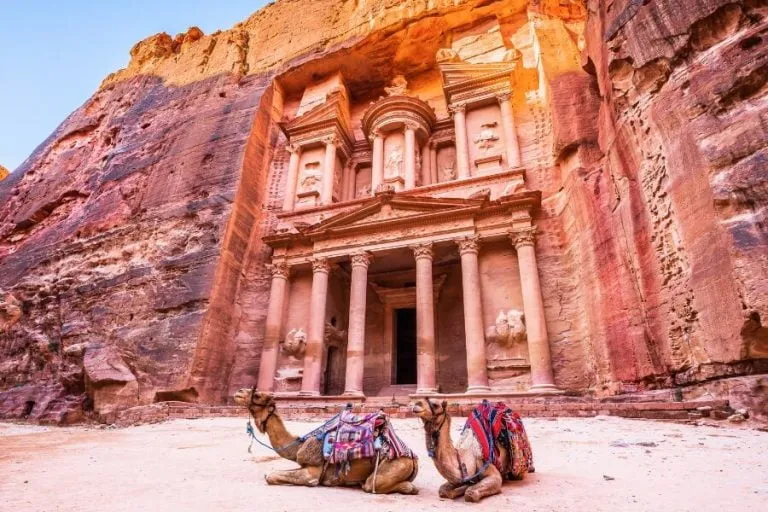
Why Petra Should Be on Your Bucket List
When it comes to iconic travel destinations, Petra stands as a timeless testament to the grandeur of ancient civilizations. Tucked away in the rugged mountains of southern Jordan, this UNESCO World Heritage Site is not only a marvel of ancient engineering but also a symbol of human endurance and creativity. For those embarking on Jordan…

Visiting Petra in Jordan: An Unforgettable Journey
Gear up for an extraordinary expedition as we set off to explore Petra, Jordan. This comprehensive guide delves into the must-sees, handy travel tips, and frequently asked questions about visiting Petra – the rose-tinted city that stands as a living testament to the bygone era.

Jordan Travel Guide
Looking for an in-depth Jordan travel guide ?
Then you’re in the right place!
Tucked between Israel, Saudi Arabia, Iraq and Syria is Jordan, the true hidden gem of the Middle East.
Jordan offers travelers an exciting mix of old and new with everything from Roman ruins to sprawling desert landscapes to cosmopolitan cities.
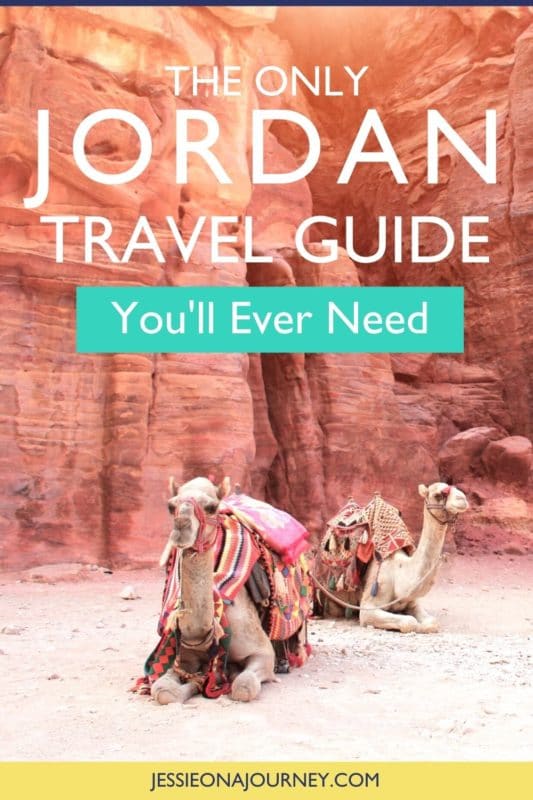
The country is also home to tons of truly unique experiences; I mean, where else can you camp in the desert with a Bedouin community, explore an ancient city, and soak in a tropical hot spring?
In short, if you’re ready to go on an action-packed adventure, Jordan is the place to be.
Additionally, hospitality is an important part of Jordanian culture.
In Wadi Rum, Jordan’s most famous desert, you can stay with a Bedouin community and learn all about this nomadic culture. You’ll get a chance to eat delicious food cooked in an underground pit, explore the desert in a truly unique way, and see the night sky like you never have before.
If camping isn’t really your style, there are lots of boutique Jordan hotels and unique accommodations throughout the country like the electricity-free Feynan Ecolodge in the Dana Biosphere Preserve.
You can even arrange to stay with a local family through the Jordan Tourism Board for a truly immersive experience.
One thing you’ll definitely want to consider when planning your trip to Jordan is purchasing a Jordan Pass.
Starting at $99 USD, this ticket gives you entry to 40 of Jordan’s top attractions, including many of the country’s UNESCO World Heritage Sites like Petra, Wadi Rum, Quesir Amra, and more.
The pass saves you time and money and helps you get around with a free digital Jordan guide.
Plus, if you purchase your pass before your trip and plan to stay for a minimum of three nights in the country, you’ll get your visa fee waived — a huge win for travelers on a budget!
Keep reading to dive into resources that will help you with planning a trip to Jordan in the Middle East.
Note: This ultimate guide to Jordan travel contains affiliate links to trusted partners!

Use this Jordan travel map to begin planning your trip to this incredible country!
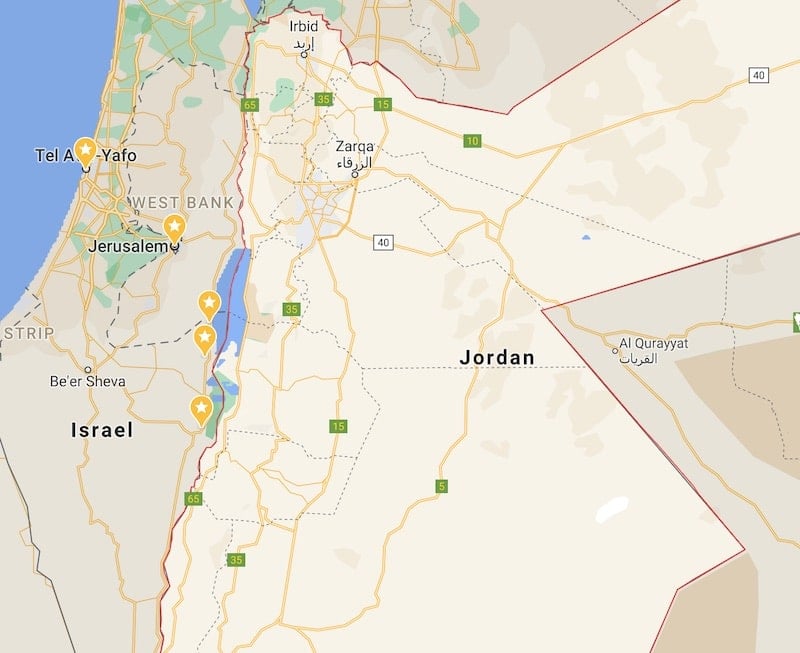
Click here for an interactive Google Map version of the above graphic.
Jordan Tourism Highlights
The following guides share Jordan highlights & travel experiences that you won’t want to miss!
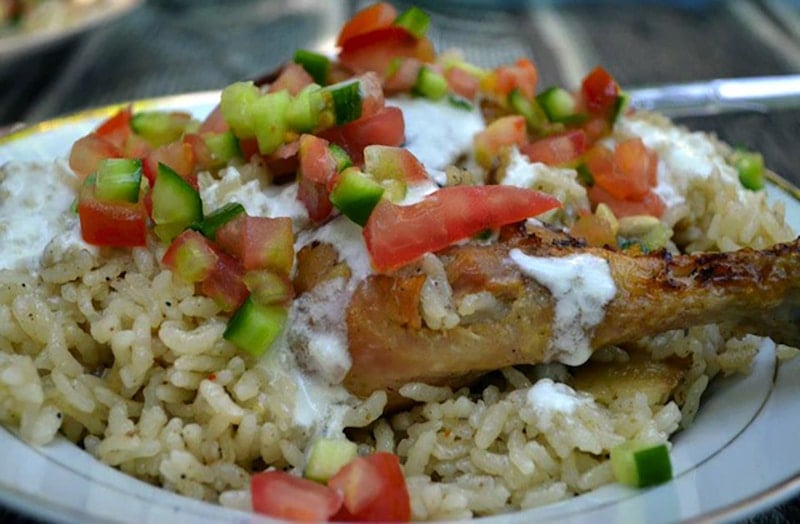
Having Lunch With A Local Family In Jordan
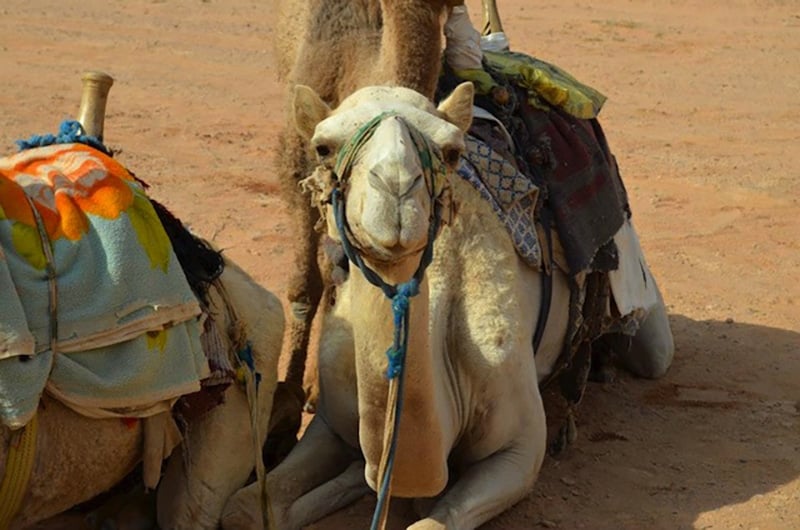
Unexpected Highlights From My Journey Through Jordan
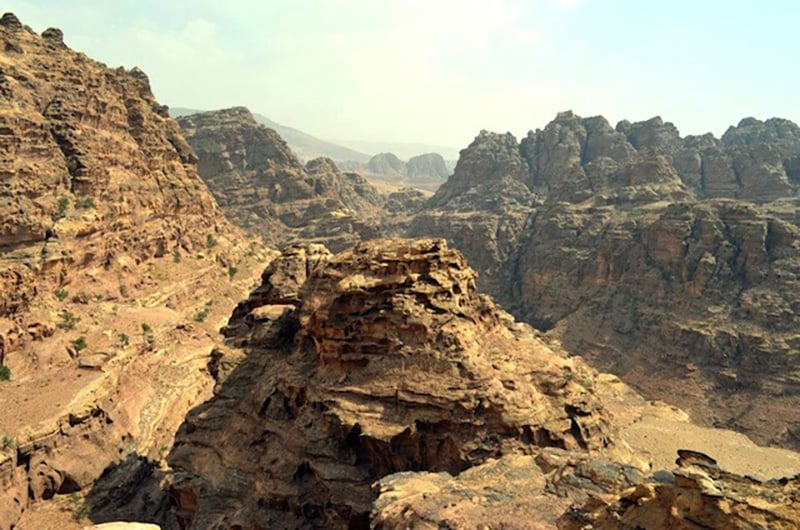
Adventures In The Middle East: Top Hikes In Jordan
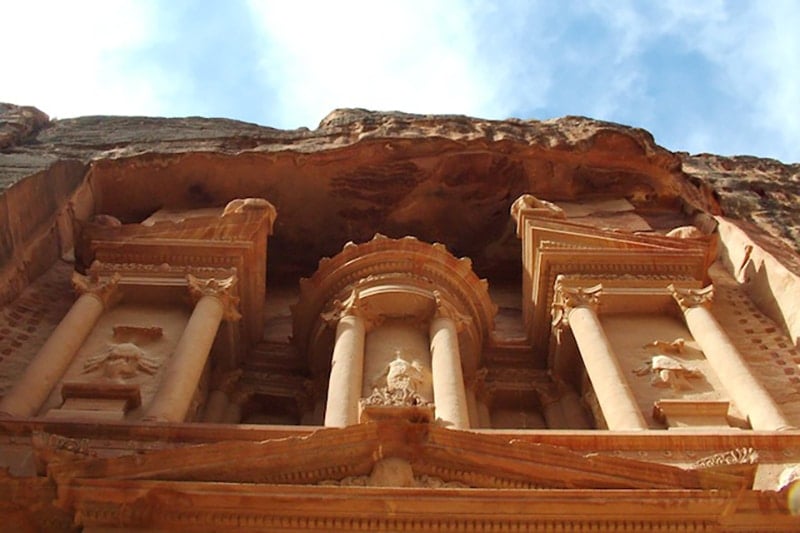
Not Another Historical Petra Article: Hiking In Petra
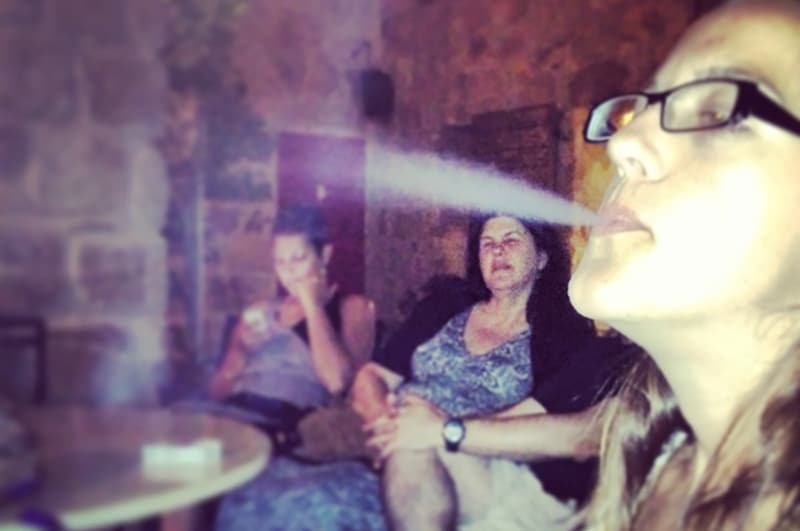
Smoking Shisha In Jordan
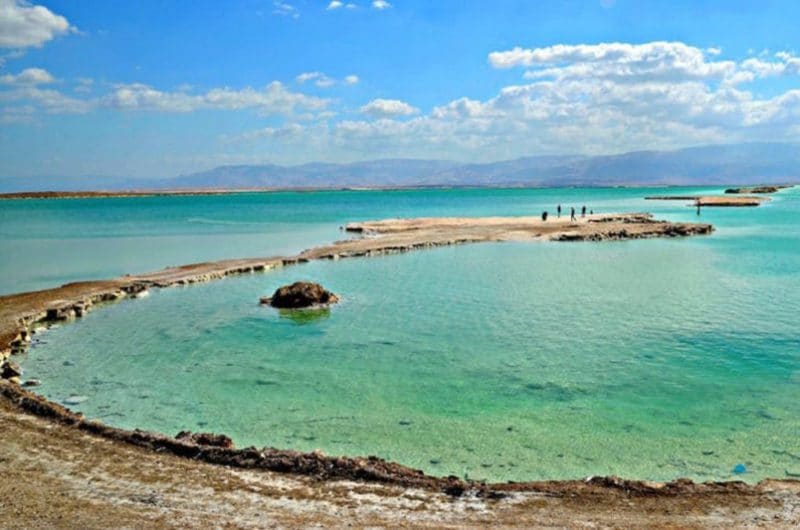
The Dead Sea Like You’ve Never Seen It Before
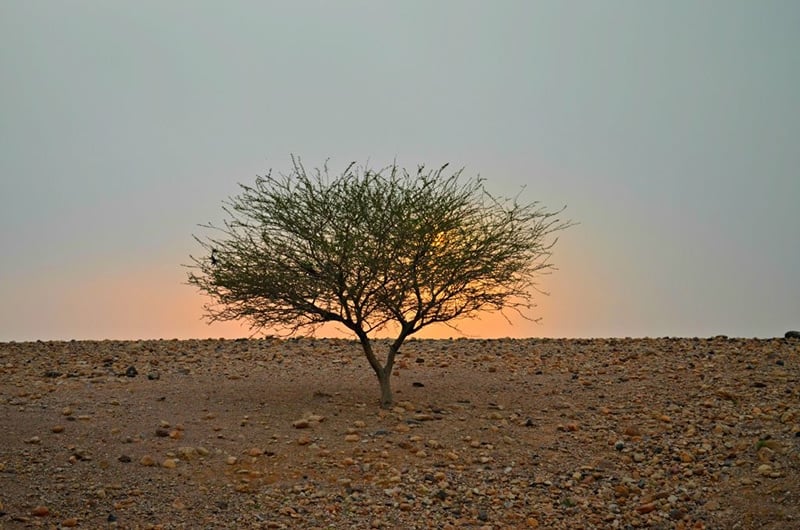
How To See A Spectacular Desert Sunset In Jordan
Jordan Travel Advice
Plan the perfect trip with these Jordan travel tips !
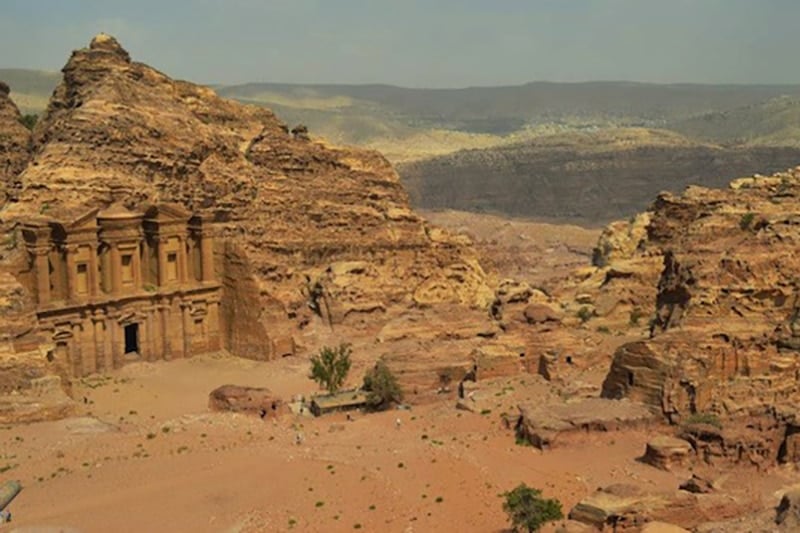
6 Essential Jordan Travel Tips
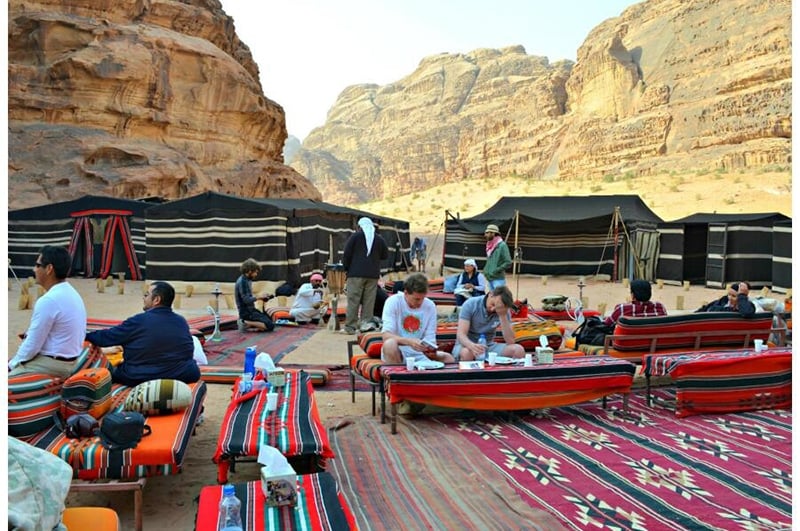
5 Amazing Experiential Stays In Jordan
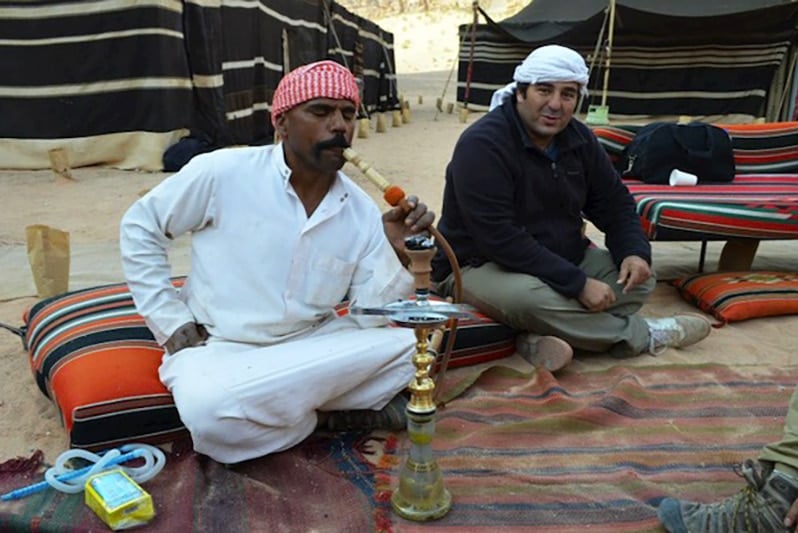
Guide For Experiencing Bedouin Culture In Jordan
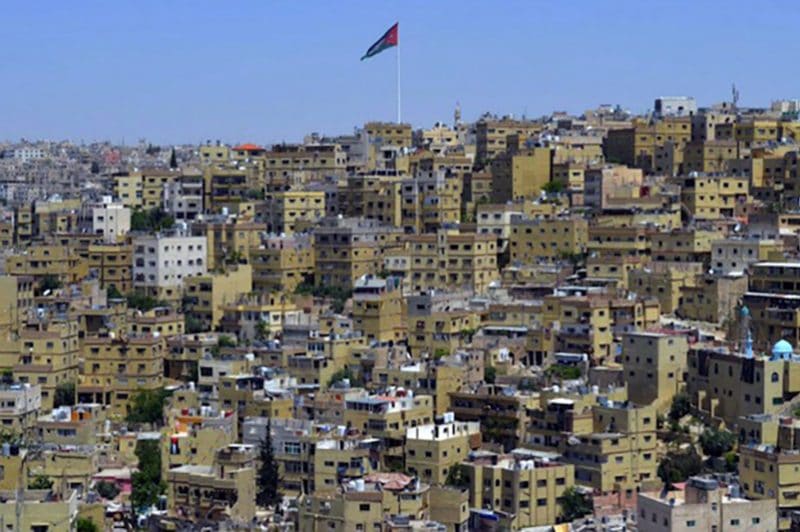
Getting To Know The Many Personalities Of Jordan (Unique Jordan Travel Experiences Included!)
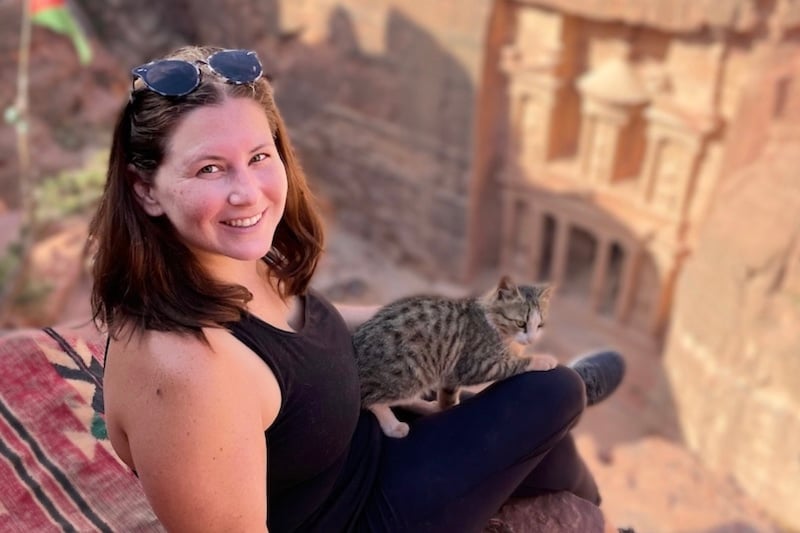
Solo Travel In Jordan: The Ultimate Guide (With Map!)
Best Jordan Tours
Explore local culture with an Jordan tour guide through these unique excursions:
- Wadi Mujib Siq Trail Hiking Experience from Amman
- Petra & Wadi Rum from Aqaba
- Private Tour Madaba, Mount Nebo, and Dead Sea Day Trip with Amman Sightseeing from Amman
- Bethany Baptism Jordan River Site and As-Salt City Visit from Amman
- Madaba, Mount Nebo, & the Dead Sea from Amman
Renting A Car In Jordan
Need a rental car for your Jordan trip?
Use Discover Cars to quickly compare your car rental options.
Jordan Hotels
Click here to browse the best Jordan travel hotels!
Prefer self-contained stays?
Click here to check out unique local rentals !
You can also use this map to search for local stays:
Jordan Travel Insurance
It doesn’t matter if you’re traveling solo or with a group on a Jordan tour. When visiting Jordan — or any other country in the world — make sure to get travel insurance to protect your health and safety.
In my opinion, the best travel medical insurance for travelers is SafetyWing as they’ve got a large network and offer both short-term and long-term coverage — including coverage if you’re traveling for months as well as limited coverage in your home country).
Additionally, SafetyWing is budget-friendly and offers $250,000 worth of coverage with just one low overall deductible of $250.
With coverage, you’ll have peace of mind as you embark on your Jordan travel itinerary.
Click my referral link here to price out travel insurance for your trip in just a few clicks .
Jordan Travel Guide FAQ
Below, find answers to frequently asked questions about traveling in Jordan .
Q: What are the best places to visit in Jordan?
One of the biggest highlights of any trip to Jordan is Petra , an ancient desert city rediscovered nearly 200 years ago.
Also known as the “Pink City” or the “Rose City,” Petra features the ruins of gorgeous buildings like a monastery and treasury built into the desert hills that are some of the best-preserved examples of the Hellenic style of architecture.
Petra offers a ton of opportunities for hikers and explorers of all kinds — so much so that many experts recommend spending two days in the city. Stay into the evening to experience the Petra Night Show, where the Siq and Treasury are illuminated by hundreds of candles.
Wadi Rum, or the Valley of the Moon, is also a top attraction for visitors to Jordan.
Once the filming location for the classic film Lawrence of Arabia , this gorgeous sandstone valley is the ultimate Middle Eastern experience. There are plenty of ways to explore Wadi Rum from camel rides to rock climbing to ATV tours.
For the full Wadi Rum experience, you can book a Bedouin camping tour where you can learn more about this nomadic Arab culture. And hit the hay too early — one of the best parts of camping in Wadi Rum is the incredible evening skyscape and you won’t want to miss it!
Of course, no trip to Jordan is complete without a float in the Dead Sea .
Here at the lowest point on Earth, you can enjoy the healing properties of this mineral-rich water or wade into the skin-softening Dead Sea mud at Amman Beach.
If you’re not ready to dip your toes into the water, just enjoy the gorgeous blue water and red mountains that look like a scene out of a painting.
Q: What do I need to know before going to Jordan?
As in many other Middle Eastern destinations, it’s important to be conscious of your wardrobe while traveling in Jordan. There are certain cultural expectations and norms for dress in Jordan for all genders and it’s best to be respectful and dress with these in mind.
Women should generally avoid wearing anything too revealing and stick to loose-fitting clothes. It’s also a good idea to carry a scarf or shawl as many religious sites may expect women to cover their hair or shoulders.
Men should avoid walking around topless and may want to wear long pants, particularly when visiting religious sites.
When traveling through Jordan, you’ll find that taxis are fairly inexpensive compared to other destinations. Taxi drivers may charge tourists double by faking a broken meter, though, so always ask your driver to turn on their meter so you know you’re getting the correct fare.
Also, don’t plan on finding a taxi in the afternoon as this is peak traffic time in Jordan. Taxis are scarce at this time and many drivers will refuse service to avoid traffic.
Jordan’s food is incredible but there are a few things to keep in mind before you go on a culinary tour.
For one, most Jordanian dishes include meat or some kind of animal product. While there are certainly vegetarian options throughout the country, particularly in the cities, the country’s traditional cuisine is not very vegetarian-friendly.
Of course, you can make a meal out of the “mezze” course, which consists of appetizers like salads, dips (like hummus!), and other small snacks.
Be aware, though:
Jordanians also enjoy sharing meals with guests and refusing a food offering is considered rude.
Q: Is it safe to travel to Jordan?
Despite what you may hear on the news, Jordan is one of the safest places to visit in the Middle East. Security is a constant presence throughout the country, particularly in areas popular with tourists.
That said, there are some safety tips to keep in mind when in Jordan:
Jordan shares borders with Syria to the north and Iraq to the northeast. It’s best to avoid these border areas as both countries are experiencing conflicts and violence.
Public demonstrations and protests are also common in Jordan, particularly in the capital of Amman. These protests are generally peaceful but it’s smart to keep an eye on the news to stay aware of any demonstrations and avoid large gatherings if possible.
Female travelers have also faced harassment in taxis in Jordan so it’s best to remain alert when taking a cab in the country.
Beyond these warnings, the general travel safety tips apply here: be aware of your surroundings and keep valuables close and out of view when exploring the area to avoid pickpockets .
Q: Is Jordan cheap or expensive?
Compared to other Middle Eastern destinations, Jordan is quite expensive. Hotel accommodations cost around $100 to $150 USD per night but prices vary depending on the city.
You can find deals in bigger cities with more accommodation options like Amman.
Food prices also vary depending on the destination and style of dining.
Though Jordan has an extensive bus system that’s fairly inexpensive, that’s more or less it when it comes to public transportation. If you’re looking to explore beyond the cities, you may want to consider renting a car.
Q: How many days should you spend in Jordan?
You can see most of Jordan’s major sites and attractions in a week-long trip. This will give you enough time to explore Petra, Wadi Rum, the Dead Sea and Amman.
Many of the must-see sights are easily accessible from Amman, so you can make the capital city your hub for a few days during your trip.
Q: What is the best month to visit Jordan?
Many agree that April is the best month to visit Jordan. The weather is perfect for being outdoors and you’ll have loads of activities to explore!
Q: How long can a tourist stay in Jordan?
Tourists from many countries — like the United States and Canada — can visit Jordan for up to 30 days without engaging in work activities.
Q: Do I need a Jordan travel visa?
Travelers from the United States, Canada, and several other countries do need a visa to visit Jordan, though it can be obtained upon arrival for a fee.
It’s recommended to view your country’s Jordan International Travel Information page for the most up-to-date information on entry and exit rules and Jordan Travel Requirements. You can also contact the Embassy of Jordan.
Q: Where is Jordan?
Jordan is located in the Middle East. It shares land borders with Syria (north), Iraq (east), Saudi Arabia (south/southeast), and Israel and the West Bank (west).
Q: Are credit cards accepted in Jordan?
Credit cards — particularly Visa and Mastercard — are widely accepted around Jordan at larger establishments, though it is always wise to carry some cash for smaller establishments and in case of emergency. Many smaller shops and eateries in Jordan prefer cash.
Q: Can you drink the tap water in Jordan?
The tap water is generally safe to drink in Jordan, though it is always best to double-check with your hotel to be safe.
Q: What is the local currency in Jordan?
The local currency in Jordan is the Jordanian dinar (ينار).
What would you add to this Jordan travel guide?

Enjoyed this ultimate Jordan travel guide? Pin it for later!
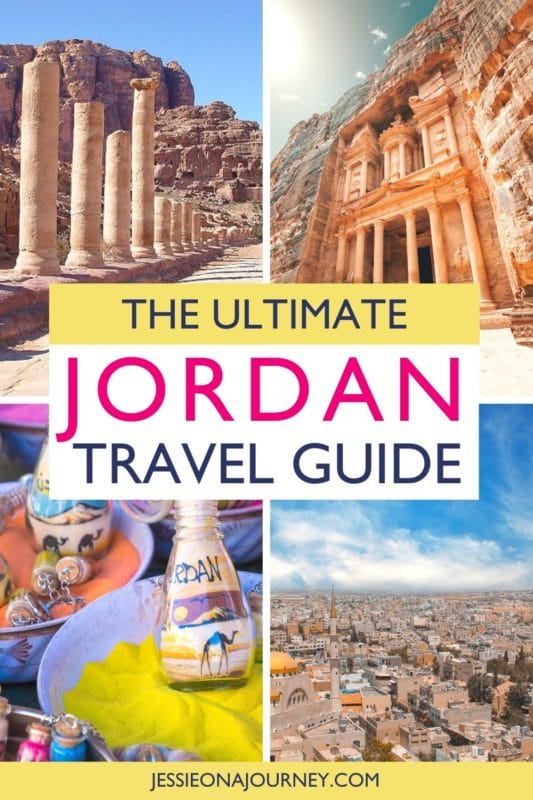
Deals of the Week Irresistible Asia Up to 50% OFF
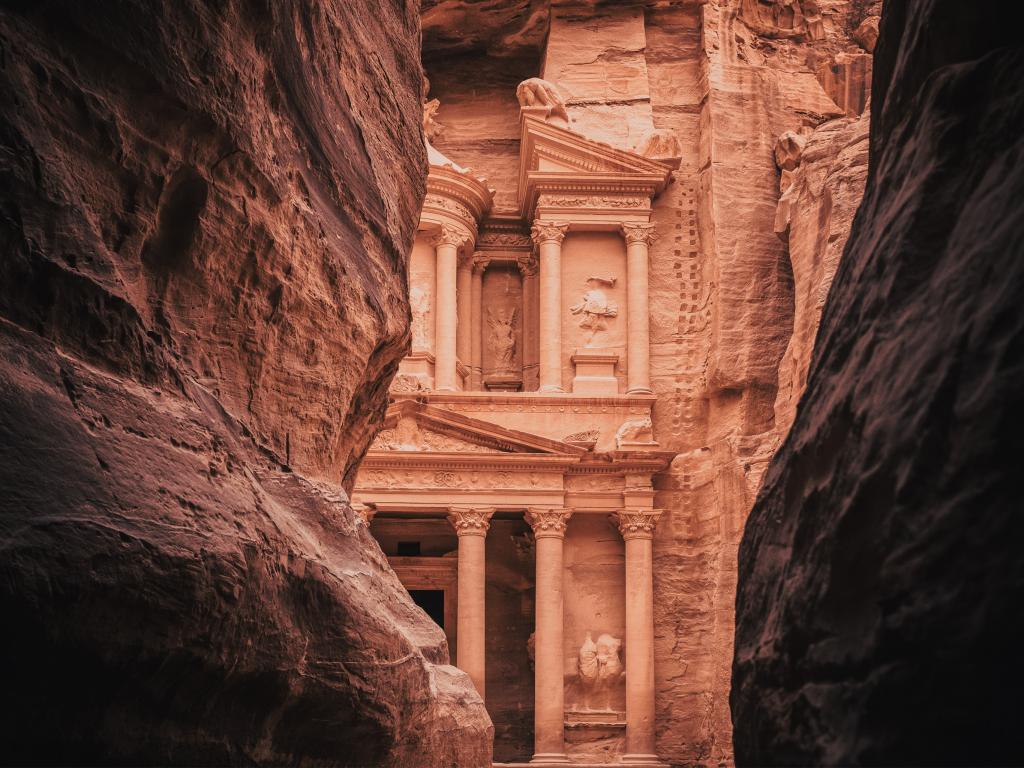
Jordan Travel Guide
There’s rarely a traveller that leaves Jordan unimpressed by its sights or unmoved by its people’s virtues. Best-known for its centrepiece, the archaeological site of Petra, this Middle Eastern nation is breathtaking in both its golden desert attractions, epic experiences and open hospitality, so much so it often draws visitors back. This is Jordan, and it welcomes you with open arms.
The Highlights
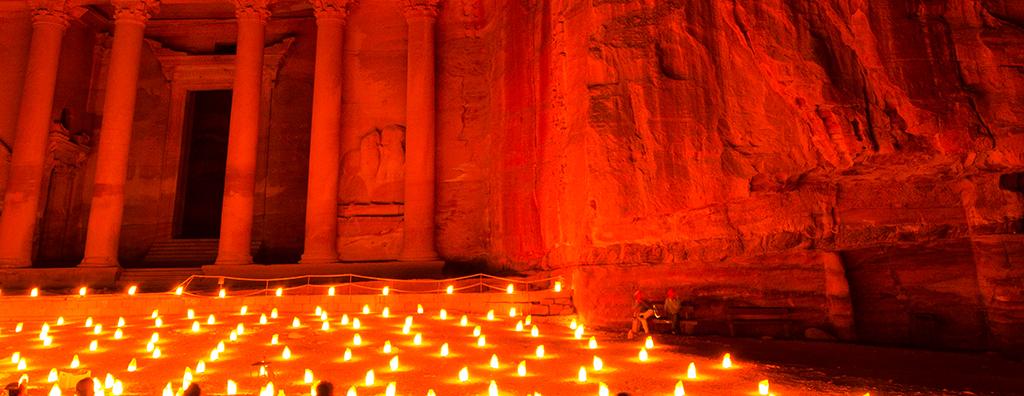
Kerak Castle
Whether or not the history of the Crusades is a particular interest of yours, a visit to the castle of Kerak in Al-Karak is a must to your Jordan experience. This large fortification atop a hill boasts many places to explore – narrow passageways, a church and a palace – and trimmed with views of the neighbouring areas including Wadi Karak, rumoured site of biblical cities Sodom and Gomorrah.

Once you’ve had your fill of Amman and want to experience a slower pace, escape north to Jerash where the remarkable, well-preserved ruins of Gerasa sit. Make your way around this Greco-Roman city where opulent streets, bathhouses, temples, a hippodrome and theatres lay in wait. Make it a day trip and explore the modern town as well. Visit small markets and try your hand at olive picking.

You’d be hard-pressed to not run into sacred or religious sites when visiting Jordan, whether it be a church or a mosque. Or better yet, the perch where Moses stood and saw the Promised Land. Mount Nebo is one of Jordan’s revered sites, where today travellers and devotees make a pilgrimage to if only to see what Moses would have seen. These include the Dead Sea, Jericho and Bethlehem.

While nearby desert explorations are what draw the adventurous to religiously tolerant Madaba , its charismatic, church-paved streets are also worth carving time for. Give yourself at least a day before your adventures in the desert begins. Visit the Archaeological Park and the Church of the Virgin Mary as well as the modest St George’s Church and its intricate Mosaic Map, to start.

Shobak Castle
The remote outpost of the Shobak Castle , set atop what was formerly known as the Royal Mountain, is another fortification worth visiting before you head back home. Let King’s Highway lead you to the site, which is home to a host of spots worth exploring. There’s a reconstructed chapel, secret passageways, catacombs and a watchtower. Come for a visit if you have a day to spare.

While most assume that floating on the famous Dead Sea is a uniquely Israeli experience, it actually encompasses the borders of Israel, Jordan and the West Bank. So whether you’re looking to bask in the desert sun whilst taking a dip in the salty water or bathe in mineral-rich mud, it’s a worthy addition to your Jordan itinerary. Stay awhile and see the colours of the sunset on the horizon.
The Location
Jordan is a country in the Middle East, bordering Saudi Arabia, Iraq, Syria, Israel and Palestine. From Los Angeles, it is roughly 18 hours with a two-hour stopover. From London, a non-stop flight is only 5 hours.
Capital City
Amman is nestled in north-central Jordan. Though it is one of the world's oldest continuously inhabited cities, it is quickly growing into a bustling metropolis. It’s also one of the most liberal cities in the Middle East.
Main Airport
Queen Alia International Airport is the main hub for domestic and international travellers. It is located 35 kilometres south of the city of Amman.
Language Spoken
The official language of Jordan is the Levantine dialect of Arabic. English is spoken widely, especially in the tourist, urban or commercial sectors.
Jordan uses the Jordanian Dinar. The currency code is JOD. It is advisable to carry cash with you, especially smaller denominations (1 and 4 dinar notes) as most shops have limited change.
Most visitors will require a visa on arrival and can be purchased for 40 JD for a single entry visa. Note that visas are no longer available at King Hussein/Allenby Bridge so obtain yours beforehand.
Electricity
Electrical current is 220V/50Hz using mainly European round pin sockets. Sometimes Indian and British three-pin, as well as other combination sockets, can be found. Depending on your home country, you may need an adapter and power converter.
Vaccinations
Typhoid, Hepatitis A vaccinations are advised. If you plan on doing outdoor activities, you may also need Rabies. Consult your doctor 4 to 6 weeks before you depart.
Emergency Calls
The emergency numbers are 911 for the police, for an ambulance and in case of fire.
When to Visit

Peak Season
Wildflower season is also Jordan’s high season during the spring months when the days are pleasant, averaging in 20°C, and the nights are cool. The country is covered with wildflowers as well as travellers – so expect higher rates and thick crowds at top attractions. However, desert explorations are best during this time. If you’re hoping to avoid the heavy traffic but still enjoy the nice weather, beat the crowds in early March when rains are less frequent. Avoid January and February as the weather is wet and cold. The autumn months of September, October and November are excellent for diving in Aqaba so prices in the city are high.
Avoid the summer season at all cost. Well, that is unless you can tolerate the sweltering heat. June through August finds Jordan in extreme temperatures that can rise over 40°C, which might overwhelm most travellers. If you’re seeking budget rates, it’s the best time to score bargains. It’s also a great time for celebrating local culture and stargazing, with the Jerash Festival taking place in July and the sky over the desert is at some of its darkest in August. However, many businesses are closed for the season so plan accordingly if you’re visiting during this time.
Jordan Tours

Timeless Jordan
5 days from €712 €570
- Explore ancient ruins in Jerash Discover Petra and ride through the Siq Camp under stars in Wadi Rum View the Promised Land from Mount Nebo Float in the buoyant waters of the Dead Sea
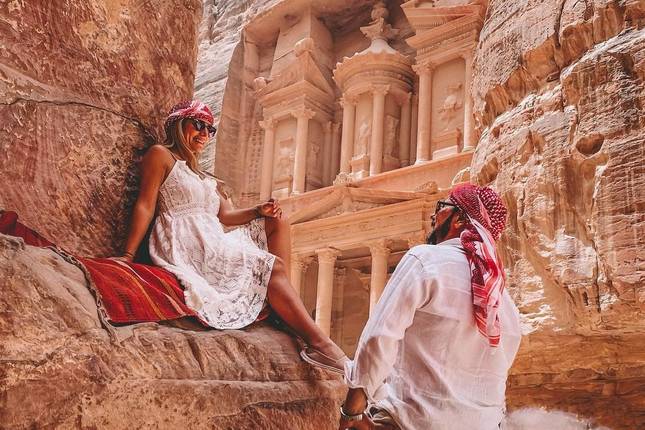
Jewels of Jordan - Group Tour By Locals
6 days from €1,154 €751
- Explore ancient ruins at Umm Qays Tour the Citadel and Roman Theatre in Amman Discover Petra and the iconic Al Khazneh Experience a sunset Jeep tour in Wadi Rum Float in the hypersaline waters of the Dead Sea

Highlights of Jordan
8 days from €1,249 €1,062
- Explore ancient Jerash and float in the Dead Sea See Madaba mosaics and visit Karak Castle Tour the iconic Petra with a knowledgeable guide Experience a 4x4 desert adventure in Wadi Rum Relax or snorkel at the beautiful Red Sea

Explore Jordan
8 days from €1,430 €1,001
- Spend the night at Wadi Rum's mystic desert Visit the legendary ancient lost city of Petra Grab that photo of a float in the Dead Sea Delve into culture and camp with the Bedouin people
Sign up for our newsletter
...and instantly receive access to exclusive deals and inspiring travel stories.
By submitting this form, I agree to the TourRadar T&Cs and Privacy policy .

Visit Responsibly
Sustainable tourism in jordan, faqs about jordan, do you tip in jordan.
Yes, you should tip for services provided by hotel porters, restaurant staff and general service providers. A tip of 10% is standard in almost all circumstances.
What is the internet access like?
Internet connection, particularly WiFi, is readily available in most hotels, cafes and restaurants. In addition, 4G phones are available to rent.
Is the tap water safe to drink?
Technically the tap water is safe to drink. However, most people recommend buying bottled water or boiling the tap water before drinking.
Can I use my credit cards?
Credit cards are widely used. However, it’s advisable to carry cash as not everyone, especially local vendors, accept credit cards.
What are the public holidays?
Along with common public holidays like New Year's Day, Labour Day and Christmas, Muslim holidays such as Eid al-Adha, Ras Assanah Al Hijri (Islamic New Year) and Isra Wal Mi-'raj are celebrated. Jordan also celebrates Independence Day (May 25) and King Abdullah's Accession to the Throne (June 9).
What are the toilets like?
Western-style toilets are widely available in hotels and some restaurants but many of the public toilets are of the squat variety. Typically, they use water for cleaning so toilet paper isn’t always readily available in toilets. Dispose of your soiled toilet paper in the bin provided.
Is it a safe place for women to solo travel?
Jordan has an intrinsically respectful culture and a better attitude towards women compared to other parts of the world. Women have travelled solo around Jordan without encountering any aggressive behaviour or harassment. Still, be prepared to politely fend off flirting and proposals of marriage.
Is there a dress code for tourists visiting Jordan?
Though Jordan is a fairly liberal country, showing too much skin is still unseemly and might cause offence especially outside the big cities. Amman is slightly more open to sleeveless and shorter garb yet smaller cities and towns are not. To be safe, pack loose pants, longer skirts and sleeved tops.

The Best Tour Guide Tips for Travelling to Saudi Arabia
Stephanie Fuchs
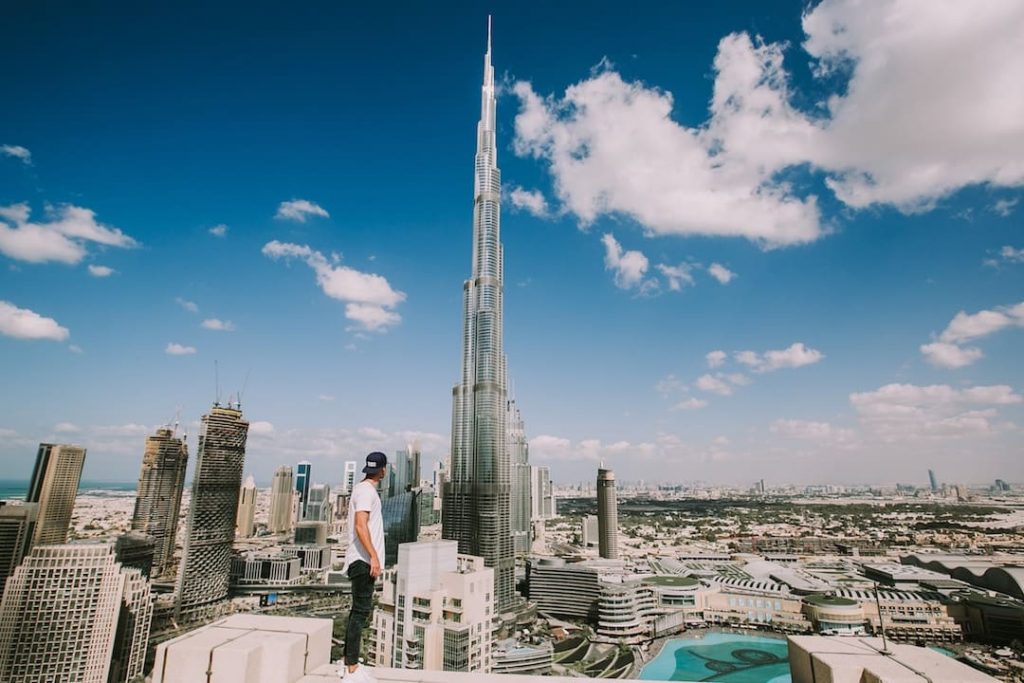
The 5 Safest Places to Visit in the Middle East
Allison Gutscher
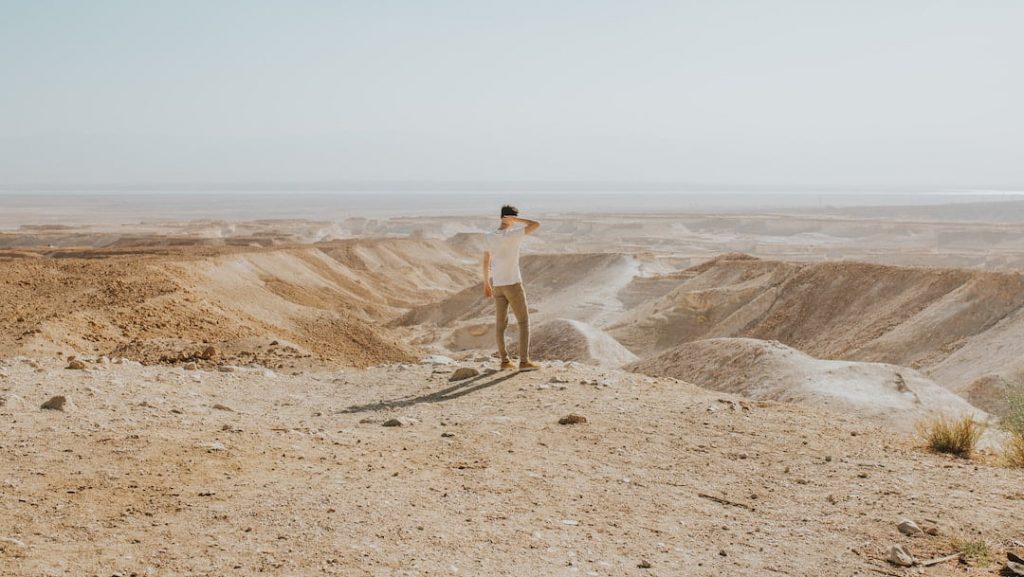
How to Spend a Week in Israel If You’re an Adventure Lover
Days to Come Editorial Team
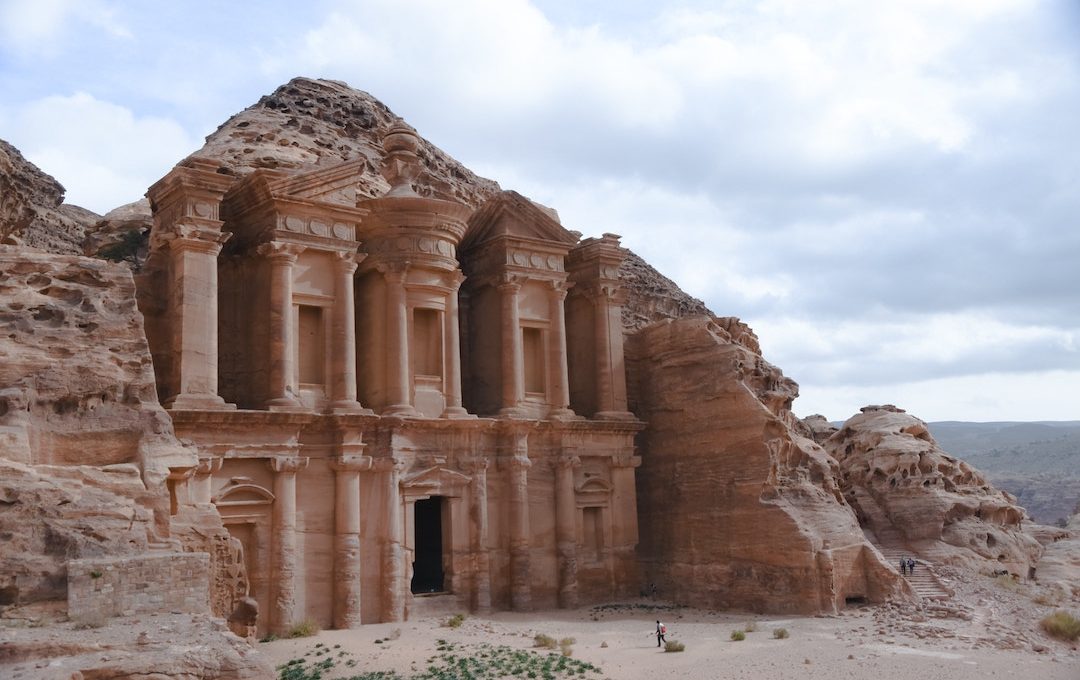
Here are the Reasons to Visit Jordan, and Soon
Melanie Cheng

JORDAN TOURISM BOARD
Please Select Language / Region
- Travel Tips Jordan for planning and on the go
Book your individual trip , stress-free with local travel experts
Select Month
- roughguides.com
- Middle East
- travel-advice
- Travel guide
- Itineraries
- Local Experts
- Travel Advice
- Accommodation
Plan your tailor-made trip with a local expert
Book securely with money-back guarantee
Travel stress-free with local assistance and 24/7 support
A. Weichselbraun
We were very happy with our guides. They had excellent people skills, were very knowledgeable and accommodating. We can only highly recommend them.
More travel information for Jordan
From travel safety to visa requirements, discover the best tips for visiting Jordan
- Culture and Etiquette in Jordan
- Eating and drinking in Jordan
- How to get to Jordan
- Getting around Jordan: Transportation Tips
- Shopping tips for Jordan
- Best time to visit Jordan
Following strenuous efforts by cartographers and government officials, Jordan now uses street addresses in some areas – but it’s only in the big cities that streets sport nameplates and buildings are numbered. Problems arise in spelling – there’s no universally accepted method of transliterating Arabic into English, so online mapping systems may not use the same spelling as the street sign in front of you – and also in usage: many people still ignore the system, navigating instead in relation to prominent landmarks or by asking passers-by. Mail is delivered only to PO boxes at post offices.
Typical Costs in Jordan
Crime and personal safety in jordan, customs and duty-free, electricity, jordan visas and entry requirements, travel insurance, mail in jordan, jordan maps, money in jordan, jordan opening hours and public holidays, smoking in jordan, time in jordan, useful numbers, tourist information, useful websites, travellers with disabilities, travelling with children in jordan, health advice for jordan, the media in jordan, travel ideas for jordan.
Created by local experts

Discover Jordan
Jordan has it all: spectacular desert scenery; the Dead Sea, age-old cities, castles, monuments, and more. Discover the best of this welcoming country as you delve into the history of ancient civilizations and see one of the New Seven Wonders of the World up close.

Treasures of Jordan
From the Dead Sea's restorative salty shores to Red Sea reefs teeming with aquatic life, Jordan is full of treasures. Get a taste of desert life and adventure in Wadi Rum; then fill up on culture in Petra and Amman, and maybe squeeze in a trip to Jerusalem, too.

Highlights of Jordan
Explore the highlights of Jordan in this compact itinerary. Activities include stargazing in Wadi Rum, exploring Petra and spending a day at leisure at the Dead Sea. Your knowledgeable guide will share stories about history and culture and introduce the Bedouin lifestyle to you.

An active adventure in Jordan
Experience a mix of hiking in the North of Jordan, canyon trails and relaxing activities combined with sightseeing of the highlights and meeting locals. This trip is accompanied by a knowledgeable guide and is not recommended during wintertime (November to February).

Jordan Culture in depth
Get to know the Jordanian culture in depth, indulge in mouthwatering street and local homemade food, meet the owner of the smallest hotel in the world, learn more about the Bedouins and the desert in Wadi Rum and finish off by floating over the Dead Sea mineral water.

Family adventure in Jordan
Indulge into the magical ancient world of Jordan on this thrilling family adventure! This tour has been specially designed to highlight the most exciting corners of Jordan, from natural reserves to historical Jerash to magnificent Petra, from Wadi Rum desert to the blissful Dead Sea.
Though sometimes surprisingly expensive, Jordan is generally pretty good value. It’s possible to see the sights, eat adequately, sleep in basic comfort and get around on public transport for roughly £70/US$90 a day for two. If you like things more comfortable – staying in good mid-range hotels, eating well, perhaps renting a car to see some out-of-the-way places – reckon on nearer £120/US$150 a day for two. To travel independently while hiring drivers and guides, staying in five-star hotels and generally living the high life, a realistic minimum is £250/US$320 a day for two. All these figures – which are rounded and approximate – exclude the cost of getting into Petra, which at £100/US$130 for a two-day ticket for two people, could bust your budget, though the Jordan Pass (see page ) can help offset some costs.
Jordan has a government sales tax, which applies at different rates, depending on the goods/services involved, up to about sixteen percent: bear in mind that, in many situations, the price you see (or are told) doesn’t include this tax, which is only added on when you come to pay. In Aqaba, sales tax is lower than the rest of Jordan. In addition, hotels and restaurants above a certain quality threshold automatically add a ten percent service charge to all bills. They are legally obliged to state these charges somewhere, although it can be as surreptitious as a tiny line on the bottom of a menu.
The sense of honour and hospitality to guests embedded deep within Arab culture, coupled with a respect for others, means that you’re extremely unlikely to become a victim of crime while in Jordan. Along with the ordinary police, Jordan maintains a force of English-speaking tourist police, identifiable by their armbands with English lettering. Posted at all tourist sites nationwide, they can deal with requests, complaints or problems of harassment. Any representation by a foreigner, whether to the tourist police or the ordinary local police, will generally have you ushered into the presence of senior officers, sat down and plied with coffee, with your complaint taken with the utmost seriousness. The nationwide police emergency number is T911. Dial T199 for an ambulance. Otherwise you’re only likely to tangle with the police if they catch you speeding.
Terrorism and civil disorder in Jordan are extremely rare. At the time of writing, the British Foreign and Commonwealth Office (FCO) had no warning against travel anywhere in Jordan, other than to within 3km of the border with Syria, because of the small risk of stray firing from across the frontier. There is no reason for tourists to venture anywhere near the border, anyway. Across the country, all big hotels have barriers keeping vehicles clear of the entrance, and airport-style security for everyone entering the building (including compulsory baggage X-ray and body search). Armed police patrol all major tourist sites. Regardless of the impression you might get from the nightly news – and as long as you stay clear of the border zones with Syria and Iraq – you’d be in no more danger travelling round Jordan than you might be in your home country.
Note that it is illegal to insult the king or the royal family, possess drugs or pornography, preach Christianity in public or encourage people to convert to any religion other than Islam.
You’re permitted to buy two hundred cigarettes, one litre of spirits and two litres of wine duty-free on arrival in Jordan. All borders and airports have duty-free shops which open for long hours, but if you forget to buy your allowance of alcohol, cigarettes, perfume or electronic goods when you arrive, you can go to the Duty-Free Shop on Tunis Street near 5th Circle in Amman (T06 520 6666, jdfshops.com ) within fourteen days, where the whole range is available. Bring your passport.
The area around Aqaba is a Special Economic Zone, with lower taxes and its own customs rules: on all roads into the city, you’ll have to pass through a customs station. On departing the zone, you may be subject to checks: personal items, plus up to two hundred cigarettes and one litre of alcohol that you bought in the zone, are exempt from duty.
Departing Jordan, duty-free shops at the airports and the land borders stock familiar ranges.
The supply in Jordan is 220V AC, 50Hz – the same as in Europe. Most new buildings and big hotels have British-style square three-pin sockets. Older buildings tend to have two-pin sockets for European-style thick-pronged, round plugs.
No immunizations or vaccinations are required to enter Jordan. However, before you travel, it’s a good idea to make sure you’re up to date with immunizations against hepatitis A, polio, tetanus (lockjaw), tuberculosis and typhoid fever. You should consult a doctor at least two months in advance of your departure date, as there are some immunizations that can’t be given at the same time, and several take a while to become effective.
Travel clinics
Australia & NZ traveldoctor.com.au .
Canada CSIH csih.org .
Ireland TMB tmb.ie .
UK MASTA masta.org .
US CDC cdc.gov/travel .
All visitors to Jordan must hold a passport valid for at least six months beyond the proposed date of entry to the country.
On arrival at all airports, as well as at most land and sea borders – apart from the King Hussein/Allenby Bridge and the Eilat–Aqaba border – most nationalities are routinely issued with a single-entry visa. If you arrive at Aqaba, it’s free; if you arrive anywhere else, it costs JD40 (payable in cash, Jordanian dinars only).
The visa fee is waived if you hold the Jordan Pass or if your trip has been booked through a licensed Jordanian tour operator and you’ll be spending at least two nights in Jordan.
Multiple-entry visas are available in advance only, from Jordanian embassies and consulates, for JD120 or the local equivalent.
Citizens of around fifty developing countries – listed at wvisitjordan.com – cannot obtain a visa on arrival and must instead apply at the nearest Jordanian embassy at least three months prior to travel.
Both single- and multiple-entry visas are valid for a stay of thirty days. If you’re planning to stay longer than that, you must register at any police station in the last couple of days before the thirty-day period is up – a simple, free, five-minute procedure which grants a three-month extension. For any queries, ask your hotel (or an Arabic-speaking friend) to call the Borders and Residence Department (T06 550 5360, psd.gov.jo ), part of the Public Security Directorate, on your behalf.
If you plan to enter Jordan for the first time via the King Hussein/Allenby Bridge, or via the crossing from Eilat to Aqaba, you must already hold a visa – they are not issued at these crossing points. If you left Jordan via the King Hussein/Allenby Bridge and are returning via the same bridge, you don’t need to buy another visa as long as your current one is still within its thirty-day validity period.
Always carry your passport on you: you’ll need it to check into hotels and to ease your way through any checkpoints.
Embassies and consulates
Full lists are at wvisitjordan.com .
Jordanian embassies abroad
Embassies and consulates in amman, visas at aqaba.
If you intend to cross by land from Eilat (Israel) to Aqaba you must already hold a Jordanian visa in advance.
If you arrive in Jordan elsewhere – other than the King Hussein/Allenby Bridge – and you let the passport officials know that you intend to go directly to Aqaba, you are in theory entitled to get a free ASEZ visa rather than paying for a standard visa. In these cases, though, you must register at the ASEZA offices in Aqaba within 48 hours of your arrival in Jordan: if you miss this deadline, you become liable for the cost of the visa plus a fine.
It’s essential to take out a good travel insurance policy to cover against theft, loss of property and illness or injury. Before paying for a new policy, however, it’s worth checking whether you are already covered: home insurance may cover your possessions when overseas, many private medical schemes include cover when abroad and premium bank accounts or credit cards often have travel insurance included. After exhausting these possibilities, contact a specialist travel insurance firm.
Airmail letters and postcards can take a week or two to Western Europe, up to a month to North America or Australasia. Asking someone to write the destination country in Arabic can help avoid things going astray. It’s safest to ignore the street postboxes and instead send your mail from larger post offices, all of which have a box for airmail ( barid jowwy ). Stamps ( tawabe’a ) cost pennies, but parcels are expensive (JD10–15 for 1kg). International courier firms are well represented in Amman and Aqaba.
Our detailed and interactive maps will guide you through your travels in Jordan. Click here to view our maps online .
The Jordanian unit of currency is the dinar, abbreviated to JD (or JOD). Most people refer to the dinar as a “ jaydee ” or a “ lira ”. One dinar is divided into 1000 fils or 100 piastres ( qirsh ). Locals always think in piastres; they only refer to fils when talking to foreigners. A hotel, restaurant or shop bill will show either “14.65” or “14.650”, both of which mean 14 dinars and 65 piastres (that is, 650 fils). In this Guide, we stick to two decimal places only.
Banknotes are JD50, JD20, JD10, JD5 and JD1, all with Arabic on one side and English on the other. For coins, there’s a gold, seven-sided half-dinar coin inset with a circular silver bit in the middle; a smaller quarter-dinar coin, also gold and seven-sided but without the silver inset; and silver coins of ten piastres and five piastres. All coins state their value on them somewhere in tiny English lettering.
In verbal exchanges, you’ll find that people quite often leave the denomination off the end of prices. If they say something costs “ ashreen ” (twenty), it’s up to you to decide whether they mean 20 fils (a throwaway amount), 20 piastres (ie 200 fils; the price of a street snack or a short bus ride), or 20 JDs (the cost of a room in a small hotel). Nicknames also pop up: 10 piastres is a barizeh and 5 piastres is a shilin .
Changing and carrying money
Few banks in the West keep Jordanian dinars on hand, but you should be able to order them with a few days’ notice. It’s a good idea to bring JD80 or so with you in cash, to cover visa and transport costs on arrival.
Most hotels and shops above the cheapest level accept credit and debit cards, but Jordan is a cash society: just about everywhere the preferred method of payment is local banknotes. You can’t pay in dollars, euros or other currencies.
Security-wise, Jordan is safer than anywhere in the West: you can carry wads of cash around in your pocket without concern. You’re more likely to be invited for tea than mugged.
For changing money, every town has a welter of banks, with identical exchange rates, and there are also plenty of independent change offices. Cash machines (ATMs) are widespread, always with an English option. You can generally withdraw a maximum of around JD250 a day, depending on your card provider, but watch for hidden fees and commission charges: it’s worth checking your terms and conditions before you leave home – and switching to a card tailored for holiday use if you can. There’s no black market in currency exchange.
Jordan’s working week runs from Sunday to Thursday. Public sector office hours are 8am–3pm; private sector businesses tend to follow a split pattern, perhaps 8.30am–1pm and 3.30–6.30pm. The weekend is officially Friday, though banks, government departments and many businesses also close on Saturdays.
Although Muslims pray together in the mosque on a Friday, the concept of a “sabbath” or “day of rest” does not translate: downtown shops and markets are generally open seven days a week, roughly 9am–9pm. More upmarket shops tend to open 9/9.30am–6/7pm, perhaps closing for two or three hours at lunchtime. Almost everywhere shuts for a couple of hours around Friday midday prayers. All transport services operate seven days a week, though there are fewer services on Fridays (none at all on some routes).
During Ramadan, the Muslim holy month of fasting, everything changes. Shops and offices open from 9am to 2 or 3pm (closed Fri), while street markets operate every day until about an hour before sunset. Banks and government departments may only be open for two or three hours in the morning. Some shops might reopen for a couple of hours after dark.
Public holidays in Jordan
Jordan’s secular national holidays tend to be low-key affairs; banks, businesses and government offices are closed, but shops might open as normal. Even though Jordan’s Christians are mostly Orthodox and follow the Julian calendar, which varies from the Gregorian calendar used in the West by a couple of weeks, everyone has agreed to celebrate Christmas Day together as a national holiday on December 25 (Muslim shops and businesses don’t close).
Jordan public holidays
- Jan 1 New Year’s Day
- May 1 Labour Day
- May 25 Independence Day
- Dec 25 Christmas Day
Islamic holidays and Ramadan
Islamic religious holidays, based on the Hijra calendar, are marked by widespread public observance. All shops and offices are closed and non-essential services are liable to be suspended. The following dates are approximate, since each holiday is announced only when the new moon has been seen clearly by an authorized cleric from Jordan’s Ministry of Islamic Affairs. Quoted dates could vary by a couple of days. The start of the holy month of Ramadan is also included here; Ramadan is not a holiday, but since it comprises thirty days of restricted business hours, its first day is a useful date to know.
Islamic holidays
Eid al-Isra wal-Miraj Night Journey to Heaven:
March 22, 2020; March 11, 2021; March 1, 2022; Feb 18, 2023.
1st day of Ramadan: April 24, 2020; April 13, 2021; April 2, 2022; March 22, 2023.
Eid al-Fitr Three days: begins May 24, 2020; May 13, 2021; May 3, 2022; April 22, 2023.
Eid al-Adha Four days:begins July 31, 2020; July 20, 2021; July 10, 2022; June 28, 2023.
1st of Muharram Islamic New Year: Aug 20, 2020; Aug 9, 2021; July 30, 2022; July 19, 2023.
Mawlid an-Nabawi Prophet Muhammad’s birthday: Nov 10, 2019; Oct 29, 2020; Oct 19, 2021; Oct 8, 2022, Sept 27, 2023.
Landline numbers are nine digits long – seven digits prefixed by a two-digit area code: 02 covers northern Jordan, 03 southern Jordan, 05 the Jordan Valley and central and eastern districts, and 06 the Amman area.
Mobile phone numbers are ten digits long – seven digits prefixed by a three-digit code (currently 077, 078 or 079).
Most Jordanians have given up on landlines and instead rely on mobile phones – many people have two, on different networks. To follow suit you can walk into any phone or electronics shop (there are dozens in every town), buy a local SIM card, plug it into your unlocked handset and be up and running with a Jordanian number in minutes, for around JD10. Topping up with scratchcards (buyable everywhere) is straightforward. Calling and texting off a local number is very inexpensive – much cheaper than roaming from your home network. Basic handsets can be purchased for perhaps JD20–30.
Smoking is banned in public places, including airports, museums and on public transport. However, enforcement is minimal and in effect it’s impossible to escape cigarette smoke anywhere in the country.
Jordan is usually two hours ahead of London, seven hours ahead of New York and eight hours behind Sydney. Daylight Saving Time operates from the last Friday in March to the last Friday in October.
Emergencies
Police T911
Ambulance T199
Traffic accidents T190
Phoning home
To the UK T0044
To the Republic of Ireland T00353
To the US or Canada T001
To Australia T0061
To New Zealand T0064
To South Africa T0027
Calling Jordan from abroad
First dial your international access code (00 from the UK, Ireland and New Zealand; 011 from the US and Canada; 0011 from Australia), followed by 962 for Jordan, then the Jordanian number excluding the initial zero.
In a good restaurant, even when a service charge is included, it’s customary to round the bill up slightly as well. Low-budget local diners don’t expect tips and will never press you for anything. In most everyday situations a half-dinar tip (ie JD0.50) is a perfectly satisfactory indication of your appreciation for a service, such as a hotel porter loading your bags onto a bus or taxi. Taxi drivers deserve ten percent of the meter charge; if a driver has spent half a day shuttling you from place to place, JD5–10 is in order. An appropriate tip for a bellboy in a four- or five-star hotel who brings your bags up to your room is JD1.
The Jordan Tourism Board, or JTB ( visitjordan.com ), part affiliated to the Ministry of Tourism and part private, publicizes the country’s tourist assets abroad under the Visit Jordan brand. It is very active on Twitter, Facebook and other social media. In most countries, the account for handling promotion of Jordan is awarded to a local PR company, so contact details can, and do, change.
visitjordan.com Jordan’s official tourism portal.
kingabdullah.jo Detailed features on history, the royal family, politics and tourism.
jordantimes.com Leading English-language newspaper.
wildjordan.com Excellent information on Jordan’s nature reserves.
www.nomadstravel.co.uk For climbing and trekking enthusiasts.
maani.us/jordan Superb “Field Guide to Jordan”: download their app or buy the book.
jmd.gov.jo Weather forecasts and climate data (Arabic only).
Jordan makes few provisions for its own citizens who have limited mobility, and this is reflected in the negligible facilities for tourists. The best option is to plump for an organized tour; sightseeing is liable to be complicated enough – leaving the practical details to the professionals will take a weight off your mind. Throughout the country, pavements are either narrow and broken or missing altogether, kerbs are high, stairs are ubiquitous and wheelchair access to hotels, restaurants and public buildings is pretty much nonexistent. Hotel staff and tourism officials, although universally helpful, are generally poorly informed about the needs and capabilities of tourists with limited mobility. Travelling with an able-bodied helper and being able to pay for things like a rental car (or a car-with-driver) and good hotels will make things easier.
All Jordan’s ancient sites are accessible only by crossing rough and stony ground. Scrambling around at Jerash or Karak is hard enough for those with full mobility; for those without, a visit represents a major effort of energy and organization. Petra has better access: with advance planning, you could arrange to rent a horse-drawn cart to take you from the ticket gate into the ancient city, from where – with written permission obtained ahead of time from the tourist police – you could be picked up in a car and driven back to your hotel.
Children are universally loved in Jordan, and travelling with your family is likely to provoke spontaneous acts of kindness and hospitality from the locals.
Children are central to Jordanian society – many couples have four or five, and double figures isn’t uncommon. Middle-class extended families tend to take pleasure in spoiling kids rotten, allowing them to stay up late and play endlessly, but as a counterpoint, kids from low-income families can be seen out on the streets at all hours selling cigarettes. The streets are quite safe and even very young children walk to school unaccompanied.
Only the cheapest hotels will bar children; most will positively welcome them (with deals on extra beds or adjoining rooms), as will all restaurants, although discounts may have to be negotiated. There are a few precautions to bear in mind. Foremost is the heat: kids’ sensitive skin should be protected from the sun as much as possible, both in terms of clothing (brimmed hats and long sleeves are essential) and gallons of sunblock. Heatstroke and dehydration can work much faster on children than on adults. Sunglasses with full UV protection are vital to protect sensitive eyes. Kids are also more vulnerable than adults to stomach upsets: you should definitely carry rehydration salts in case of diarrhoea. Other things to watch out for include the crazy traffic (especially for British kids, who’ll be used to cars driving on the other side of the road), stray animals that may be disease carriers, and jellyfish and poisonous corals off Aqaba’s beaches.
Children will love riding camels in Wadi Rum, and even Petra’s threadbare donkeys may hold an appeal. Most of the archeological sites will probably be too rarefied to be of more than passing interest (aside, possibly, from exploring towers and underground passages at Karak, Shobak or Ajloun castles); spotting vultures, ibex and blue lizards at Dana or Mujib may be a better bet, and the glass-bottomed boats at Aqaba are perennial favourites. Children born and brought up in urban environments will probably never have experienced anything like the vastness and silence of the open desert, and you may find they’re transfixed by the emptiness of Wadi Rum or the eastern Badia.
No immunizations or vaccinations are required before you can enter Jordan. However, before you travel, it’s a good idea to make sure you’re up to date with immunizations against hepatitis A, polio, tetanus (lockjaw), tuberculosis and typhoid fever. You should consult a doctor at least two months in advance of your departure date, as there are some immunizations that can’t be given at the same time, and several take a while to become effective.
Australia & NZ
Dehydration.
An adult should normally drink two litres of water a day; from day one in the Middle East, you should be drinking at least three litres – and, if you’re exerting yourself in hot conditions, more than double that. It’s a matter of pride among the desert bedouin not to drink water in front of foreigners, but if you copy them you’re likely to make yourself ill. Drinking to quench your thirst just isn’t enough in a hot climate: you must drink well beyond that if you’re to head off lethargy and splitting headaches. Alcohol and caffeine exacerbate the effects of dehydration.
Heat exhaustion and sunstroke
The Jordanian sun can be scorchingly intense, and – obvious though it sounds – you should do all you can to avoid sun exposure, especially if you’re travelling in high summer (May–Sept). Head protection is essential. Lightweight 100 percent cotton clothes – such as long-sleeved shirts, and long trousers or ankle-length skirts – will allow air to circulate close to your skin to keep you cool and limit both sunburn and dehydration. If you feel very hot, dizzy and faint but aren’t sweating, you may have sunstroke: get out of direct sun and into air conditioning and/or cold water as soon as possible. Call a doctor if symptoms worsen.
Travellers’ diarrhoea
If you arrive in Jordan directly from the West (or Israel), give your stomach a chance to acclimatize: avoid street food for a few days and spend a little extra to eat in posher, but cleaner, restaurants. Every eating place, from the diviest diner upwards, will have a sink with soap for washing your hands. Nonetheless, few travellers seem to avoid diarrhoea altogether. Instant recourse to drugs such as Imodium or Lomotil that plug you up (in fact, what they do is paralyse your gut) is not advisable; you should only use them if you absolutely must travel (eg if you’re flying). The best thing to do is to wait, eat small amounts of dry food such as toast or crackers if you feel able and let it run its course, while constantly replacing the fluids and salts that you’re flushing away. Maintaining fluid intake (even if it all rushes out again) is vitally important. Oral rehydration solutions such as Dioralyte or Electrosol are widely available worldwide, sold in sachets for dissolving in a glassful of clean water. They’re marketed as being for babies, but will make you feel better and stronger than any other treatment. If you can’t get the sachets, make up your own solution with one heaped teaspoon of salt and twelve level teaspoons of sugar added to a standard-sized (1.5-litre) bottle of mineral water. You need to keep downing the stuff, whether or not the diarrhoea is continuing – at least a litre of the solution per day interspersed with three litres of fresh water. Bouts of diarrhoea rarely last longer than 24–48 hours.
If it goes on for longer than four days, seek medical advice. Nasty but easily treatable diseases such as giardiasis and amoebiasis must be tested for by a stool examination. If there is blood in your diarrhoea, you’ve most likely got dysentery and must see a doctor.

Bites and stings
Malaria is not present in Jordan, though mosquitoes and sandflies are. Snakes are frightened of humans; if you walk slowly and noisily, any snakes present will slither away. To avoid tangling with scorpions and spiders never walk barefoot, and if you’re camping always shake out your shoes and clothes before wearing them.
Treatment in Jordan
Every town has a pharmacy ( saydaliyyeh ), generally staffed by fluent English-speaking professionals trained to Western standards. Unless you’re obviously a hospital case, this is where you should head first, since a pharmacist charges nothing for a “consultation”, and can either prescribe a remedy on the spot or refer you to a local doctor. If you’re given a medicine, find out explicitly from the pharmacist what the dosage is, since printed English information on the box might be sketchy.
If you need a doctor ( doktoor ), ask your embassy to recommend one or check first with a pharmacist. All doctors are trained in English, many in hospitals in the UK or US. If you’re in real trouble, aim for the emergency room of a hospital ( moostashfa ) – and call the emergency helpline of your embassy to ask for advice. Consultation fees and medical costs are much lower than back home, but you should still get signed receipts for everything in order to claim money back from your insurance company when you return.
With the widespread use of English in public life, you’ll have good access to news while in Jordan. International newspapers and magazines are on sale, the local English-language press is burgeoning and satellite TV is widespread. The internet is not censored.
Among the region’s conservative and often state-owned Arabic press, Jordan’s newspapers, all of which are independently owned, have a reputation for relatively well-informed debate, although strict press laws – and the slow process of media liberalization – cause much controversy. The two biggest dailies, ad-Dustour (“Constitution”) and al-Ra’i (“Opinion”), are both centrist regurgitators of government opinion; al-Ghad (“Tomorrow”) has a fresher outlook. There’s a host of other dailies and weeklies, ranging from the sober to the sensational. Local news websites abound.
English-language newspapers are widely available from the kiosks in all big hotels and also from some bookshops, as well as online: unlike elsewhere in the region, Jordan does not censor the internet. The International Herald Tribune and most British dailies and Sundays generally arrive one or two days late (JD2 and upwards). Look out for excellent regional papers such as Abu Dhabi’s The National , Beirut’s Daily Star and Cairo’s Al-Ahram Weekly .
For local news in English, the Jordan Times is published daily except Saturdays, featuring national news, agency reports and pro-government comment. Jordan’s citizen journalism website 7iber.com (pronounced hibber – it means “ink”) runs a more enticing mix of stories in Arabic and English, as well as useful what’s-on information. One key local news blog is black-iris.com , while w BeAmman.com collates news, reviews and opinions about life in Jordan’s capital city.
There’s a lively market for Jordanian magazines, with a range of English-language monthlies including quirky JO, mixing lifestyle features with investigative reporting on social and environmental issues, glossy Living Well , and sober Venture and Jordan Business . Plenty of international magazines are available, from Cosmopolitan to The Economist .
TV and radio
Jordan TV isn’t up to much. Almost all hotels have satellite TV, featuring CNN , BBC World News , Al Jazeera English , plus a few movies and sitcoms in English, alongside dozens of Arabic, European and Asian channels.
As well as stations devoted to Quranic recitation, local news, phone-ins, contemporary pop and old-time crooners, Amman has several English-language music radio stations playing Western hits, including Sunny 105.1 and Play 99.6.
Top image: King Abdullah Mosque in Amman Jordan © kravka/Shutterstock
The Rough Guides to Jordan and related travel guides
In-depth, easy-to-use travel guides filled with expert advice.

Travel advice for Jordan
Find even more inspiration for jordan here.

Ready to travel and discover Jordan?
Get support from our local experts for stress-free planning & worry-free travels.
- Where to stay
- Travel advice

The Right Jordan Itinerary For You
March 22, 2022

Plan your perfect Jordan itinerary and enter a world of swirling red sand, ancient cities, stargazing skies and stories that will last several lifetimes. Pull up a chair, grab some cardamom coffee and let’s walk you through our Jordan travel guide.
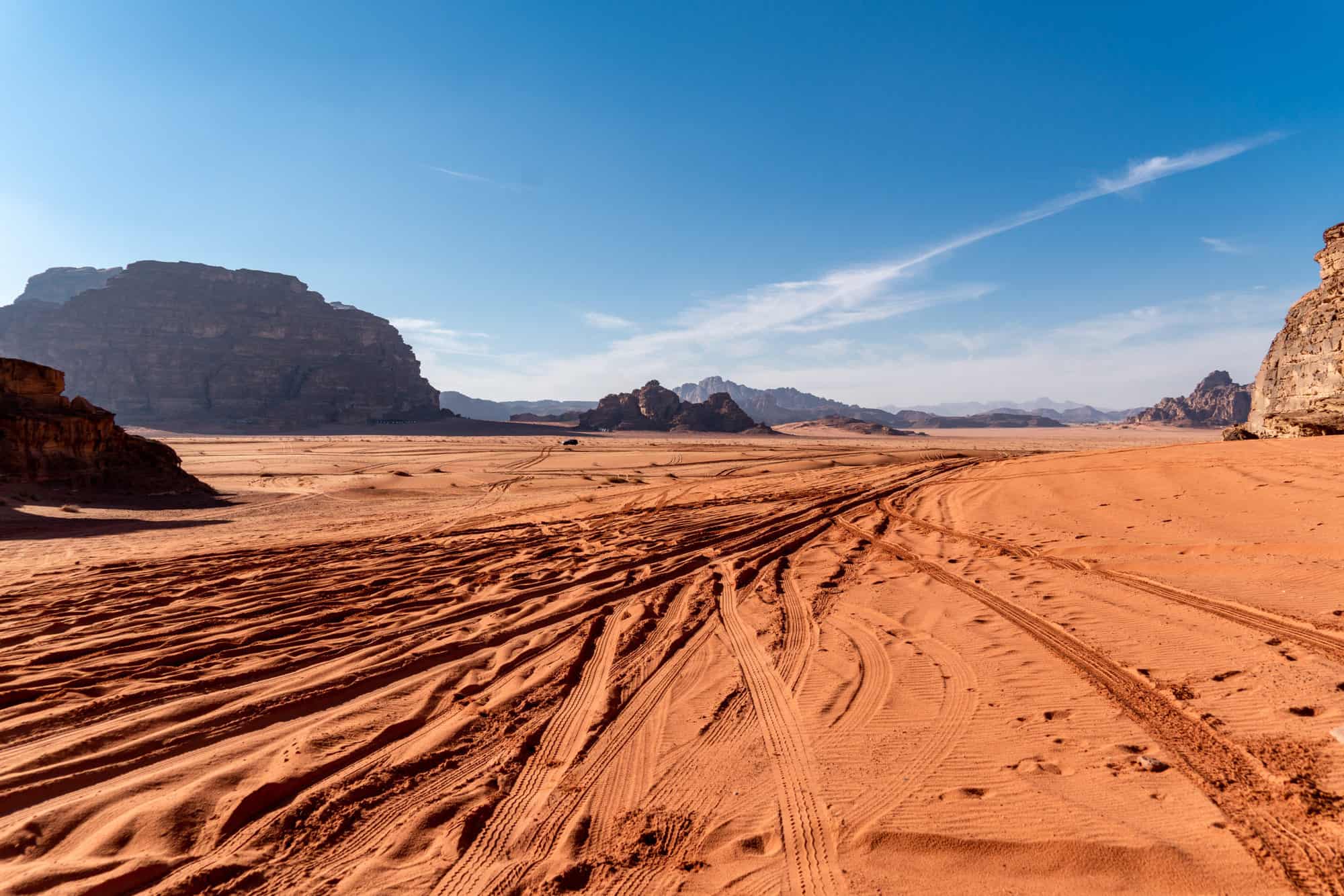
Table of Contents
Finding The Right Jordan Itinerary for You
I love travel in Jordan. There, I’ve said it. I love the swirling red desert sand, the stargazing at night, and the dates and pomegranates at open markets. I love the raspberry ripple stone canyons of Petra, the childlike joy of floating in the Dead Sea and the philosophical power punch of visiting holy sites from long ago. But most of all, I love the welcome from people.
Through tea, sumac and spice, I’ve enjoyed this Middle Eastern country so much that I go back time and again.
But when planning my first trip to Jordan, I didn’t know where to start. Jordan’s position in the Middle East means that a little planning is required when putting together your Jordan itinerary.
So here’s my guide to do just that. You can find all the more atmospheric stories about visiting Jordan over here and a guide to visiting the best places in the Middle East here.
In the meantime, let’s plan your itinerary for Jordan.
Jordan Itinerary At a Glance
- Arrive Amman
- See Amman and Jerash
- Explore Wadi Rum
- Hike through Petra
- Visit Kerak Castle and the Dead Sea
- See Mt Nebo, the Madaba Mosaics and Bethany Beyond the Jordan
- Head back to Amman
Jordan Itinerary Google Map
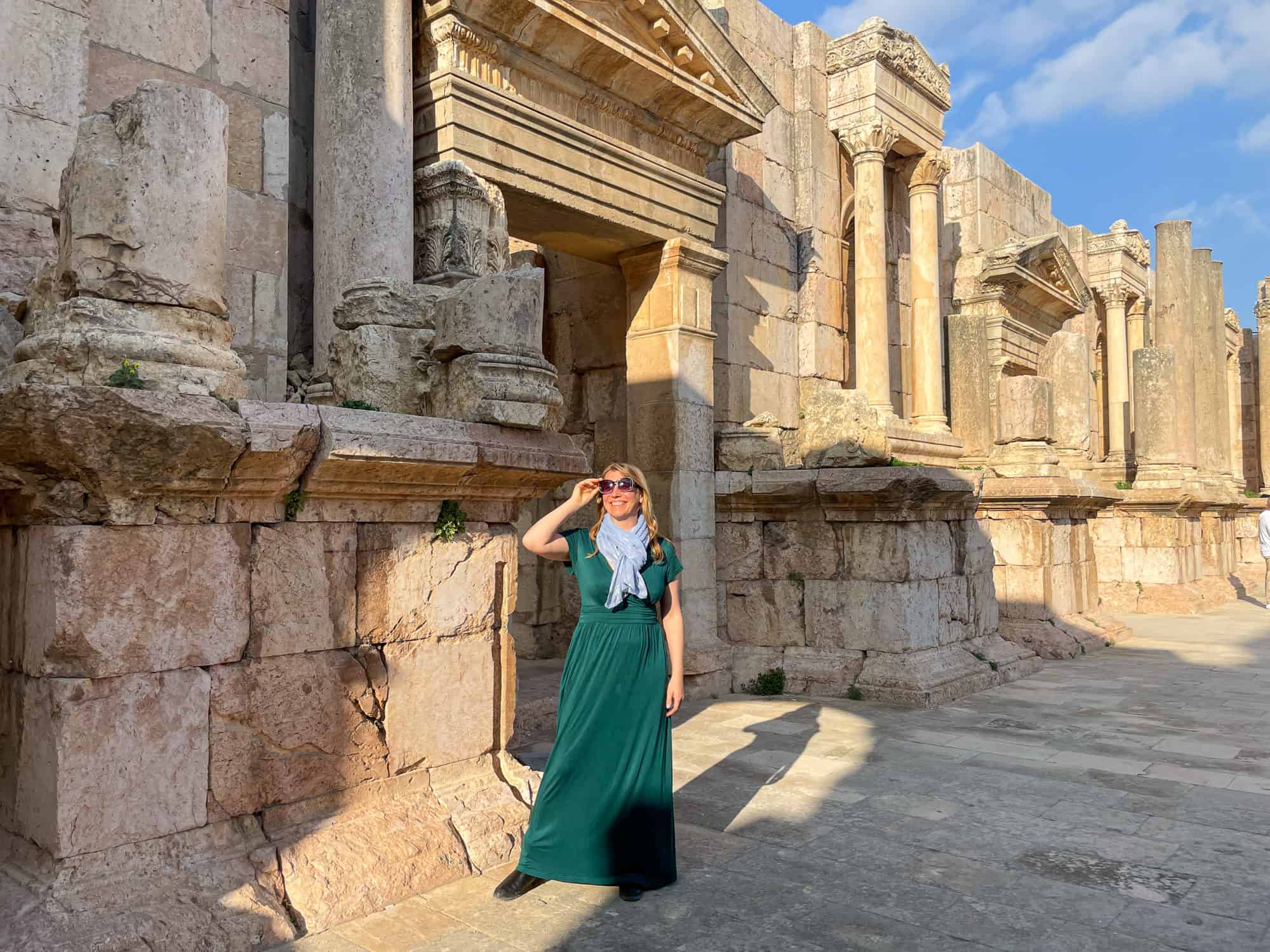
Jordan: one of the most interesting countries on earth…
Disclosure – I have travelled to Jordan many times, now, in partnership with Visit Jordan and Globus Travel on occasion. As ever, as always, I keep the right to write what I like here on the Lab. Otherwise, what’s the point? Also, if you book or buy through any of the links on this page then I may earn a small commission at no extra cost to you. Cheers!
Why Visit Jordan
Where do I begin?! Jordan has not one, not two, not three but many more world class places that stand head and shoulders above the highlights of many other countries.
First, and perhaps most famously, there is Petra. This hidden city and UNESCO World Heritage Site, buried in the rocks, was “rediscovered” by the world in 1812 by Swiss explorer Johann Ludwig Burckhardt . But local Bedouin had known about it, of course, for all this time. The view of the Treasury may be the most famous image of Jordan, but the Nabatean city extends for miles behind that.
Then there is the Dead Sea, the lowest point on earth, with a saline concentration so high you can float on its waters.
Jordan straddles part of the ancient Holy Land and so you can visit the site where Jesus was baptised, according to archaeologists and theologists alike, then conduct historical jigsaw puzzles with the mosaics of Madaba.
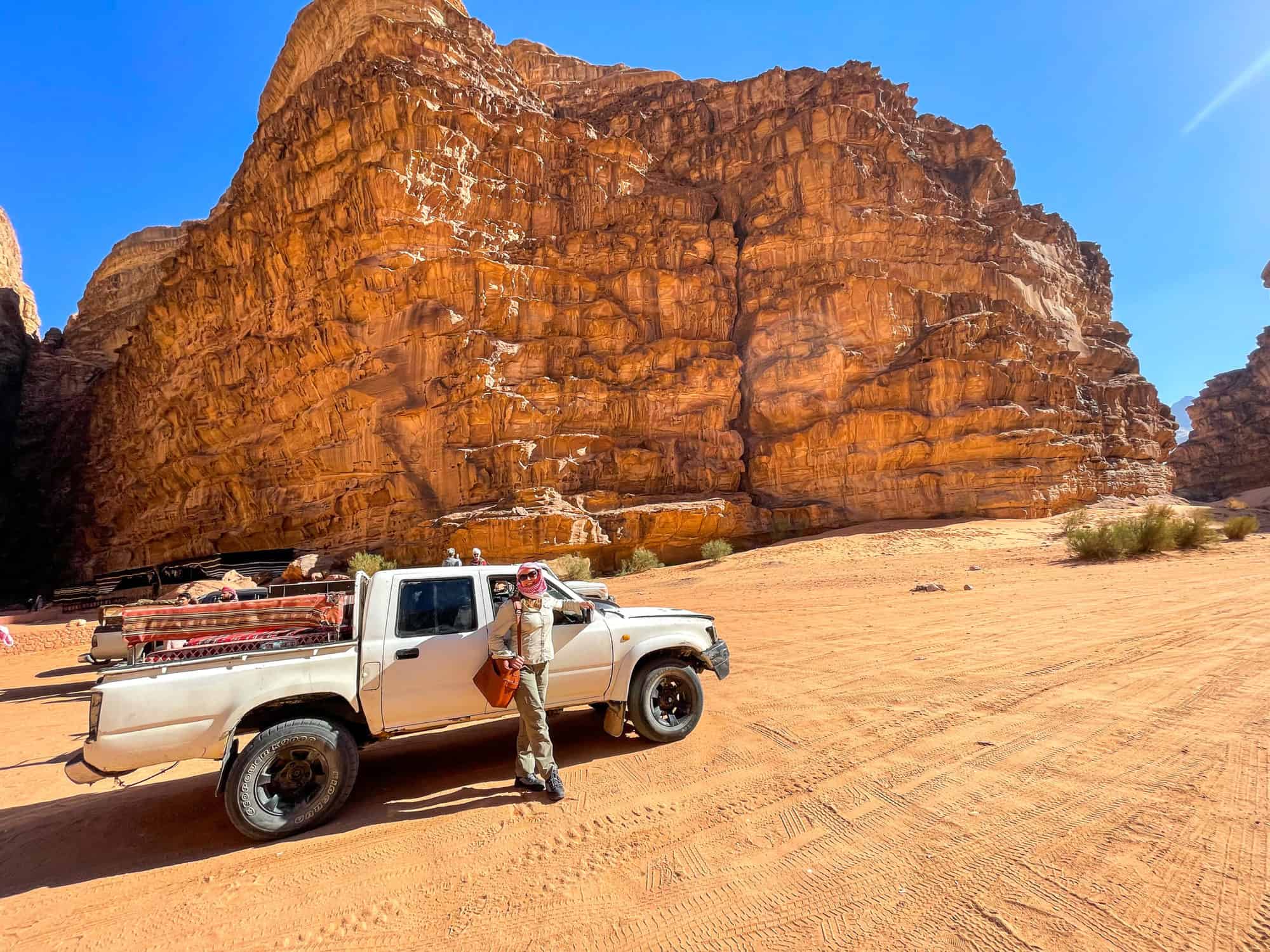
Wadi Rum, though not as well known, carves deep red dunes into the camel stone of the desert. It is powerfully, poignantly beautiful.
Then you have ancient Roman ruins, the oldest continuously inhabited city on earth, a range of fresh and flavoursome Jordanian food and a modern city with modern women running businesses from their home.
Phew. And do you know what else? I’m actually only getting started. Read about the best things to do in Jordan over here.
Now, let’s roll our sleeves up and get talking about practical travel tips for Jordan and work out how to plan the perfect Jordan itinerary for you!
How long do you need to visit Jordan?
You can comfortably hit the main sights with either a 7 day Jordan itinerary or a 10 day one. Of course, as a big supporter of slow travel and as someone who absolutely loves travel in Jordan, the longer the better if you can. More time will give you more opportunities to meet local people, hike off the beaten track and sample more of the food on offer.
But if time is tight, as it usually is, then you can still see a lot within a 7 day Jordan itinerary.
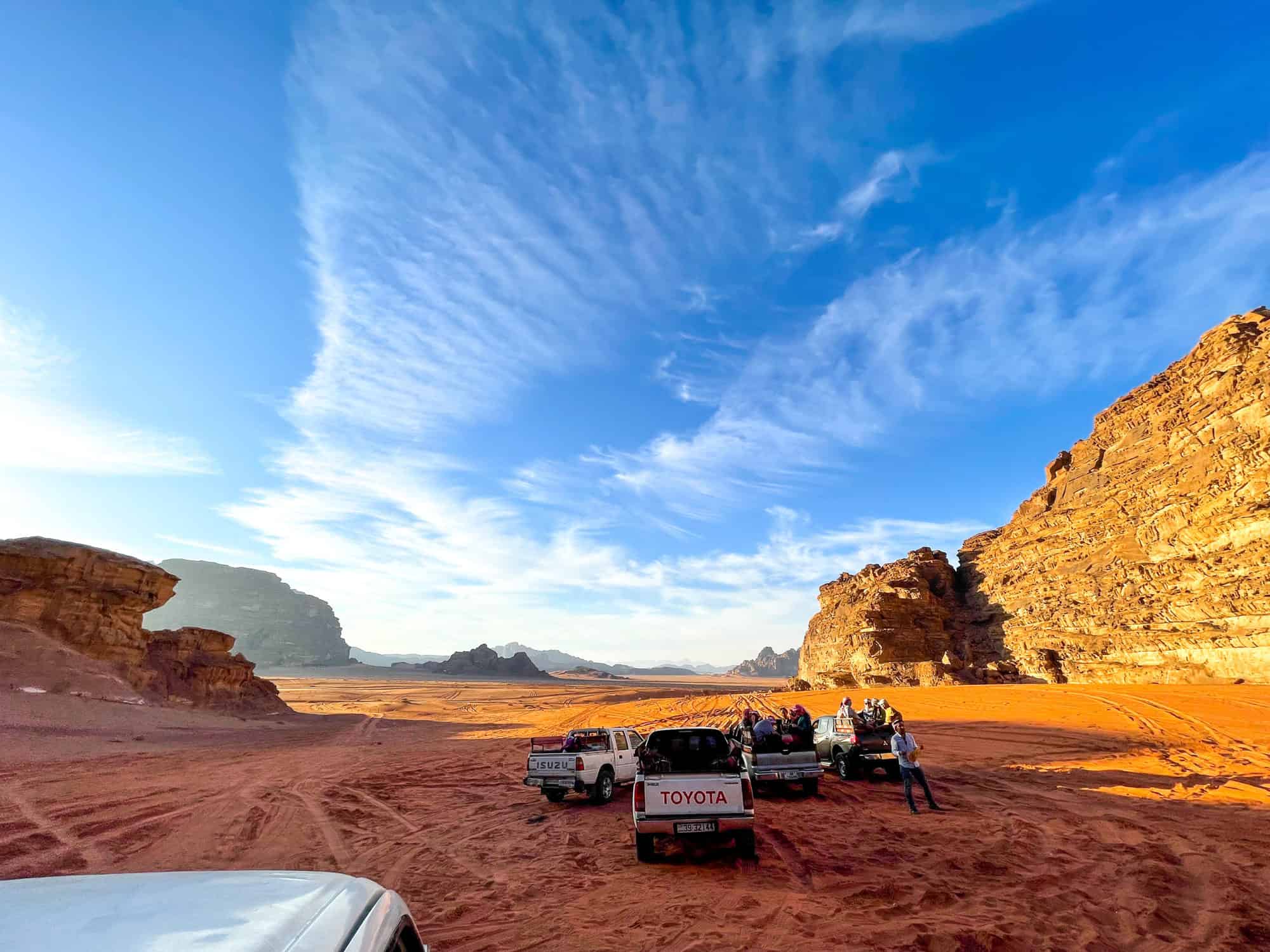
Should you join a group or go it alone?
Should you travel independently or join a tour?
Ah, that’s a big question. Again, as a passionate supporter of independent travel in general, there are a few things to bear in mind about travel in Jordan.
The first is the language barrier. In the popular tourist spots in the capital Amman and in the big resorts at the Dead Sea, Petra and Aqaba, you will find enough people who speak English to get by.
However, in more rural areas, and even in other popular spots like Wadi Rum, you will find that without speaking Arabic, it’s going to be difficult to work out what to do. Even if you blunder through to success (another method I enjoy on occasion) you will miss out on conversations with people, and that’s a shame because meeting new people is one of the best things to do in the Middle East.
With a tour, you will be travelling with a guide and interpreter and can learn much more about how Jordanian society works and interact with people more easily.
The second issue to consider involves the borders with Jordan’s neighbours. Jordan borders Iraq, Syria, Israel and Saudi and these are all borders with geopolitical significance – and often military guards. While Jordan itself is a very safe country to travel through, a blunder onto the wrong side of a border with the wrong paperwork is not a safe situation to find yourself in.
For these two reasons, I’d highly recommend travelling with a guide, at least outside the capital of Amman.
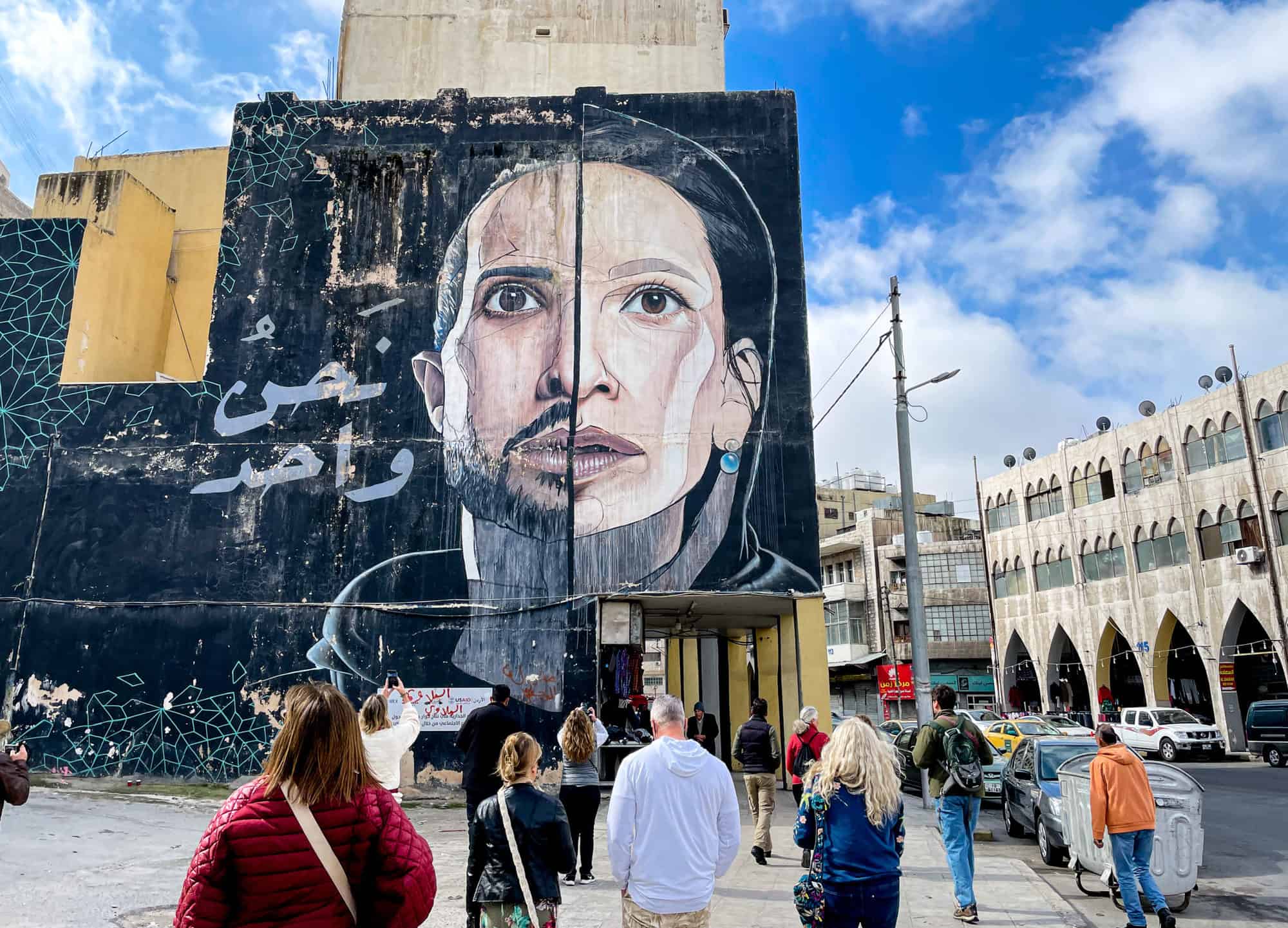
Globus Jordan Escape group walking through downtown Amman
Should you join a group trip?
So, onto the next question. Should you hire a private guide and driver? Or join a group tour?
Let’s talk about the pros and cons of joining a group tour, based on my recent trip to Jordan with Globus Escapes.
- You save an enormous amount of time! Calculating drive times, checking opening times, coordinating permits and border permissions, booking hotels, comparing rates, looking for parking, checking visas, checking safety recommendations. Sheesh! When someone does all that for you, you save a lot of time.
- You get company! Sure, you’re unlikely to become best friends with everyone, but in a group of more than about six people, you’re bound to find someone you like. I’ve made lifelong friendships from people I met travelling. Plus, even with more casual acquaintances, it’s nice to have people to meet at breakfast, to look after your bags and, well, in general look out for each other.
- You get access to things that are difficult to arrange on your own. This partly depends on the company (and I’ve travelled with some bad ones!) But Globus really made the effort to take us to places that would be difficult on your own. Sustainable travel places, like the Bait Khairat Souf and a family homestay meal in Wadi Musa. Not all of these excursions are included in the tour price but it was always clear in advance when that was the case. And they were all absolutely worth it.
- You get access to rich background information. Travel on your own and you’re with your own thoughts for the journey. Travel with Globus and you have a local guide filling you in on the background of the country, from how to tie the keffiyeh headscarf to deciphering marriage traditions, from bellydancing to mineral exports and everything in between. Do make sure this is the case, though. I have travelled with other tour companies where the guide is an enthusiastic fellow traveller just reading material from a worksheet. Globus always uses professional local guides.
- You get help if things go wrong. This is priceless. Especially during coronavirus times. Not only do you have access to someone who can speak the local language right in front of you but they also know the country and how it works. In our group alone, our guide tracked down lost electronics, sorted out health problems and provided advice for border crossings.
- Your interpreter can help you get to know people. One of the best things about the Middle East, or perhaps travel in general, is meeting people from different backgrounds to you. But that’s hard to do, sometimes, when you can’t speak the language. Having a Globus guide, for example, meant I could ask away and connect on a deeper level.
- You get off to the right start. I never fail to enjoy the treat of someone meeting me at the airport. In Jordan, with Globus, they meet you before you pass passport control and help with your visa application as well. Then, instead of haggling with waiting taxi drivers and wondering whether or not you’re being ripped off, you simply step into your waiting transport and are whisked off to your comfortable hotel. A great start to a journey.
- It’s much less stressful. T his point really builds on all the others. But you know that if something goes wrong while on the trip, it’s not your problem alone to fix it. You know that you are travelling with professionals who know the area and the language. If you get caught up in traffic, they will know the short cut and be able to call ahead to say you’re running late. If something worse happens, well, again, you have backup. It’s liberating.
- You can have some down time. Shhh. This is a bit of a strange one but I’ll say it anyway. When you travel with a private guide, there’s often a social expectation that you are both chatting all the time, which can start to feel a little awkward. Sometimes, it’s nice to be able to give your mind a break or close your eyes on long journeys. When you travel on a group tour, you can drift in and out of conversations, giving your mind some much needed rest.
- The size of the group makes some thing difficult. The more people there are, the longer the toilet breaks take, and the same for shopping trips, photo stops, snacks and everything else. Groups can’t visit small eateries and it’s harder to initiate authentic interactions with local people with a group of 30 behind you. Plus, if decisions go to a vote, chances are you won’t get your first choice. That’s just the way democracy works!
- If you miss something, you miss it. T ravel on your own and if you feel unwell, you can often pause and try again the next day. With a group, there’s no chance for that. The group moves on and you have to rejoin them when you can.
Having said all that, you can easily overcome many of the cons with a little initiative. You can peel off to arrange some meals on your own or leave the main tour to pick up a smaller one, if you wish. With Globus, we did this in Wadi Musa near Petra. A smaller group of us left the buffet one evening to dine in a family home. The next morning, we hired a guide to hike a different route into Petra. The key lies in good communication so that the rest of your group aren’t left confused and hanging around!
If you decide not to book through a group trip, then check out the Jordan Pass. I t may help you arrange your sightseeing.
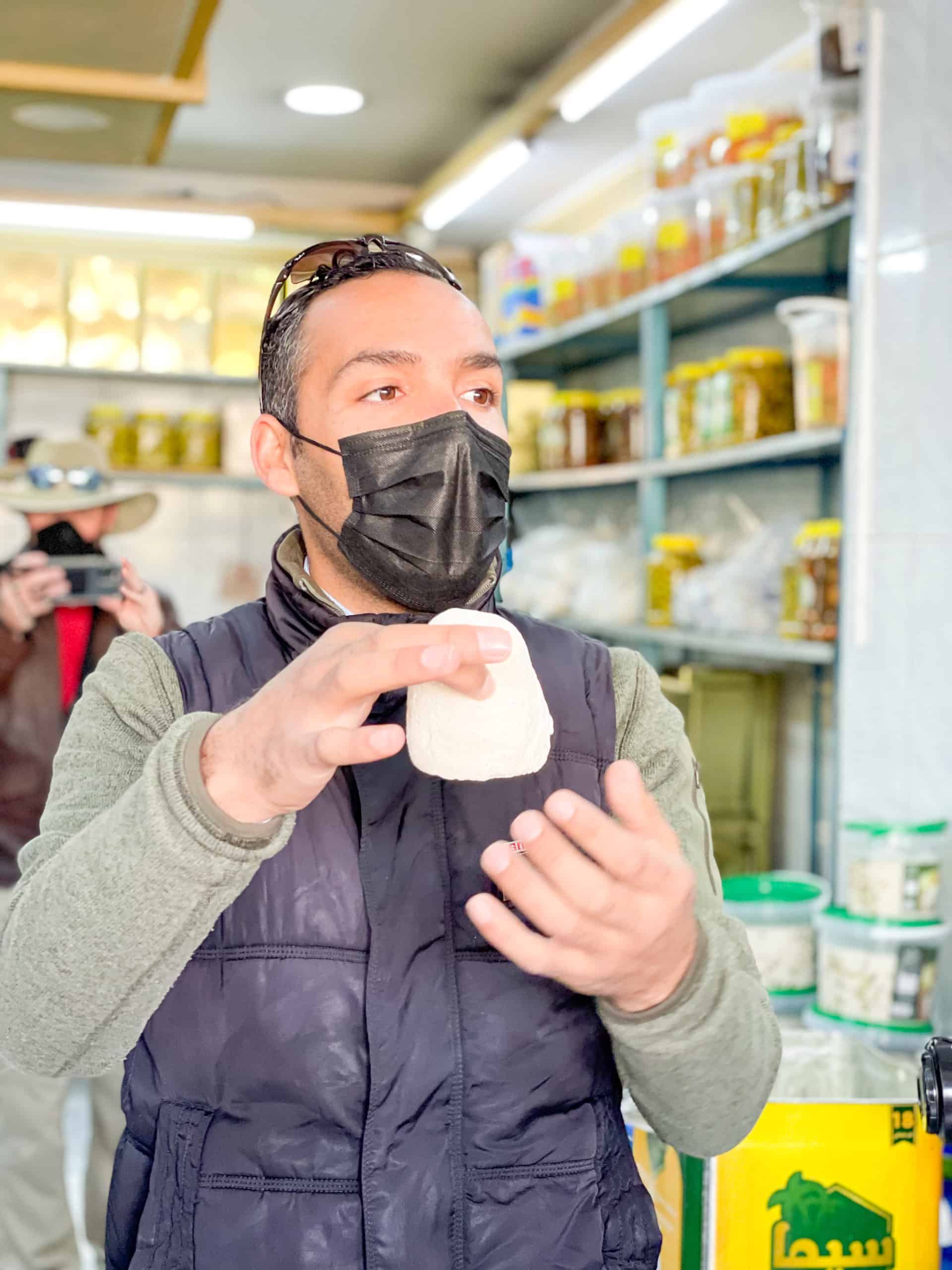
Osama: fabulous guide
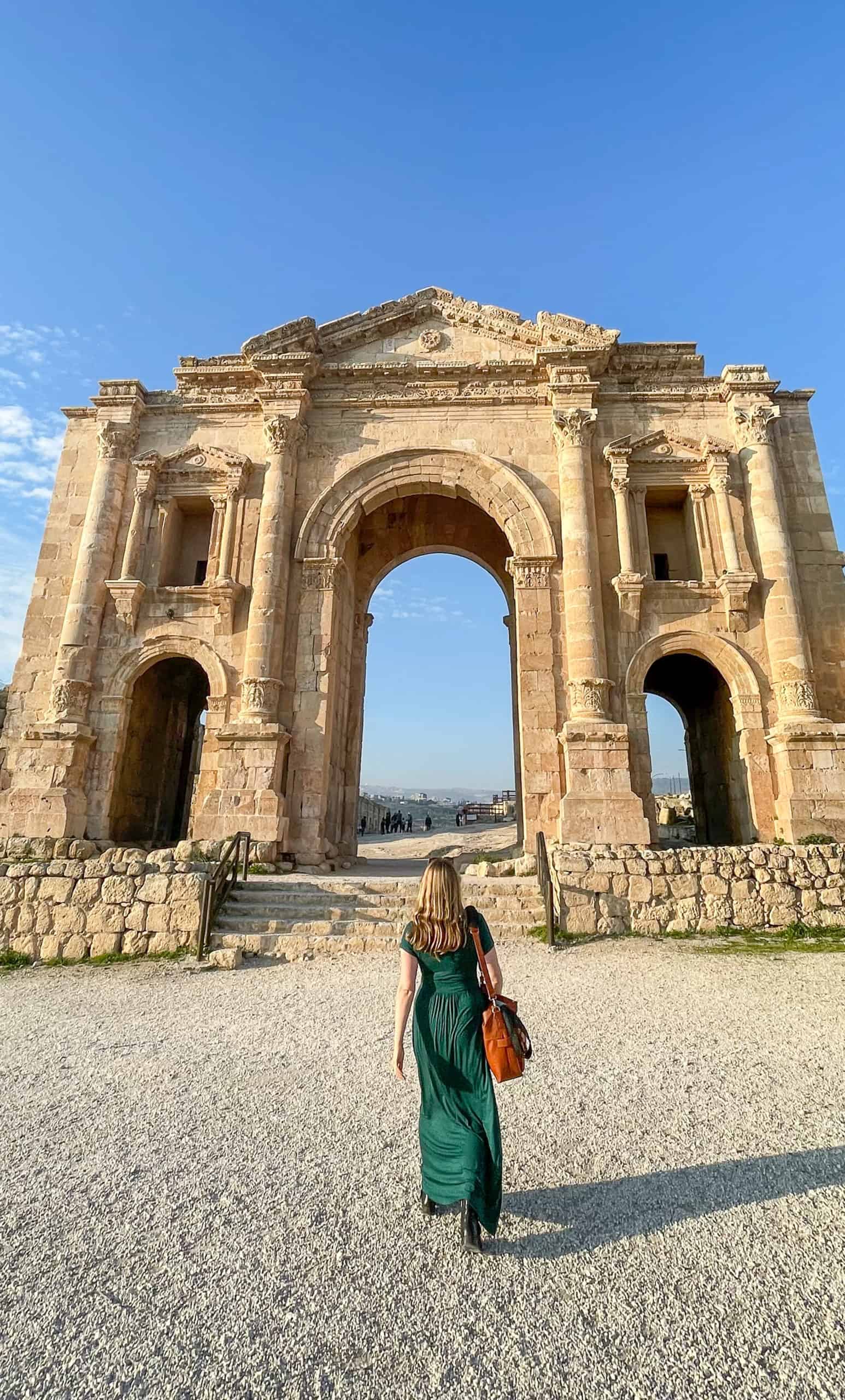
Travel in the off season, beat the crowds…
The Globus Escapes Concept
- Escapes by Globus have a genius idea: they take place during the off season. This way, you avoid temperature extremes, are less likely to be jostling nose to armpit with crowds of tourists and, yes, the tours cost less as prices are lower in the off season.
- This was my first experience of a Globus Tour but I found myself travelling with many, many people who had travelled with them before and who had booked this trip just as soon as they’d got home from their last Globus adventure.
- Our guide, Osama, was outstanding in his level of knowledge, degree of helpfulness and, crucially, sense of humour and joie de vivre.
- Our group was mostly 40 plus and for those travelling solo, they waive the single supplement.
Bookmark these Jordan travel itineraries and this Jordan travel guide on Pinterest to read later.
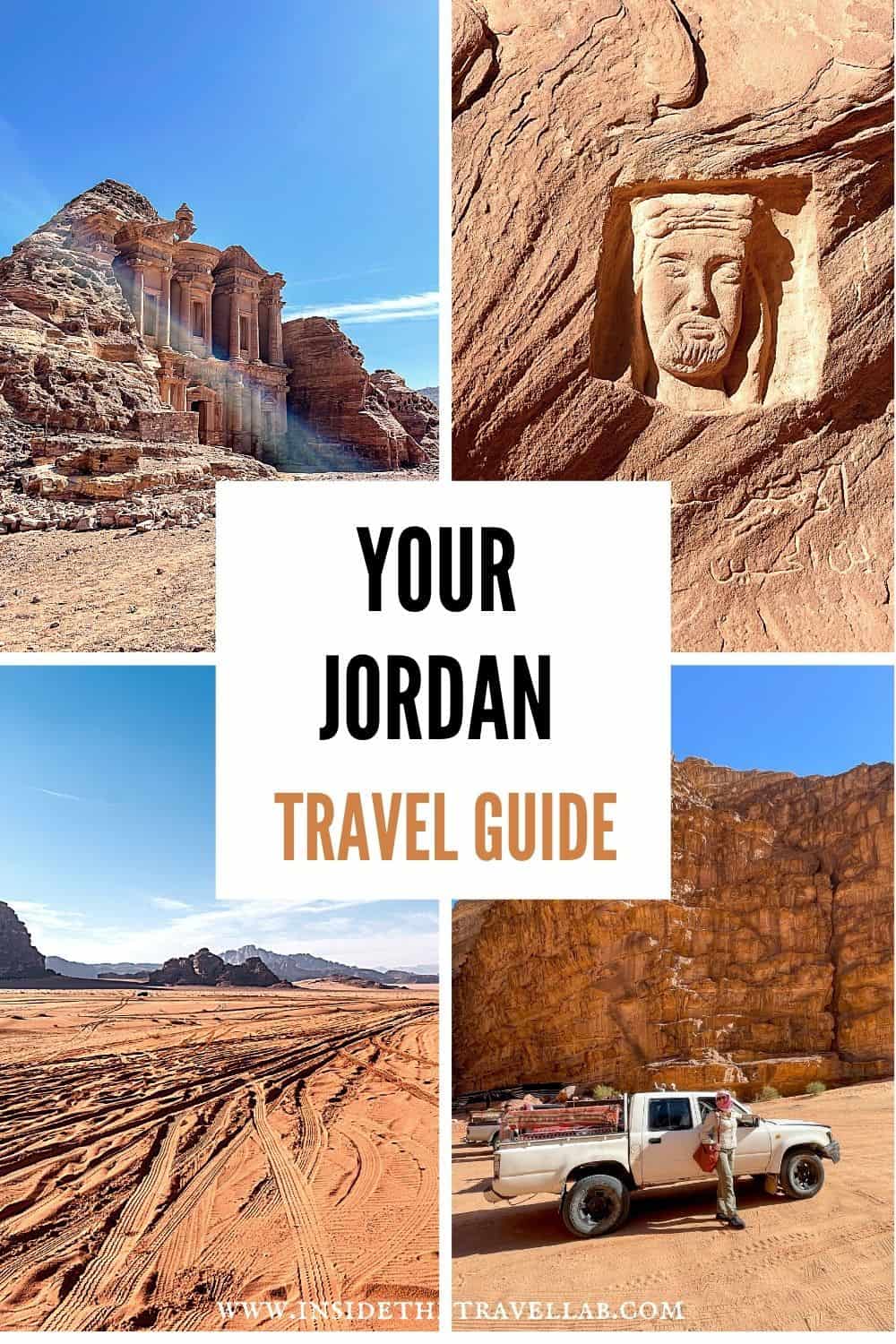
Your 7 day Jordan Itinerary
This Jordan itinerary is based on the Jordan Globus Escapes plan. I’ve mentioned some extras that you can add in along the way and at the end, I’ve offered some alternative 10, 8, 5 and 3 day Jordan itineraries.
Day One – Jordan Itinerary
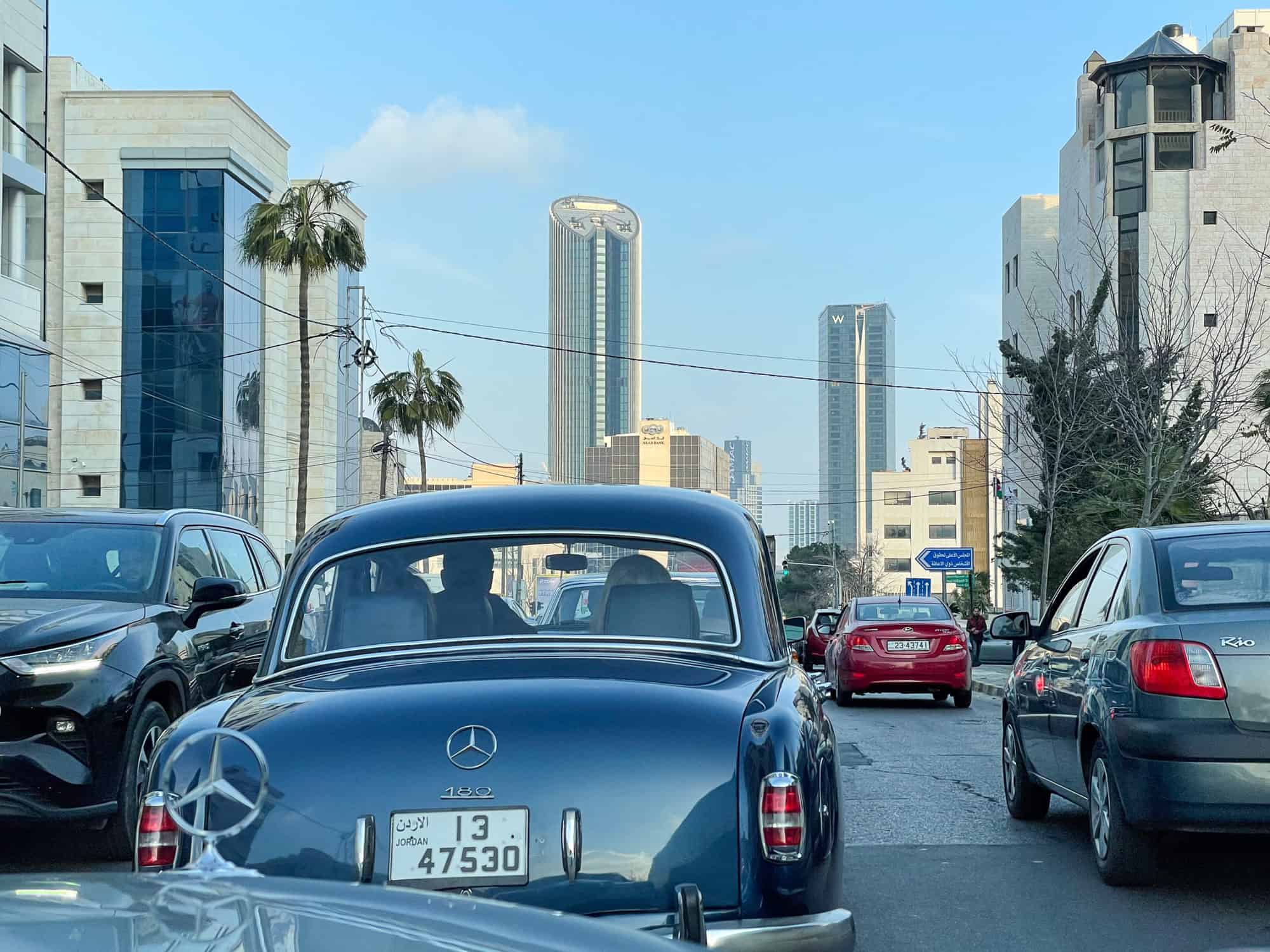
Arriving in Amman…
Arrival into Amman
Amman is a bewitching city, with its ochre-white walls and calls to prayer mixing with trendy coffee shops, design, art and innovation. It’s not the most beautiful capital in the world but it is one of oldest: the Ghazal figures at the Citadel museum mark the oldest representation of people in the world.
If you arrive early and have time to spare, then you can find an easy introduction into life in Jordan by wandering along the coffee shops and restaurants on internationally minded Rainbow Street. But if you’ve had a long flight, take it easy on yourself on day one. Rest and save your energy for later.
Where to sleep : The Kempinski Hotel Amman
- Try a daytime meal at the eco-conscious Wild Jordan and enjoy the view across to the Citadel.
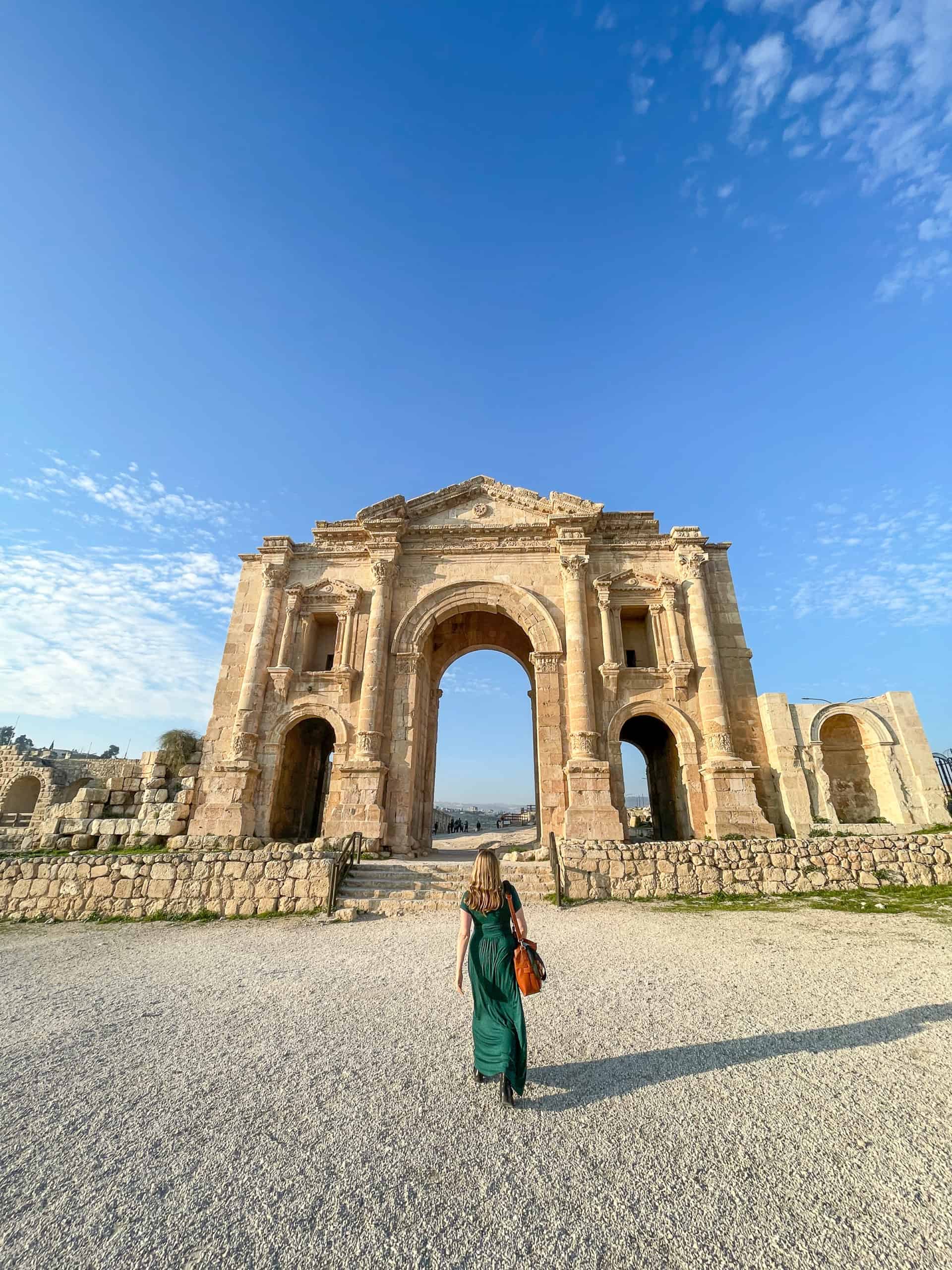
Day Two – Jordan Itinerary
Amman & jerash.
Now we’re getting started! Spend the morning travelling back to the past in Amman. ( See also more ideas for Amman here. )
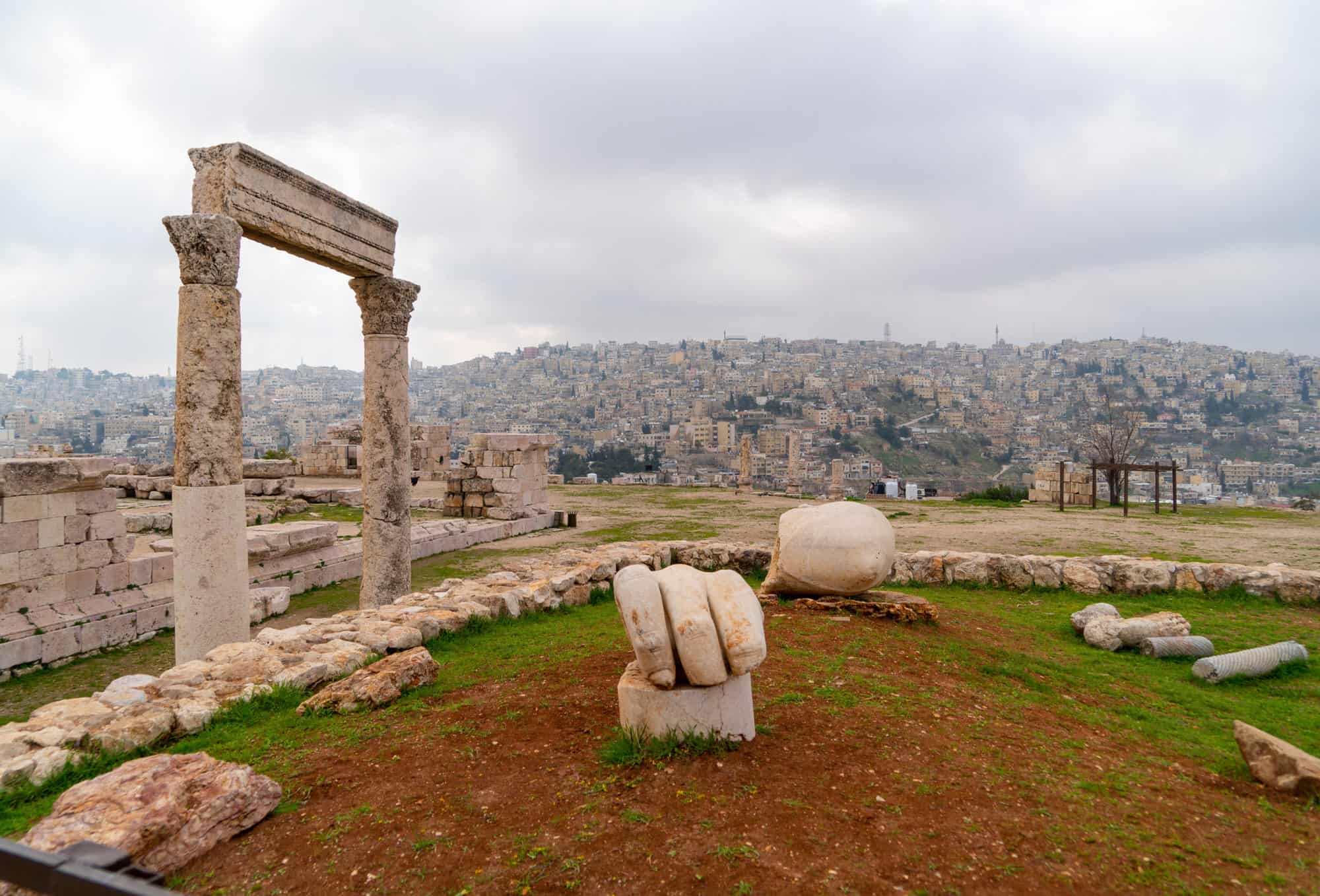
Remains of Hercules at the Amman Citadel
The Amman Citadel
If you want to feel young, head to the citadel. Perched on one of the seven hills or jabals in Amman, this dry and dusty place has seen civilisations come and go like waves on a shore. First was the Neolithic period, then the bronze age. The Ammonites, neo-Assyrians, neo-Babylonians, Ptolemies, and Seleucids roamed around and that’s all before the Romans arrived in around 100 BCE.
The temple of Hercules is the site’s most famous set of ruins, the hand elbow and, er, other body part lying unceremoniously in the rust red earth.
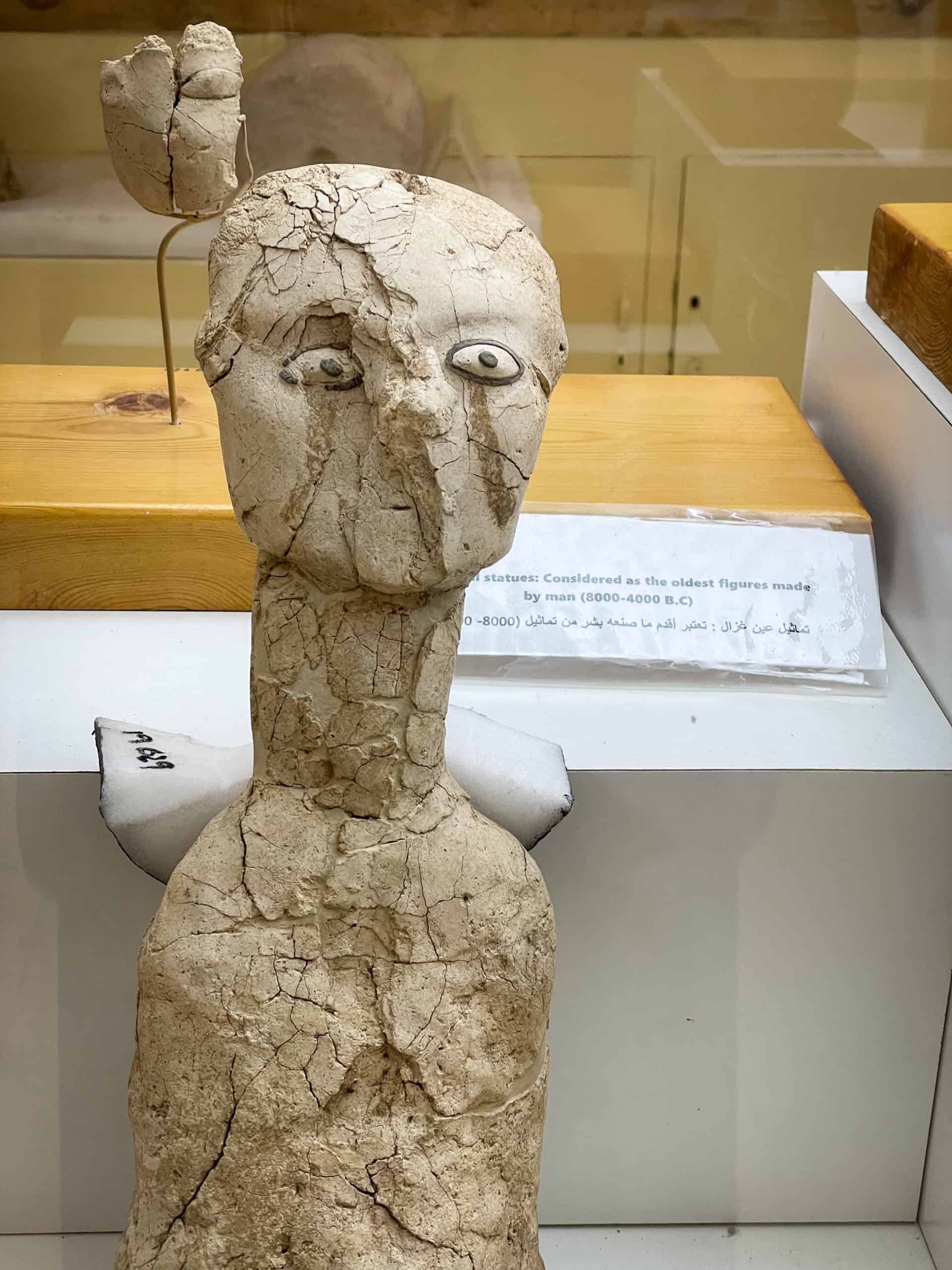
The unassuming museum houses artefacts from throughout time, including the Ghazal figures: mankind’s first artistic representation of himself (or herself, who knows?)
The Old Town
From the solitude and windswept stone of the citadel, head to the warmth and bustle of Amman’s Old Town. If you have your heart set on anything Aladdin-like then here’s your best shot. Piles of spices, hanging fruit, glittering gold in shop windows and fluttering fabric in the breeze.

- Top tip: try some crumbling, hot and sinful knafeh at Habibah Sweets in the Old town. It’s one of the best things to do in Amman! If I ever start a Jordan travel blog, this will be the very first food entry…
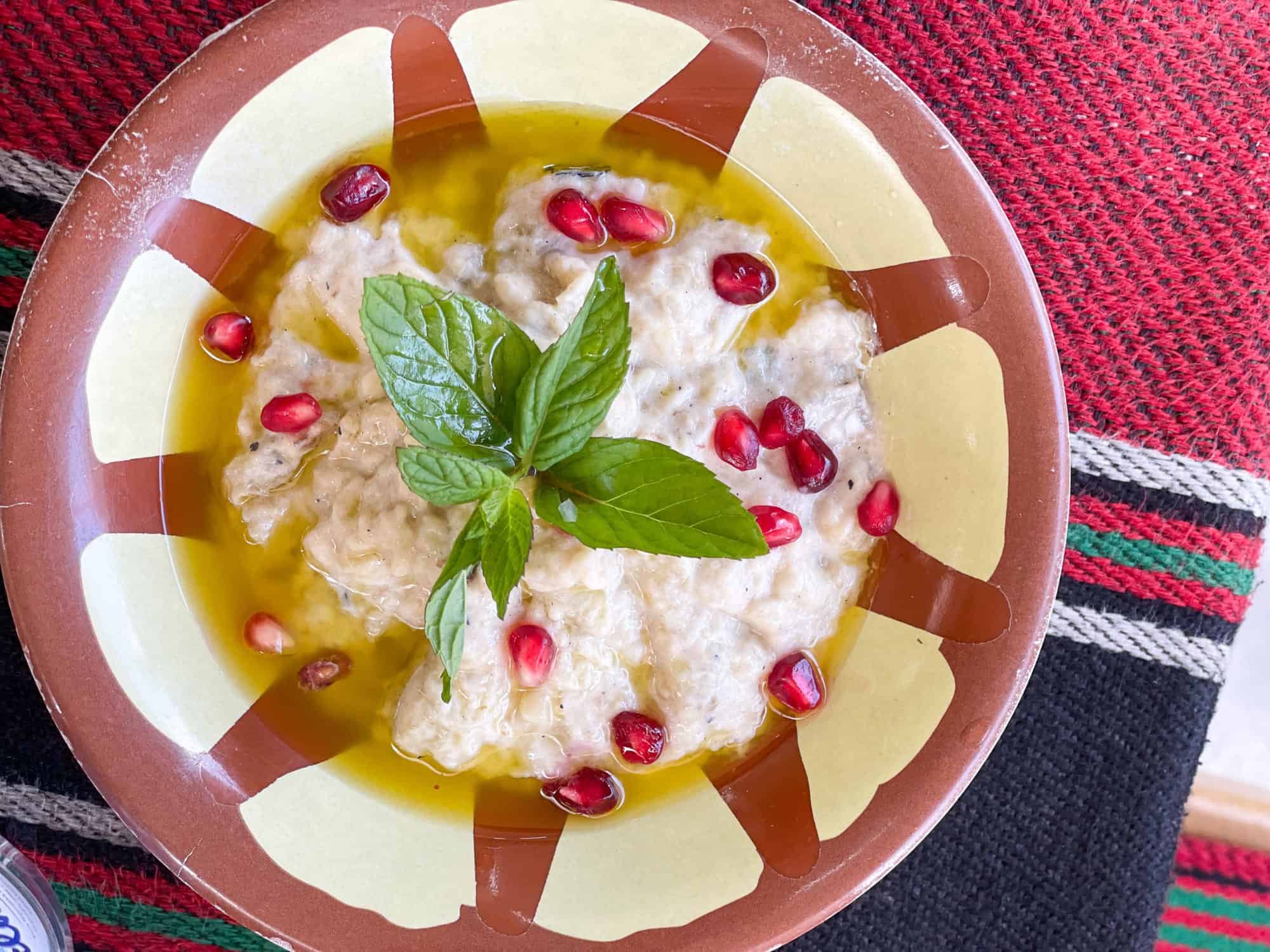
Lunch: Bait Khairat Souf
Now, the Globus Jordan Escape team organised this lunch: it’s not a straightforward place to reach independently. But I’m writing about it here because of three important reasons:
- It disproved my idea that group meals on tours tend to be bland and divorced from local traditions
- The story behind Bhait Khairat is one that deserves to be heard
- The food tasted good!
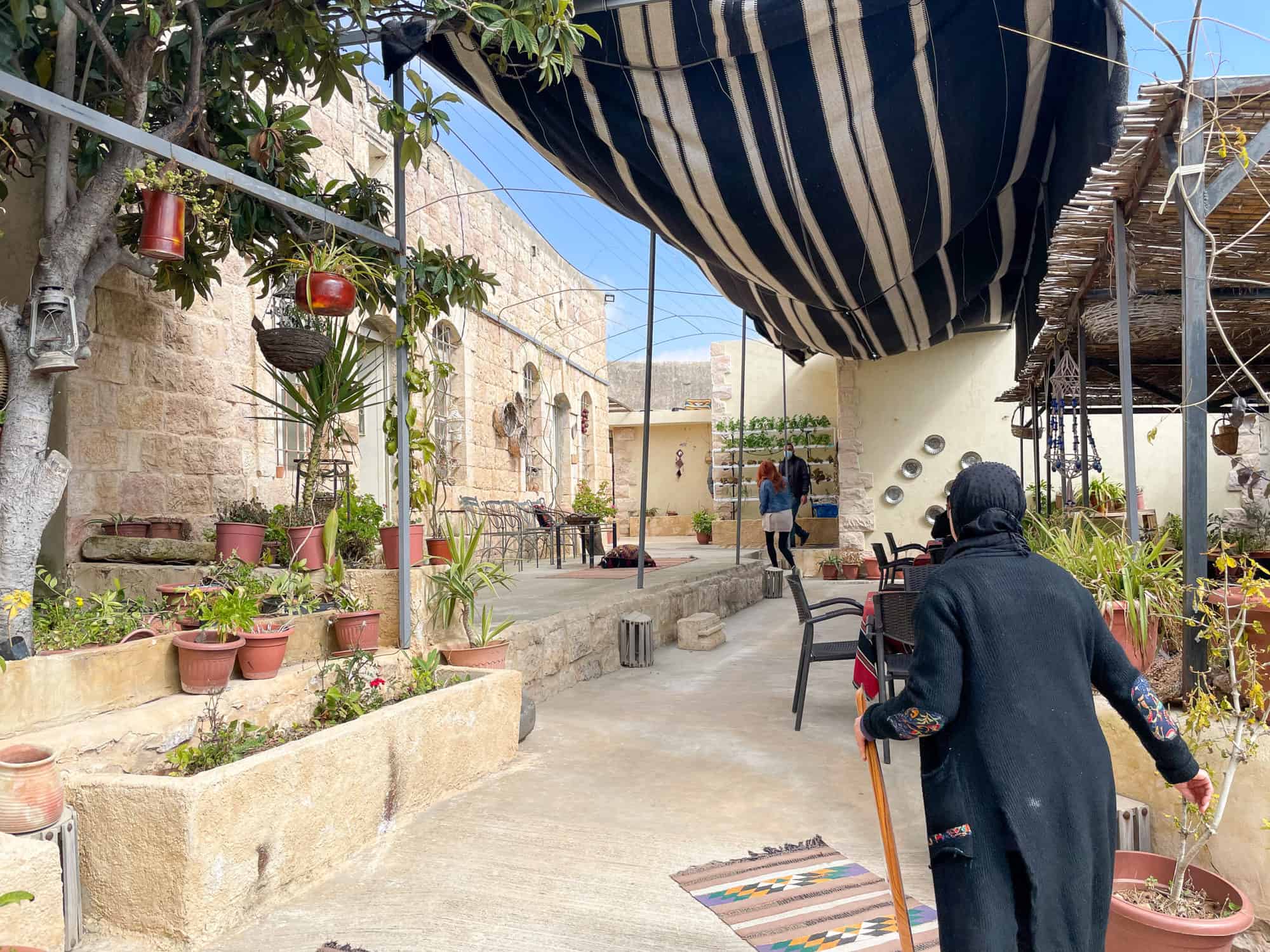
Set in beautiful gardens, with flowering petals, small fountains and a canopy of green, the Bait Khairat Souf is a women’s cooperative supported by the Queen Al Noor foundation. Food is largely home grown and definitely home cooked and it provides options for local women to develop skills, friendships and economic independence.
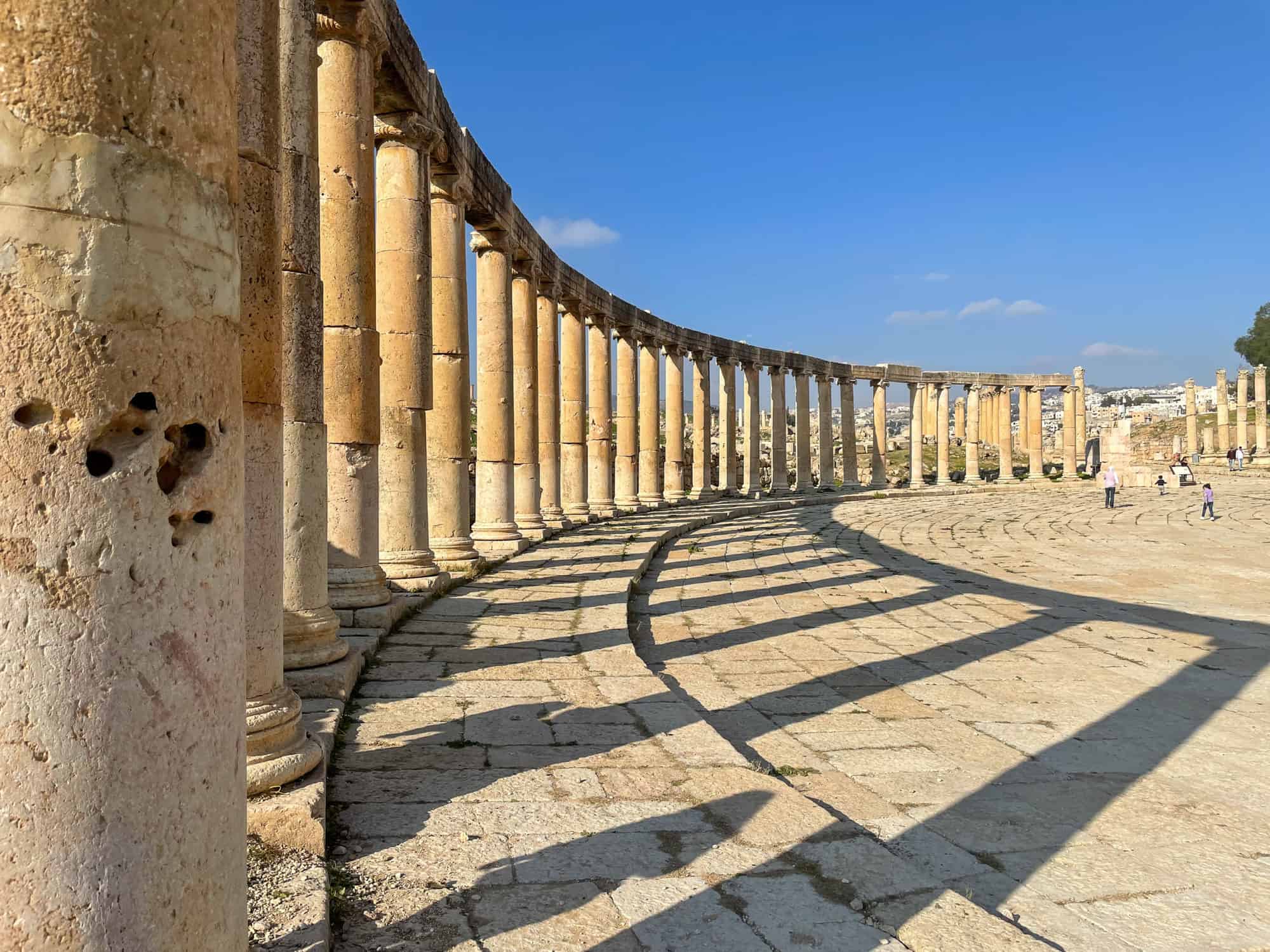
There are Roman ruins. And there are Roman ruins.
Forget the odd mosaic, baths or villa you might find lying around in the UK. Jerash is an entire city. Just 45 minutes from Amman, the columns and colonnades sprawl in a leisurely fashion from Hadrian’s Arch for mile after mile, making it one of the best preserved Greco-Roman ruins in the world.
And just to make you wonder if you’re losing a grip on reality, you’re also likely to catch a bagpipe show in the amphitheatre.
Yes, forget everything you ever knew. Bagpipes do actually originate from the Middle East, not Scotland.
How’s that for an impressive and little known fact?!
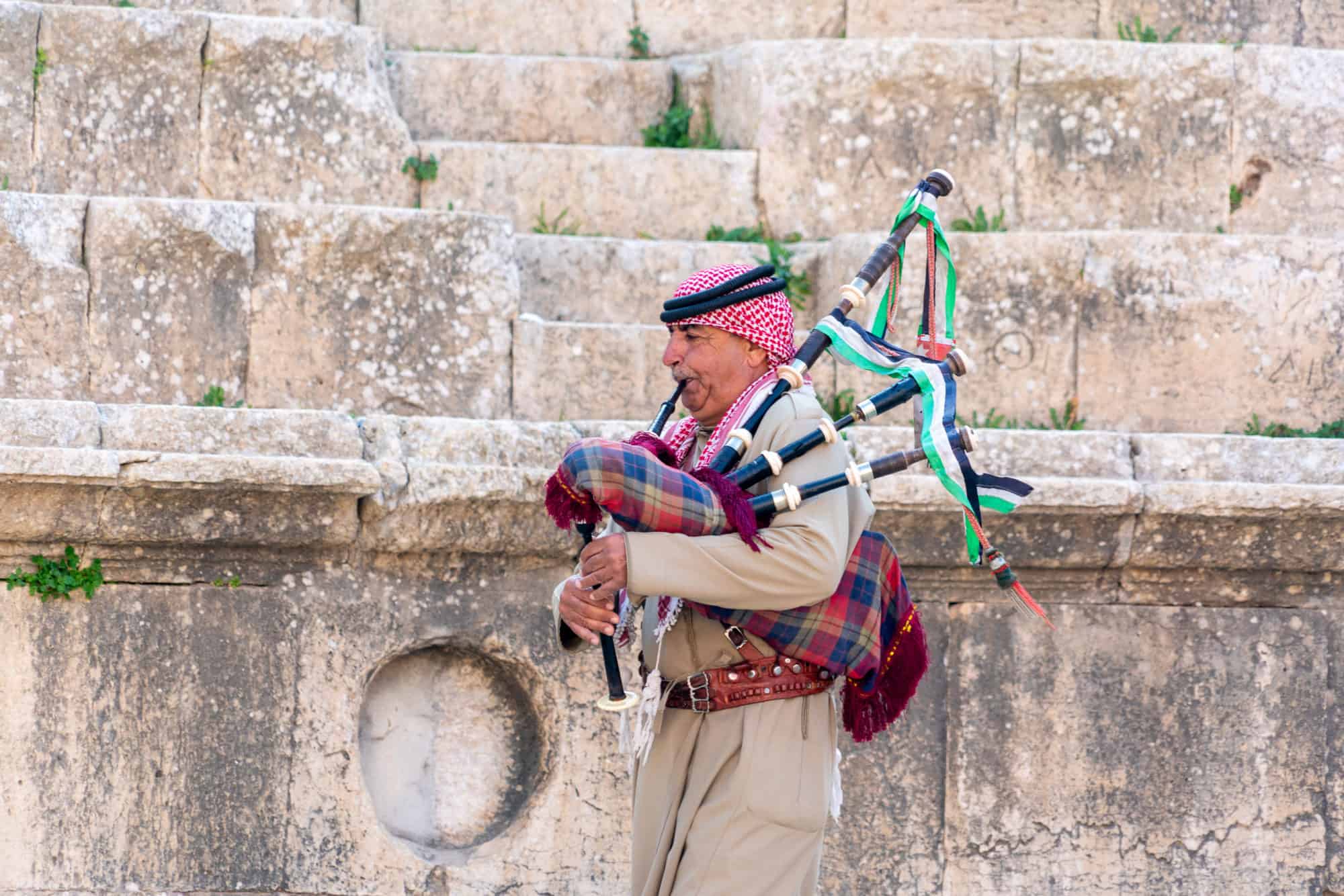
Bagpipes: not from Scotland after all…
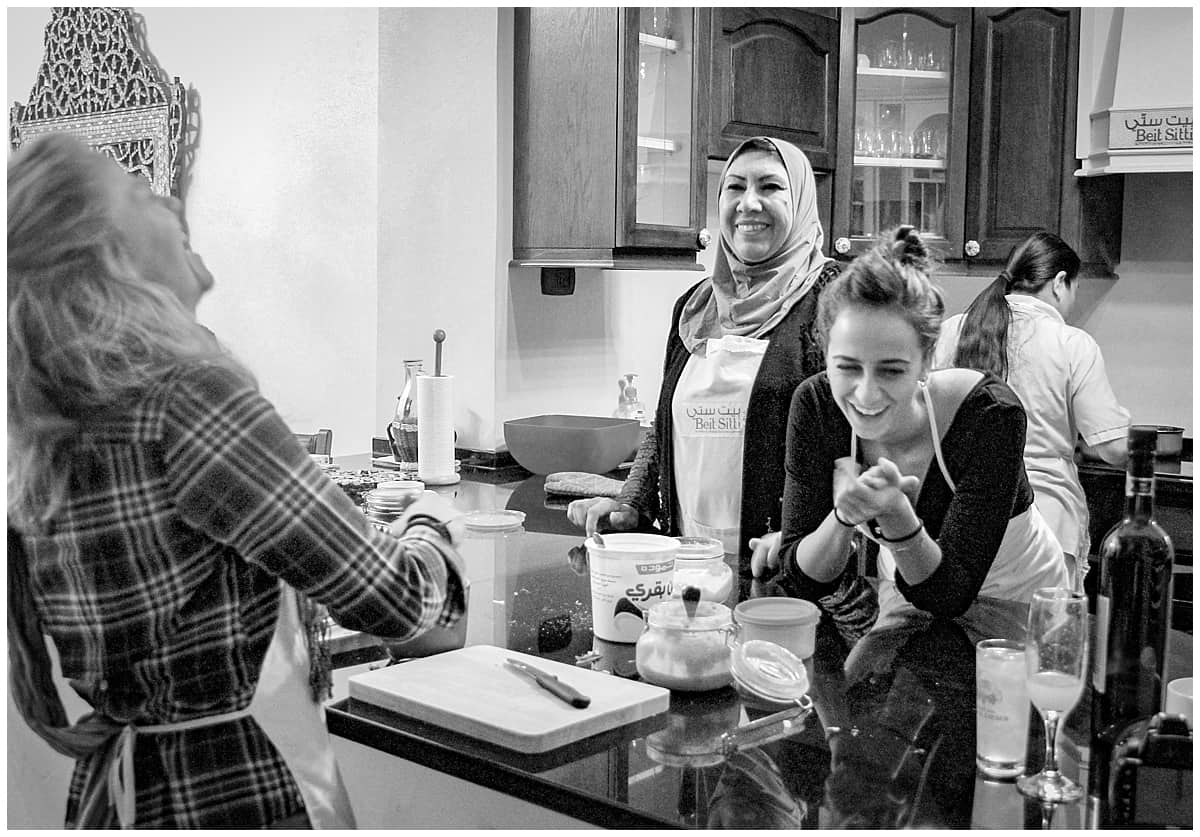
Nothing breaks through barriers faster than eating and drinking together
Learn to cook at Beit Sitti
Get to work for your evening dinner at the fabulous Beit Sitti cooking class, run in a home by the lovely Maria. I first met Maria ten years ago on one of my earliest assignments. Post Covid, I was thrilled to see that her business had survived and elated when she recognised me the moment I walked through the door. Read more about that story and her delicious Jordanian recipes here.
This experience isn’t part of the standard Globus tour (as all 30 people can’t fit in her house) but you can add it to your Jordan itinerary by heading directly to the Beit Sitti website.
Where to sleep: The Kempinski Hotel Amman
Day Three – Jordan Itinerary
Day three – wadi rum.
On the face of it, a visit to Wadi Rum doesn’t sound all that enticing. You go, you see the desert, you leave.
Once you go and you see the desert, I’d bet eighteen camels you don’t want to leave. Because it is absurdly beautiful. Richly stunning. Imagine untouched ski slopes rising and falling around you, except replace white snow with burned red sand. Picture the sky a lavender blue and the wheels of the jeep gliding over the landscape, a breath, a sigh of wind in your hair.
Imagine an undulating kaleidoscope of those blues and oranges and purples, rising and falling, shifting and drifting. Then stop for tea or cardamom coffee in a blood striped tent, the traditional way.
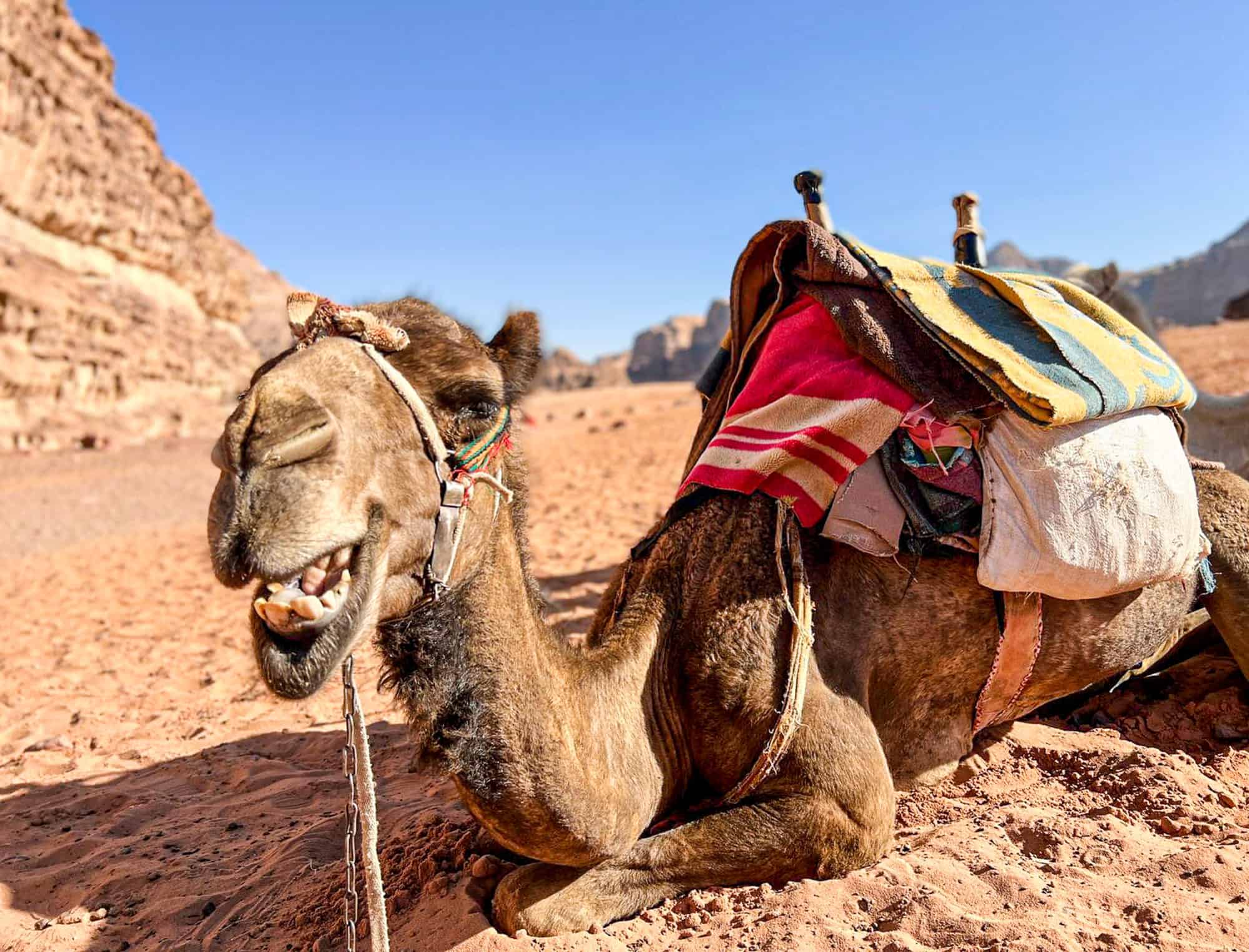
Yeah. I know what you’re thinking…
Ride camels in Wadi Rum
Of course, you could go all out for tradition and hike your backside up onto a cantankerous camel. Those images may look serene but I can assure you that the reality is anything but (or butt.)
Yes, dear readers, after years of riding camels across the desert sands in many countries, I can tell you that those days are over. The lurch and swing, the projectile snot, the abrasive hide.
But, you know. Try anything once etc.
Beyond the sand and the camels, you’ll also find yourself sifting through the complicated legacy of Lawrence of Arabia. Not just a Peter O’Toole movie, the real Lawrence (T.E Lawrence) did indeed exist, befriend the Bedouin and fight against the Turks. But the legacy beyond that is complicated, to say the least. Amid the conundrums, today’s Bedouin take you to see a somewhat questionable carving of his likeness in the rock.
- Inside tip: make sure your legs are covered if you plan on riding a camel. Just saying…
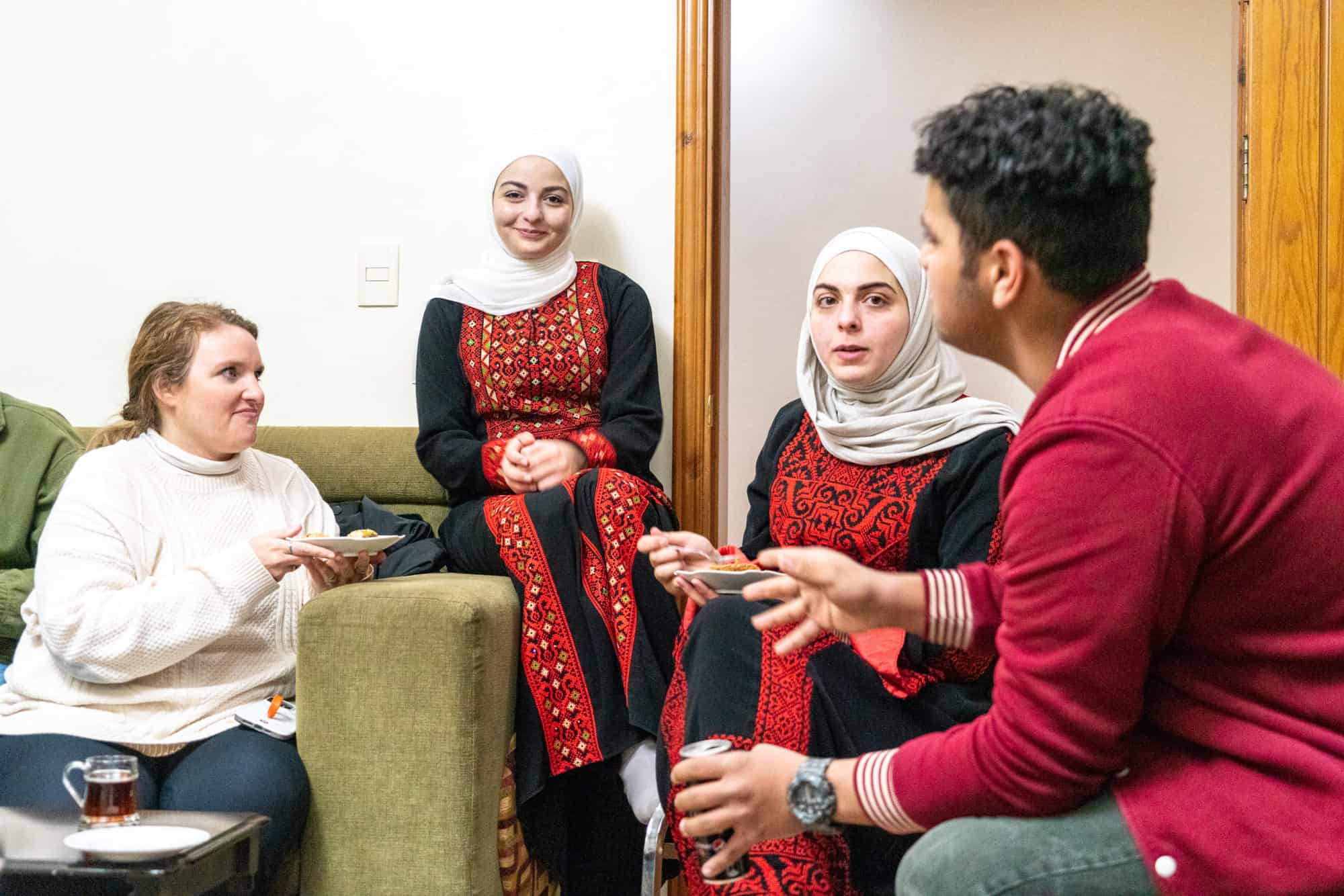
Dinner in a Bedouin home
Now, depending on who you ask, Bedouin are people who live a nomadic life in the desert. Or those who did until recently but who now have a permanent home but who have maintained the traditions of their communities and people.
And one of the most moving experiences of the trip was the invitation to dinner in Ameena’s home, with her children and their uncle, Sohaeb. More about that later!
Where to sleep: the Mövenpick Resort Petra right by the entrance to Petra
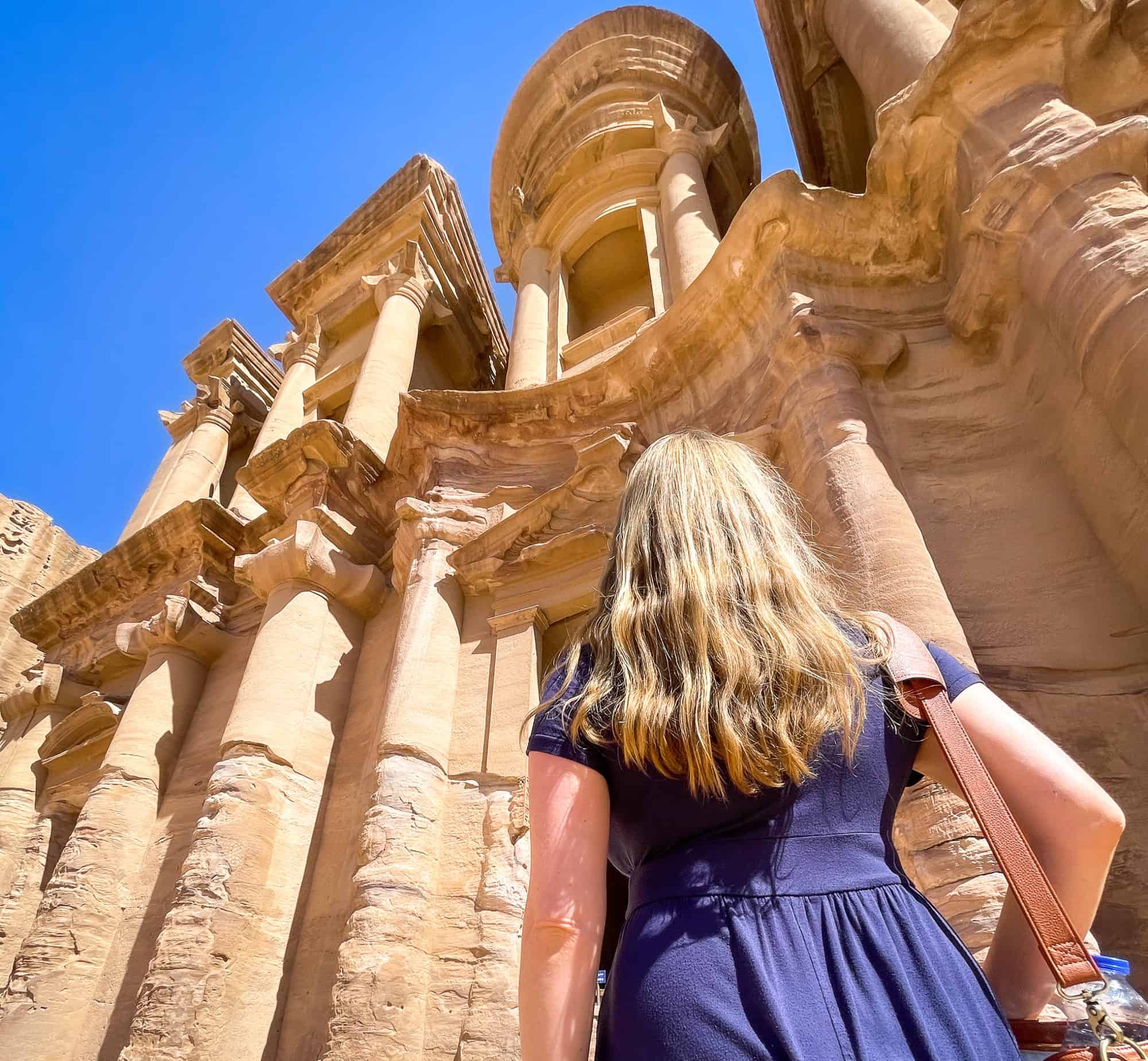
The Monastery in Petra
Day Four – Jordan Itinerary
Petra. This is the jewel in the crown, the sandwich in the picnic, the meat in the sandwich (sorry veggies.) Even before you know what it is, I’ll be you you’ve seen that image of Petra, the face of the Treasury peering between the raspberry ripple rocky gorge.
Petra is simply outstanding. No matter how many times you visit, you’ll always find something new. It’s like London, only prettier. If a man is tired of London, he is tired of life. If a woman is tired of Petra, she needs to have a word with herself. Basically.
However you plan your itinerary through Jordan, whether through Globus, another tour or through someone else, I would highly recommend this: make sure you rise and fall with Petra. That is, arrive the night before and give your aching, hardworking, unsuspecting muscles the chance to recover by staying the night after as well.
The site of Petra is huge. Vast. Enormous. Gigantic. In the words of my nursery age daughter, a million, billion years big.
Even if all you do is walk from the entrance to the Treasury and turn back, you will have walked four kilometres. And missed the point, to be honest.
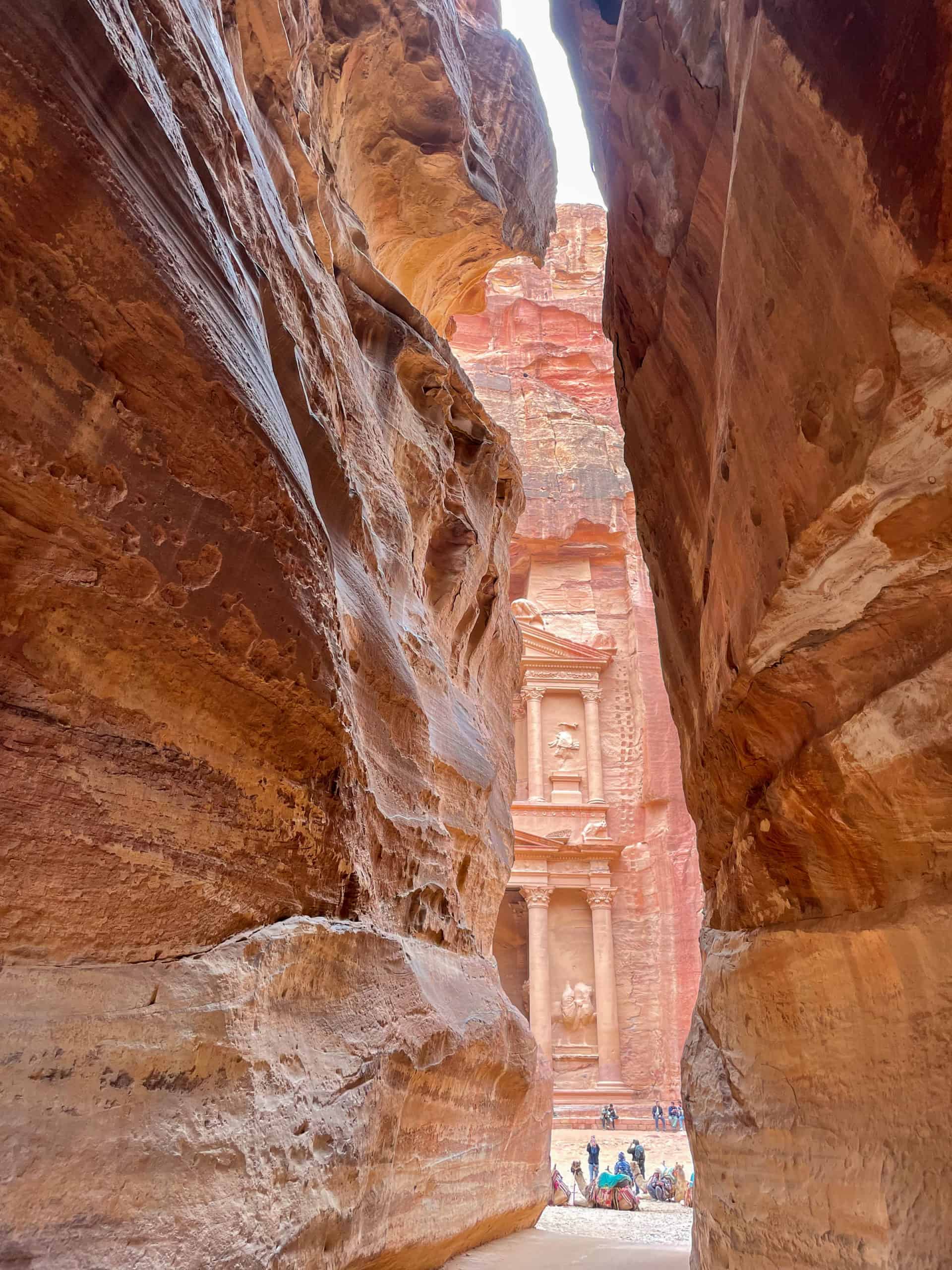
The famous approach to the Treasury
Understanding Petra
Petra is an ancient city, built by the Nabateans and extending over 102 square miles. It has columns and colonnades, an amphitheatre, tombs, marketplaces, mysteries and the awe-inspiring Monastery.
And it has been made more accessible over the years and over my visits. The rough stony approach to the Treasury is now a smooth concrete path. Golf buggies now buzz where horses used to roam. This is great for those with mobility issues.
For those without, it’s worth pulling on the hiking boots, slapping on the sunscreen and dosing up on your mojo to hike at least to the Monastery.
It’s hard to provide a sense of just how big the complex is. And it’s definitely worth visiting with a guide, to get a sense of who the Nabateans were.
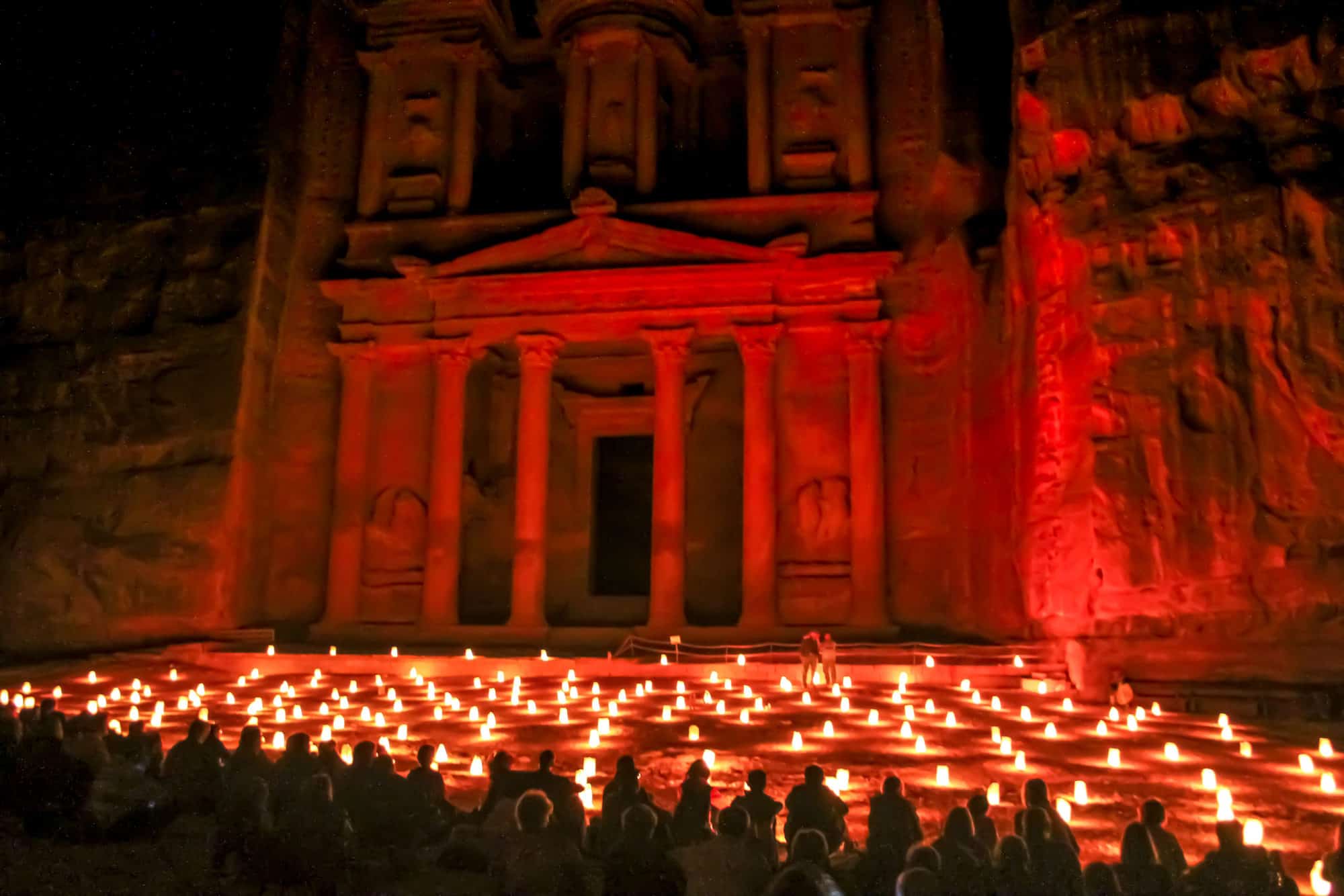
Petra by night: serenity by candlelight.
Petra by Night
An optional extra to Petra is the evening experience known as Petra by night. Personally, I think it’s utterly beautiful, a constellation of stargazing, candlelight and folk music in front of the majestic Treasury of Petra itself. But for those who expect a blaring, glaring light and sound show, you’ll be disappointed. Read more about my thoughts over here: is Petra at night worth it?
- Inside Tip – When it comes to visiting Petra, Globus Escape has the right idea. When I visited during the summer heat, my lasting memory is of collapsing into bed with black dots battling with stars in my head. And I was ten years younger. Simply put, Petra is best visited in the off season.
- Where to sleep: the Mövenpick Resort Petra right by the entrance to Petra
Day Five – Jordan Itinerary
kerak, wadi majib and the dead sea.
OK, OK. Today you can relax. After a hard day hiking through Petra, the fifth day of this Jordan itinerary sees you spend a recuperating amount of time on the road. (What some inspiration? Check out these fun road trip questions for grown ups. )
But in between watching camels slide by through the window and listening to your guide talk about the Hashemite Kingdom of Jordan, you will have a few key stops.
Kerak castle
Everyone who’s heard of Robin Hood, Prince John and Richard the Lionheart has heard of the Crusades, albeit vaguely. But of course, these weren’t the background scene of a Nottingham legend but a real series of conflicts held around the Holy Land in the Middle Ages.
Kerak Castle helps to put some context into the period, through its dungeons, windswept battlements, stables and broad views of the cream and russet countryside. It’s one of the largest and best preserved castles from the Crusader Period. Built in 1140, it changed hands several times in very many bloody, messy ways. Today, though, it’s a peaceful spot and the restaurant just outside serves beautiful refreshing mint and lemon drinks.
Wadi Majib (or Wadi Mujib) is a deep canyon cuts through rust red rock with a sense of passion and drama. It’s also a hotspot for adventure sports and canyoning (you can have a good laugh at a retro video of a younger me canyoning in Wadi Majib right here.)
On the Globus Jordan itinerary, though, you don’t have to splash yourself through that. You drive down, across, and up the gorge, stopping for photo spots but nothing more arduous.
Then it’s on to the lowest point on earth: the Dead Sea.
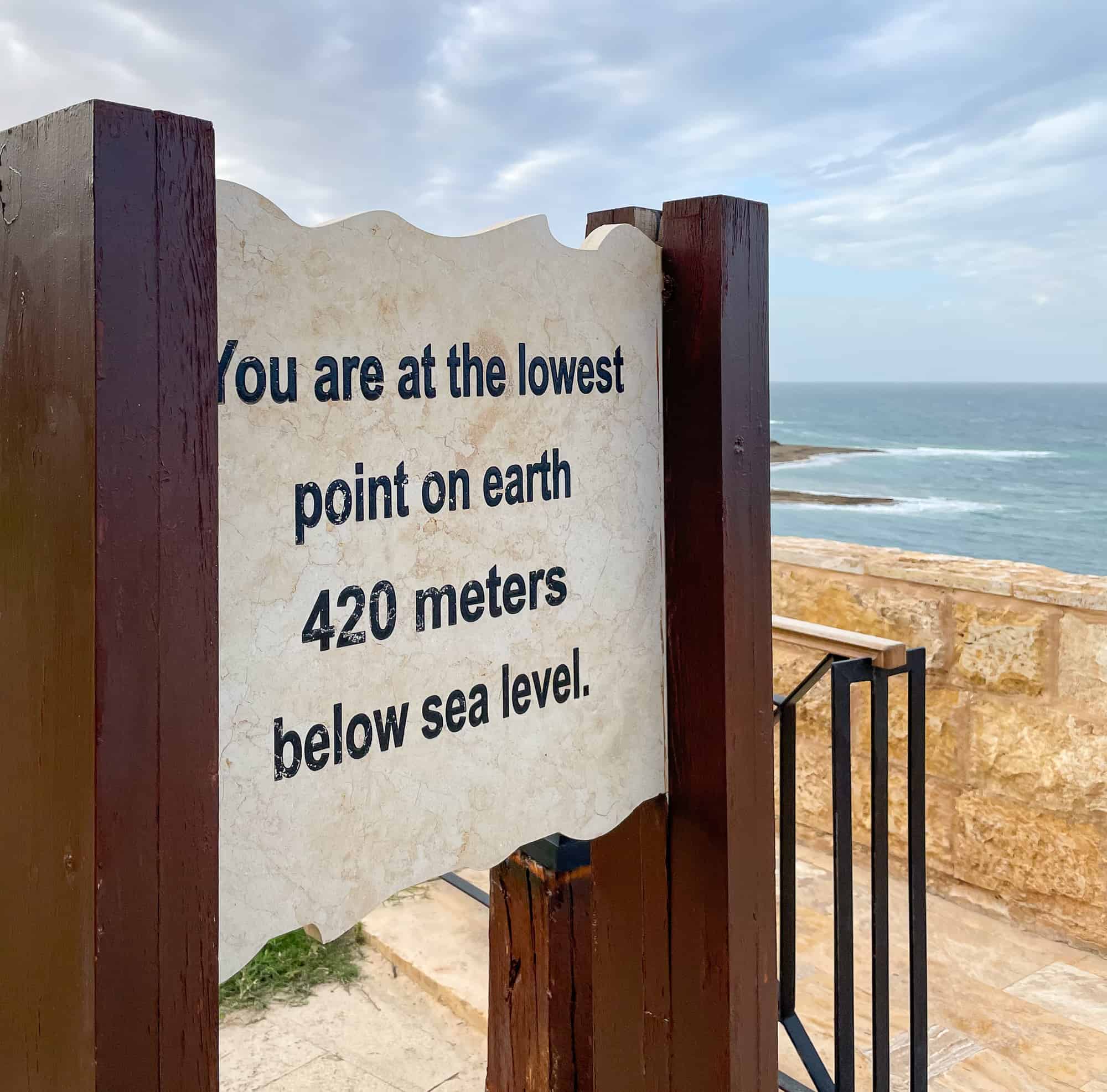
The Dead Sea
Glistening between Jordan and Israel, the Dead Sea sits at 427 metres below sea level and, well, is a lake rather than a sea. Despite the off-putting name (it’s the fish who can’t survive, not the people,) it’s become a popular place for spa resorts. Each weekend, Jordanians leave the capital of Amman and head to the Dead Sea, slathering themselves in mud for a youthful complexion and watching a bellydancer for, well, reasons unknown.
Three times, now, I’ve been lucky enough to visit the Dead Sea and each time has been a blast. There’s something faintly ridiculous, no boldly ridiculous, about covering yourself in mud and bobbing about like a drunken penguin. The high salinity means you can’t sink but you sure as anything can’t swim either.
Bluntly put, the Dead Sea is a wonder of the world and an absolute must on any Jordan itinerary.
- Where to sleep: the Mövenpick Dead Sea Resort and Spa
- Tip: don’t shave before getting into the Dead Sea. It will sting like crazy! Find out why and uncover some other interesting facts about the Dead Sea over here.
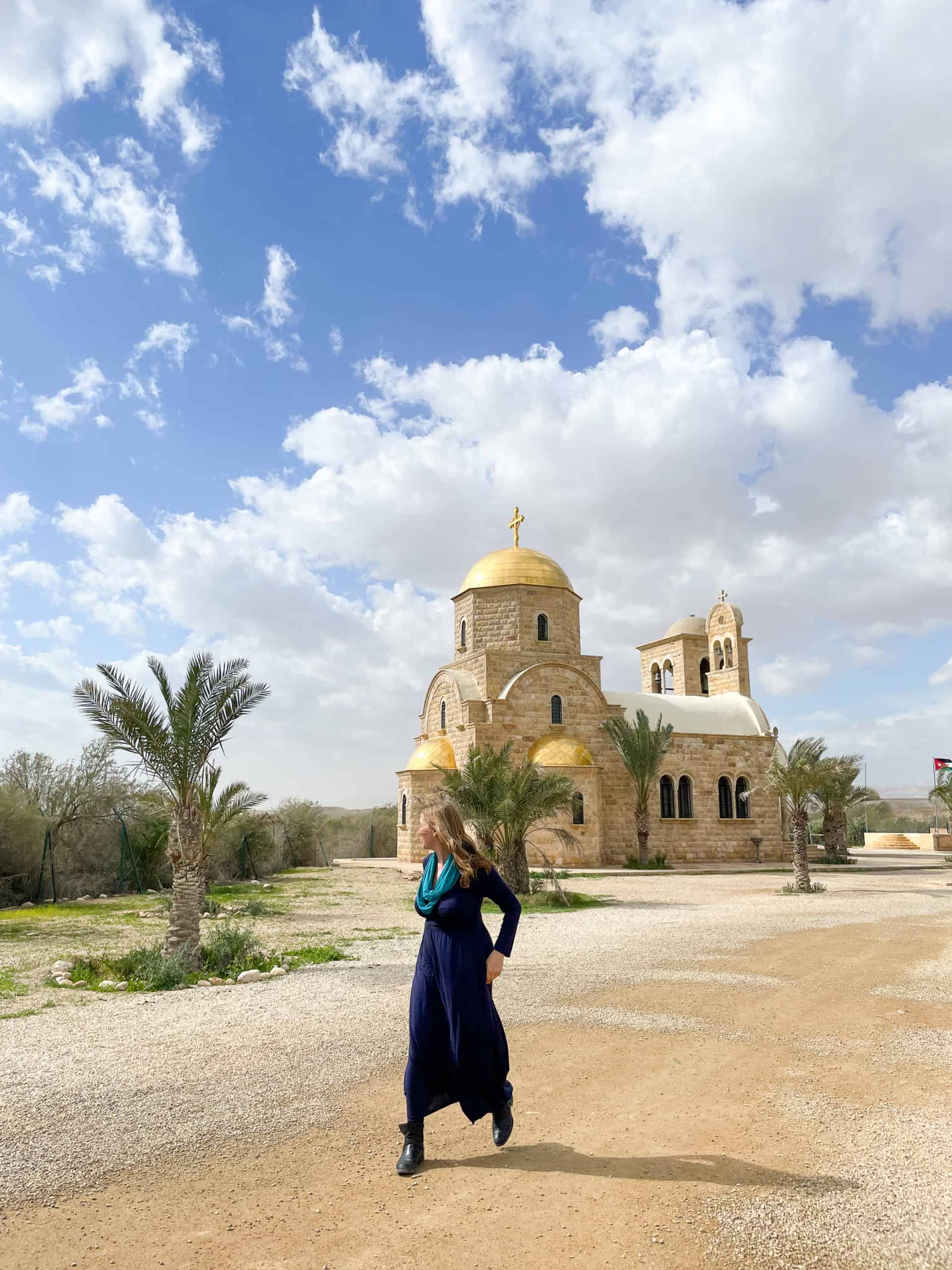
It’s a busy day – you need to move fast!
Day Six – Jordan Itinerary
Mt nebo, madaba, bethany beyond the jordan.
Today is a busy day. One which spans thousands of years, scales a mountain, views the promised land and, well, puts your feet on the earth where world-changing events took place.
Wherever you sit on the religious spectrum, there’s absolutely no denying that the events that took place here had monumental, far reaching consequences for the world at large. Consequences that continue to this day.
Because in just a few square miles, you can stand on the spot where Jesus was baptised and also on the mountain where Moses saw the promised land of Israel.
If you believe, the significance is obvious. If you don’t, it’s perhaps more powerful to stand and wonder why these places, why these stories achieved the global fame and far reaching consequences that they did.
And in either case, to visit is to witness a striking contrast to what you see on the news: soldiers chatting in the sunshine on the West Bank. And Muslims and Jews paying to protect sites that matter to Christians.
But enough chatting. Let’s talk about what you can see.
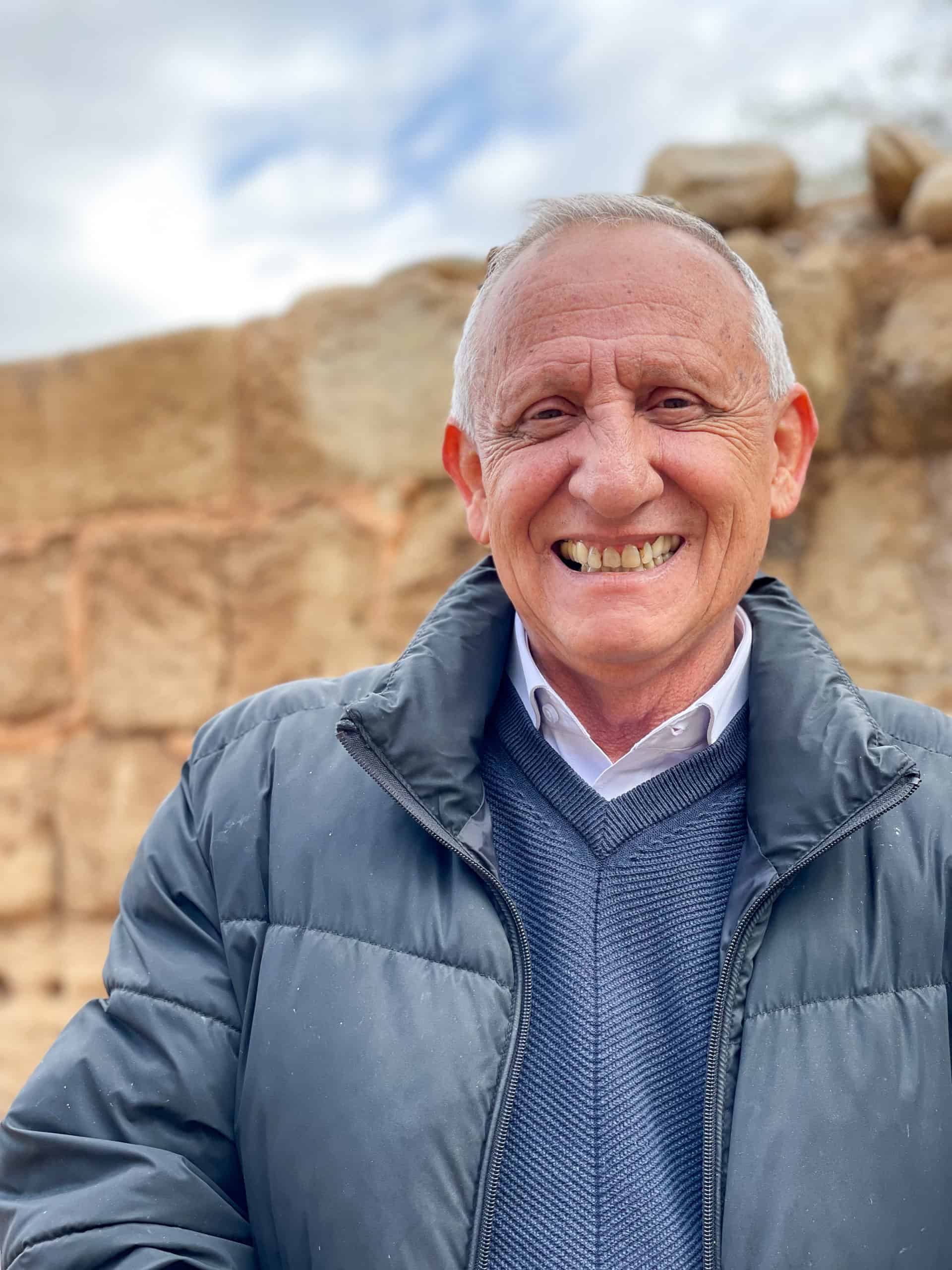
His Excellency Rustom Mkhjian, Director of the Baptism Site
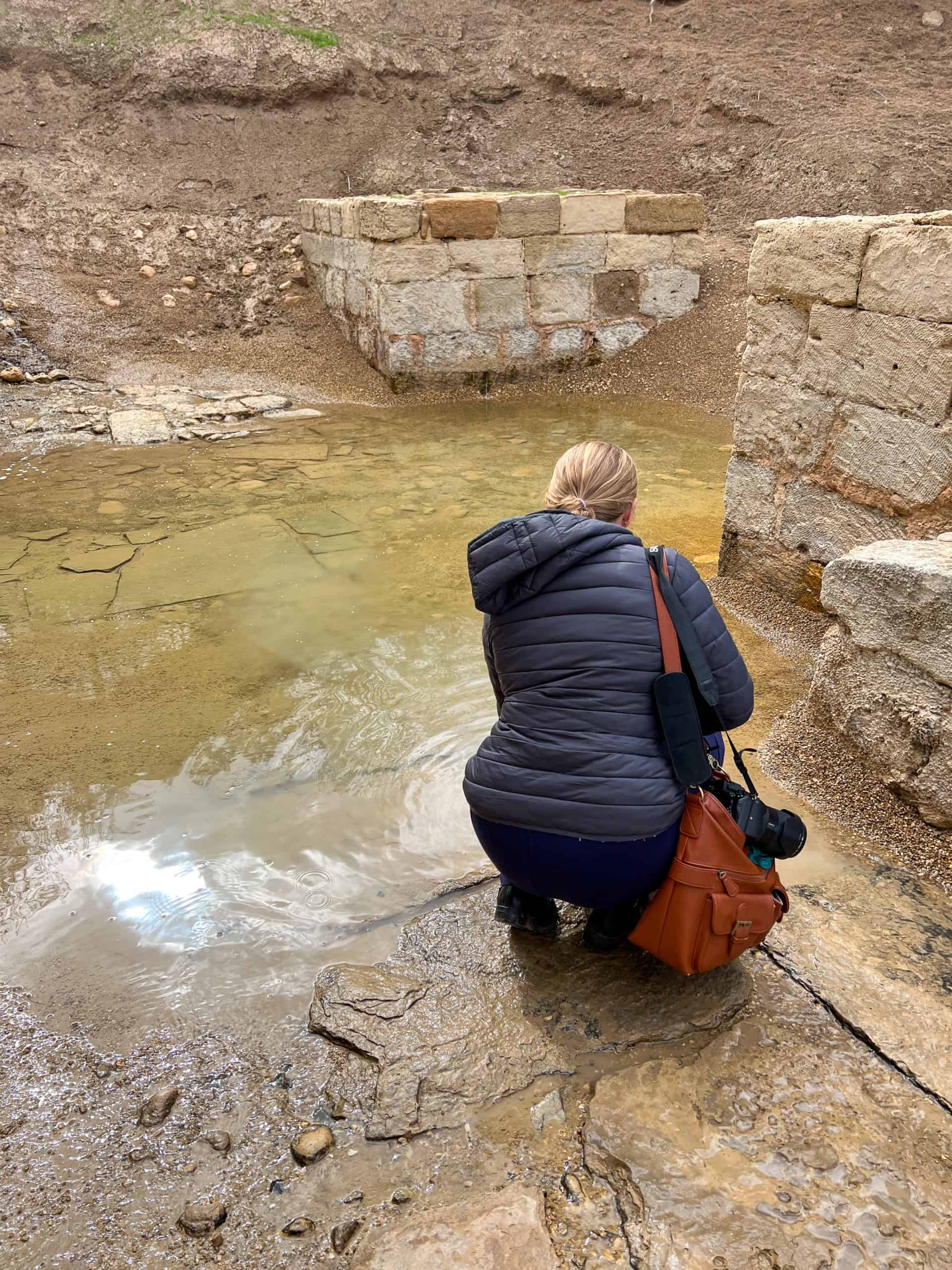
Powerful thoughts…
Bethany Beyond the Jordan
We arrived in Bethany Beyond the Jordan in an appropriately biblical downpour of rain. Greeted by the Director of the Baptism Site Commission , His Excellency Rustom Mkhjian, we walked through the archaeological ruins and remains that suggest that this area was the place of ministry for John the Baptist.
Then you move to the baptism site itself. The place where historians tend to agree was the original baptism site of Jesus, and the pivotal moment where He began His teachings.
A tiny stream trickles through a cross-shaped grave of mud and the noise sounds livelier and more energetic than it looks. In the Bible, Jesus is baptised in the River Jordan, which is not, of course, this. But experts agree that the river has changed course over the last two thousand years or so and other archaeological remains almost unanimously suggest that this is the place.
But not entirely unanimously. Just a little way further along, you can visit the Jordan River, which separates Jordan from the West Bank. Various irrigation systems upstream have siphoned off the water, so what sounded like the Hudson or Thames in biblical times is now around the size of a country road.
Still, people attend on both sides for baptism and a beautiful church, resplendent in the breaks of sunshine between the clouds, also celebrates the site.
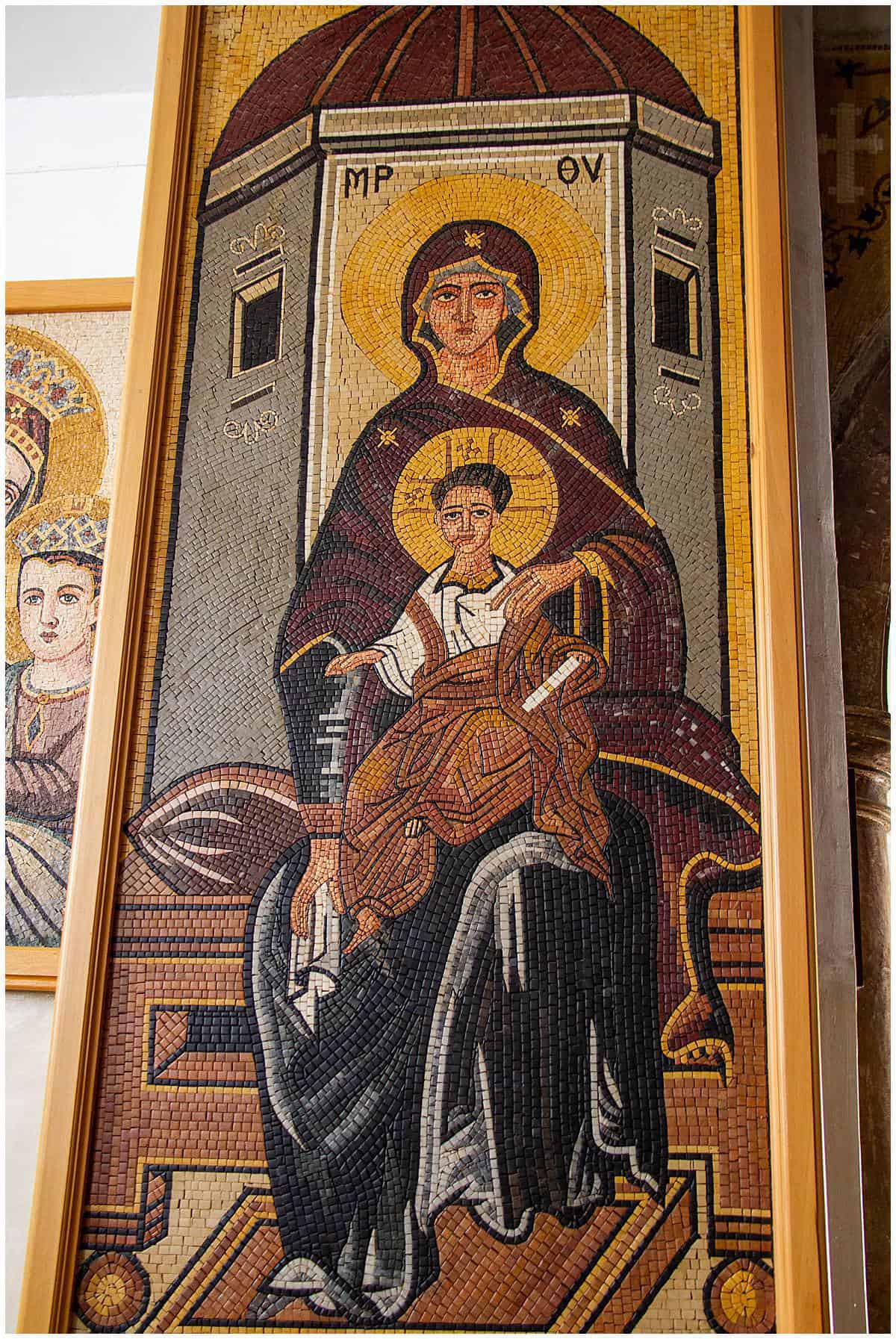
Madaba: famous for mosaics but there’s more to the story than that
Just along the road in Madaba, the word on the street is mosaics. In fact, the mosaics were the streets in Roman times which, of course, were also the times when Jesus and John the Baptist were roaming around.
The most famous mosaic in Madaba is the 6th century depiction of the Holy Land in the Greek Orthodox Church of St George. It’s worth visiting, not only for the mosaic, but also to witness the practice of Christianity in a Muslim country.
Just along the road is the Church of the Virgin Mary, which I missed on my first visit to Madaba (thanks again Globus for the heads up!)
Inside, you’ll find mosaic after mosaic after mosaic, well, you get the picture.
But it’s worth seeing them. See why the mosaics of Madaba matter more than you think here.
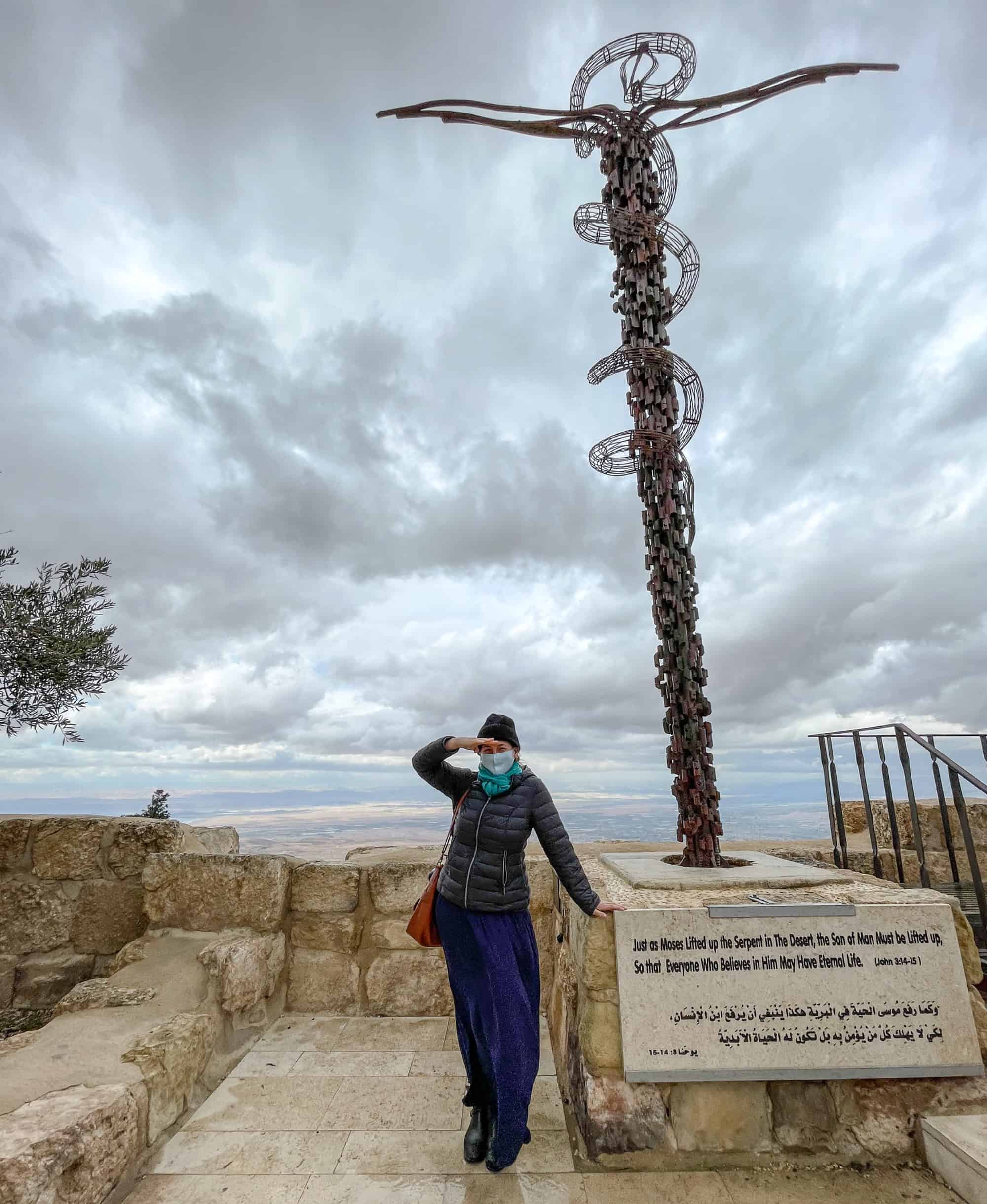
It gets cold and windy up here!
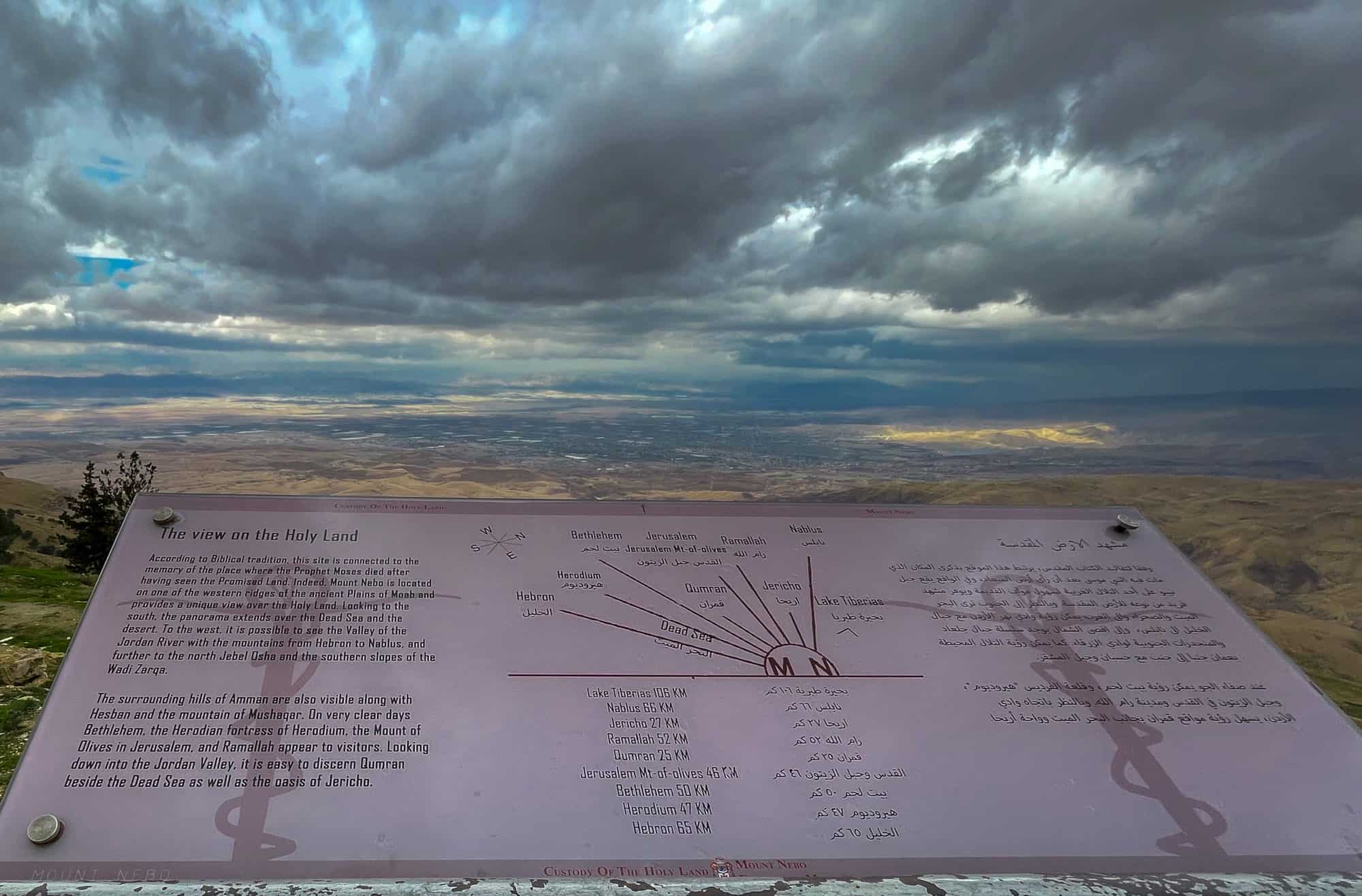
Sunlight marks the Promised Land…
From the peak of Mt Nebo, God showed Moses the Promised Land of Canaan. And standing on that peak, even amid the wind and rain, the whole idea makes sense. For while we stood battered and smattered by the elements, a golden expanse of sunshine seemed to breathe with ease over the land of today’s Israel.
Beyond the viewpoint, you’ll find a memorial, a small museum and a covered selection of more mosaics. They are all interesting in their own right but it’s the view from the mountain itself that makes this a world class visit.
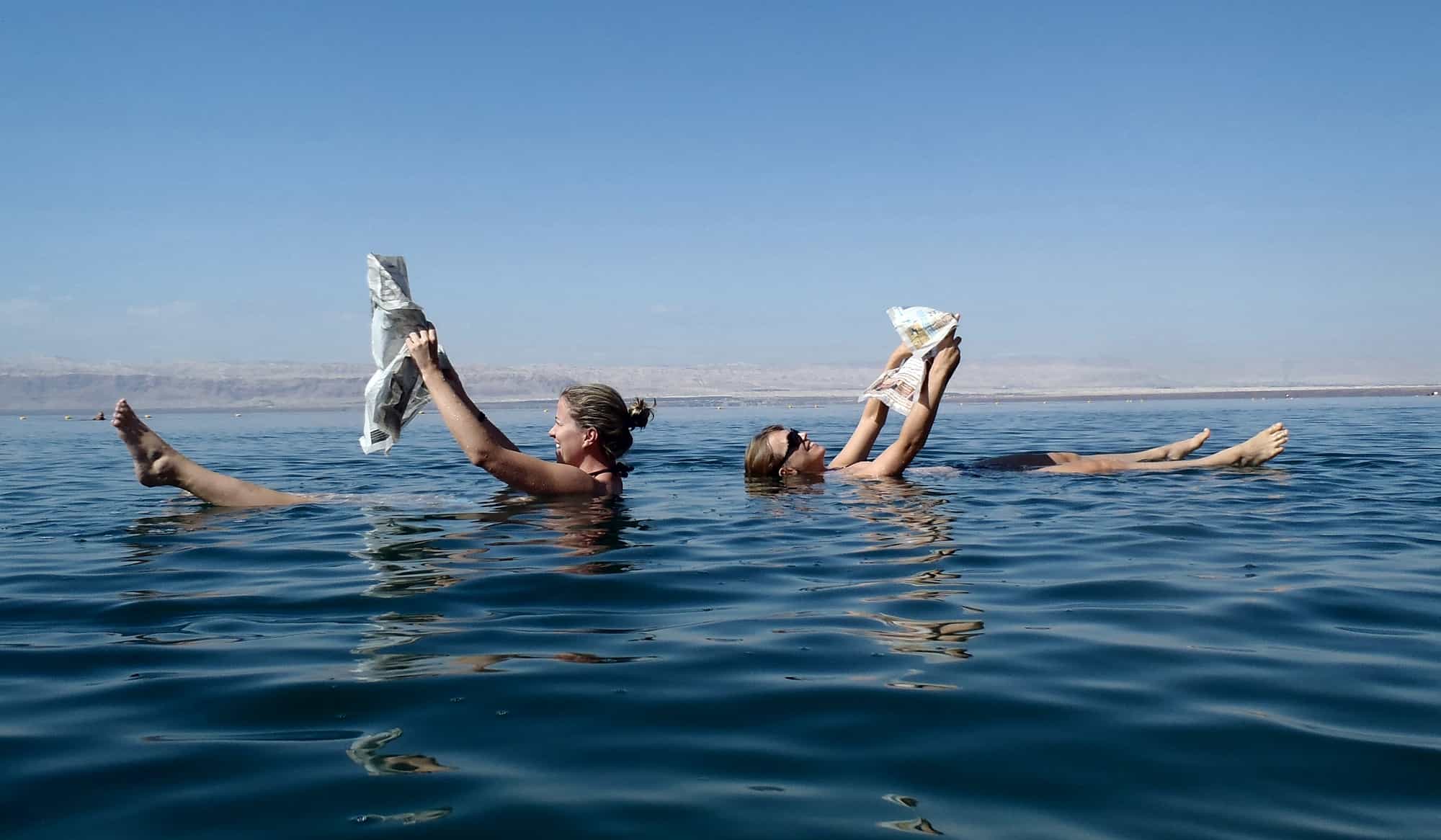
The Dead Sea (again)
In the Globus Jordan itinerary, you head back to the Dead Sea spa for the night because, why not?! It’s fun!
Alternatives would involve travelling back to Amman to cram in a few more city sights before you fly.
- Inside tip: leave all your preconceptions behind. Respect and reverence and an open mind make for getting the best and the most out of this day.
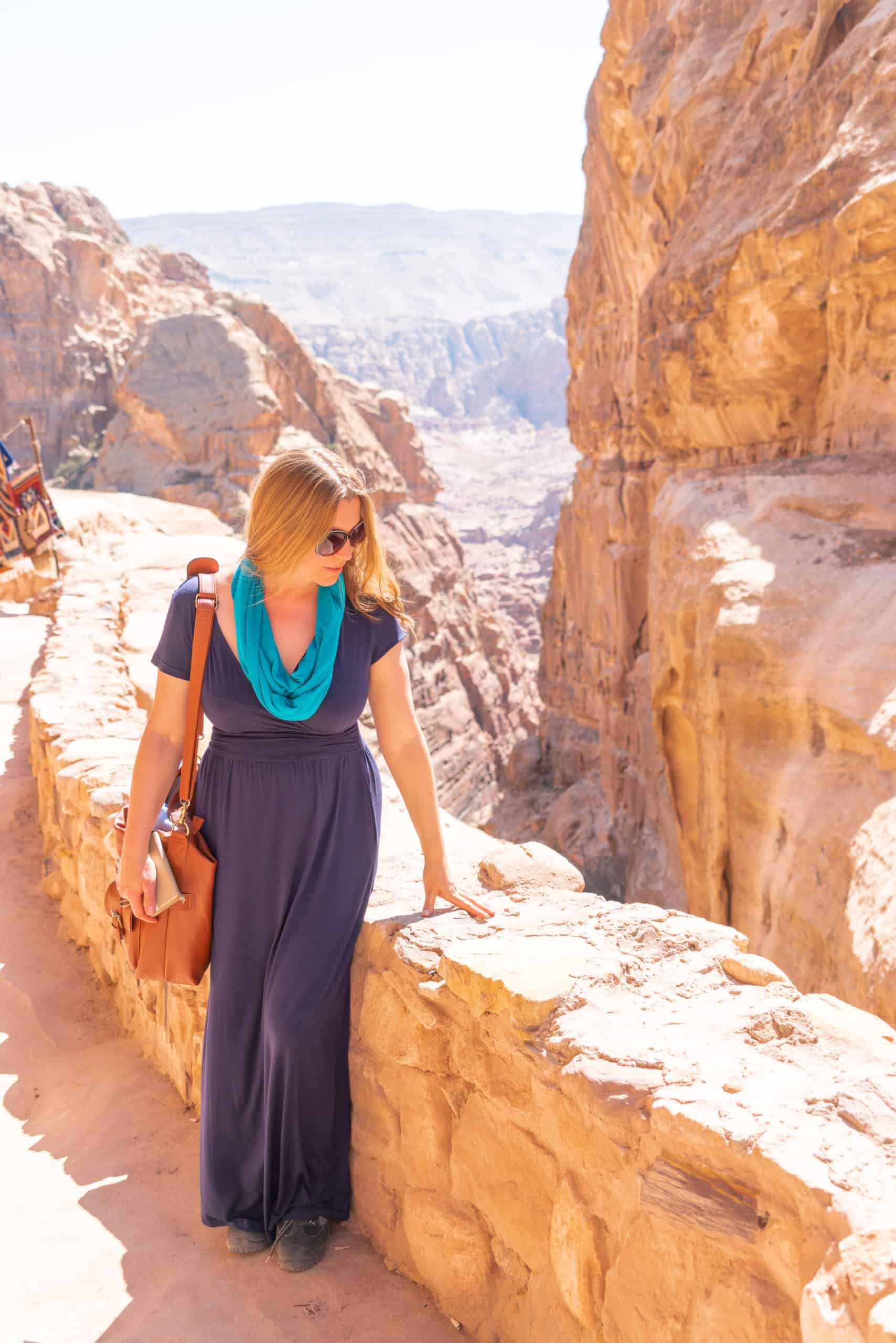
Sad to say goodbye…
Day Seven – Jordan Itinerary
Leave from amman.
Depending on your flight time, you can either spend the day lazing by the side of the Dead Sea… or get up at the crack of dawn to hot foot it to the airport.
That’s it! Your seven day Jordan itinerary has come to an end. Want more time? Check out the other Jordan itinerary suggestions below…
10 day Jordan Itinerary
With 10 days in Jordan, you can expand some of the stops on the 7 day Jordan itinerary but follow the same basic loop of the plan. Spend a night in Wadi Rum, two in Petra and in the warmer months, head further south to Aqaba.
- Explore Wadi Rum – stay overnight
- Hike through Petra and Little Petra – 2 nights in Petra
- Head to Aqaba
- Return via Kerak Castle and the Dead Sea
8 day Jordan Itinerary
For an 8 day Jordan itinerary, follow the outline above but spend one night in Wadi Rum or at the Dana Biosphere Reserve mid trip.
- Explore Wadi Rum
- Stay in the Dana Biosphere Reserve
5 day Jordan Itinerary
With 5 days in Jordan, time is tight! I’d suggest cutting the Kerak Castle day and combine Petra and Wadi Rum into one day. It will be a squish but you can just about pull it off.
- Explore Wadi Rum & Petra
- See the Dead Sea, Mt Nebo, the Madaba Mosaics and Bethany Beyond the Jordan
3 day Jordan Itinerary
With only three days in Jordan, instead of a week in Jordan, then something has to go. Head straight from Amman to Petra, then to Wadi Rum and the Dead Sea and then back to Amman to fly home.
- Arrive Amman and head straight to Petra
- See Petra and Wadi Rum
- Back to Amman via the Dead Sea
More options to add to your Jordan itinerary
With more time, you can see more! Here are more details about the activities mentioned above.
Stay overnight in Wadi Rum: Hot air balloon ride in the morning
Once you’ve seen Wadi Rum, you’ll want to stay. At night you can see the stars in a perfectly dark sky. And early in the morning, you can head into the air in a wicker basket, powered simply by raw fire. You can watch my hot air balloon ride in Wadi Rum on YouTube here.
Hit the coast in Aqaba in the south
Jordan may have a small sliver of a coastline but it likes to make the most of it. Aqaba in the south borders the Red Sea, with plenty of rainbow fish to keep snorkellers and divers happy. It’s also a good spot for windsurfing. Bear in mind that winters are cool, however, so plan to visit Aqaba during the warmer months.
Go stargazing in the Dana Nature Reserve
Hidden in the Dana Biosphere Reserve is one of the most forward-thinking eco lodges in the world. Built on an abandoned archaeological site, you can stargaze at night in a pollution free sky. You can also hike through the reserve or take a driving tour through Roman mines and sit and have coffee and homemade bread with Bedouin people who live on the land.
It’s a special place to visit and you can read my full account about the Feynan Ecolodge here.
Hike Little Petra
Little Petra, in virtually any other setting, would be big news. Somewhat overshadowed by nearby Big Petra, Little Petra also represents Nabatean city life set in a sandstone canyon. Its name in Arabic is Siq al-Barid, meaning the cold canyon, and it does offer plenty more shade than the bigger version.
Hike the off the beaten track routes in Petra
You could honestly spend a week hiking through the ancient city of Petra. And indeed, that’s what keen hikers do.
But if you’re not in a position to spend another seven days away from the desk, you can spend one day exploring different parts of the site. You don’t have to join the crowds and walk straight from the visitor centre to the Treasury. With the right guide, you can hike straight to the Monastery, via the back route. Other options include four hour excursions to those stunning viewpoints seen on instagram.
- See also travel tips for how to get off the beaten path.
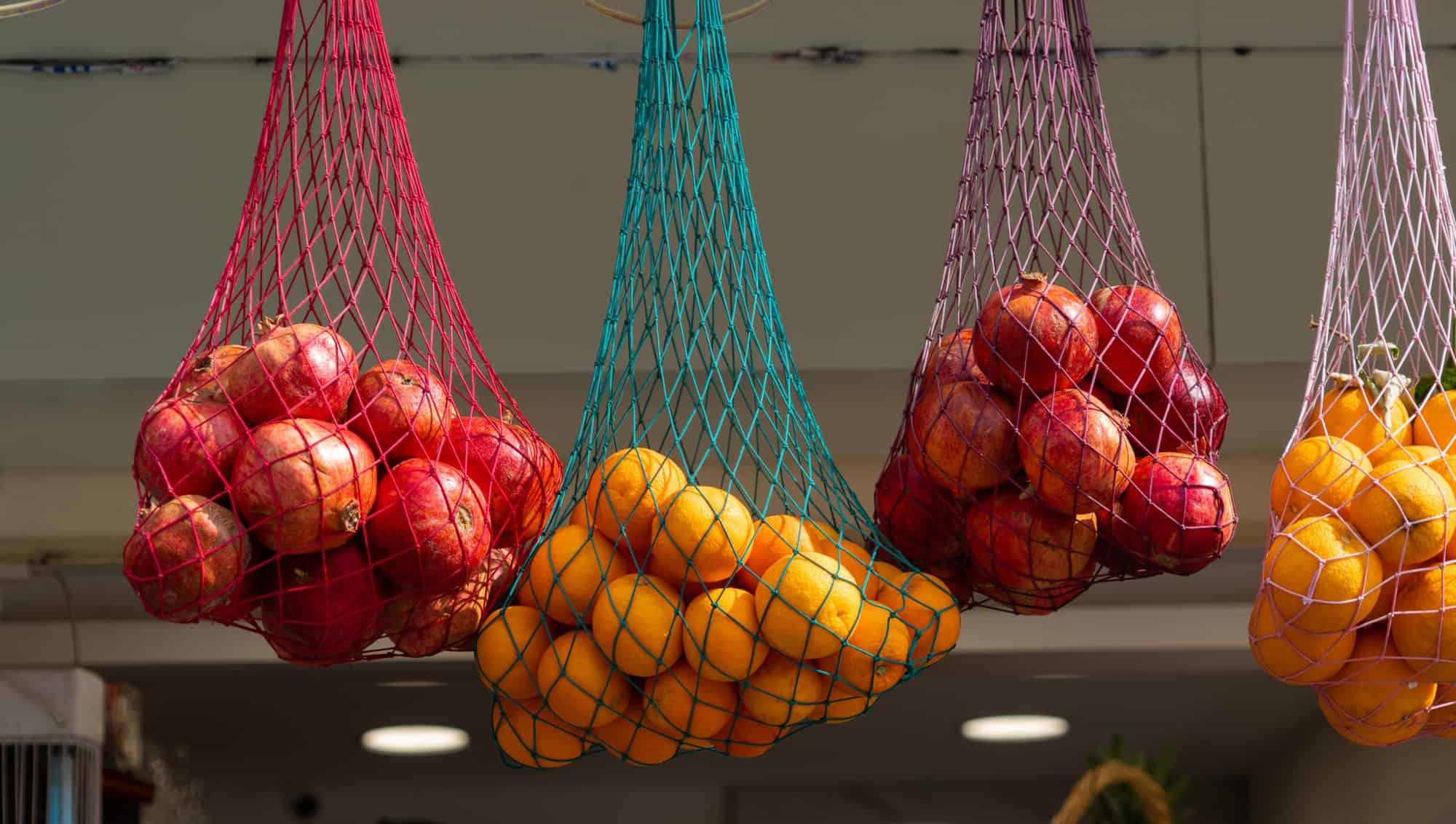
Fresh oranges and pomegranates hanging in Amman Old Town
Spend extra time in Amman
You could fill 3 days in Jordan with nothing but an Amman itinerary to soak in a sense of the country. In particular, I’d recommend the following highlights:
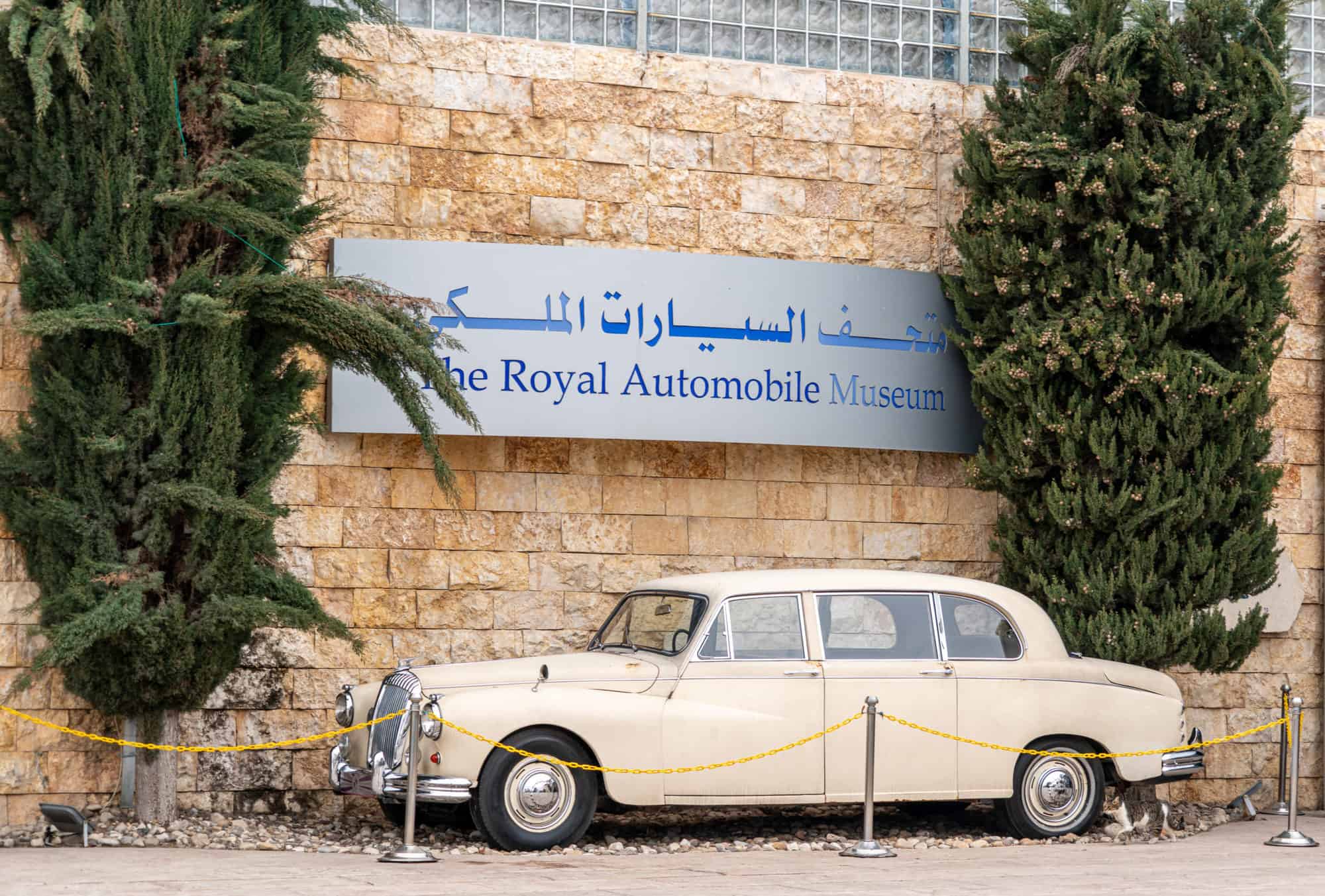
The Royal Automobile Museum
Car lovers will fall head over heels in love with the Royal Automobile Museum. But the rest of us? It’s more interesting than you may think. Amid the shiny metal and scent of rubber, you’ll find the whole history of the modern state of Jordan told through news archive and, well, automobiles. It’s the first time I’ve seen engineering history combined with humanities and, well, it’s a success!
Ride like a king!
When we left the Royal Automobile Museum, we couldn’t help but notice that our trusty tour bus had been replaced. By a fleet of vehicles from the King’s personal collection, complete with royal guards. They were assembled to take us back to our hotel!
Now, this isn’t something that you can arrange but I mention it because it reminds me of the joys of travel: you really never know what will happen in a day.
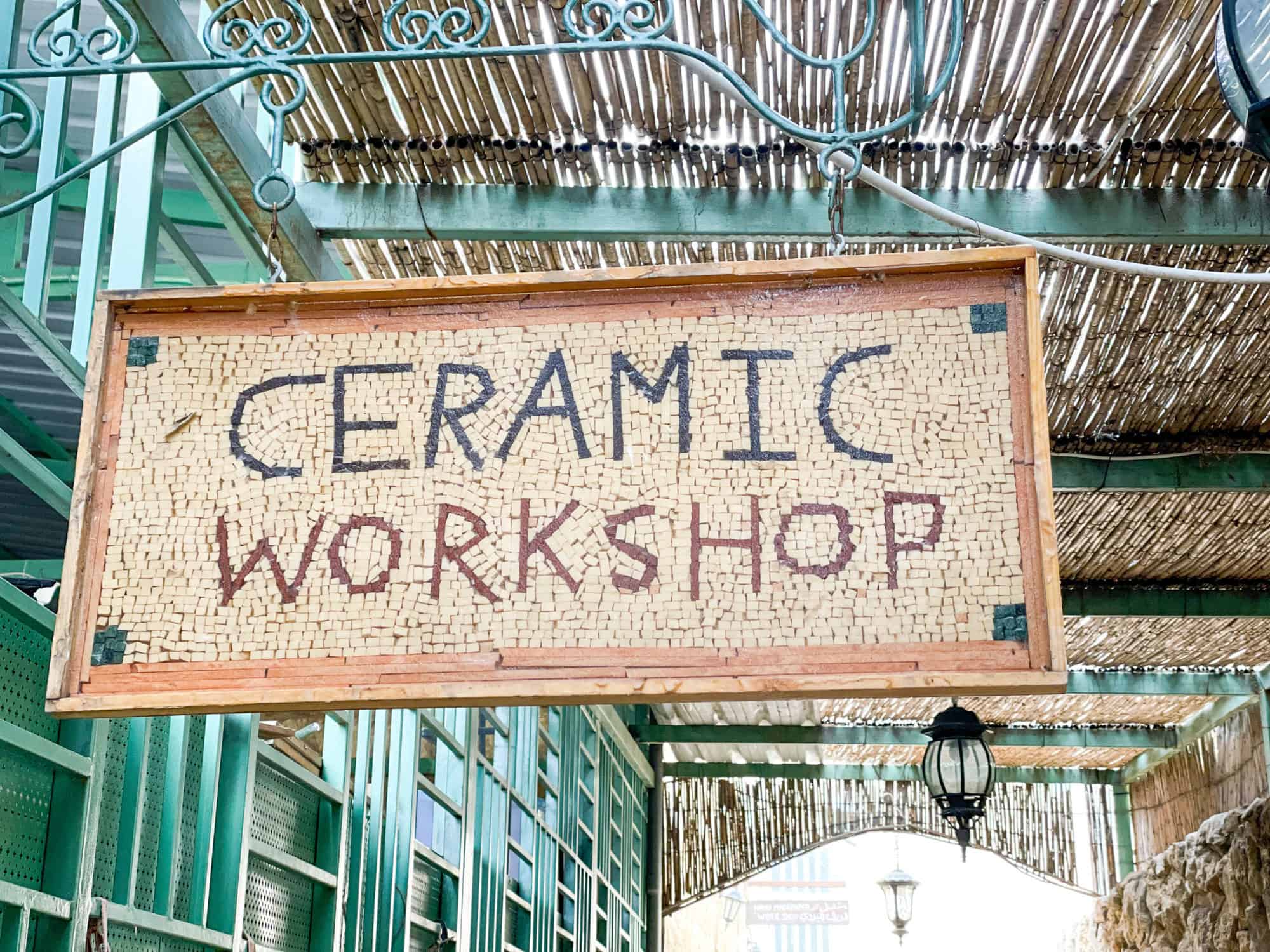
The Iraq Al Amir Women’s Cooperative
Just 20km southwest of Amman, so perfect for a leisurely day trip, you’ll find the Iraq Al Amir Women’s Cooperative. Here, cooking and crafts workshops take place within ten renovated historic farmhouses. They in turn overlook the Qasr Al-Abd archaeological site which dates back to 200BC and the Hellenistic era of Hyrcanus the Tobiad.
This beautiful spot provides home-cooked meals and sells hand crafted ceramics and pressed flowers.
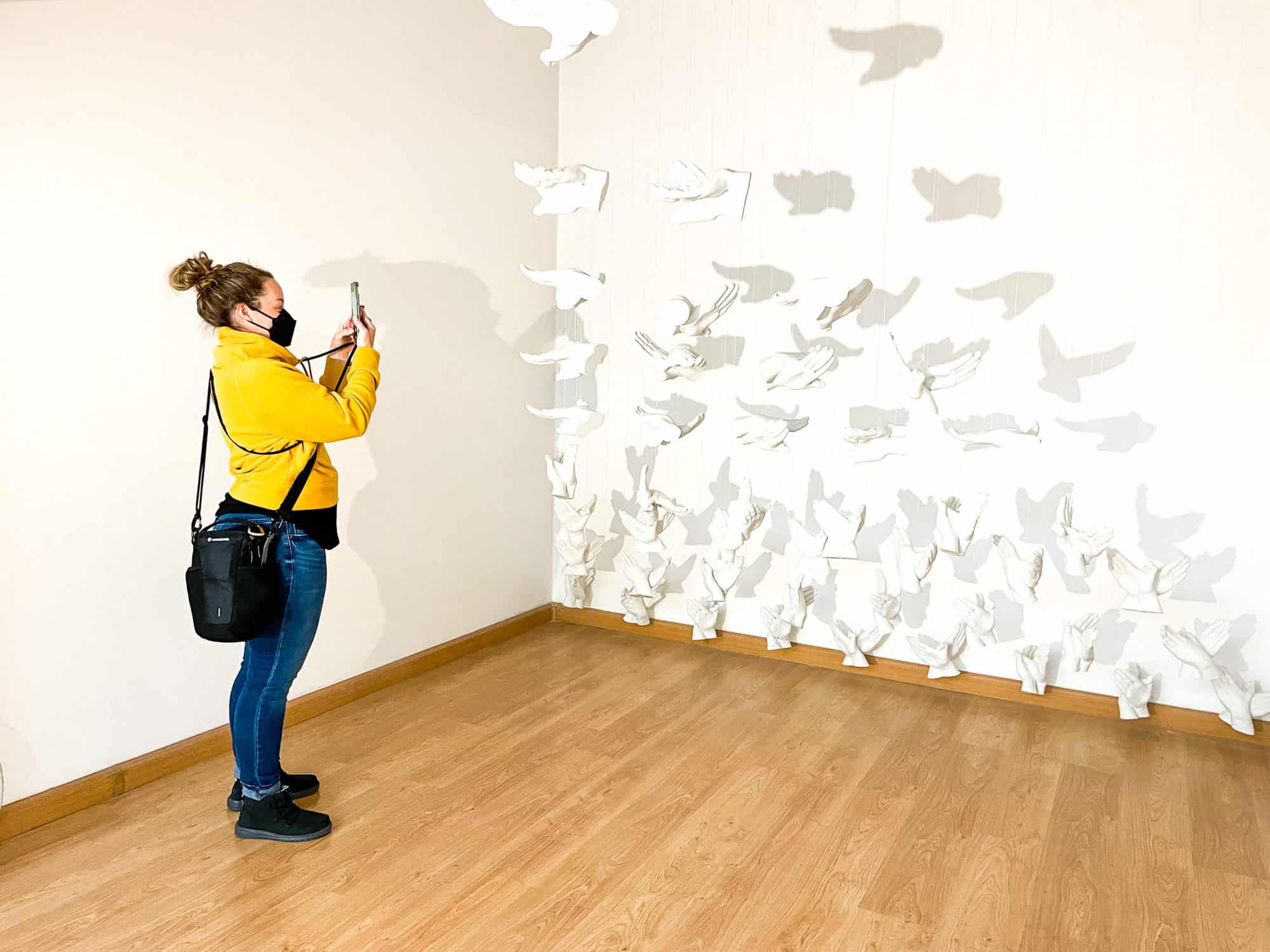
Lina from Divergent Traveler in the Amman Art Gallery
The Jordan Gallery of Fine Arts
To get a sense of where a nation is right now, you can’t beat visiting a modern art gallery. The Jordan Gallery of Fine Arts curates work from across the Middle East in a series of white, light, beautiful exhibition spaces. It also has a wonderful multicolour balcony space that overlooks the neighbourhood outside (plus a cafe, always good to find coffee.)
As an extra Globus plus, we met with Suhail Baqueen, founder of the Darat Suhail Art Center where he runs the Scent of Color programme. There he pairs colours with scents (pink with rose, lemon with yellow, orange with, well, yes, orange and so on) allowing visually impaired students to create visual art.
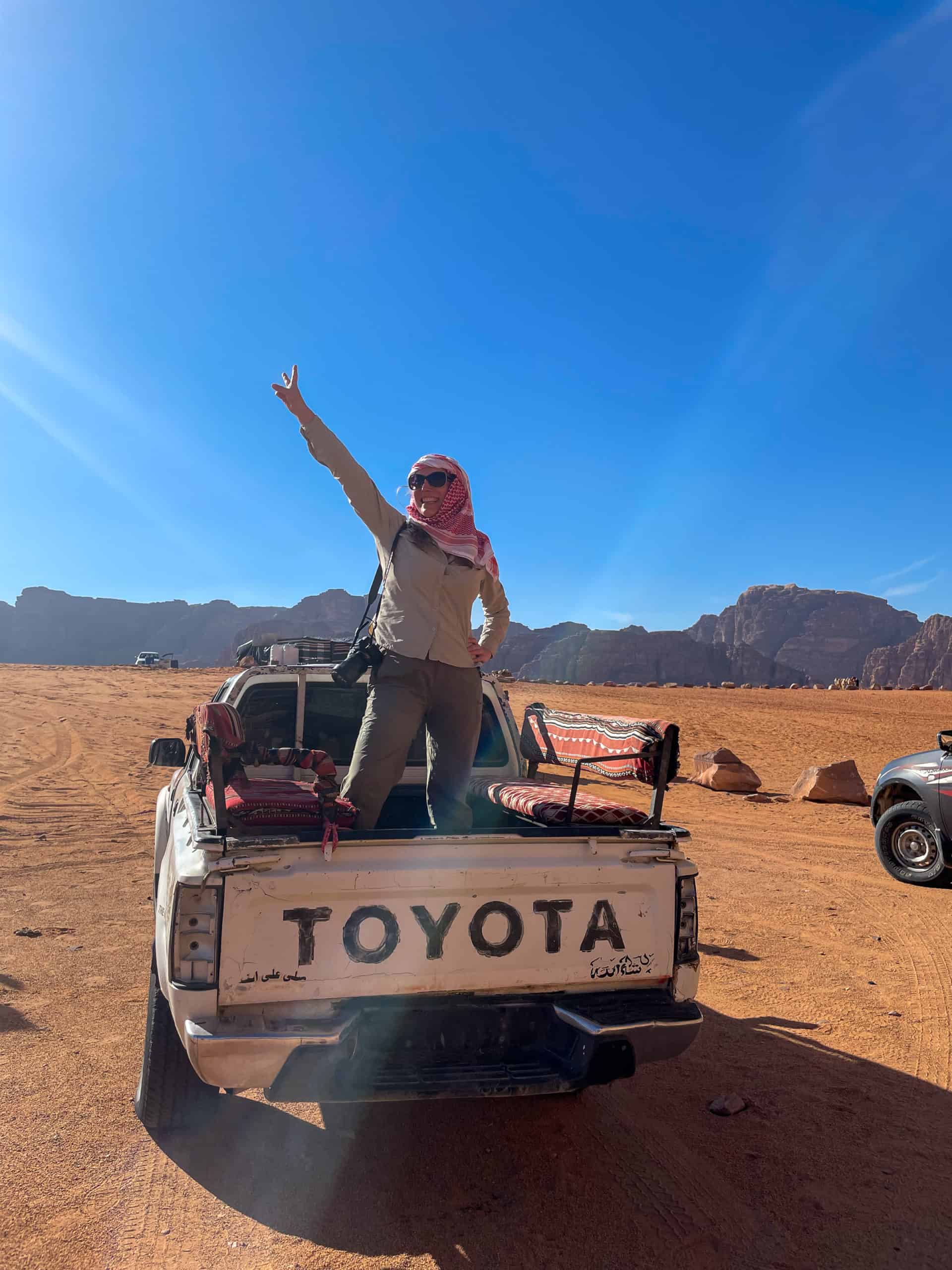
Travel in Jordan makes you feel alive!
Frequently Asked Questions About Jordan
Whenever you’re planning a Jordan trip, it’s important to ask yourself the following questions:
When is the best time to visit Jordan?
Summers in Jordan are hot, hot, hot and that heat can feel crushing when you’re spending the day hiking through Petra or beneath the burning desert sun in Wadi Rum.
Jordan’s most popular seasons, therefore, are spring and autumn: the months of March to May and September to November. During those months, Jordan’s heat has faded but the skies are still a sun kissed golden warm.
However, there is another time to visit, as I discovered on my Globus Escape. Their Escape tours prioritise travel during the off season when prices are lower and crowds are thinner. And it worked. We saw the beautiful ruined cities of Petra and Jerash with few tourists for company. And the tour prices are, on average, 30% cheaper than during the high season.
Of course, if you travel in the off season, you need to be aware that it can be cold. It’s unusual but possible for snow to fall on Petra, for example. And exposed places like the top of Mt Nebo and the Citadel in Amman, you will need to wrap up warm with the full works: hat, scarf, gloves, waterproof.
It’s also a great season for seeing the more authentic side of Jordan. And with fewer tourists around, people are more relaxed and likely to stop and chat.
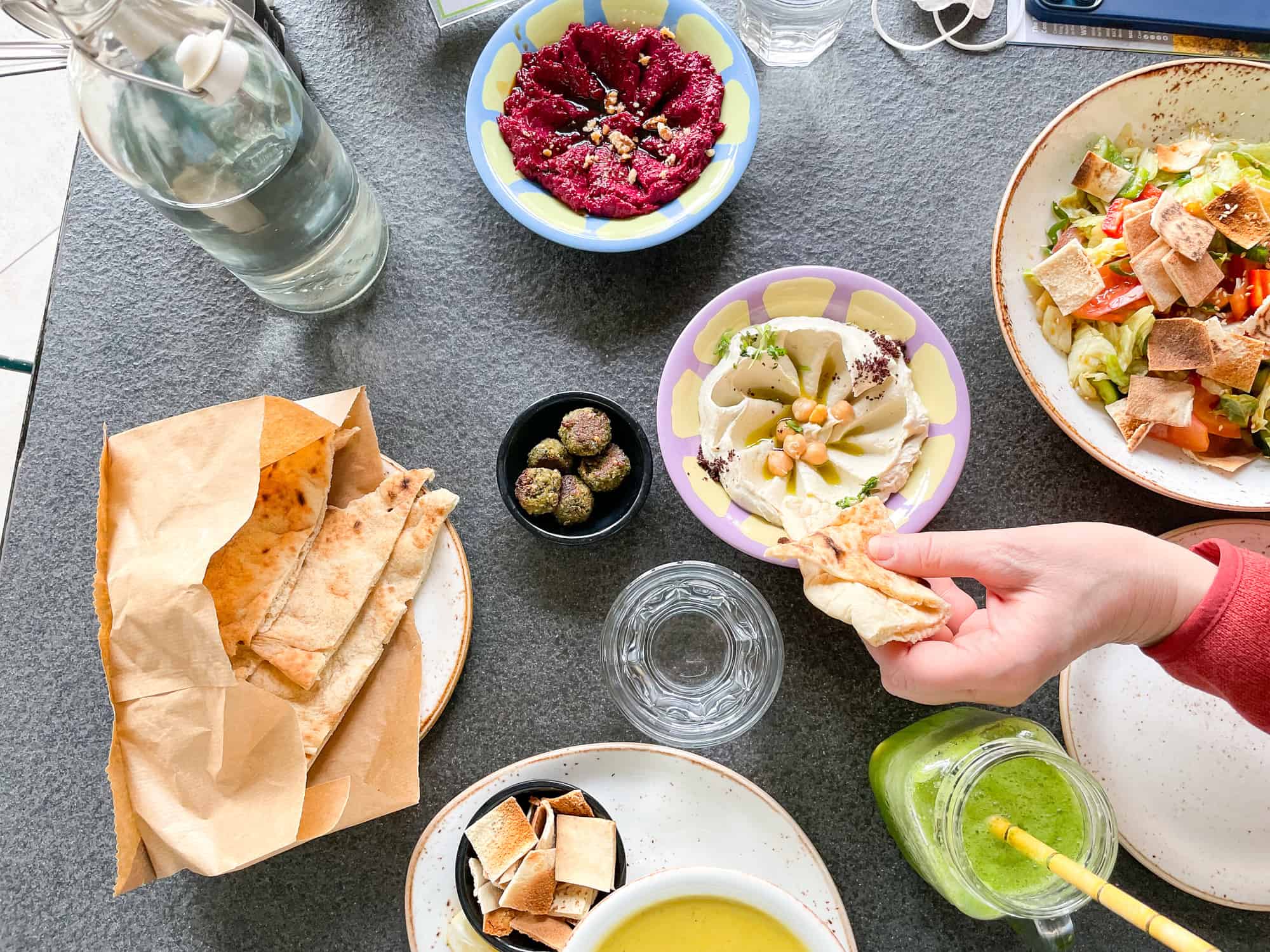
What to eat in Jordan
Food is a big, feasting, sharing tradition in Jordan and it comes with plenty of fresh salads, hummus and flat breads. You can read more about Jordanian food here , including recipes, but expect plenty of cardamom coffee, baba ghanoush, rice and meat based dishes like mansaf and the hard white yoghurt of lebneh.
Vegetarianism is still seen as a quirky curiosity across most of the country but it shouldn’t be too difficult to find meat free options.
If you’re travelling on a Globus Tour, then most evening meals will involve a buffet in one of the four and five star hotels. This will offer plenty of local options but also some international food, in case the saffron and sumac is getting too much.
On the other hand, if you’re feeling more adventurous, then you can ask your guide to arrange a home visit or cooking class for you (for an additional charge) in the evening.
Lunchtimes are a mix between large restaurants that cater for large groups of tourists or off the beaten path co-ops that burst with local traditions and flavours.
If you’re travelling independently, of course, you can choose whichever you wish. Although, bear in mind that some of the cooking classes and home visits rely on personal introductions, often through tour companies, so you may find your options more limited than they first appear.
What about dietary restrictions in Jordan
In general, the Jordanian customs are extremely hospitable and people will try to cater for your needs. That said, it’s still not that common to present vegan, gluten free and lactose free options as a matter of routine. As always, travel with a translated version of what you need to ask about, remain calm and polite and bring your own snacks, just in case.
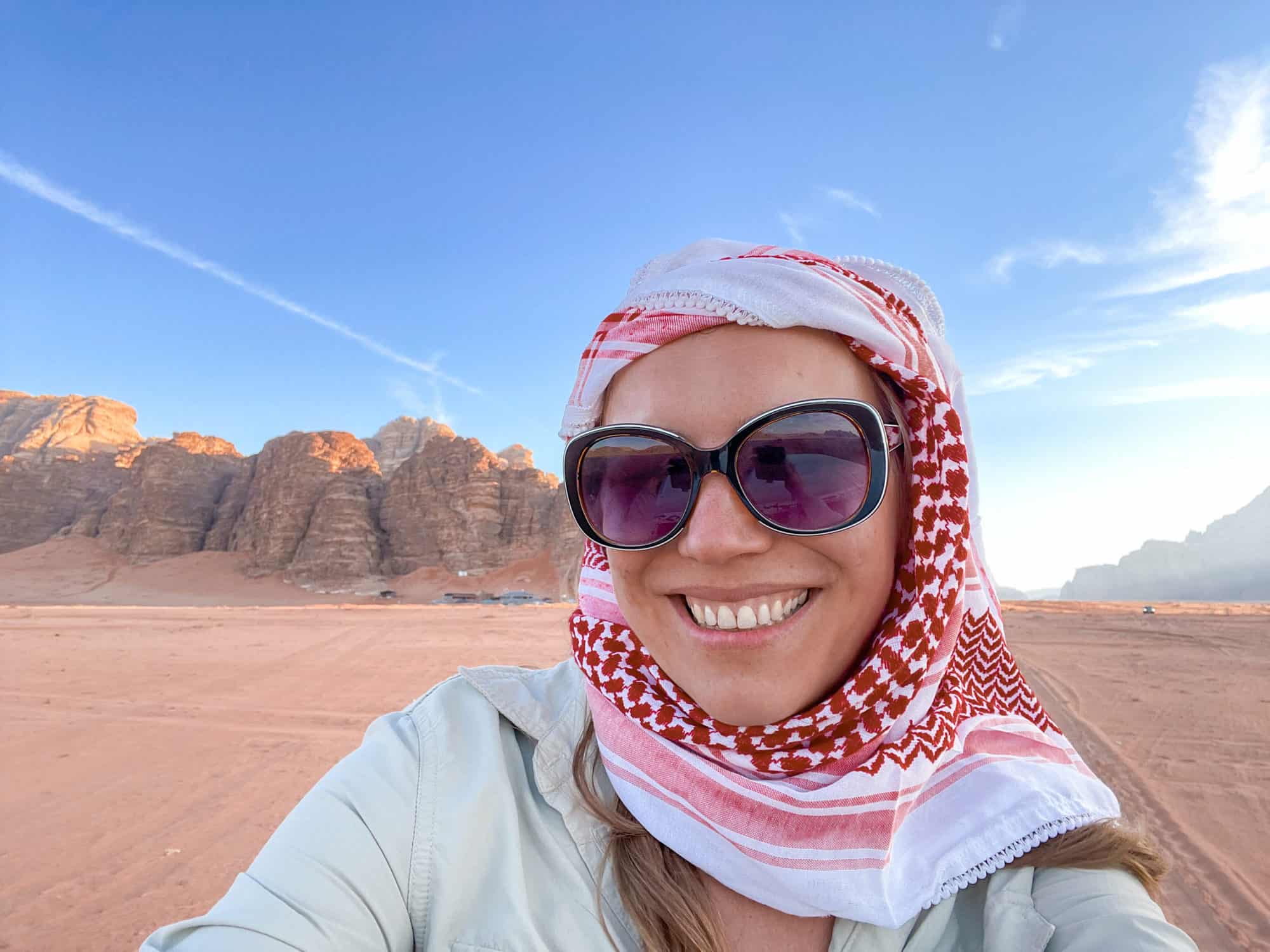
What to wear in Jordan
It’s natural to be slightly concerned about what to wear in Jordan – and in fact I’m going to write a whole new post about it.
Certain parts of the country, particularly in the desert, are extremely conservative and there you will see women fully covered with a headscarf and burqa. In Amman, on the other hand, don’t be surprised to see women in skin tight leather trousers and slouchy sweaters with their hair loose.
So what should you do?
In short, it’s best to wear loose clothes that go down to your wrists and ankles. Girls, it’s handy to have a scarf with you for visiting holy sites (and sheltering from the rain) but other than that, it’s rarely necessary. Keep shoulders and cleavage covered and avoid slits in skirts and dresses.
Is Jordan safe?
In short, yes. While nowhere is perfect, Jordan has had a stable government for many years. The main places that tourists will visit are far from the borders with places in conflict. The police presence is visible and the level of street harassment is very, very low, even from hawkers. As a solo female traveller , I’ve walked around Rainbow Street and Downtown Amman on my own with no trouble at all.
Is it a good idea to travel to Jordan with kids?
Yes and no. While I’m a passionate supporter of family travel and write about plenty of family travel itineraries, there are a few things to bear in mind about Jordan. Firstly, Petra is huge and is best enjoyed by walking around. Secondly, the Dead Sea isn’t fun to splash around in: all that salt hurts! Finally, the desert in Wadi Rum doesn’t have many facilities. It’s part of its beauty but it does make things harder if you’re travelling with very young children.
If you’re travelling with teens, I would highly recommend a trip to Jordan for your family travel bucket list. But for children younger than 10-12, I would recommend waiting. You’d be fine but you’ll enjoy it a lot more (and so will they) when they are older.
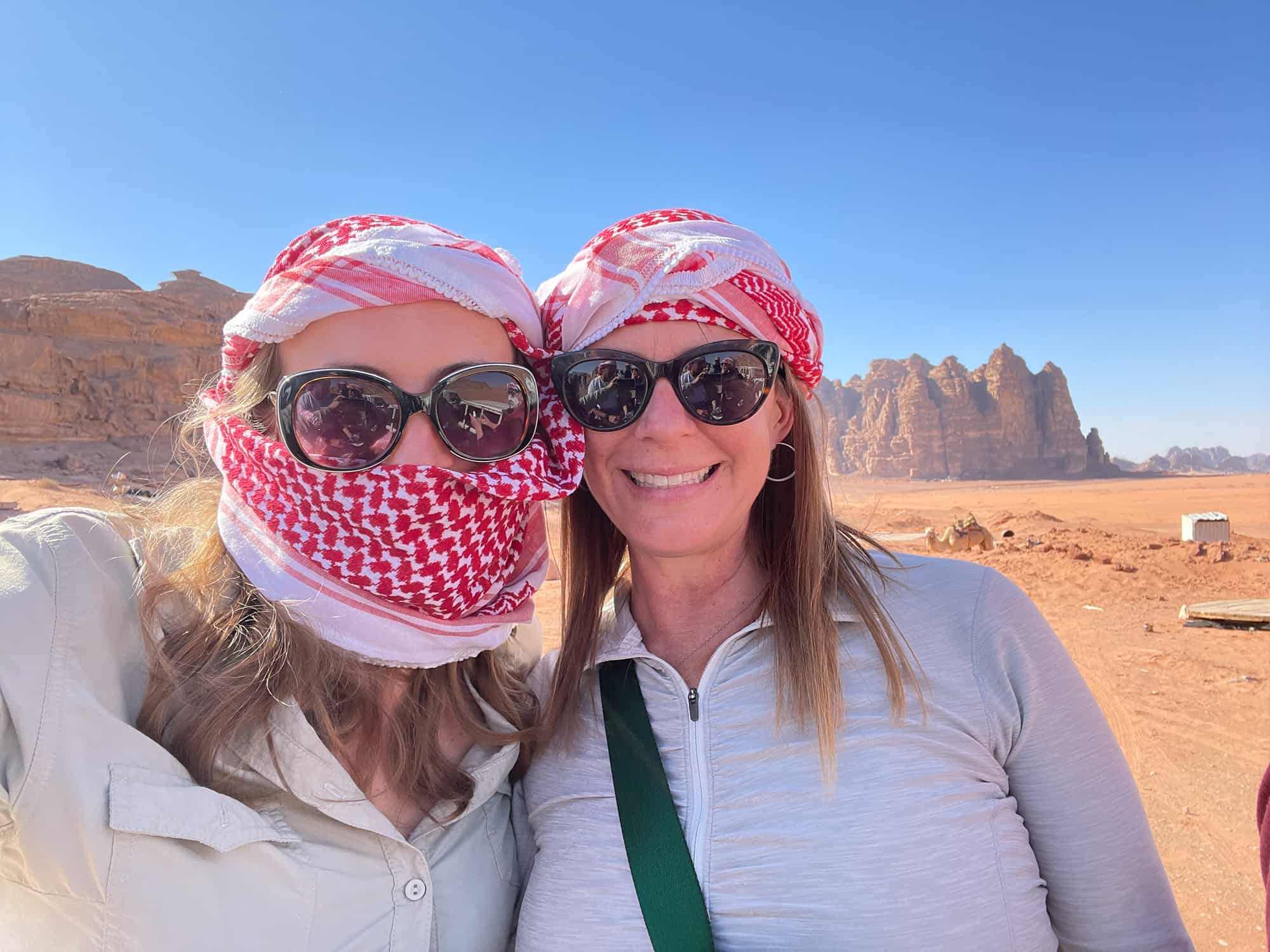
What to pack for Jordan
Don’t fall for the myth that the Middle East is always hot. Even in the summer, temperatures plunge at night in the desert.
I would recommend packing long sleeve, long legged trousers in cool linens, with some thermals and a lightweight jacket and warmer jacket as well. Make sure you have proper walking shoes of hiking boots for areas outside the city.
It’s not essential for women to cover their hair but it is really useful to pack a scarf to protect yourself from the sand if it’s windy.
Don’t forget to pack a travel adapter , your usual medication, chargers and so on. See our ultimate packing checklist here.
What is it like to travel solo in JOrdan?
If you join a group tour, it’s going to be a whole lot of fun. If you don’t speak Arabic and you’re travelling on your own, then it’s going to be intense and quite hard work. It’s a safe country, though, with a tradition of politeness and hospitality. Even the markets feel far calmer and safer than, say, Cairo or Marrakech.
Do you need a visa for Jordan?
Obviously, this depends to some extent on your own passport status. But in general, US and UK citizens can collect a tourist visa upon entry to Jordan and the process is straightforward. Always check properly in advance, though, with your own government.
How to get to Jordan
Most visitors arrive into Queen Alia International Airport (QAIA) in Amman. Flights connect to most of the world’s major hubs, from London Heathrow to New York. The airport is around 45 minutes drive from downtown Amman. While not the most exciting airport in the world, it is clean and well equipped for shopping and eating.
From London, both British Airways and Royal Jordanian fly from London Heathrow. The fastest way to connect from Heathrow to central London is via the Heathrow Express to Paddington Station, the gateway to the west, southwest and Wales. Using the Heathrow Express website in advance, you can book tickets for as little as £5.50. Plus, children 15 and under travel for free.
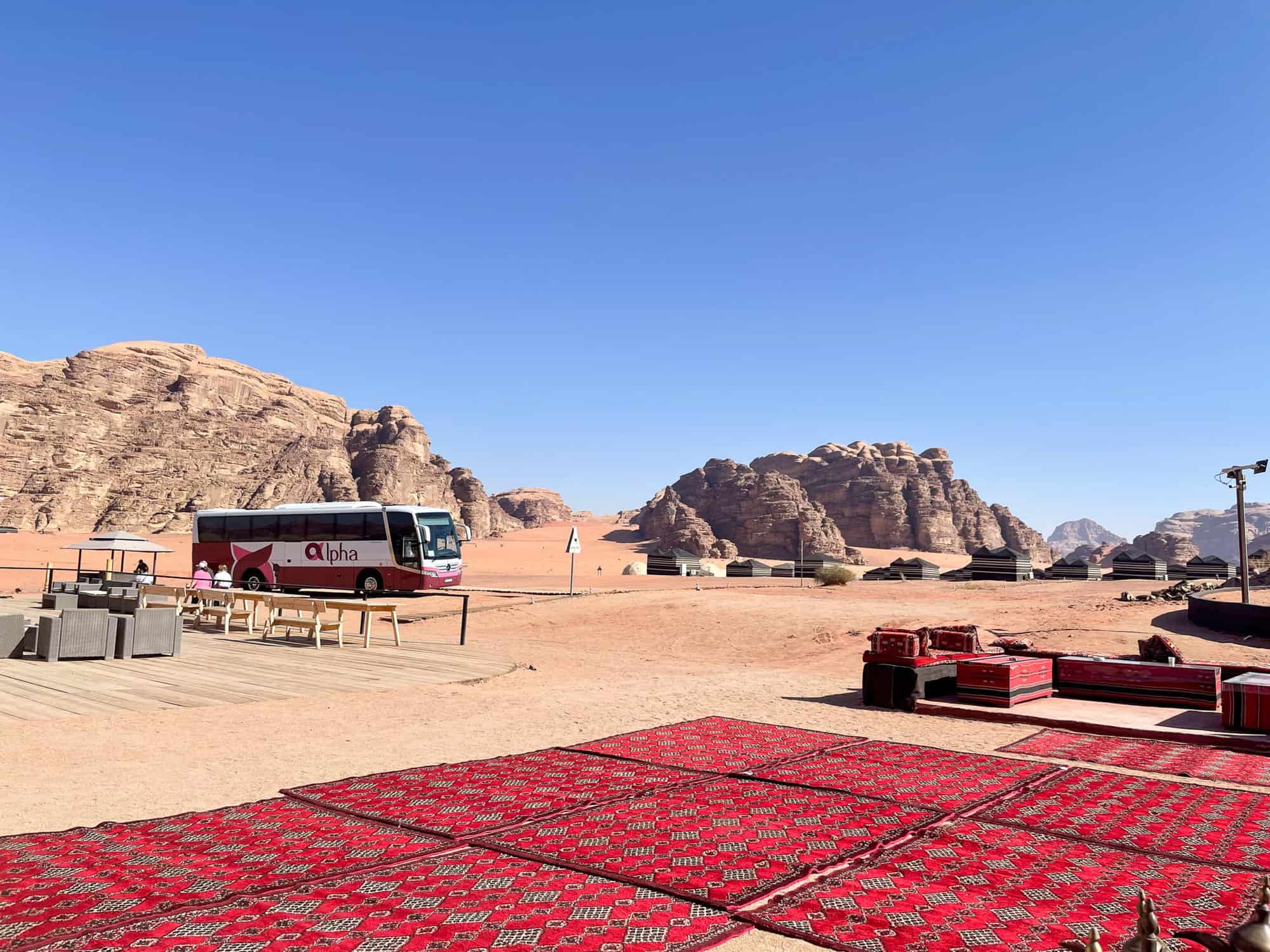
How to get around Jordan
The easiest way to get around Jordan, by far, is by car or coach with a dedicated driver. As mentioned above, given the border situation with neighbouring countries, it’s not the best place for a self drive.
In Amman, you can walk or take a taxi or Uber pretty easily. Public transport options do exist but if your time is short and you’re trying to get through this 7 day Jordan itinerary, then your own wheels make the most sense.
What currency do you need for Jordan?
Jordanians use the Jordanian Dinar, which equates to around 1 GBP or 0.8 USD. In main hotels and some tourist sites, you can pay in USD but it’s always a good idea to have some local currency on you just in case. ATMs are plentiful and straightforward to use in Amman.
More on Travel in Jordan
See our travel guide to the best things to do in Jordan and then browse through the articles below:
- Jordanian Food: the 21 dishes you need to know
- What is it like to visit Petra?
- Is Petra at night worth it?
- The ecolodge where you can spend a night with the Bedouin
- How the Madaba mosaics show the pathway to peace
- How to create your Jordan bucket list
You may also be interested in this article on the best places to visit in the Middle East.
Leave a comment Cancel reply
This site uses Akismet to reduce spam. Learn how your comment data is processed .

The Perfect Itinerary for Jordan and Invaluable Travel Guide
Want to make your trip to Jordan easy and make sure you visit all the best spots?
Then this full Jordan Itinerary and Guide is for YOU!

How long does it normally take you to plan a vacation?
When it comes to researching a new country, it can take hours and hours to figure out where to go, how to get around, where to stay and what to see! But don’t worry, I have taken care of all of the logistics so you can choose your own adventure and enjoy your trip!
I have been to Jordan over and over since 2016 and I have put together the best Itinerary that you are going to want to use. Most generic itineraries are all the same, but this one gives you all of the best spots and some underrated places that are often missed on short trips or first-time trips to Jordan.
What’s Included in the Guide?
- 36 detailed pages
- Multiple itineraries (10, 7 and 3 days)
- Day by day stops
- An interactive downloadable map
- Tips from an expert
- Accommodation recommendations
- Jordan packing list
Take a Look at my Jordan Itinerary and Guide

What locations are covered in this Jordan itinerary?
The detailed 10 day Jordan Itinerary covers all of Jordan’s top sights as well as many sites that are skipped in shorter itineraries. It is a busy 10 days but does not force you to rush. It allows time to enjoy each place without having to constantly check your watch.
If there is something you do not like, feel free to cut it out. If you cannot do 10 days, have a read of the 7 days.
If you are coming to Jordan for just a few days, my 3 days express itineraries show you as much as you can while you are in the country.
If you have more time, great! Some of the special moments I have had in Jordan were when I was wandering around without a busy itinerary.
The 10 day Jordan Itinerary will take you to:
- Desert Castles
- Crusader Castles
- Little Petra
- The Dead Sea
- Dana Biosphere Reserve
- Feynan Ecolodge
If you do not have time for 10 days, do not worry. This guide also covers a full 7-day itinerary and multiple express 3-day itineraries for short visits!
Why Do I Need This Itinerary for Jordan?
There are plenty of Jordan itineraries on the internet. Most follow the typical guided tour that shows guests the highlights of Jordan. This detailed guide weaves in restaurant recommendations, local guide insight, and step-by-step instructions without having to spend thousands on taking a guided tour. Instead of spending hours planning your independent trip to Jordan, I have put all of my experiences together and done the work for you!
Are YOU Ready to Invest in your Vacation to Jordan?

Get your detailed 10-day itinerary (plus 7 and 3 day express journeys) for just $19.99
This detailed digital Jordan Itinerary Guide is delivered immediately to your email inbox.
If you have any questions about this itinerary, please contact me at [email protected]

For travelers seeking to get an understanding of the Middle East region, its complex history, and its culture of hearty hospitality, Jordan is an obvious choice. This small country, placed at ancient–and contemporary–migration crossroads, has been a refuge for people across the millennia. From the dramatic, cliff-cut Nabatean masterpiece of Petra and the legendary Roman ruins of Jerash to the vast sands and mountains of Wadi Rum desert, lush gorges and peaks of the Dana Valley, and the salty Dead Sea, Jordan has a breadth of natural treasures. Thoughtful travelers will enjoy various ecotourism initiatives like staying at the solar-powered Feynan ecolodge or hiking the Rift Valley on a multiday mountain trek. The country’s biggest draw, however, is its culture of hospitality, shaped by people from the melting pot of communities that call Jordan home.
- Copy Link copied

Photo by Michelle Heimerman
When’s the best time to go to Jordan?
Jordan’s weather is at its loveliest from late March to April, when wildflowers dot the briefly green countryside. Between June and August, daytime temperatures can soar, making sightseeing tough–although in recent years, with the onset of climate change, the weather has been less predictable and milder temperatures have been registered during the summer months. Late September through mid-November herald blue skies and pleasant temperatures, while December and January bring bitter cold, particularly at night.
How to get around Jordan
The main gateway into the country is Queen Alia International Airport, about 20 miles south of Amman, though international airlines are starting to fly more frequently to King Hussein International Airport in Aqaba, in the south. Plenty of rental car agencies operate in Amman, with an easy checkout and return process. Drivers beware: Navigating the roads within Amman can be challenging because rules are not always followed, but elsewhere in Jordan, driving is a breeze. Roads are well maintained and well marked, making Jordan one of the easiest countries in the Middle East to explore by car.
For getting around town, the Middle Eastern response to Uber– an app called Careem –is a great alternative to taxis with cheap rides bookable in Amman, Irbid, and Aqaba. Buses and shared taxis have affordable fares and run between the bigger centers, albeit mostly without fixed schedules. An exception is JETT , the national coach carrier, which offers regular, comfortable service between major cities. (For example, service from Amman to Aqaba would get you near the Wadi Rum desert in about four hours.) Outside of the cities, public transport is severely limited, meaning you’ll have to either rent a car or hire a private driver to fill in the gaps.
Food and drink to try in Jordan
Discovering the variety and depth of Arabic food is a highlight of any Jordan journey. Food-curious folks should set their sights on street-food shops and bakeries to try falafel, shawarma , fresh-from-the-oven feteer (samosa-like pastries), manoushi (flatbread topped with za’atar), and knaffeh (the white-cheese-and-syrup sweet), as well as explore both Levantine (north) and Bedouin (south) dining traditions. The national dish is mansaf , a Bedouin meal of lamb cooked in jameed yogurt and served over rice and nuts.
Bars are a rarity outside Amman and Aqaba, but alcohol is available in liquor shops and many hotels and restaurants. Try arak (a fiery, anise-flavored spirit) and Carakale beer from Jordan’s first microbrewery , and don’t miss strong and sugary kahwa, cardamom-flavored coffee served roadside across Jordan in small tent-like shops.
Culture in Jordan
Jordan draws history buffs with its archaeological remains and pilgrims with the chance to walk in the footsteps of prophets, but the country’s contemporary side is equally fascinating. It’s worth planning a trip around annual events like the Jerash Festival, which brings a packed program of theater, music, and dance to both Jerash and Amman during July and August, the Amman Jazz Festival with performances at the ancient Roman amphitheater, or the biennial Amman Design Week, an immersive series of events, exhibitions, and workshops on design and culture running through Amman’s numerous art galleries and studios. Amman, in particular, is a capital that brims with creative energy and is worth exploring beyond a stopover for its numerous hip coffee shops, art galleries, innovative social enterprises, street art installations, and events worldly travelers shouldn’t miss.
Traveling during Ramadan is not an issue, though visitors should refrain from smoking, eating, and drinking in public during the day and be aware that some restaurants close during daylight hours and several tourist sites keep shorter hours. Cities and villages are quieter than usual during Ramadan but streets come alive with festive spirit at night when fasting breaks. Outside of holidays, traditional culture is proudly maintained and is very much a part of modern Jordanian life, particularly if you travel outside of Amman.
Can’t miss things to do in Jordan
The rose-colored ruins of Petra, the ancient city carved out of cliffs and canyons in southern Jordan, are a masterpiece of world heritage. Visitors should plan to visit Jerash, home to one of the most intact ancient Greco-Roman sites in the world. In the Mars-like desert of Wadi Rum, travelers can get a deeper insight into the Bedouin way of life while going on desert adventures like camping, hiking, rock climbing, and camel treks. In springtime, the green hills of the northern Ajloun region provide a respite from the heat of cities, with numerous hikes, farm lunches, and homestay opportunities available, while the country’s largest nature preserve inside Dana Valley is an opportunity to see rare endangered species like the Syrian wolf. Nature lovers should not miss the chance to hike the Jordan Trail , a system of long-distance hikes that runs from the northern town of Umm Qais to coastal Aqaba and passes through major sites like Dana, Petra, and Wadi Rum (the entire trail is a 40-day, 420-mile adventure). Jordan also has two major bodies of water to explore—float in the super-briny Dead Sea close to Amman or get below the waves at Aqaba, near some of the Red Sea’s top diving sites.
Practical Information
Visitors from the North America to Jordan must have a passport valid for at least six months upon entry. They’ll also need to purchase a one-month tourist visa on arrival. If you’re planning to cover a lot of ground while in Jordan, consider buying a Jordan Pass online before your trip—it includes not only your visa fee (about $57 for a single entry) but also entry to nearly 40 sites across the country, including Petra, Jerash, and Wadi Rum.
Jordan is an Arabic-speaking country where conservative clothing is standard. Visitors are encouraged to dress respectfully, which means covering shoulders and knees, particularly in downtown Amman or outside of major cities.
The currency is the Jordanian dinar (JD). Most restaurants include a service charge in their bills, and you can always leave a little extra. If a service charge is not included, a 10 percent tip is customary. Credit cards are accepted at most major hotels and restaurants, but smaller shops in Amman or elsewhere accept cash only.
Guide Editors
Yulia Denisyuk is a travel photographer and writer with a passion for the Middle East. For past assignments, she’s shared a roof with nomads in Mongolia and learned the art of imigongo with artist collectives in Rwanda.

- 3 Other destinations
- 4.1 History
- 4.2 Climate
- 4.3 Visitor information
- 5.1.2 Free ASEZA visa
- 5.2.3 Opening hours
- 5.2.4 Israeli / western side
- 5.2.5 No man's land
- 5.2.6 Jordanian / eastern side
- 5.3.1 From Israel
- 5.3.2 From Syria
- 5.3.3 From Iraq
- 5.3.4 From Saudi Arabia
- 5.4 By plane
- 5.5 By boat
- 5.6 By train
- 6.1 By thumb
- 6.3 By servees
- 6.4 By taxi
- 6.6 By plane
- 6.7 By tour operator
- 6.8 By train
- 8.1 Jordan Pass
- 8.2 Northern Jordan
- 8.3 King's Highway
- 8.4 Eastern Desert
- 8.5 Southern Desert
- 8.6 Other attractions
- 9.1 Itineraries
- 9.3 Climbing
- 12.3 Bargaining
- 12.4 Touting & guides
- 12.5 Souvenirs
- 16.1 Emergency numbers
- 16.2 Authorities
- 16.4 Society
- 17 Stay healthy
- 18.1.1 Politics
- 18.1.2 Religion
- 18.1.3 Ramadan
- 18.2 Public holidays
- 18.3 Standing in queues
- 19.1 Embassies
- 19.2 Electricity
<a href=\"https://tools.wmflabs.org/wikivoyage/w/poi2gpx.php?print=gpx&lang=en&name=Jordan\" title=\"Download GPX file for this article\" data-parsoid=\"{}\"><img alt=\"Download GPX file for this article\" resource=\"./File:GPX_Document_rev3-20x20.png\" src=\"//upload.wikimedia.org/wikipedia/commons/f/f7/GPX_Document_rev3-20x20.png\" decoding=\"async\" data-file-width=\"20\" data-file-height=\"20\" data-file-type=\"bitmap\" height=\"20\" width=\"20\" class=\"mw-file-element\" data-parsoid='{\"a\":{\"resource\":\"./File:GPX_Document_rev3-20x20.png\",\"height\":\"20\",\"width\":\"20\"},\"sa\":{\"resource\":\"File:GPX Document rev3-20x20.png\"}}'/></a></span>"}'/> Jordan (Arabic: الأردنّ, al-Urdunn ) is an Arab kingdom in the Middle East , at the crossroads of Asia, Africa and Europe.
Jordan has been repeatedly called an "oasis of stability" in the Middle East. Since the 1940s, millions have immigrated to Jordan for a better life.
With an extensive collection of tourist attractions, ranging from biblical sites to seaside sites, there is a lot to see and do in Jordan.
Jordan can be divided into four regions:
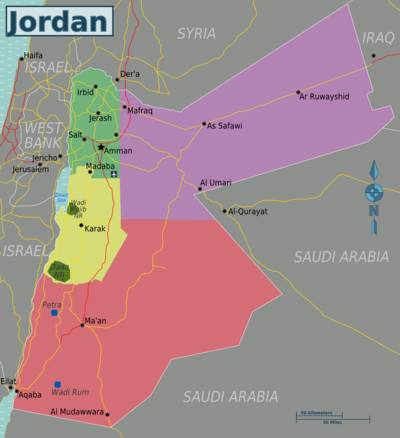
- 31.95 35.933333 1 Amman (Arabic: عَمَّان ) — the country's economic, political, and cultural centre.
- 29.516667 35 2 Aqaba — located on the Gulf of Aqaba (Eilat), with links to the Sinai and the Red Sea
- 32.555556 35.85 3 Irbid — second largest metropolitan area in the north of the kingdom
- 32.272281 35.891397 4 Jerash — one of the largest Roman ruins in the Middle East
- 31.716667 35.8 6 Madaba — known for its mosaic map of Jerusalem and the Holy Land
- 32.039167 35.727222 7 Salt — ancient town which was once the capital of Jordan
Other destinations
The following destinations are the most popular ones in Jordan. For less popular destinations, look at the regional pages.
- 32.3325 35.751667 1 Ajlun Castle — impressive ruins of a 12th-century castle
- 30.6875 35.575278 3 Dana Nature Reserve — stay in a traditional village and enjoy unforgettable hiking in an offshoot of the Great Rift
- 31.5207 35.4845 4 Dead Sea — the lowest point on earth and the most saline sea
- 30.328889 35.440278 5 Petra — Jordan's top attraction, an ancient city carved out of sandstone and one of the new 7 Wonders of the World
- 32.653889 35.688611 6 Umm Qais — a Roman-era settlement, close to the ruins of the ancient Gadara
- 29.5765 35.419928 7 Wadi Rum — barren, isolated and beautiful, granite cliffs contrasting with desert sand
- Desert castles — once getaways for caliphs from the Umayyad period.
During early and classical antiquity, the area of what is now Jordan was home to ancient kingdoms. Among them were Ammon, Edom and Moab. It was part of the Persian Empire and the Roman Empire .

Jordan was also home to civilizations such as the Nabataean Kingdom. Its rock art and architecture can be found in a few places across the country.
Before World War I, the entire Levant was part of the Ottoman Empire . In 1916, during World War I , the Great Arab Revolt was launched against the Ottomans with help from the British and one Thomas Edward Lawrence (aka Lawrence of Arabia). The revolt was successful in gaining control of most of territories of the Hejaz and the Levant. However, it failed to gain international recognition as an independent state, due mainly to the secret Sykes–Picot Agreement between the United Kingdom and France in 1916 (dividing up the Middle East between the two colonial powers) and the UK's Balfour Declaration of 1917 (promising a national home for the Jews on a small piece of land in the Middle East). The region was divided and Abdullah I, the second son of Sharif Hussein, arrived from Hejaz by train in Ma'an in southern Jordan, where he was greeted by Transjordanian leaders. Abdullah established the Emirate of Transjordan, which then became a British protectorate.
In September 1922, the Council of the League of Nations recognized Transjordan as a state under the British Mandate for Palestine and the Trans-Jordan memorandum. The memorandum clarified that the territories east of the Jordan River were excluded from provisions that allowed Jewish settlement in the Mandate. The Treaty of London, signed by the British Government and the Emir of Transjordan on 22 March 1946, recognised the independence of Transjordan upon ratification by both countries' parliaments. On 25 May 1946 the Emirate of Transjordan became "the Hashemite Kingdom of Jordan", as the ruling Emir was re-designated as "King" by the parliament of Transjordan.
On 15 May 1948, as part of the 1948 Arab–Israeli War, Jordan invaded Mandatory Palestine with other Arab states. Following the war, Jordan occupied the West Bank including East Jerusalem and many Muslim, Christian and Jewish Holy Sites and declared that the annexation was a "temporary, practical measure" and that Jordan was holding the territory as a "trustee" pending a future settlement. King Abdullah was assassinated at the Al-Aqsa Mosque in 1951 by a Palestinian militant, amid rumors he intended to sign a peace treaty with Israel. Abdullah was succeeded by his son Talal, but Talal soon abdicated due to illness in favor of his eldest son Hussein, who ascended the throne in 1953. During Jordanian occupation, Jews had to leave the West Bank and access to Jewish Holy Sites was severely restricted. Jordan lost the West Bank to Israel during the Six Day War in 1967. In the following year, an attack by Israeli forces on the headquarters of the Palestine Liberation Organization in Karameh was met by resistance by a joint Jordanian-PLO force. In the aftermath of the resulting 15-hour battle, the Jordanian government permitted the Palestinians to take credit for Israeli casualties. Following the Battle of Karameh there was an upsurge of support for Palestinian paramilitary elements (the fedayeen) within Jordan from other Arab countries, leading to the fedayeen becoming a "state within a state", threatening Jordan's rule of law. In September 1970, the Jordanian army targeted the fedayeen and the resultant fighting led to the expulsion of Palestinian fighters from various PLO groups into Lebanon, in a civil war that became known as Black September. Jordan renounced its claims to the West Bank in 1988.
The Israel-Jordan Treaty of Peace was signed on 26 October 1994. On 7 February 1999, Abdullah II ascended the throne upon the death of his father Hussein. Jordan's economy has improved since then. Abdullah II has been credited with increasing foreign investment, improving public-private partnerships and providing the foundation for Aqaba's free-trade zone and Jordan's flourishing information and communication technology (ICT) sector. As a result of these reforms, Jordan's economic growth has doubled to 6% annually compared to the latter half of the 1990s. However, the Great Recession and regional turmoil in the 2010s severely crippled the Jordanian economy and its growth, making it increasingly reliant on foreign aid.
The Arab Spring began sweeping the Arab world in 2011, with large-scale protests erupting and demands for economic and political reforms. In Jordan, Abdullah II responded to protests by replacing his prime minister and introducing various reforms, thereby satisfying the people sufficiently to avoid the civil conflict, regime change or chaos that broke out in some other Arab countries.
There is no hostility between Muslims and Christians in Jordan, which is one of the most liberal nations in the region. Jordan is considered to be among the safest of Arab countries in the Middle East, and has historically managed to keep itself away from terrorism and instability. In the midst of surrounding turmoil, it has been greatly hospitable, accepting refugees from almost all surrounding conflicts since 1948, including the estimated 2 million Palestinians and the 1.4 million Syrian refugees residing in the country. The kingdom is also a refuge to thousands of Iraqi Christians and Yazidis who fled the Islamic State. While the Jordanian royal house holds much less power than the Saudi royal family, they aren't ceremonial figures like in most of Europe, either. However, relations with the West - including Israel - are usually quite friendly and domestic policies also tend to be moderate by the standards of the region.
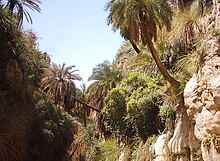
The climate in Jordan varies greatly. Generally, the further inland from the Mediterranean, greater contrasts in temperature occur and the less rainfall there is. The country's average elevation is 812 m (2,664 ft) above sea level. The highlands above the Jordan Valley, mountains of the Dead Sea and Wadi Araba and as far south as Ras Al-Naqab are dominated by a Mediterranean climate, while the eastern and northeastern areas of the country are arid desert. Although the desert parts of the kingdom reach high temperatures, the heat is usually moderated by low humidity and a daytime breeze, while the nights are cool.
Summers, lasting from May to September, are hot and dry, with temperatures averaging around 32 °C (90 °F) and sometimes exceeding 40 °C (104 °F) between July and August. The winter, lasting from November to March, is relatively cool, with temperatures averaging around 13 °C (55 °F). Winter also sees frequent showers and occasional snowfall in some western elevated areas.
Visitor information
- Visitor Jordan website.
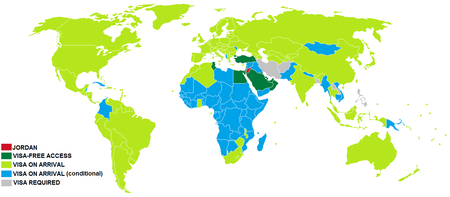
Entry requirements
For the latest, up-to-date and complete information, please check out the Jordan Tourism Board [ dead link ] .
Nationals from Arab countries can enter Jordan without a visa and for free.

Jordan's visa regulations are rather confusing and often change. Moreover, the rules vary depending on the border point where you cross the border.
Visitors from most other countries (even Israeli citizens and Israeli passport holders) can easily obtain a visa on arrival at the border point directly, except for the King Hussein ("Allenby") Bridge, where a visa is not issued on spot and must be obtained in advance through the Embassy of Jordan.
Some nationalities may require a visa before arrival (many African countries, Afghanistan, Albania, Bangladesh, Belize, Cambodia, Colombia, Cuba, Iran, Iraq, Laos, Moldova, Mongolia, Myanmar, Nepal, Pakistan, Papua New Guinea, Philippines, Sri Lanka, Vietnam, and Yemen).
The visa prices are:
- 40 JD for one month & single entry (easily extended – up to twice – at the nearest police station)
- 60 JD for three months & double entries
- 120 JD for six months & multiple entries (not extendible)
For the single entry visa the fee of 40 JD is waived if you have purchased a Jordan Pass [ dead link ] before arrival, see details below .
Furthermore, there are extra fees involved if you stay only a couple of days in Jordan (1-3 days). The regular single entry visa through Jordan Pass, for example, is not waived – see #Jordan Pass for details.
There is a departure fee of 10 JD when exiting Jordan by land or sea, if one stayed in the country for 2 nights or less. There is no tax if in the country for longer than two nights. At the Aqaba/Eilat border crossing, the border police will now not give the exit stamp without paying this tax first, if applicable (June 2022).
Free ASEZA visa
You can receive a free, one-month ASEZA visa if you arrive at Aqaba (aka Aqaba Economic Zone ) by land (from Eilat in Israel or Saudi Arabia ), by sea (ferry from Egypt at Nuweiba ), or by air (at Aqaba International Airport). You can check here whether you are entitled with your nationality to get the free visa.
If you receive a free ASEZA visa, you will have to exit the country through the same entry point. It's important to keep in mind that if you enter Jordan through Aqaba Free zone with the free visa, but leave Jordan via another border crossing (for example fly out from Amman, or enter Israel through the northern border), you must pay 40 JD for a visa that you did not pay entering through Aqaba.
The ASEZA visa allows free travel throughout Jordan. There is no tax for leaving the Aqaba Economic Zone and crossing into the rest of the country. There are road checkpoints when leaving ASEZA, but these are no concern for foreigners. Usually, the control is either waived for tourists or minimally done (just show your passport; if driving, show also your driving license, car registration and open the trunk).
The free ASEZA visa can also be obtained at almost all other crossings (except King Hussein "Allenby" Bridge), by stating that you are going to Aqaba. There will be no 40 JD charge for the entry visa, but you are obliged to arrive in Aqaba in maximum 48 hours and get a stamp from a police station in Aqaba or from the 29.55884 35.020462 1 ASEZA (Aqaba Special Economic Zone Authority) headquarters , go to window #18: "Residency permit renewal". If the Aqaba late-arrival stamp is not in your passport, at departure you will pay the 40 JD charge for the entry visa plus a fine of 1.50 JD/day, for each day non-registered (the day you entered Jordan is counted as day 1, even if you entered at 23:59).
If you want to enter through Aqaba and do not want to get the ASEZA visa, you must ask the customs officer to put the normal visa in your passport and pay the normal visa fee.
King Hussein "Allenby" Bridge
This border crossing between the West Bank and Jordan is called King Hussein Bridge on the Jordanian and Allenby Bridge on the Israeli side, but using the latter in Amman is likely to cause perplexion or even hostility.
The Allenby Bridge is an Israeli-managed crossing mainly used by Palestinians to travel internationally because Palestinians are required by Israel to use the airport in Amman in Jordan rather than the airport in Tel Aviv .
This crossing does not allow private vehicles of any kind, but relies solely on public transport.
This border crossing does not offer visa on-arrival for Jordan. So, you need to obtain yours beforehand, e.g. at the Jordanian Embassies in Ramallah or Tel Aviv/ Ramat Gan (40/60/120 JD single, double, multi). See Jordan#Visa for more details.
Also, this is the only border crossing point where entry to Jordan (and exit) is not allowed on an Israeli passport because it connects directly to the West Bank.
For entering the West Bank from Jordan, the usual visa-free entrance rules for Israel apply, since the checkpoint on the western side is operated by Israel. Hence, plan your travel documents accordingly.
If leaving Jordan through this border crossing, you can return to Jordan through the same crossing point on the same visa you got when entering Jordan in the first place (except for ASEZA visas) if its validity has not expired.
You will not receive an exit stamp from Jordan here, and you will not be stamped on re-entry if you choose to return through the same border crossing (this one).
The exit fee to leave the West Bank and Israel through this border crossing is ₪176. (In Aqaba and Sheikh Hussein the exit fee is just ₪113.)
The exit fee into the opposite way to leave Jordan is 10 JD, payable in cash and JD only, as of 2023.
Opening hours
- Jordanian side: Sa–Th 07:10-00:00, F 07:10-03:00
- Israeli side: Daily until 20:00; F and Sa until 12:00 (but some say 15:30).
Bear in mind that the border can be closed with relatively little warning, especially if the security situation in the West Bank escalates.
Israeli / western side
There are direct shared taxi between Jerusalem (Al-Souq Al-Tijaree (the commercial souq) not far from the main bus station) and this checkpoint for ₪38 (or 11 JD) plus ₪4 per piece of luggage. Also, the Palestinian bus company (outside the checkpoint to the right, red buses) offers connections to/from Jericho and Ramallah —Ramallah and Jerusalem are connected by sherut. Note, you are not allowed to walk away from this checkpoint to catch a regular bus into Israel from the bus stop 2.7 km away.
At the checkpoint Israeli officials process passport control and customs, including exit fees for exit from Israel. Inside you'll go through a security check (bag scans and metal detector) and proceed to passport control. Be warned, there is no queuing system, and people tend to shove their way to the front. Additionally, there is some VIP service that seems some varying level of formal/informal but allows some passengers to skip queues and move straight to the front for a fee.
When proceeding to passport control into Israel, you will be given a small blue and white card with your photo on it that says B2 visa. This is your entry proof in effect and must be kept with your passport at all times (and will be asked for when you check into hotels, etc). They will not stamp your passport entering Israel.
No man's land
The land between the Israeli and the Jordanian checkpoints consists of an open road of a few kilometers that must be crossed by ( JETT ) bus. While online guides will note that passengers with a JETT ticket from Amman will have this bus included, this seems to no longer be the case as of April 2023.
Either way, the bus is 7 JD, plus 1.5 JD for each of your bags. This payment must be made in cash, though they will also accept US dollars or euros (at a terrible rate). Even though the no man's land stretch is only a few kilometers, it includes two check points and can often taken hours of waiting, and sometimes only takes a few minutes—often with no real rhyme or reason on why it will be one or the other.
This will eventually take you to the other checkpoint, where you will de-board the bus with all of your belongings and proceed to the next checkpoint.
Jordanian / eastern side
When entering Jordan, since all your visa and Jordan Pass requirements needed to be sorted out beforehand, there is nothing more to do than passing the checkpoint. Also, here no need to pay any fee this way.
The other way around, when leaving Jordan, you will take all of your belonging with you, go through a quick security scan, and then find yourself in a small room with four windows. There is very little signage but you will need to go to three windows in total. The first is a customs window, where you'll fill out a small slip of paper with your full name, nationality, date of birth, and exit date. The first window will stamp this slip and send you to a payment window, where you will pay the exit fee—Jordanian dinars in cash only, as of April 2023. Once you paid, you will be given a slip with two perforated slips that are then stamped. You will then move to the last window, where you will hand the officer your passport, and both slips (the two perforated slips and the slip with your name/nationality/birth date/exit date). They will then take your passport and keep it in a stack with the ones of th other travellers. You will then be directed to wait in a small seating area until you are directed to board the bus to the Israeli checkpoint. On the bus, the driver will come around and redistribute all passports, and a border control agent will come to double check your exit visa slips.
At least one JETT bus connects the Jordanian checkpoint with Amman : JETT office at Abdali, 11 JD, 06:30–07:15 from Amman, takes about 1 hr. The other way around, the bus stop near the Jordanian checkpoint is not immediately visible (when getting out of the border office). Thus, many taxi drivers will pretend that there are no buses, which is untrue. (Nevertheless, they should be no more than 20–25 JD per ride.) Also, there are shared (white) taxis between here and the Tabarbour / Northern Bus Terminal in Amman (5–9 JD per person for up to four people, 20 JD per ride), but also other destinations.
Expect travel between Amman and the old city of Jerusalem to take at least 3 hr. Travellers regularly experience waits that can vary anywhere between 2–12 hr. Hence, it's a good idea to try to get to the border as early as possible, especially in the busy summer season.
If you mention any West Bank destinations in your itinerary to the Israeli border guards, this will arouse suspicion and potentially additional scrutiny and waiting time. Thus, it is just best to avoid mentioning Palestine at all while passing the border.
Jordan shares borders with four countries: Israel, Saudi Arabia, Syria, and Iraq. For very obvious reasons, entering Jordan from Israel or Saudi Arabia is strongly recommended and advisable.
From Israel
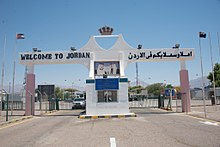
Besides the King Hussein "Allenby" Bridge, the Sheikh Hussein Bridge (aka Jordan River crossing near Beit Shean) allows entry into Jordan from Northern Israel, and the Eilat/Aqaba crossing (aka Wadi Araba aka Yitzhak Rabin) from Southern Israel (see on-arrival visa limitations above).
For both you will have to pay an Israeli departure tax of ₪113, plus a processing fee of ₪6. For all details including a complete fee catalogue and opening hours (which should consequently also apply to the Jordanian side) see the Israel Airports Authority website .
There are daily buses from Nazareth via the Sheikh Hussein bridge, call the operator ( ☏ +972 4 657-3984 ) for details. A fare is ₪80 one way. Alternatively, you can take a regular bus/taxi to the Sheikh Hussein bridge, cross the border on foot, and get into Irbid or Amman by bus.
To get to the southern crossing by bus take one to Eilat. Several buses run here, including the 444 which follows a route along the Dead Sea. From Eilat Bus Station, the border is around 3 km, reachable by taxi for around ₪45-50. Alternatively, you can exit the bus at the second last stop at "Yitzhak Rabin Crossing / Highway 90" and walk the last 1.5 km to the border. When on the Jordanian side, pay attention to the Aqaba border taxi cartel, and only use a taxi from there for the shortest distance possible, and swap into a cheaper taxi or even bus afterwards.
If you cross by car, border formalities are time-consuming and expensive as a Jordanian insurance is required, and you will even have to change your number plates, since it is not advisable to travel in Arab countries while displaying an Israeli number plate. Israeli rental cars are not permitted across the borders for insurance reasons.
Given the ongoing civil war , entering Jordan from Syria is not advisable at this time.
It is possible to enter Jordan from Iraq depending on your nationality, but because of the current situation in Iraq , it is not advisable, and you will be looked at a lot more closely than if entering from elsewhere.
From Saudi Arabia
Entry from Saudi Arabia is by bus. Jordan-bound buses can be taken from almost any point in Saudi Arabia or the Gulf. Most of these are used by Arabs. The border crossing, called Al-Haditha on the Saudi side, and Al-Omari on the Jordanian side, has been rebuilt. Waiting time at customs and passport control is not too long by Middle Eastern standards, but allow for up to 5 hours on the Saudi side. As the crossing is in the middle of the desert, be absolutely sure that all paper work is in order before attempting the journey, otherwise you might be lost in a maze of Arab bureaucracy. The trip from the border to Amman is 3 hr and up to 20 hr to Dammam , Riyadh or Jeddah on the Saudi side. The trip can be uncomfortable but is cheap.

Jordan's national airline is Royal Jordanian Airlines . In addition, Jordan is served by foreign carriers including Air France, Lufthansa, Turkish Airlines, Egypt Air, Emirates and Delta Air Lines. Low-cost airline Air Arabia serves the Middle East, and Aegean Airlines and TAROM serve Europe. Ryanair also offers direct flights to Amman from Belgium, Italy, Poland, Hungary, Romania, Czech Republic and Lithuania.
Jordan can be entered at the port of Aqaba (ASEZA) via the Egyptian port of Nuweiba . There are two services, ferry and speedboat. Expect to pay around US$60 for the ferry or around US$70 for the speedboat (both one way + US$10 or LE50 departure tax from Egypt) if you are a non-Egyptian national (Egyptians are not required to pay the prices inflated by the authorities). The slow ferry might take up to 8 hr, and can be a nightmare in bad weather. The speedboat consistently makes the crossing in about an hour, though boarding and disembarking delays can add many hours, especially since there are no fixed hours for departures. You cannot buy the ticket in advance and the ticket office does not know the time of departure. You can lose an entire afternoon or even a day waiting for the boat to leave.
Also see Aqaba#By boat from Egypt and Ferries in the Red Sea for more details and options.
There are no international trains to Jordan. However, Saudi Arabia Railways runs trains from Riyadh to the border town of Al Qurayyat from where one can continue by bus or taxi the last kilometers into Jordan.
Jordan is one of the easiest countries to hitch-hike in. It is not uncommon to wait less than 5-10 min before getting picked up. Especially if you are not from the US or such, people are happy to take you along the way and immediately will raise topics like FCB, Paris, Bayern Munich, or pizza depending on your nationality. In addition, hitch-hiking is made even easier by the fact that many tourists with guides or rental cars will pick you up if they see you are not from around the region. Although Jordan is targeted by extremists, hitch-hiking is not more dangerous than in other countries taking into account the high likelihood of getting picked up by someone. Even on a holiday in off season you will barely wait more than 10 min for someone to stop.
To get a ride just let your arm hang and use your hand to wave towards you, or point down towards the road with your index and middle finger. Don't put up the hitch-hiking thumb, this seems to be impolite. In some countries, it is common to pay even for hitch-hikes. Here it is not. Though, for example along the hotel promenade of the Dead Sea, locals might demand a small amount, but anything beyond 2 JD for 10 km is too much – take bus prices as an orientation, just in case.
Combining this with local (mini) buses (which ever comes first) is an efficient and inexpensive way to discover and experience Jordan, and meet interesting and friendly locals.

The JETT bus company has services connecting Amman to Aqaba , the King Hussein Bridge (to cross into Israel ), and Hammamat Ma'in . Private buses (mainly operated by the Hijazi company) run from Amman to Irbid and Aqaba . Minibus services connect smaller towns on a much more irregular service basis – usually they leave once they're full.
The Abdali transport station near Downtown Amman served as a bus/taxi hub to locations throughout Jordan, but many of its services (especially microbus and service taxi) have been relocated to the new Northern bus station (also called Tarbarboor, or Tareq). Here you can find buses into Israel,1 JD bus to Jerash/Dead sea and a 3.50 JD bus to Queen Alia airport.
Be aware that drivers at the Northern bus station can lie about ticket price, so pay together with other people - buses are departing as soon as they are getting full and special man will collect money from everyone before departure.
Service taxis or so called servees cover much the same routes as buses. They are definitely more expensive than minibuses, but a lot faster and more convenient.
Servees only leave when full so there is no set timetable. You may also be approached by private cars operating as service taxis. If you use one of these, it is important to agree the price in advance.
Servees are generally white or cream in colour. They can sometimes be persuaded to deviate from their standard route if they are not already carrying passengers. It is quite likely that you would be asked to wait for a yellow taxi though.
Regular taxis are abundant in most cities. They are bright yellow and are generally in good condition. A 10 km trip should cost around 2 JD.
All yellow taxis should be metered, however most drivers outside Amman do not use them. If you do get picked up by such or even unmetered taxi, make sure you agree on the price before departing – per drive and not per person ! If you do not agree on a price, you will most likely pay double the going rate. Using the meter is almost always cheaper than negotiating a price. So, it is best to insist that the driver uses it before you depart. Keep your luggage with you – it's not uncommon for unmetered taxis to charge a ridiculous rate (30 JD for a 10-min ride) and then refuse to open the trunk to give you your bags back until you pay up.
Standardised but inflated taxi prices from the Eilat/Aqaba border crossing are:
- Wadi Rum (one way) 39 JD
- Wadi Rum (round trip including waiting time) 55 JD
- Petra (one way) 55 JD
- Petra (round trip including waiting time) 88 JD
- Amman (and suburbs) 109 JD
- Dead Sea 99 JD
Although, it might be a better idea to take a taxi into Aqaba and from there take a different taxi and renegotiate the price.
Day rates for taxis can be negotiated. These are usually through specific taxi drivers that have offered the service to friends or colleagues before. If you are staying at a hotel, the reception desk should be able to find you a reliable driver. It is also quite common in quiet times to be approached (politely) by taxi drivers on the street looking for business. There are plenty of good English speakers so it pays to wait until you find one you like. Do not use taxi drivers as guides, though — see #Touting & Guides below.
A full-day taxi fare should cost around 20-25 JD. An afternoon taxi fare would be around 15 JD. For this price the taxi driver will drop you off at local shopping areas and wait for you to return. You can then go to the next shopping location. You can leave your purchases in the vehicle as the driver will remain in the taxi at all times, but it is not recommended to do so.
If you are planning a trip outside of Amman, the day rates will increase to offset the fuel costs. For day trips within 1–3 hours of Amman, a taxi is by far the easiest method of transport. A trip to Petra in a taxi would cost approximately 75 JD for 3 people. This would get you there and back with about 6 hours to look around and see the sights.
If travelling a long way, try to use buses or coaches rather than taxis. Some taxi drivers are not averse to driving people into the middle of the desert and threatening to leave them there unless they hand over all their money. This is very unlikely if you stick to recommended drivers however. Jordan is generally very protective of its tourists and while overcharging is common (if not agreed in advance), threats and cheating are rare.

You can easily reach major cities by car in Jordan.
Jordan's highways are generally in very good shape, but the same cannot be said about its drivers or its vehicles. Many trucks and buses drive with worn or defective tires and brakes and in the southern and more rural parts of the country there is the tendency for some people to drive at night without headlights (in the belief that they can see better and that this is therefore safer!).
Avoid driving outside the capital, Amman, after dark.
Renting a car should be inexpensive and not too time-consuming. Fuel prices are all fixed by the government, so don't bother looking for cheaper gas stations. Expect to pay around 0.825 JD per litre (unleaded 90 octane), 1 JD per litre (unleaded 95 octane), of 0.625 JD for diesel (Oct 2018). They're reviewed on a monthly basis to reflect international gas prices on the local prices.
The main route is the Desert Highway , which connects Aqaba , Ma'an and Amman and then continues all the way to Damascus in neighbouring Syria . Radar speed traps are plentiful and well positioned to catch drivers who do not heed the frequently changing speed limits. Traffic Police are stationed regularly at turns and curves, well hidden, with speed guns. If you are even 10% over the speed limit, you will be stopped and made to pay a steep fine.
One particular stretch, where the road rapidly descends from the highlands of Amman to the valley that leads into Aqaba through a series of steep hairpin curves, is infamous for the number of badly maintained oil trucks that lose their brakes and careen off the road into the ravine, destroying all in their path. This stretch of the road has been made into a dual carriageway and is now a little safer. However, exercise caution on this stretch of the road.
The other route of interest to travellers is the King's Highway , a meandering track to the west of the Desert Highway that starts south of Amman and links Kerak , Madaba , Wadi Mujib and Petra before joining the Desert Highway south of Ma'an .
Uber is available in Amman .
Considering there are only two airports in the country, there's only one domestic air route: Amman to Aqaba and back.
A flight to Aqaba from Amman will take about 50-55 minutes.
By tour operator
Much of Jordan's more dramatic scenery (Wadi Rum, the Dana Reserve and Iben Hamam) is best seen on 4x4 vehicles with drivers or guides familiar with the territory.
Most people visiting Jordan opt for organised tours, although it is possible to use local guides from the various visitors' centres at Jordan's eco-nature reserves. The majority of tourists crossing into Jordan from Israel are on one-day Petra tours or in organised tour groups. They make up a significant percent of the daily visitors in Petra and Jordan's natural attractions.
The Jordan Hejaz Railway is the only rail line operating passenger services. It is mostly a tourist attraction and not a means of practical transportation. In the 2010s Jordan has made some noise towards building new rail lines and neighboring Israel has built numerous new rail lines in the 1990s, 2000s and 2010s and has announced an intention to cooperate with Jordanian and/or Palestinian partners for cross-border services but as of 2018 nothing concrete has come of this.
The national language of Jordan is Arabic .
The local vernacular is Jordanian Arabic . If you don't know the local dialect, don't worry; Modern Standard Arabic is learned by everyone.
English is widely spoken throughout the country. Almost all university-level classes are held in English, and it is the de facto language of banking and commerce. If you don't know any Arabic, don't worry, as you can get around easily communicating in only English.
French and German are the two most popular foreign languages. This said, do not expect to find speakers of the two languages outside Amman .
You might encounter speakers of Caucasian languages as Jordan is home to a large number of immigrants from the Caucasus .
Jordan Pass
The Jordan Pass [ dead link ] provides free entrance to more than 40 sites in Jordan within a two-week period, and the cost of your tourist visa is waived if you stay at least 3 nights in the country. It offers a great saving compared to purchasing tickets (and visa) separately.
The pass costs 70 JD if you want spend one day at Petra, 75 JD for two days, or 80 JD for 3 days in Petra (as of June 2022). The pass must be used within 12 months after purchase. Entrance to the Bethany, baptism site can be purchased as an addon to the pass for an extra 8 JD. Mount Nebo, the Dead Sea museum, and many of the Madaba churches (Including the St. George Church with the famous Mosaic) are notably not included in the pass (~1-3 JD).
The single-entry tourist visa fee (40 JD) is waived (at the airport). If you leave Jordan before completing these 3 nights, you will have to pay the visa fee at the border when you leave.
- For non-on-arrival-visas, e.g. when using the Allenby Bridge, travelers can use the Tel-Aviv embassy (and possibly in Ramallah?) to get a free tourist visa by bringing their passport, Jordan pass, and explaining that they must use the Allenby crossing. The embassy staff however expects that the visa is used for entry soon, preferably within a month.
- The visa fee is 10 JD for tourists entering Jordan by land.
- You might not have to pay any visa fee in certain circumstances, e.g. for the free, one-month ASEZA visa (see above ). Then, the visa waiver does not really do anything for you.
Considering the regular entrance fees to Petra of 50/55/60 JD (90 JD for single-day Jordan visitors), to Jerash of 10 JD and to Wadi Rum of 5 JD, it is hard not to take advantage of this great offer.
Children under the age of 12 can enter the tourist sites for free when accompanied by their parents.
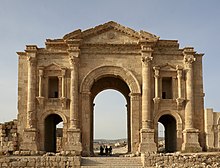
Northern Jordan
North of Amman is the ancient city of Jerash , where you can see some of the most impressive Roman ruins in the Eastern Mediterranean world.
Other sites include Umm Quais , Ajlun Castle and Pella (north-west of Amman). Madaba and its Archaeological Park include some of the finest mosaics in the world.
King's Highway
Parts of the western edge of Jordan's border are the Jordan River, and the Dead Sea to experience floating without the fear of drowning. Close to the Dead Sea is also Bethany (Jesus's baptismal site).
In addition, a visit to Kerak and Dana Nature Reserve are worth while.
Eastern Desert
Close to Amman the most interesting sights of this region are the Desert Castles around Azraq.
Southern Desert
Wadi Rum is an astonishing desert landscape that leaves no one untouched.
The archaeological ruins at Petra are Jordan's biggest tourist draw and a must-see for anyone travelling in Jordan. A vast site, and at least two days are needed to really see the entire area.
Other attractions
Jordan, during World War I , was home to intelligence officers such as T. E. Lawrence, (aka Lawrence of Arabia). Some of its sites from the military expedition can be seen in parts of the country.
- Go diving or snorkelling in the Red Sea by Aqaba. The Red Sea has some of the world's most famous coral reefs and is a popular place for diving and snorkelling. Turtles, squids, clownfish and a sunken tank are a few of the underwater sights. Equipment can be rented at diving centres, and if you contact them they are happy to come pick you up by car and take you to a good beach spot and back.
- Floating and "swimming" in the Dead Sea is one of the highlights.
Itineraries
- 8-9 days of hitch-hiking and bus: Amman – Jerash – Madaba – Dead Sea – Dana Nature Reserve – Petra – Wadi Rum – Aqaba (including potential stops at Ajlun, Mount Nebo, Dead Sea Panorama complex, and Shoubak Castle). Add one day for each of the following: Desert Castles, Madaba surrounding area, Wadi Mujib, Kerak
- 4-5 days : Aqaba – Petra – Wadi Rum – Aqaba
While not immediately intuitive, Jordan is perfect for hiking. It is one of the best ways to experience the Jordanian culture since one frequently meets nice Bedouins who will try to invite you to a cup of tea.
Great places to hike are Dana Nature Reserve, Wadi Rum, Wadi Mujib, Wadi Bin Hammad (northwest of Kerak), some canyons, other Wadis, along the Dead Sea, and various routes in the North of Jordan. The north is also a popular since it is the greenest part of Jordan.
The North has many oak tree forest reserves (Umm Qais, Ajloun), which provide a stark contrast to the rest of Jordan. Around Amman, urban sprawl has made many hilltops unfit for hiking, but certain valleys, especially towards the west and far south of Amman are nice hiking destinations. Further south, near the Dead sea, numerous unique canyons (such as Wadi Mujib), which often have little streams, are a popular hiking destination with a bit of climbing involved, depending on the Canyon (also known as Wadi). It is strongly advised, though, to not hike in Wadis during raining season, as flash floods can and do occur. Wadi Bin Hammad, is longer Wadi with a fairly "big" stream. The Dana Reserve is less green than the destinations further north, but still has a unique landscape due to its rock structures. There are several RSCN managed Eco accommodations in the reserve and it has a unique flora and fauna. Several hikes with varying lengths are possible here. Around Petra, there exist also numerous hiking trails, which provide a good mix of interesting rock formations, nature, and historical structures. For example, a popular trail is going from Petra to Little Petra (Another Nabataean settlement). Wadi Rum can also be nice to hike due to its unique landscape. Temperatures are high, though, and one always walks on sand.
There is also a 675-km trail running through all of Jordan—from Umm Qais in the North to Aqaba in the South. It is called "The Jordan Trail " with adequate lodging along the route. It runs through many areas mentioned above, such as Wadi Rum.
Climbing is frequently done in Wadi Rum. The rock is relatively soft, though. Around Amman, Climbat is a popular indoor climbing place.
Jordan has one of the best educational systems in the Middle East and has one of the highest literacy rates in the region.
For long stays, it is possible to take Arabic courses at the University of Jordan and at other private educational centres in Amman. The British Council in Amman occasionally runs courses in Arabic for foreigners.
In Amman, the starting cost for apartments is 350–1,400 JD monthly. Proprietors prefer you pay up front and commit for at least a half year stay.
An alternative is Zarqa Private University. It is a 35-minute drive due east of Amman and can save you a fortune, because it costs 1/3 less to stay in an apartment there than in Amman.
Finding employment in Jordan as a foreigner is close to impossible, even though it has been historically known for its high intake of refugees and immigrants.
With an unemployment rate of 21.9% – a remarkably high rate − as of 2023, there are not enough jobs for people, and the government isn't keen on letting non-Jordanians compete with Jordanians for employment opportunities. An oversupply of educated labour, lack of creation of employment opportunities, and regional instability all contribute to the poor state of the Jordanian labour market.
A Jordanian work permit will not be granted to you unless you intend to work in agriculture, as a domestic worker, or in the industrial sector.
The currency is the Jordanian dinar , locally denoted by the symbol " JD " before or after the amount or in Arabic as دينار, or sometimes " £ " (ISO currency code: JOD ). It is divided into 1000 fils and 100 piastres (or qirsh). Coins come in denominations of 1 (almost non existent), 5 and piastres and ¼ JD, ½ JD. Banknotes are found in denominations of 1, 5, 10, 20, and 50 JD. The currency rate is effectively fixed to the US dollar at an artificially high rate (about $1.41 ≈ 1.00 JD) that makes Jordan poorer value than it would otherwise be. Most upper scale restaurants and shops at shopping malls also accept US dollars.
Many places have limited change so it is important to keep a quantity of 1 JD and 5 notes JD. As bank machines give 20 JD and 50 JD notes for large transactions, this can be difficult.
Cards are accepted in a limited (and seemingly random) way. Most hotels and hostels take cards including Petra entry fees (50 JD and more) and at camps in Wadi Rum.
ATMs are commonly available, but might charge a fee of up to 7 JD, especially the ATM at the airport right before the visa counter which you have to use to withdraw money to pay for the visa(-on-arrival), except for when you have a Jordan Pass . Try several machines to find one with the lowest or without any fee, and remember the bank. However, in case of Visa, sometimes these additional fees will not get collected back home. Probably mostly only ever if it states more on your receipt than you have received.

A subsistence budget would be around 15 JD per day, but this means you'll be eating falafel every day. 25 JD will allow slightly better accommodations, basic restaurant meals and even the occasional beer. It is best to check accommodation prices online – most Jordan hostels and hotels have their rooms on the common hotel websites.
If you prefer to eat what the locals eat, it should only cost 1-2 JD for which you can buy a falafel/shwerma sandwich with any can of soda pop (most common is Coke, Sprite and Fanta). If you want to buy a chicken sandwich it will cost (0.50-0.80 JD).
To try real Jordanian food and don't stay at starred hotels all the time; eating there is expensive for an average Jordanian. Unless the meal came with the hotel accommodation, don't eat here. It may look like the people inside can afford the meal and make it look and sound like this is an average way to eat. Go into the city or local markets or restaurants and find out what the people there are buying – you will save a lot of money on your trip. If not and you want to save the trip of seeing the country's true people then stay where you are and enjoy whatever the travel guide wants you to see, do and pay.
Non-Jordanians can get a VAT refund at the airport when they are returning home. The VAT amount must be more than 50 JD on anything except for: food, hotel expenses, gold, mobile phones.
Summary (common prices and costs):
- Bus – 1 JD per 40 km; taxi – 1 JD per 5 km; camel, donkey or horse – 12-15 JD/hr
- Falafel roll – 0.5 JD; falafel & hummus – 2-3 JD; beer (in the shop) – 0.5-1 JD
- Hotel room – JOD8-15 JD; dorm – 5 JD; mattress – 1-2 JD
- Wadi Rum camp – 20-30 JD; Dead Sea hotels – 50-60 JD (off-season)
- Dead Sea (tourist) beach – 20 JD; Jordan Pass – 70-80 JD
The average monthly salary for Jordanians is 450 JD, while the official poverty line is 70 JD per month (2018).
Bargaining is accepted, especially at markets, but some prices might already be final, e.g. in restaurants, the bus, or the museum. Since also rich locals will get fair and inexpensive local prices, there is no reason why tourists should pay more, though as a tourist, it might be hard to find out whether the price you got is fair or inflated because you are considered wealthy. It is best to ask at several different locations to get a feeling for what the price should be. Remember to always thank the merchant for stating the price, even if not buying anything.
A working approach for hotels is to look up the price on one of the big hotel reservation sites and to walk straight into the chosen hotel stating that seen price. You might get some discount, if not, just trying the next one might convince the guy at the reception to give you a better price. This however will only work when and where accommodation options are vast, i.e. probably not during high season in Petra or at the Dead Sea.
Touting & guides

Tourism is a big income generator. While this must be appreciated and respected in the wake of troublesome times, many tourists are just fast cash cows for tourist guides and taxi drivers who carry them from one overpriced venue, shop, hotel or restaurant to the next one, collecting their share of 30-50% from the owner when leaving. So, do not rely on them too much, otherwise they will cash in on you twice, once for their service and once taking commission. This means, either the restaurant will be a tourist trap with very inflated prices or the hotel will add a surcharge when you ask them for the price, especially if the guide or taxi driver stands right next to you. Instead, choose the restaurant and hotel by yourself without them following you, and just use taxi drivers for transport, not as a guide. Always only rely on the bare minimum of such help, and spend your money arbitrarily and widely, and not just at the hotel you are staying or the place your guide drops you off.
Also, do not believe in the common my cousin (or friend) offers/has got it (something that you are looking for) and I can get it cheaper for you – the opposite will mostly be the truth, neither will it be his cousin nor will it be cheaper. Always get several independent quotes for things or tours you are interested in, and never get convinced that there is only one option available and you have to stick with that one telling you so, even if they say this or that is not available, does not work or is not in this direction , e.g. taxi drivers pretending that there are no buses from the Allenby Bridge into Jordan. The variety of such examples is vast.
Do not buy souvenirs in the tourism centres of the country, like Petra, Jerash or Amman – the prices here are inflated 2- or 3-fold. Madaba or Irbid might be good opportunities to get souvenirs.
Buying and exporting archaeological artefacts might be prohibited, like ancient coins. So, do not get into thinking you can make a good deal here. If you are not an expert, you might even end up buying fake genuine goods – just because they look old and the merchant talks lovely does not make them real.
Jordanian cuisine is quite similar to fare served elsewhere in the region. The daily staple being khobez , a large, flat bread sold in bakeries across the country for a few hundred fils. Delicious when freshly baked.
For breakfast, the traditional breakfast is usually fried eggs, labaneh , cheese, zaatar and olive oil along with bread and a cup of tea. Falafel and hummus are eaten on the weekends by some and more often by others. There's no convention for when you should or should not eat any type of food. It's up to you. This is the most popular breakfast. Manousheh and pastries come in as the second most popular breakfast item. All of the hotels offer American breakfast.

The national dish of Jordan is the mansaf , prepared with jameed, a sun-dried yogurt. Grumpygourmet.com describes the mansaf as "an enormous platter layered with crêpe-like traditional "shraak" bread, mounds of glistening rice and chunks of lamb that have been cooked in a unique sauce made from reconstituted jameed and spices, sprinkled with golden pine nuts." In actuality more people use fried almonds instead of pine nuts because of the cheaper price tag. The best mansaf can be found in Kerak .
While mansaf is the national dish, most people in urban areas eat it on special occasions and not every day. Other popular dishes include Maklouba, stuffed vegetables, freekeh.
Levantine-style mezza are served in "Lebanese-style" - which is typical to Jordanian style - restaurants around the country, and you can easily find international fast food chains. Some local businesses such ate:
- Abu Jbarah: falafel restaurants
- Al kalha: falafel and homous restaurant
- Al-Daya'a and Reem: places to get shawerma sandwiches and dishes.
As for foreign style restaurants, there is no shortage of them. The best ones are usually found in 5-star hotels, but the price tag is high. Italian restaurants and pizza places are somewhat abundant in Amman, Madaba, and Aqaba, but are very hard to find in other cities.
More and more cafes now serve food. There is an abundance of Middle Eastern-style cafes serving Argeelleh in addition to the full complement of Western and Middle Eastern coffee drinks. There is also a good number of Western-style cafes which usually serve Western-style desserts, salads and sandwiches.
Although Jordan is an Islamic state, the locally brewed Amstel beer is available in the better restaurants. Guinness, Becks and Heineken are served in bars catering for westerners. Jordanian wine, mostly from Mount Nebo, is also quite good. A few shops, especially in the tourism centres also sell harder alcohol. Liquor stores are generally identifiable by the Amstel logo. In touristy areas it is easy to find them, and only during Ramadan they might be closed. One exception is Wadi Rum , because there are no shops here, just camps, but the more luxurious ones will cater for such needs.
For more details on alcohol in Jordan, also see the Amman article .
Amman has an abundance of 5- and 4-star hotels. In addition there is a good number of 3-star hotels and there are plenty of 2-star and 1-star hotels in downtown Amman which are very cheap, and there are plenty of tourists, especially those that are passing by stay in these hotels.
There are two scales of rating the hotels in Jordan. There are the standard, Western-style 5-star hotels such as the Sheraton, Crowne Plaza, etc., and then there are the local 5-star establishments. The local establishments that are considered '5-star' in Jordan would be more like 3-star hotels in the West. A traveller will pay top dollar for a Western brand-name 5-star hotel in Amman or Petra and less for the local 5-star hotel.
Furthermore, for longer stays it is possible to get furnished apartments for 200-600 JD a month.
Seems like it is illegal to camp next to the Dead sea, locals warn that police will take you if they see your tent next to the shore during evening or night, but camping right next to some building or shop is fine for police.
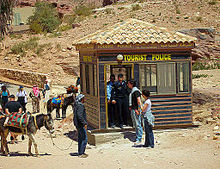
Apart from areas near the Iraqi and Syrian border, Jordan is a safe country.
For information and updates on COVID-19, see Visit Jordan and the Ministry of Health [ dead link ] .
Emergency numbers
911 is Jordan’s centralised emergency (police, paramedics, firefighting) line.
Authorities
Compared to other countries in the Middle East, Jordanian police is well-trained, effective, and professional.
Foreign women may often attract the attention of Jordanian men. For the most part, they are simply curious about you, and hopefully nothing will go further than that.
You should be careful when making direct eye contact with and being overly cheerful in front of Jordanian men as those things could get them to think that you are "interested" in them.
Don't be afraid to create a scene and don't feel the need to be polite if a Jordanian man makes unwanted advances towards you; nobody should tolerate or put up with that kind of behaviour.
Jordan is a Muslim nation, so western norms, such as public displays of affection, may not be accepted even by Jordan's western-educated elite. Jordan is not a place where homosexuality is taken as lightly as in the West, although it is not illegal as is the case in most other Arab nations. Though, the LGBT scene, especially in Amman, prefers the don't ask, don't tell approach to this topic. Adultery, including consensual sex between unmarried couples, is illegal and can be punished by a maximum 3-year jail term. However, this does in general not concern western couples, but will only be a problem when engaging with local people.
Stay healthy
Hospitals in Jordan, especially Amman, are abundant, Jordan's health care system is advanced and the country takes great pride in being a hub for medical tourism.
The biggest risk to your health in Jordan is being involved in a road traffic accident.
Take caution with buying food from vendors; the vendors aren't trying to hurt you but the food might be unclean.
Dogs can be a problem in remote areas of Jordan, although they are far less numerous than in many other parts of Asia. If they get too close to you, (pretend to) pick up a stone. They will remember this gesture from the last painful experience. Carrying a large stick might also help.
Tap water is said to be potable, at least in some areas, but most people drink bottled water, which is the safest choice for visitors.
Jordan is a majority-Muslim country with a large Christian minority. It is one of the most liberal nations in the region and very hospitable to tourists, and locals will be happy to help you if asked.
Women may wear regular clothing without harassment in any part of Jordan. Western fashions are popular among young Jordanian women. However, modest clothing should be worn in religious and old historical sites.
Things to avoid
Jordanians understand that visitors are usually not aware of Jordanian culture and customs, and will be tolerant of most cultural blunders. However, some blunders will be met with universal disapproval.
- The Jordanian royal family is highly popular and enjoys strong support. They are protected by lese-majesté laws; therefore, it is illegal to publicly criticise, shame, or insult them. This being said, the monarchy has a rather forgiving approach to those convicted of lese-majesté.
- Avoid discussing Israel. Like their counterparts in the Arab world, many Jordanians express feelings of hatred, anger, and bitterness towards Israel. Jordan has a large Palestinian population, many of whom are refugees.
Although Islam is the dominant religion, Jordan is, to a large and significant extent, tolerant of other faiths. You won't offend a Jordanian by discussing religion; it's a popular conversational topic. You should, however, bear the following in mind during your stay:
- During Ramadan, you should avoid smoking, drinking, eating, or chewing in public.
- Try not to discuss religion from an agnostic or atheistic point of view; even highly educated Jordanians may be puzzled by the suggestion that you might not believe in God.
- Religious conversion is highly controversial in Jordan. Jordanian Muslims who have converted to other faiths are ostracised by society.
During Ramadan, and particularly on the Eid al-Fitr holiday, schedules will change. Many restaurants, particularly those outside Amman, are closed during the daylight hours of Ramadan, only opening at sunset. This does not affect major restaurants near tourist destinations, however. Also, during Eid al-Fitr it is impossible to get a servees (minibus) in the late afternoon or evening in many parts of the country. Plan in advance if you are taking a servees to an outlying area; you may need to get a taxi back. However, JETT and Trust International Transport usually add more buses to their schedules during this time period, especially those going from Amman to Aqaba.
Public holidays
Some holidays are based on the Gregorian calendar:
Religious holidays are based on the Islamic calendar, which has 11 days fewer than the Gregorian one. Therefore, they fall on different Gregorian dates every year. The important holidays are:
Standing in queues
Jordanians have a notable issue with standing in queues for service. Often those near the rear of a queue will try to sidle forwards and pass those in front of them. Rather than objecting to this tactic, the people being passed will often employ this same trick themselves on those in front of them. The end result is often a raucous crowd jostling for service at the kiosk in question.
No one, including the person manning the kiosk, is happy when this situation develops, and often tensions in the jostling crowd seem high enough that violent disagreements feel moments away. However, there is no violence and the sense is that Jordanians recognise common distinct limits as to what was reasonable jostling.
Nonetheless, due to this common Jordanian phenomenon, several strategies are suggested:
- Arrive early, allow for time, and be patient. Since a degenerate queue is rarely an efficient, allow in your travel plans for the fact that it will invariably take longer than expected to deal with any service booth arrangements, whether that means customs, buying tickets, waiting to get on a bus, etc.
- Don't get upset about the queue or get caught up in the emotions of the crowd. You will keep moving forward, even if a few people sneak in front of you. No one in the crowd is entirely unreasonable, and you will not keep getting pushed back indefinitely. Often, at most, you will end up being served at the kiosk three or four turns later than expected. Just try to relax and take it in stride.
- Avoid the queue entirely when possible. Often, kiosks handle groups in bursts, such as a customs kiosk that deals with a busload of people at a time. In these cases, if you do not start already at the front of the line, find a comfortable spot away from the crowd, and wait for the rest of the group to make their fractious way through before you. Then, make your way up to the kiosk once it's clear. The advantage of being last is that often the kiosk attendant will appreciate your patience and be happy to deal with you now that they do not have a clamoring crowd jostling for their attention.
Most embassies can be found in Amman (see article ).
Electricity
The electricity supply in Jordan is 230 V/50 Hz. But several types of plugs and outlets are in common use, i.e., European with round pins, British standard, Indian and combination outlets that can take multiple types.
WiFi is commonly available in restaurants, cafés, hostels and hotels.
Most of Jordan has mobile coverage. There are three mobile operators:
- Zain [ dead link ] - the largest mobile provider
- Umniah [ dead link ]
Card-based temporary numbers can be purchased at the airport or any mobile shop for 5 JD. These numbers can be subsequently recharged with a prepaid card starting at only 1 JD. Temporary "throw away" phones can be bought at many mobile phone shops across the country for around 20-30 JD, but a Jordanian must buy the phone before possession can be transferred to you.
When buying prepaid cards in Jordan, foreign travelers may be required to provide a passport, even for prepaid cards. This is in contrast to the practice in Europe.
Due to geographical features near the Dead Sea, there is a possibility that Jordanian SIM cards might attempt to connect to cell networks in The Palestinian Territories. To avoid unintended roaming, which is usually disabled on prepaid cards by default, it is advisable to explicitly select the network of the operator from which the SIM card was purchased, instead of relying on the "Automatically select network" option in your phone settings.
There are border crossings to Israel , the West Bank , Saudi Arabia , Iraq and Syria , but most travellers will want to keep well clear of the latter two for reasons of safety. There are also ferries from Aqaba to several locations in Egypt 's Sinai Peninsula; see Aqaba#Egypt for additional information.
- Has custom banner
- Has mapframe
- Has map markers
- Articles with dead external links
- Has caution box
- Has caution box with out of date warning
- Has Geo parameter
- Middle East
- All destination articles
- Usable countries
- Usable articles
- Country articles
- Pages using the Kartographer extension
Navigation menu
- Skip to primary navigation
- Skip to main content
- Skip to primary sidebar
- Skip to footer
LOVE STORIES? I share behind the scenes travel mishaps and adventures on the road. Subscribe

Helene in Between
Lifestyle and Travel blog helping Bloggers Succeed Online.
Perfect Jordan Itinerary and Travel Guide
By Helene Sula
Jordan, with its spectacular desert scenery, fascinating archeological sites, delectable cuisine, and fair weather, is one of the best places to explore in the Middle East .
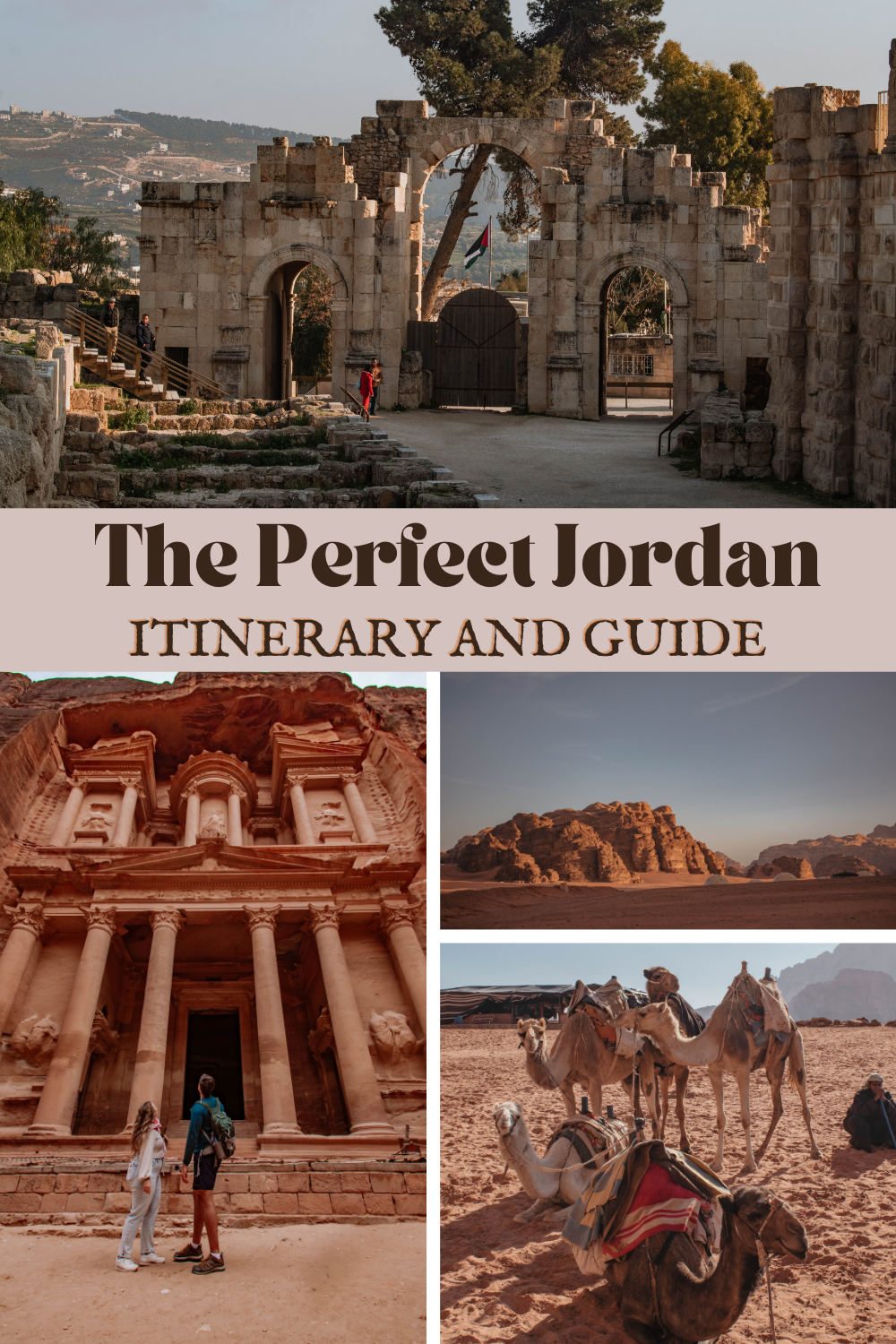
Whether you have a week or 10 days, I've got a full itinerary and travel guide for your time in Jordan. It's one of those places you definitely need more than 3 days to explore.
I went to Jordan without expectations. I left feeling like I absolutely must come back. Incredibly generous, kind people, delicious food, and overwhelming beauty and history. Jordan is a country that will surprise and delight you. This guide will help you make the most of your visit.
Jordan Itinerary at A Glance
What to expect, taking a tour, when to visit jordan, how long to stay in jordan, jordan itinerary, day 1 – amman, day 2 – amman and jerash, day 3 – wadi rum, day 4 – petra, day 5- petra – kerak castle – wadi mujib – dead sea, so, why is it called the dead sea, top tips for the dead sea, day 6 – dead sea & religious sites, day 7 – dead sea & amman, if you have more time….
Day 1- Amman
Day 5 – Petra – Kerak Castle – Wadi Mujib – Dead Sea
Day 6 – Dead Sea & Baptism Sites
Jordan is one of the most welcoming and hospitable countries in the world. People are incredibly open and kind, always willing to talk or help you with directions or advice. The food with a variety of dishes is delicious, there are epic places to discover and the religious and historical sites are mesmerizing.

Jordan is a Muslim country but you are perfectly fine to not cover your hair as a woman. Some women do, but many don't and you'll find a variety of clothing and styles. You don't need to cover up, but it is important to dress modestly. Avoid short dresses or skirts. Dress for the weather. It can get hot during the day and cool at night especially in the desert.

You will hear a call to prayer in most major cities. If you are visiting on a Friday, some traditional markets and shops might be closed during prayer time, as Friday is a holy day in the Muslim religion. Sunday is the start of the work week, having Friday and Saturdays off, as opposed to Saturday and Sunday off in the USA and Europe.
I found Jordan to be be very safe, and as a woman a wonderful place to travel.
I think the absolute best way to see Jordan is with a tour. I recommend Globus which organizes your trip from start to finish. I've been lucky enough to travel many times with Globus but this trip to Jordan was my absolute favorite.
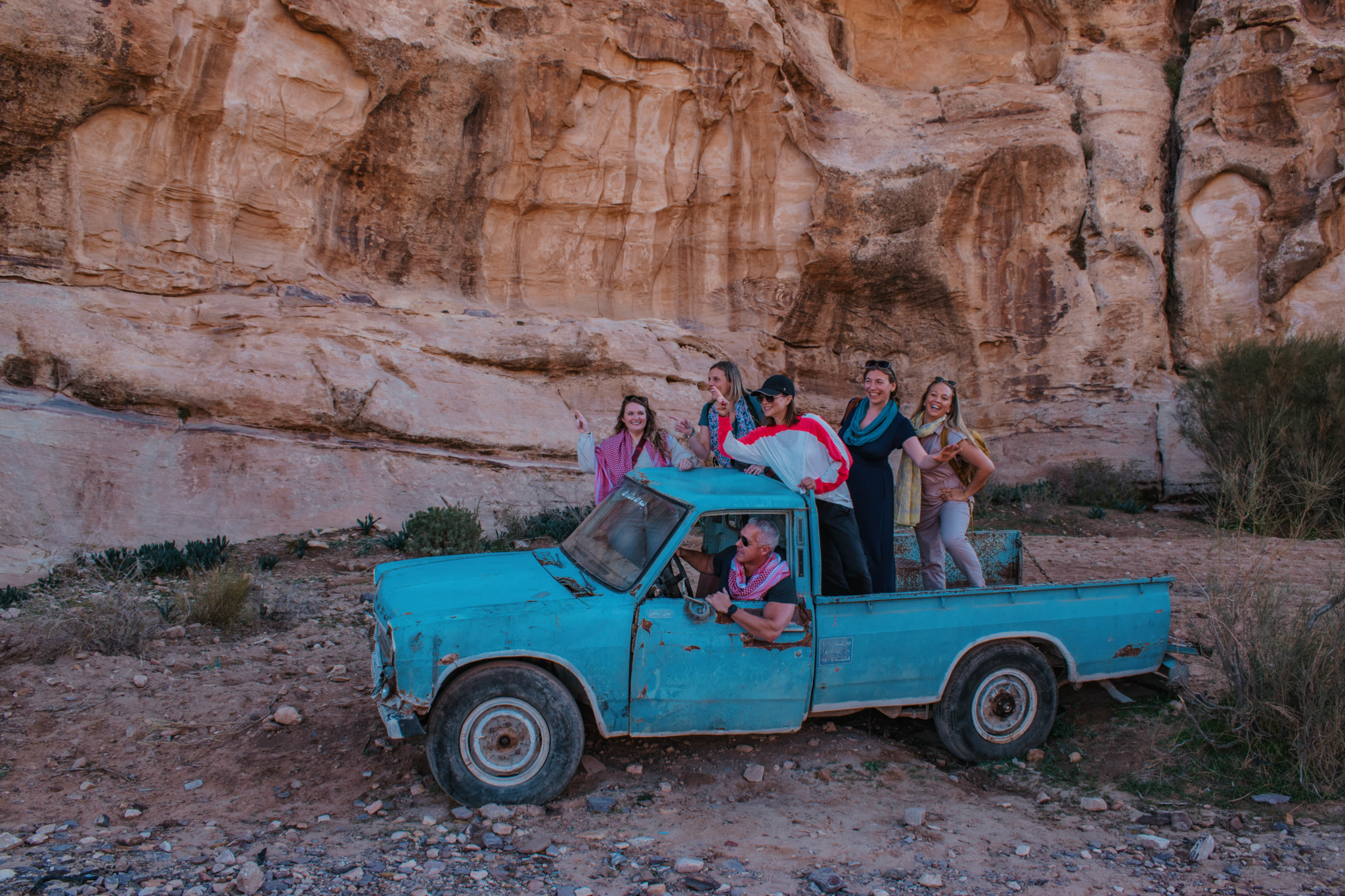
Everything is organized for you from the seamless airport pickup, beautiful hotels, and unique experiences while still remaining affordable travel. The hotels were all absolutely stunning, some even 5 star! The VIP sightseeing was well planned and there was free time to explore on your own.
Globus takes care of all your travel needs. From taking your luggage off the bus and putting it in your room to organizing your required COVID exam the day before you return to the United States.
But the best part of touring with Globus is the incredible guide. Our tour guide, Osama, was with us every step of the way. Not only did he tell us the history of what we saw, he told us fun facts, and we were free to ask questions about the traditions and customs of Jordanians.
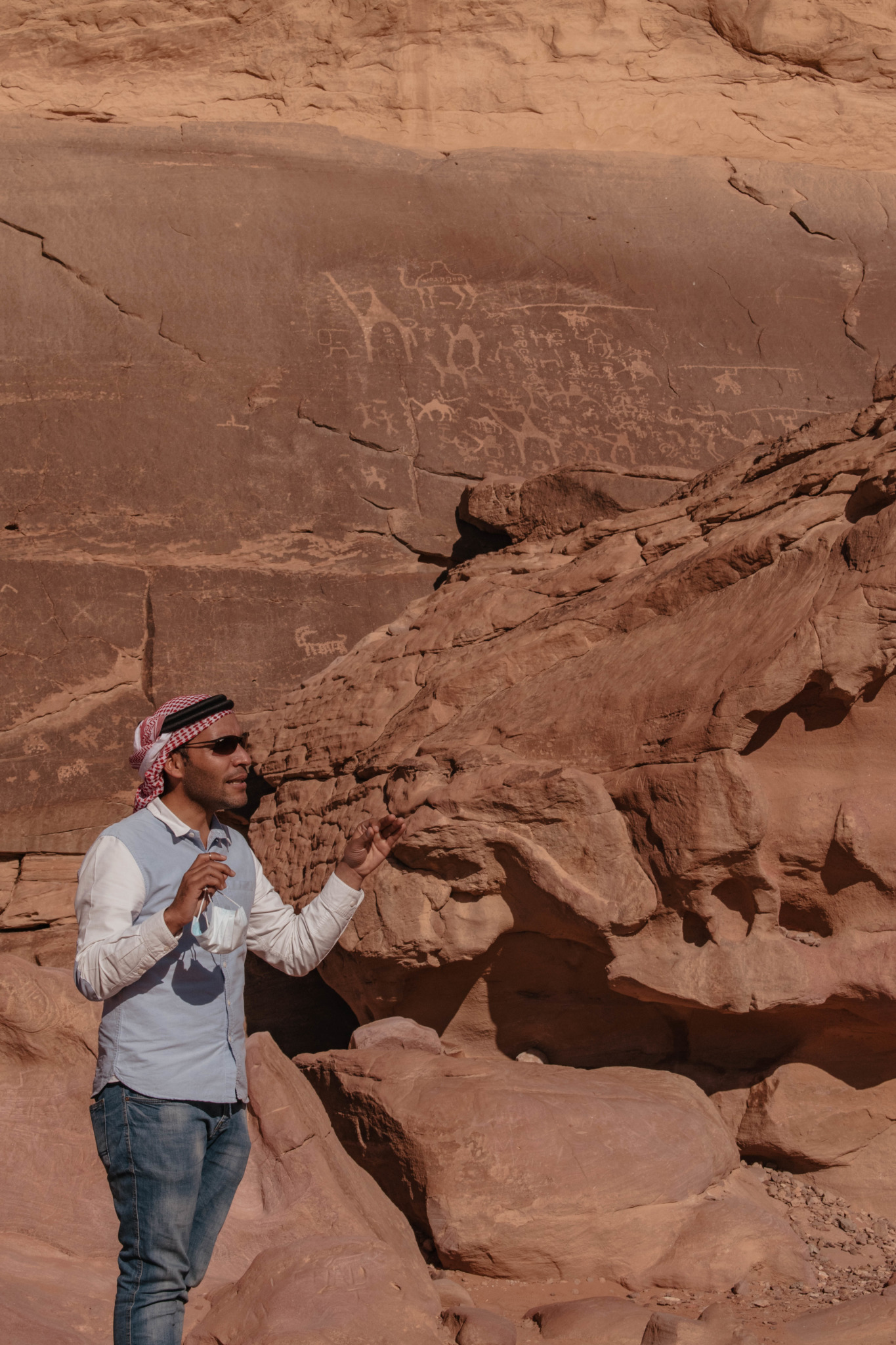
Globus Escapes is such a unique and wonderful concept. Tours are competitively priced and during off season. You save money and miss the crowds. This is truly the best way to experience Jordan.
February through May, early to mid spring, is typically best for visiting Jordan. You'll have nice temperatures. It's not too hot but can get chilly at night and windy near the Dead Sea. This is also great for hiking Petra or the Wadi Rum desert.
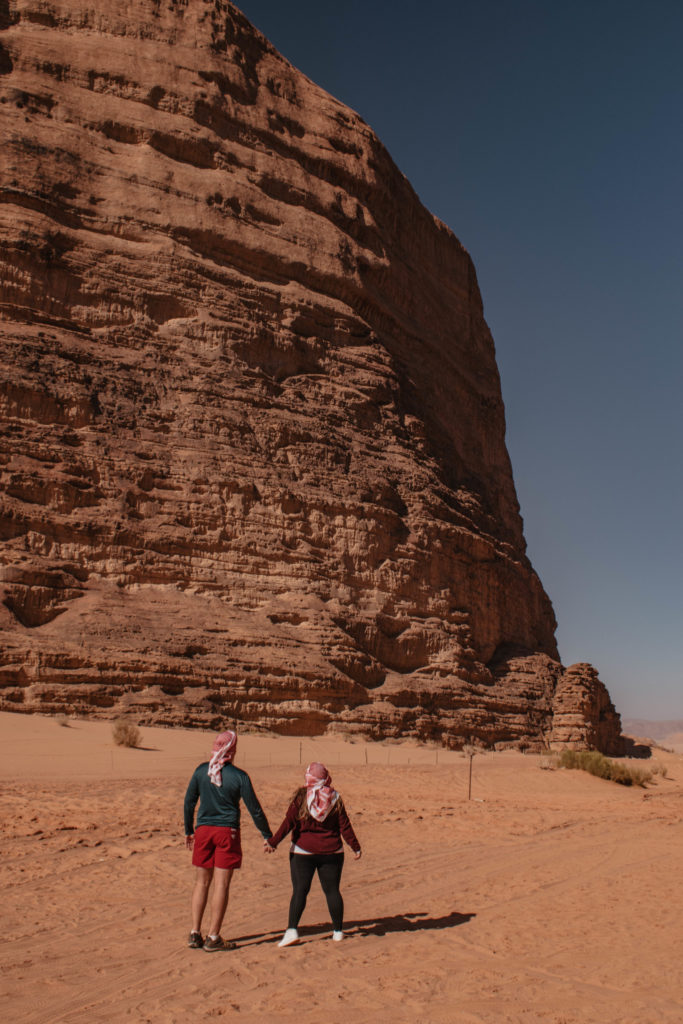
I suggest avoiding summer as it can get quite hot. September through early November is also good as well since it's not quite as hot.
I think seven days is the perfect amount to get a good feel for Jordan. You'll get to experience the major attractions including Petra, Wadi Rum and Amman. Plus you'll have time to relax, shop and take tours too.
We flew into the Queen Alia International Airport and Globus arranged a pick up. But this was not your average pickup! You'll be taken directly from your gate and through customs in a seamless and easy way. This service makes your travel stress-free and easy. We then took the car service directly to the hotel.
Amman, Jordan's capital, is a great place to start your trip. The city is spread out and has a lot to offer, from Roman ruins to great restaurants. The city is very walkable so I recommend for your first day to walk around town and have a bite to eat.
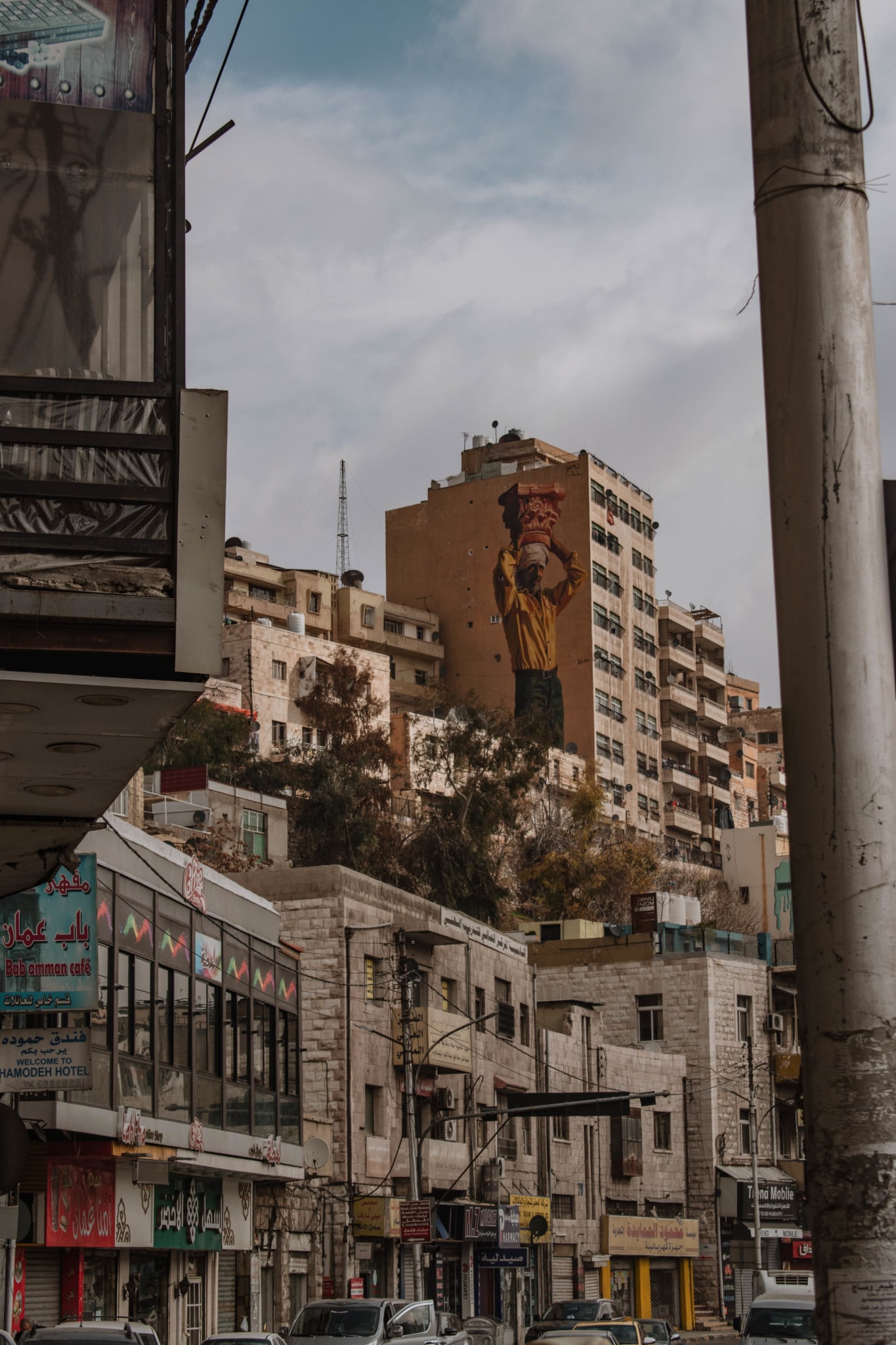
This is the largest city in Jordan with 4.5 million people and over half a million that drive in to work every day. It's known as the City of Seven Hills because of its history of Roman rule.
I was surprised to find a great mix of modern architecture mixed in with antiquity. You'll see street art, hip cafes, book shops, and local restaurants perfuming the air with delicious treats.
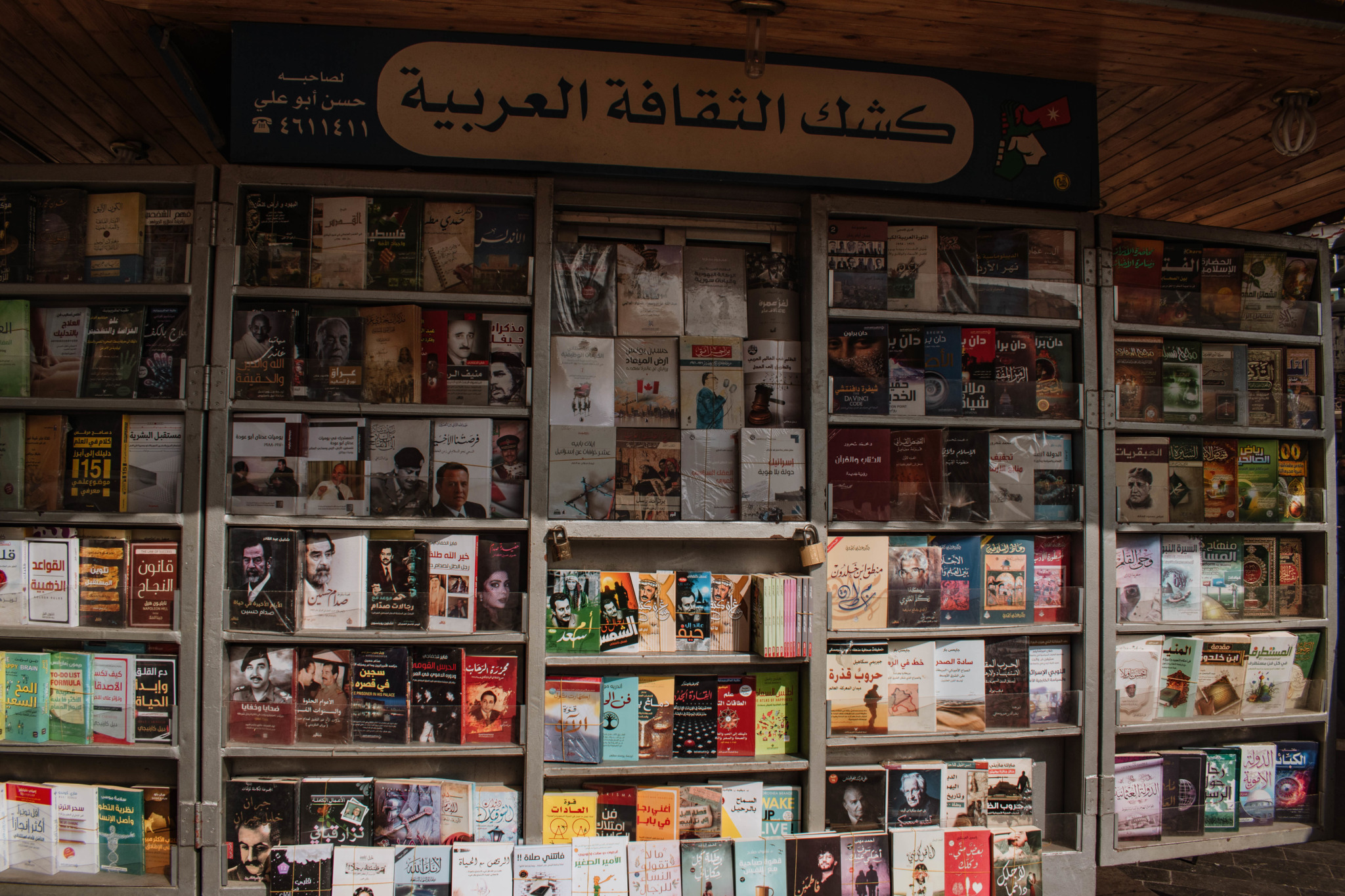
Rainbow Street is a great place to walk around, stop in a restaurant and get your bearings. Check out the Royal Automobile Museum to see one of the best collections of beautiful antique cars from King Hussein. Or, check out King Abdullah's Mosque .
Where to stay in Amman : Globus arranged for us to stay at Kempinski Hotel – a perfect spot to explore the city! This was a modern, lovely hotel with an included buffet breakfast and dinner with your Globus tour.
Make your way to the historic site of the Amman Citadel , which is in the heart of town. The city's original name, Rabbath-Ammon, means “capital of Ammon” and was coined by the Romans after they built the citadel, which is one of the world's oldest inhabited settlements.
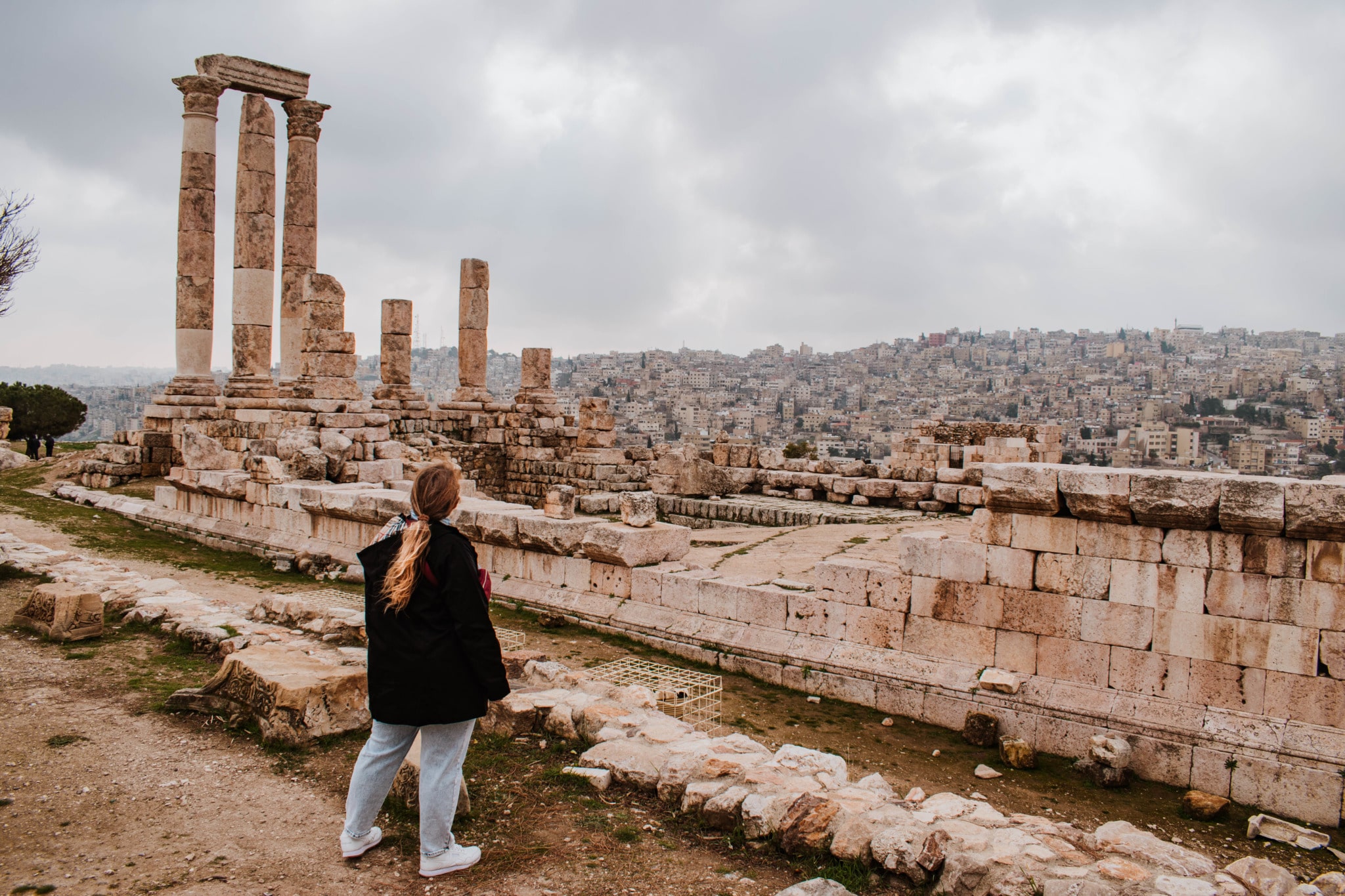
The city's name was then changed by the Greeks to “Philadelphia” which means city of brotherly love and then, finally Amman.
You'll walk through the ancient gate that once led to the city and find the Temple Of Hercules. Built during Marcus Aurelius' seat as emperor, this temple has stood the test of time, despite earthquakes.
Leave some time to take in the museum inside the citadel, Jordan Archaeological Museum, filled with artifacts and information about the city, the ruins, and its people. Walk around the ruins and look down below at the sprawling city of Amman. You can see the Roman Forum below. You'll also find a huge, marble remnant of a hand of Hercules and it's speculated this was one of the largest marble statues known to man.

Next, our guide took use to Wasat Al-Balad in Downtown Amman . You'll find lots of shops selling fresh fruits and vegetables, clothing, and cafes. Make a stop at Habibah Sweets for traditional “ Kunafeh ” a dessert of fried goat cheese topped with dough and honey.

Then, it was time to head to Jerash , one of the best preserved Roman ruins outside of Rome!
Jerash is about an hour north of Amman and on our way we stopped off in the small village of Souf for a homemade traditional lunch at Beit Khairat Souf . There were piles of lamb kebab, steaming pots of tea, plates of hummus, and salads of every kind.
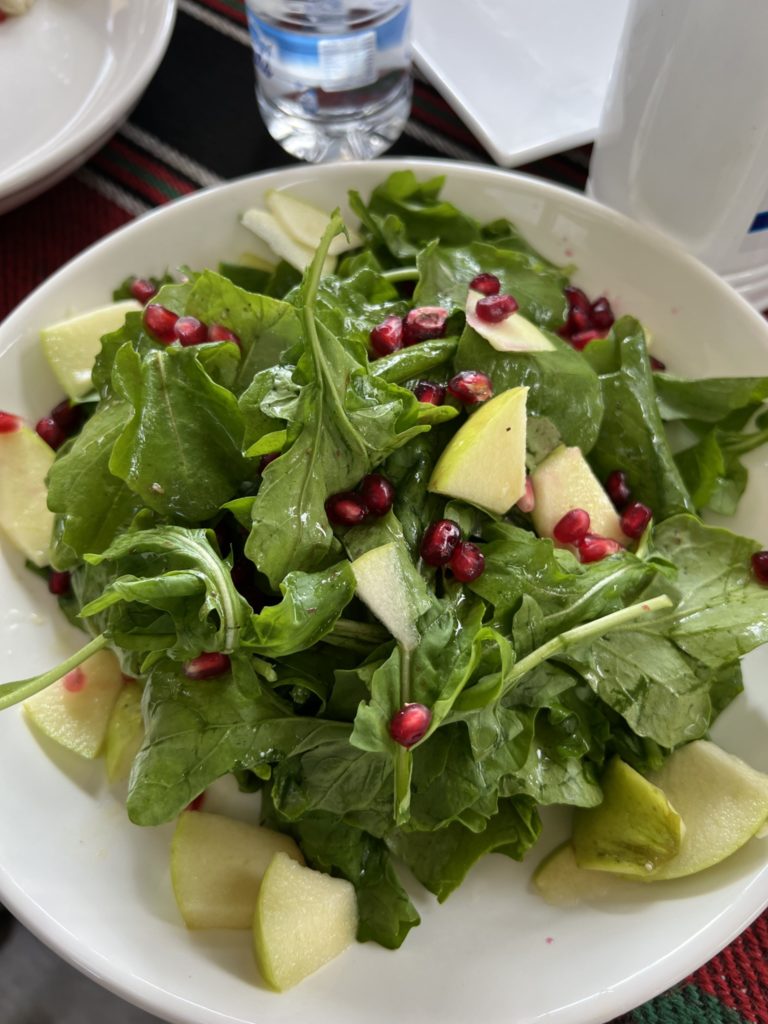
The food was absolutely divine and such a wonderful, unique experience organized by Globus . The restaurant is part of Beit Khairat Souf’s Women’s Community Project created to help women financially support themselves.
Just an hour north of Amman is the ancient city of Jerash. This well-preserved Roman ruin is one of the most impressive I've ever seen! I really enjoyed my time here. With sweeping views and incredible history, this site in Jordan cannot be missed.

What I found most fascinating, besides the nearly intact Jerash theater, hippodrome, temple of Zeus and Artemis, Forum, and Hadrian's Arch, was that much of it is still standing!
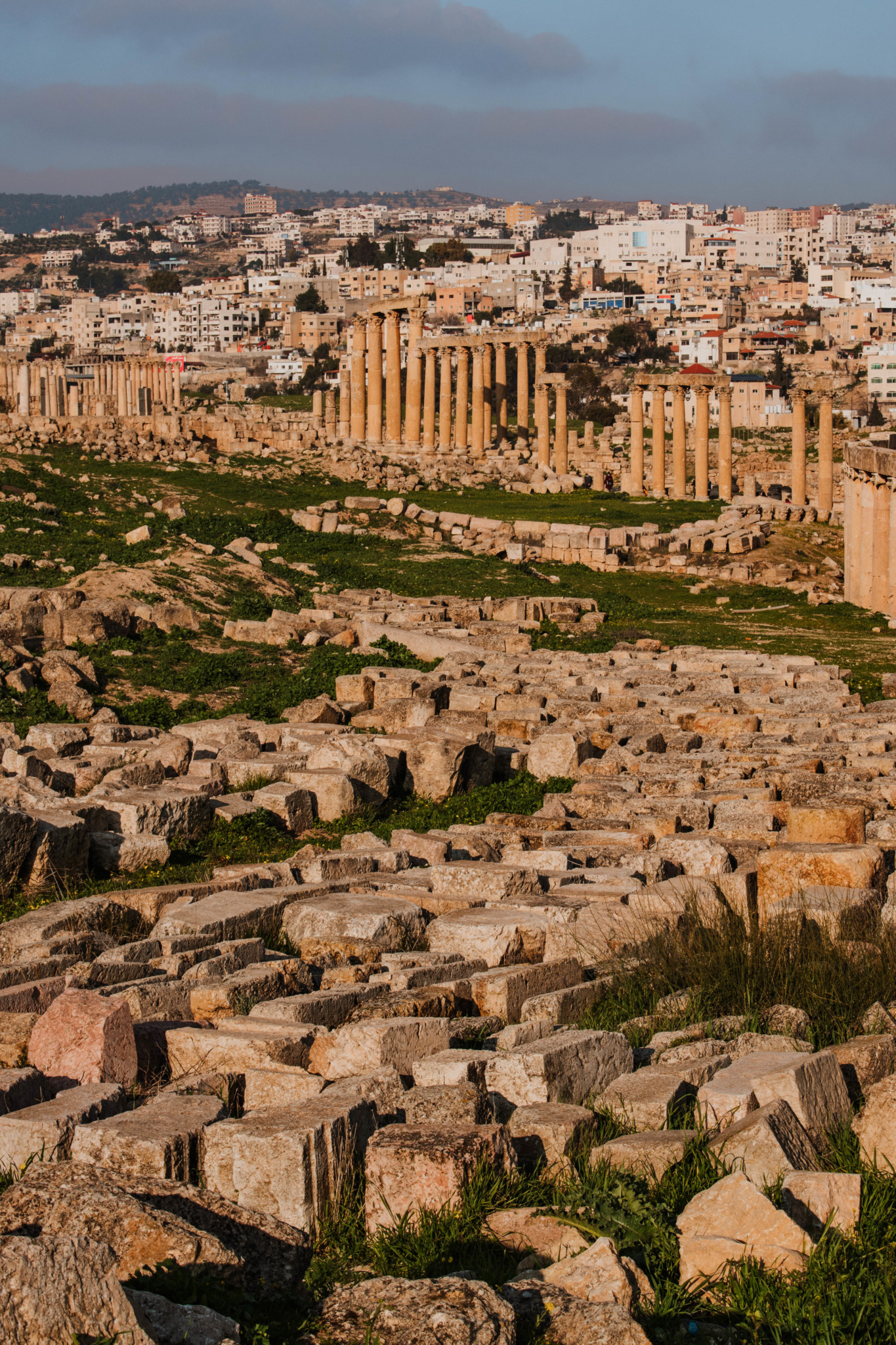
Earthquakes shook and destroyed much of the city, but the in the 2nd century AD Romans learned to add copper or tin between the columns which helped the structures not to fall over.
I definitely recommend a tour here as there's so much history to learn, our tour with Osama through Globus was incredible. We also had time to walk around and listen to the Jordan bagpipe band (not a typo!) in the Jerash theater. They played very familiar classics like Amazing Grace while I was shocked to see them outside of Scotland, I learned that the instrument's original roots are in the Middle East!
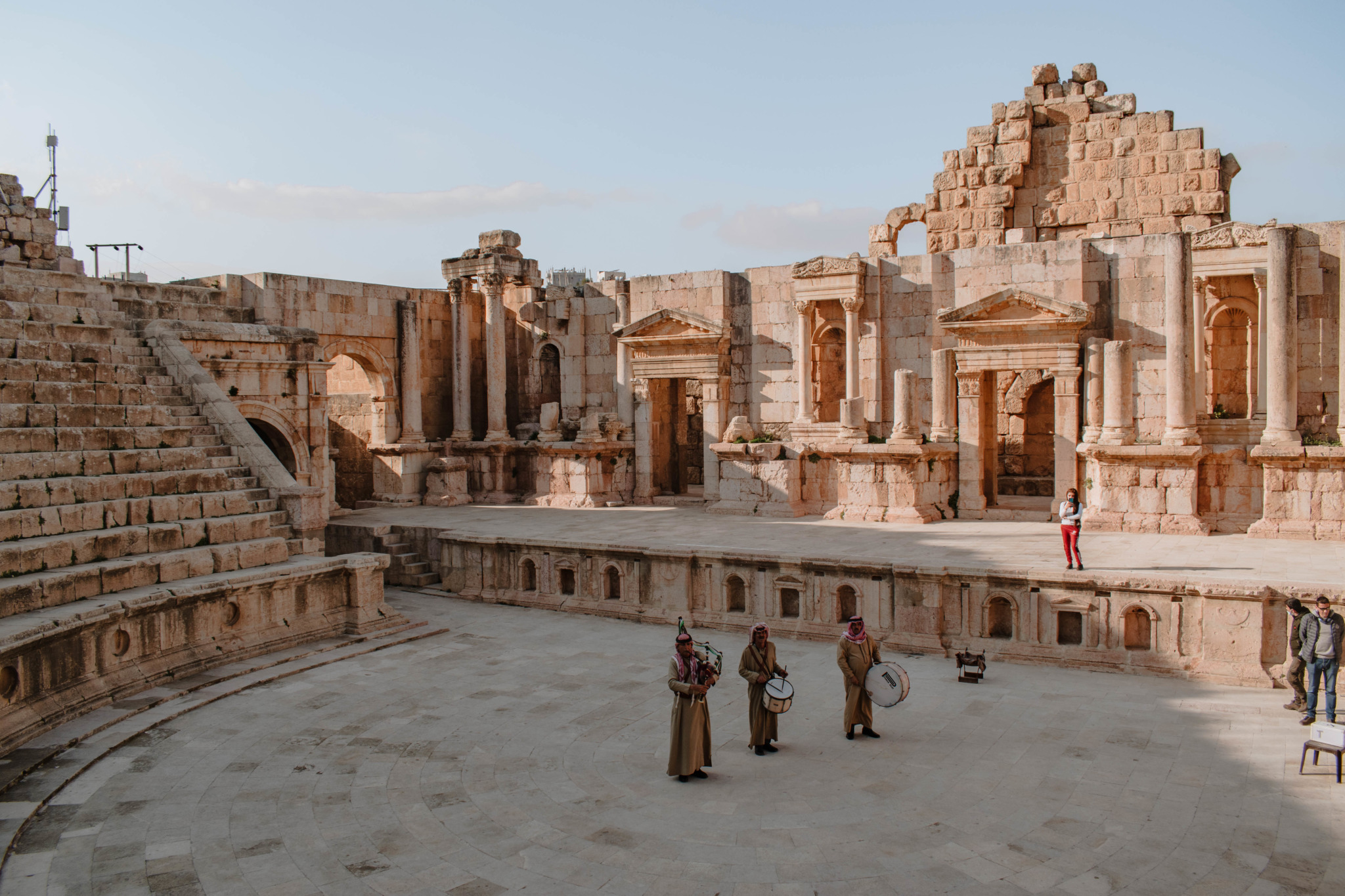
As we walked the grounds Michael stopped to play soccer with some kids. I love how accessible Jerash is, it perfectly mixes ancient ruins with modern day life, helping to picture what the ancient city really felt like.
We headed back to Amman to spend one more night in the Kempinski Hotel. For dinner we had a unique experience with a cooking class at Beit Sitti .

Beit Sitti means “Grandmother’s house” in Arabic, and it really felt like we were at Grandmother's house! Photos of their family hung on the wall and Maria, our instructor was lively and excited, showing us exactly how to cook while regaling us with stories.
I've never cooked traditional Middle Eastern cuisine before, and I learned a great deal, and also made a fabulous meal!
Heading to Wadi Rum feels like going to outer space. And I'm not the only one who thinks so, this also happens to be where they filmed the movie “The Martian” because it looks like the surface of Mars!
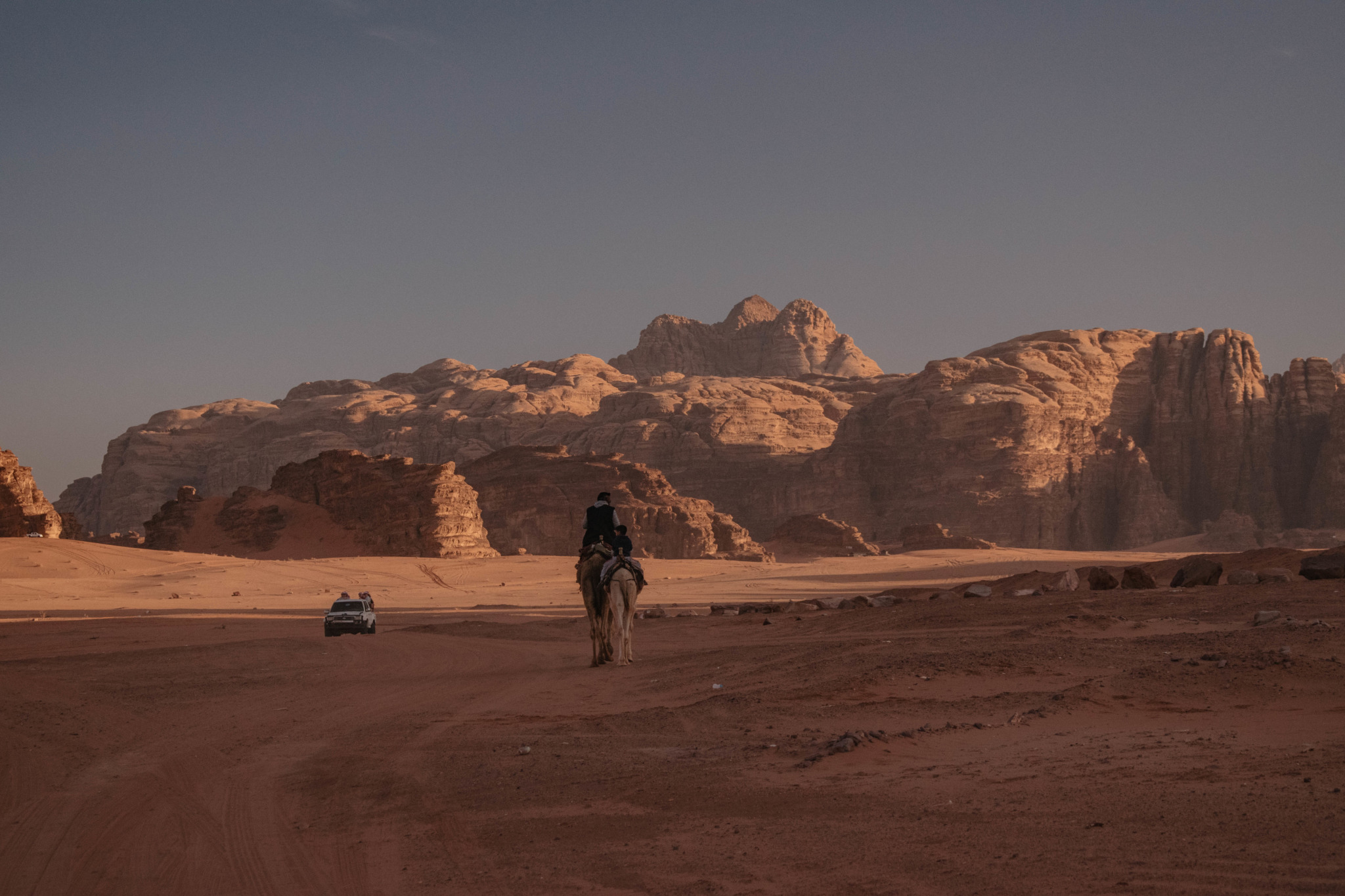
This is a desert valley made up of red sandstone and granite mountains. It's one of Jordan's most popular tourist destinations and was even used as a filming location for other movies like Lawrence of Arabia and Transformers: Revenge of the Fallen.
On our way to the desert Osama helped learn how to tie a “keffiyeh,” a Bedouin scarf.
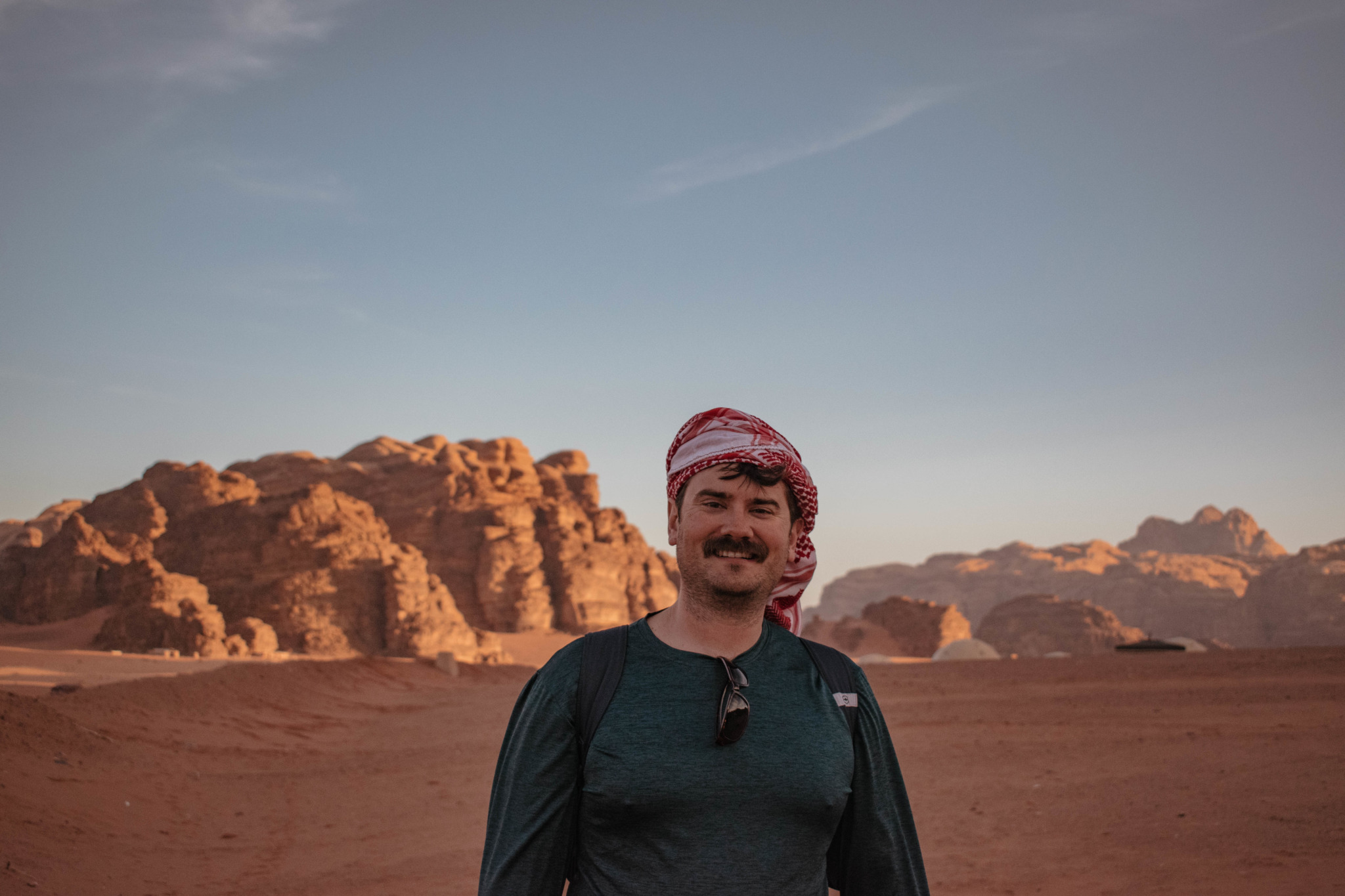
When we arrived we ate a buffet lunch at the Wadi Rum camp (you can spend the night out here if you'd like!) and then headed out for a four-by-four Jeep tour into the desert.
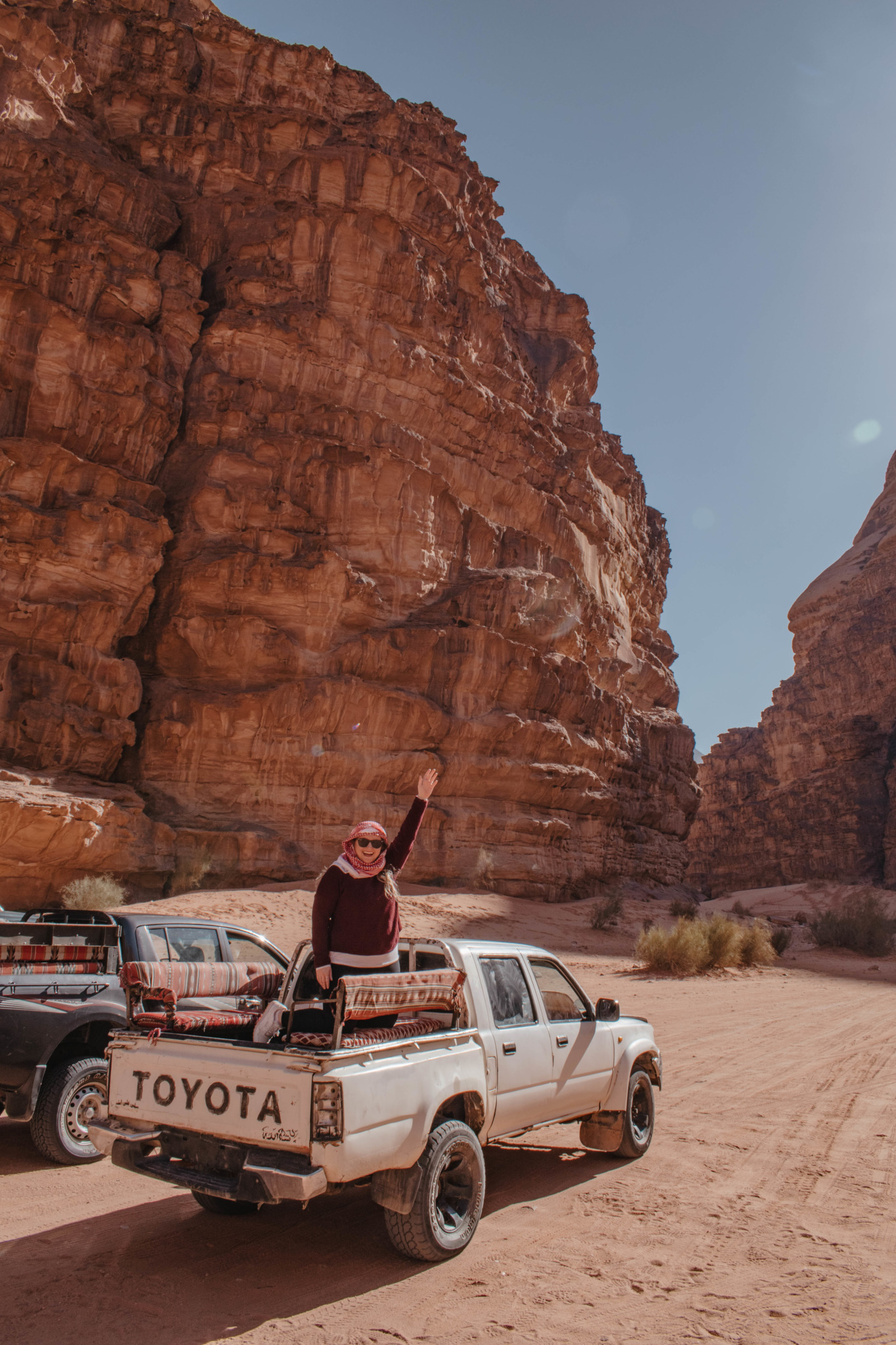
We spent a few hours touring around the incredible landscape, our hair whipping in the wind, as we gazed at the otherworldly landscape. You can tour sights like the red sand dunes, Lawrence’s Spring , the Khazali Canyon , the House of Lawrence , Abu Khashaba Canyon and Um Frouth Arch .
We hopped out of the jeeps and had the option to take a short, 30 minute camel ride to the Bedouin camp. If you've never done one, I recommend it! We did have a “frothing” camel since one of the females was in heat. Michael was the lucky one to ride this camel, and it was quite comical!
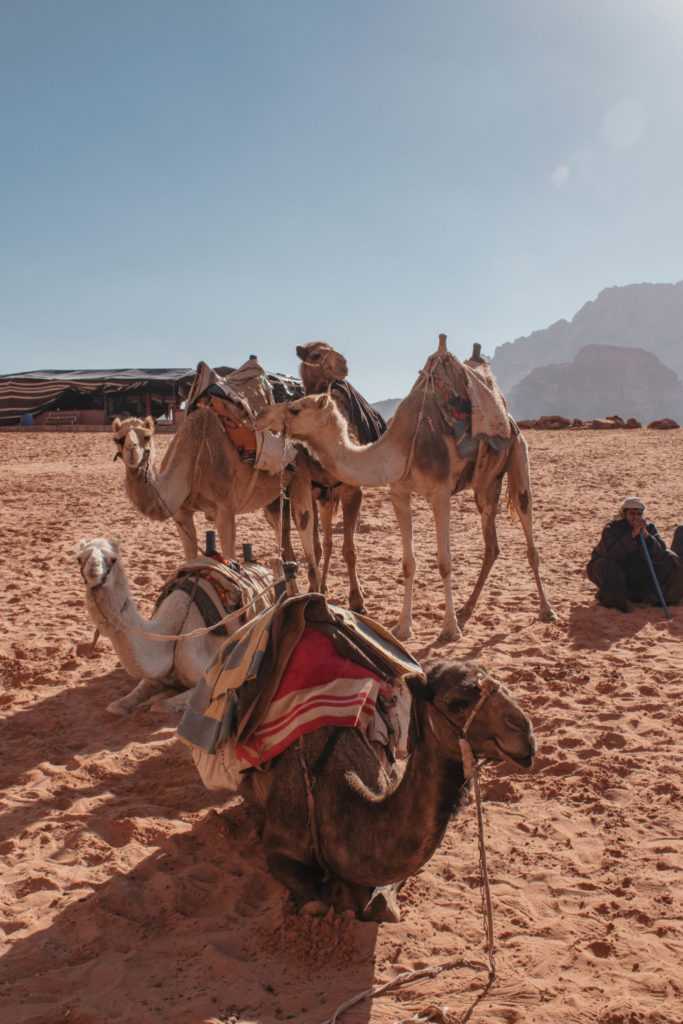
Camels are an integral part of the Bedouin nomadic lifestyle. Bedouin means “roamer” and this incredible part of the Jordan population traverses the landscape.
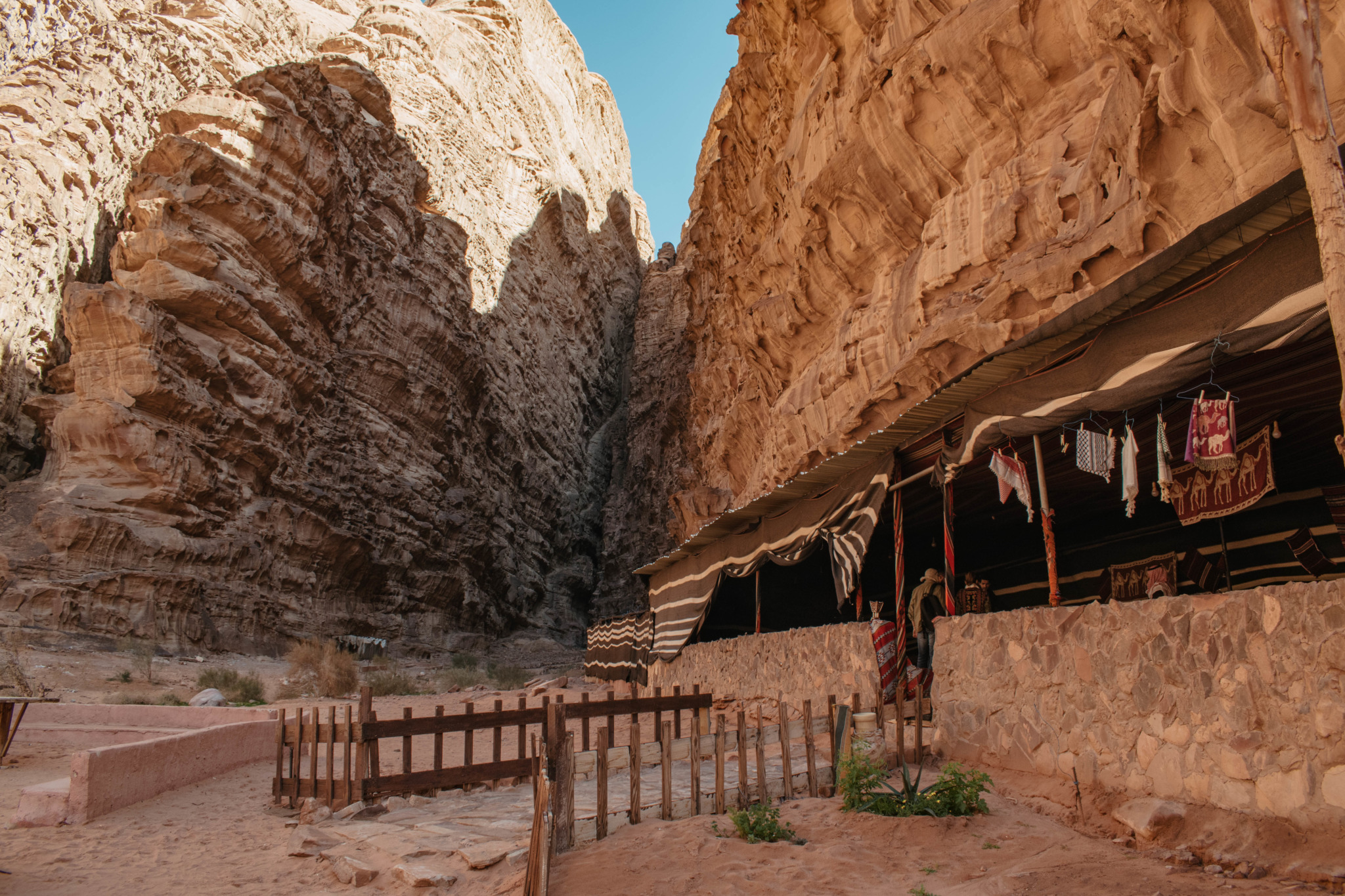
We then headed into a Bedouin tent for traditional tea. It was incredible to see how they live and use the land to sustain themselves. Then a Bedouin family invited us to show how they make bread. It was delicious! We dipped it in oil and spices and savored it among the towering red rocks. Hot and fresh off the fire we tasted the delicious bread and spoke with the family who welcomed us with such kindness.
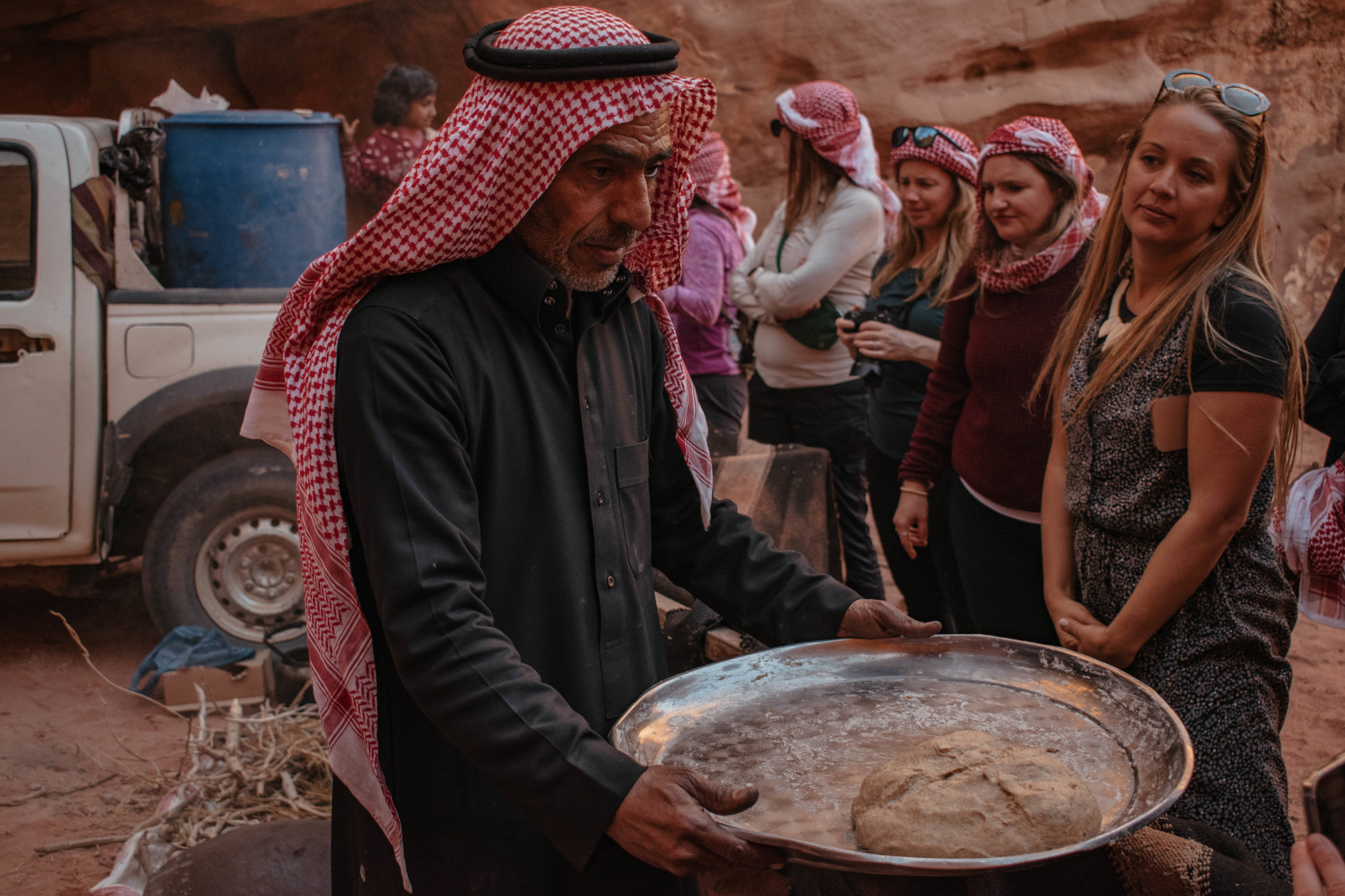
After our long day, we made the drive to Petra so that we could get up early and hike to one of the world's wonders! See my full guide to Petra here !
For dinner, we enjoyed an incredible, home cooked dinner with a Jordanian family in Petra. We started off by drinking coffee, a ritual with lots of meaning. Each guest was handed a small cup of steaming coffee. It's tradition to start with a cup for each guest and customary to have 1-3 cups. If you have more than 3, you're telling the host the coffee is too weak!
Then we were taken to the kitchen for highlight of the evening: mansaf !
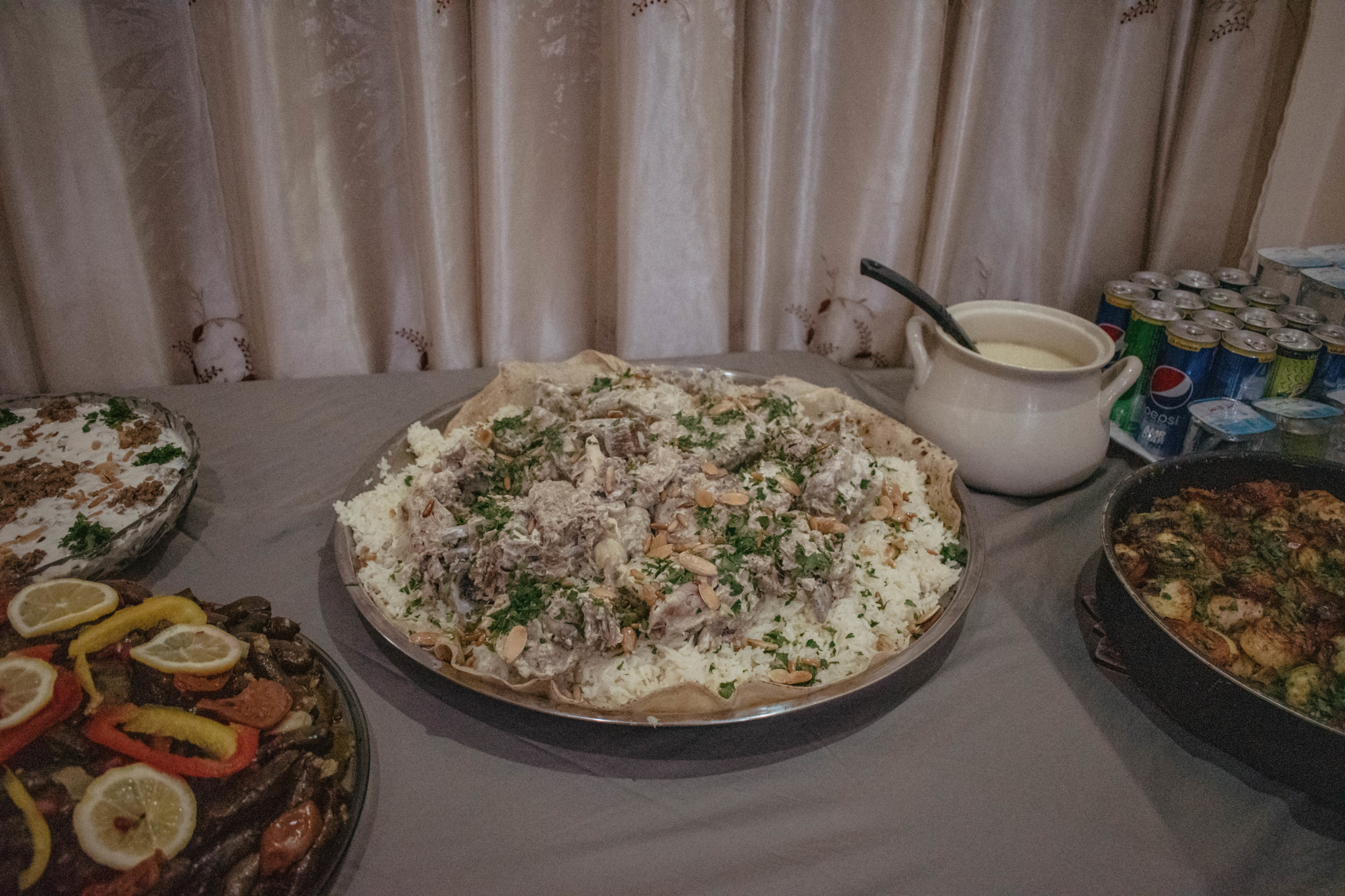
On our plane ride over from the USA we were told we must have this traditional Jordanian dish of mansaf, but ONLY if it was home cooked! We were in luck!

This tender lamb dish was decadent and scrumptious. Jordanians definitely encourage you to eat and drink to your fill! We had such a lovely evening chatting and learning about one another's cultures and traditions.
Where to Stay in Petra : Movenpick Resort Petra . It's a hike to get to Petra and this hotel is quite literally as close as you can get! This 5-star hotel is right by the Petra Visitor Center and Museum and is the perfect place to wake up, beat the crowd and head to the sight.
The buffet breakfast was particularly good and the interior of the hotel feels like a luxurious spa. Marble floors and delicate inlaid fixtures made for a beautiful place to rest.
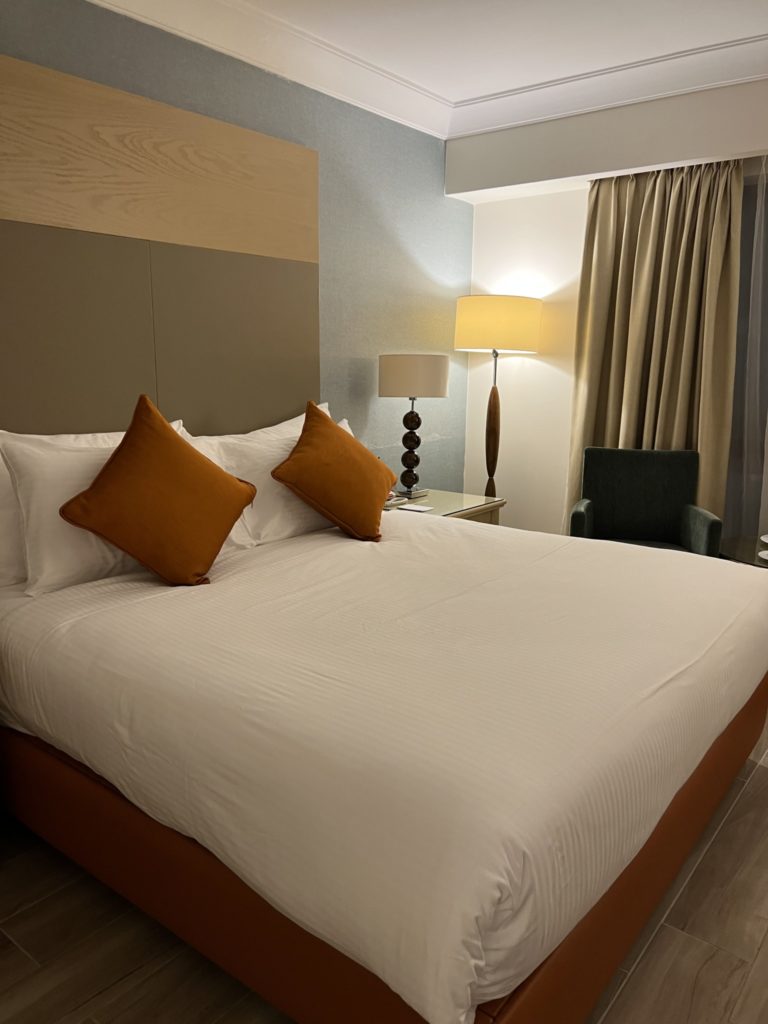
Petra is a magical place and one of the new wonders of the world and UNESCO World Heritage Sites. It has to be seen to be believed! You'll need at least one full day here to enjoy and relish in the history and awe-inspiring architecture.
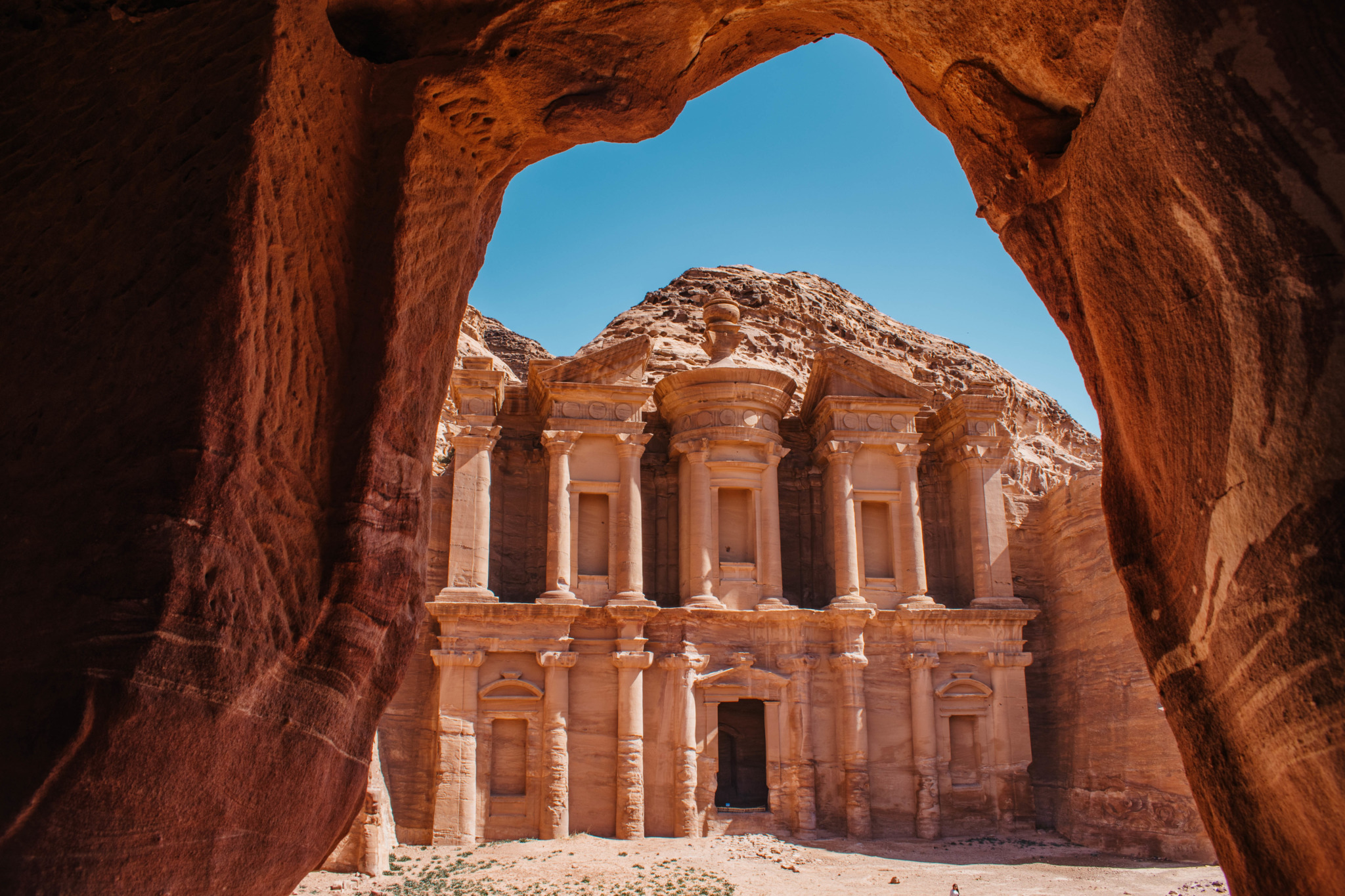
I recommend you wear hiking boots or tennis shoes, lightweight clothing, and don't forget a hat and sunscreen.
See my full guide to Petra Here!
You can enter Petra through the Siq , a narrow crack in the sandstone that's bordered by walls that soar hundreds of feet into the air. As you walk through this enigmatic corridor, you'll be filled with anticipation for what lies ahead.
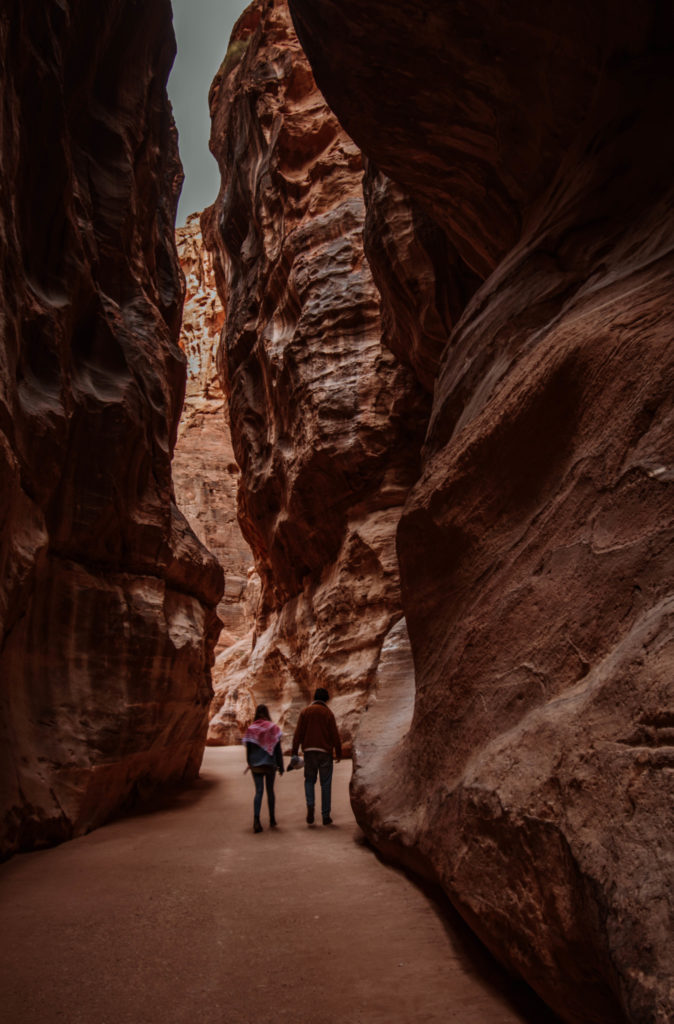
And then suddenly, you emerge into the breathtaking and very famous Treasury . It's no wonder that this is one of the most photographed sites in all of Jordan – it's absolutely stunning!
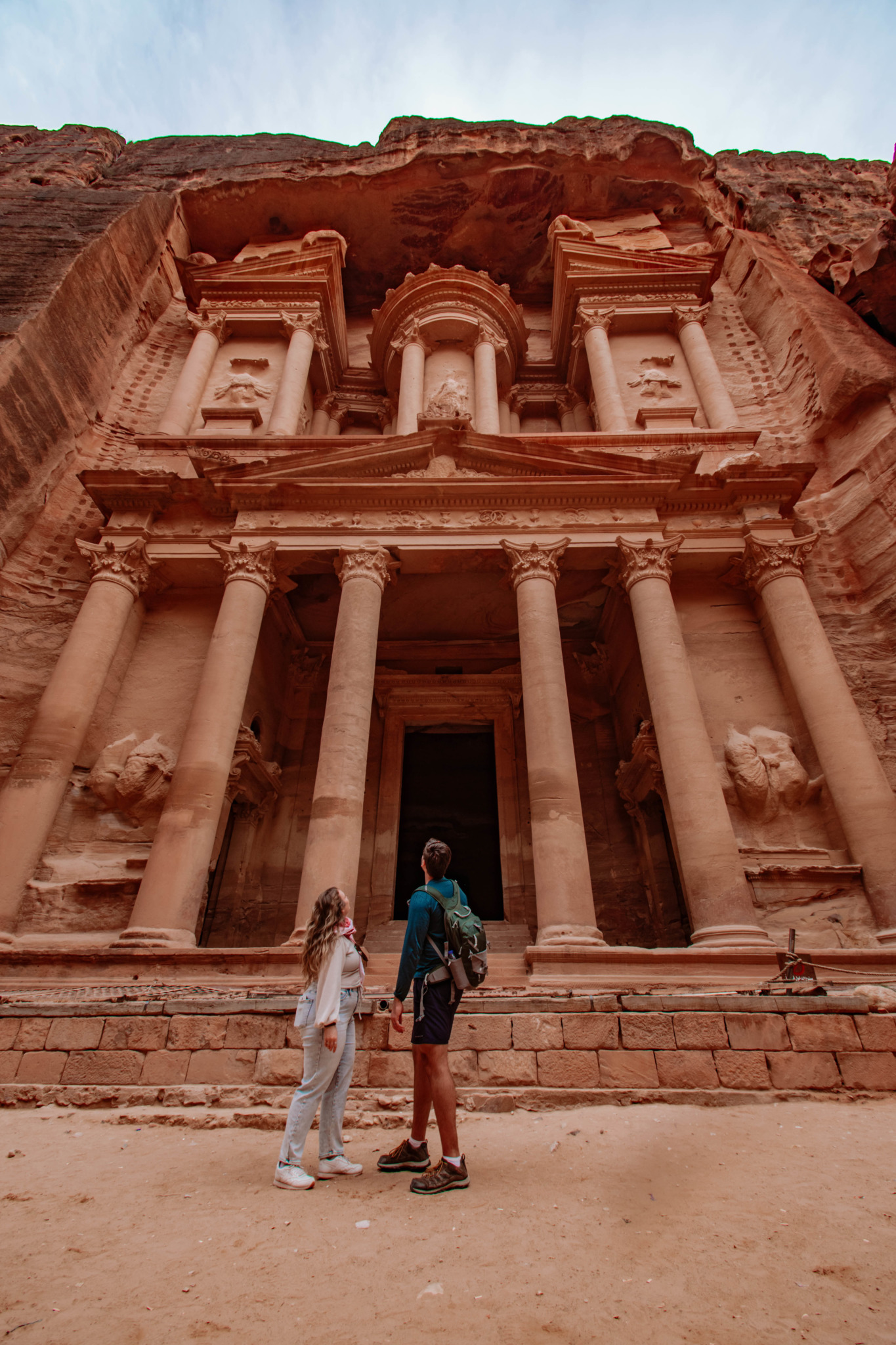
There is also a back entrance, a longer hike of 9 miles but it gives you an incredible view of Petra and the land surrounding it as well as the Monastery with no tourists!
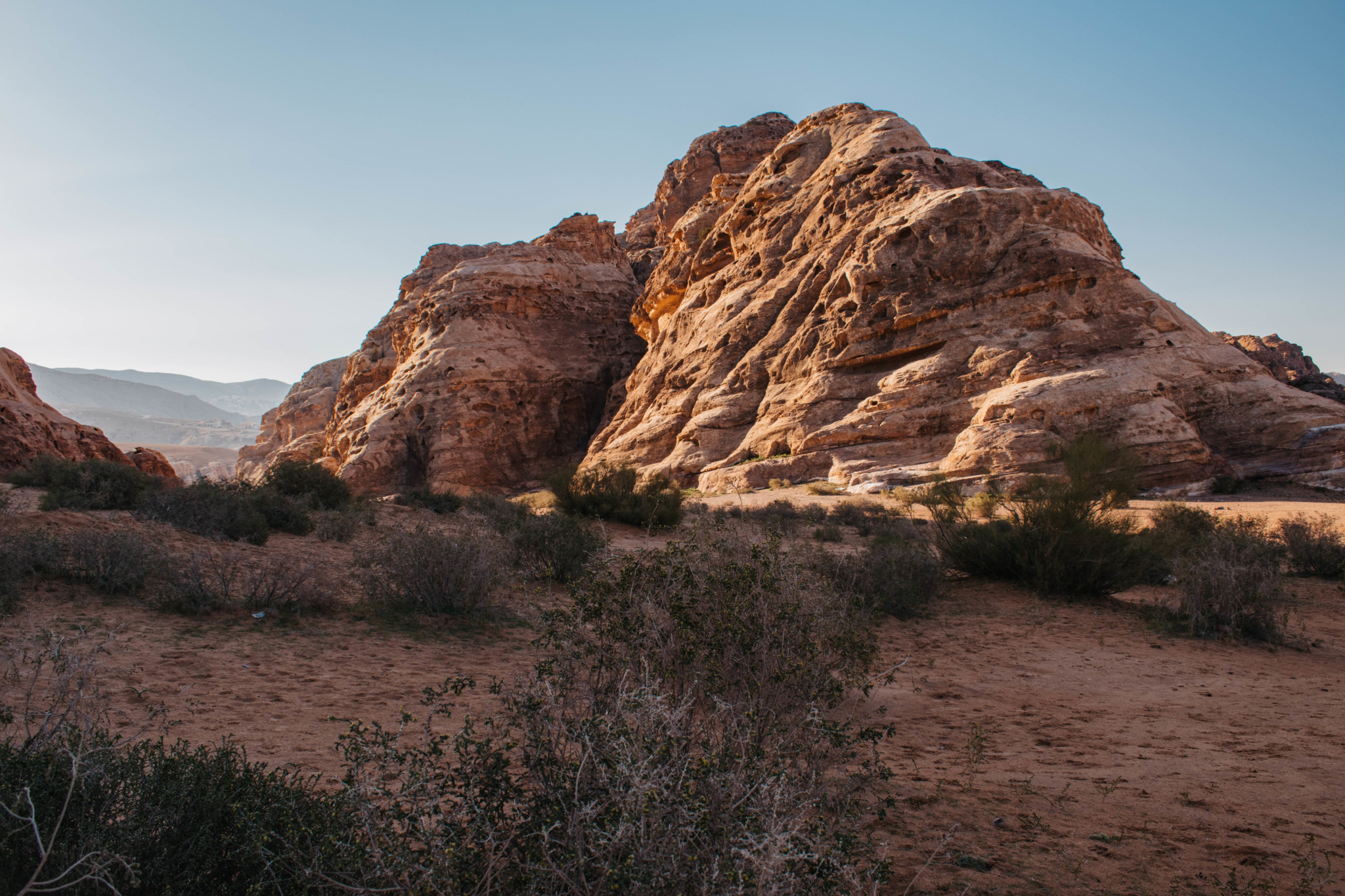
Petra was inhabited by the Nabataeans and later fell under Roman rule during their reign. But they were eventually driven away by an earthquake in 363 AD.
As I explored the incredible ruins of Petra, I was filled with awe and wonder at the remarkable architecture and history of this ancient city. The site is truly one of the world's wonders, as its spectacular stone temples and tombs have been preserved for centuries. Indiana Jones and the Last Crusade was filmed here and it's easy to see why this site was chosen!

PRO TIP: Don't just stop at the Treasury! Yes, it's a hike to keep walking al the way to the Monastery, but it will be well worth it. You'll have far less crowds and absolutely stunning views.
There are plenty of places along the way to grab a bite to eat or drink. And, if you're particularly tired after the miles of hiking, you can take a camel, horse, or donkey ride back. Now, they even have golf carts! It's 1.2km (about .75 mile) long to the Siq, the narrow gorge to the Treasury, but a total of 6 kilometers to the monastery (3 miles) so 12 kilometers (6 miles) round trip.
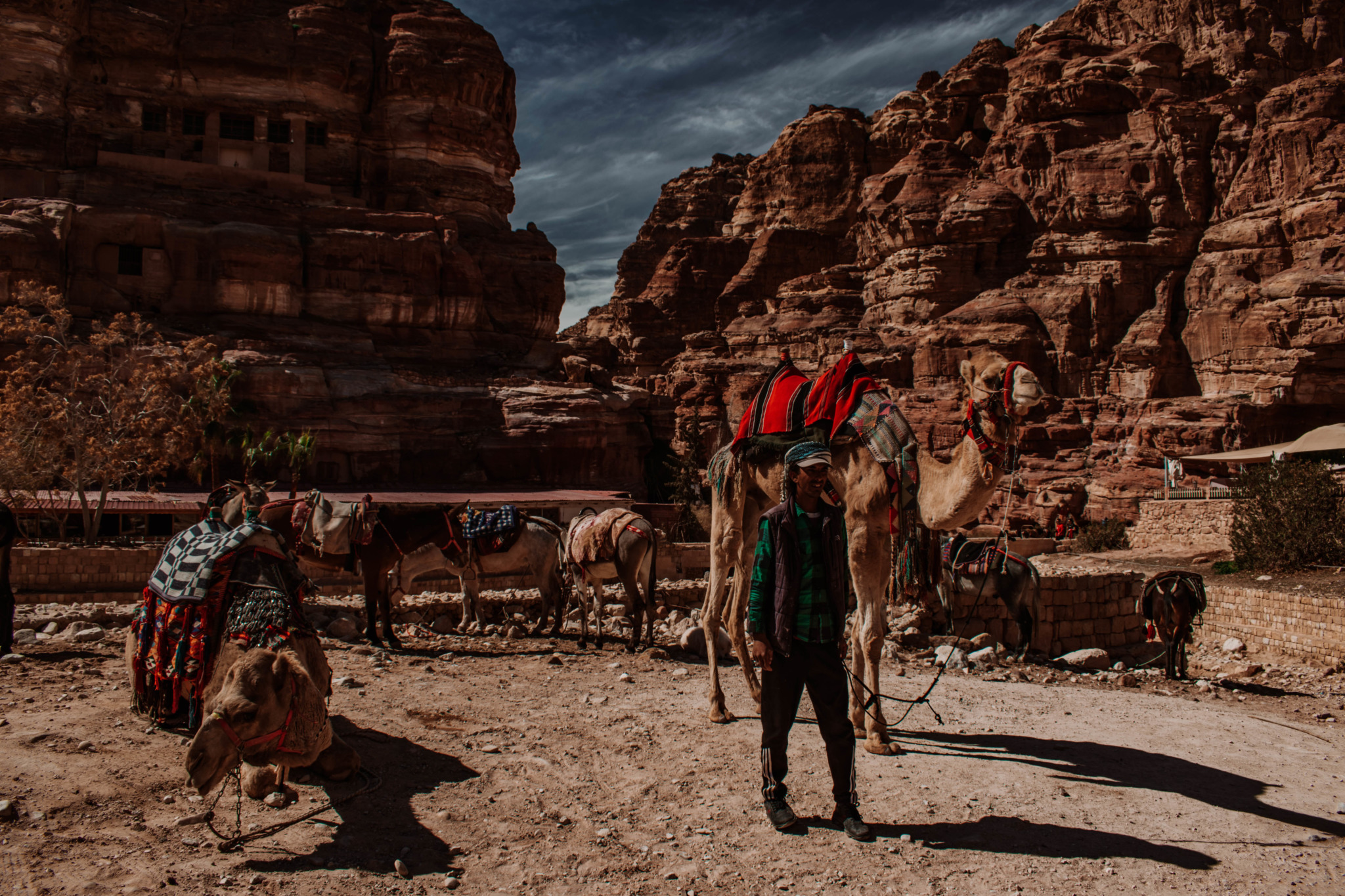
I spent several hours hiking around Petra, marveling at the incredible architecture and history. Save some energy because you must come back at night for “ Petra by Night .”
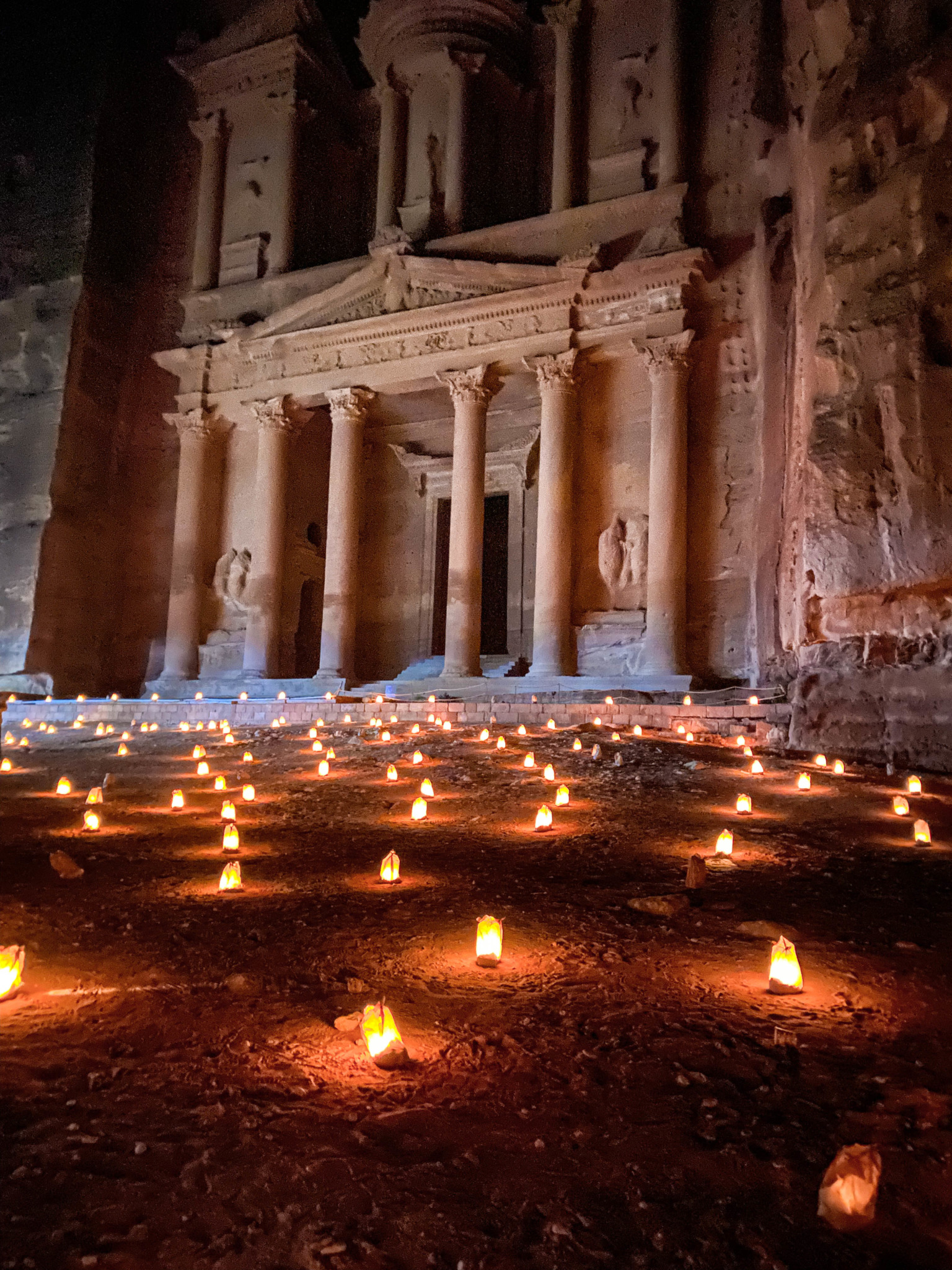
We had a short break in between where we explored the visitor's center and museum, got a bite to eat and rested our feet before an additional hike back in.
White paper bags filled with sand and candles are the only sources of light that warm the red stone walls. As you meander down the narrow gorge the bright stars above you beckon you down to the music.
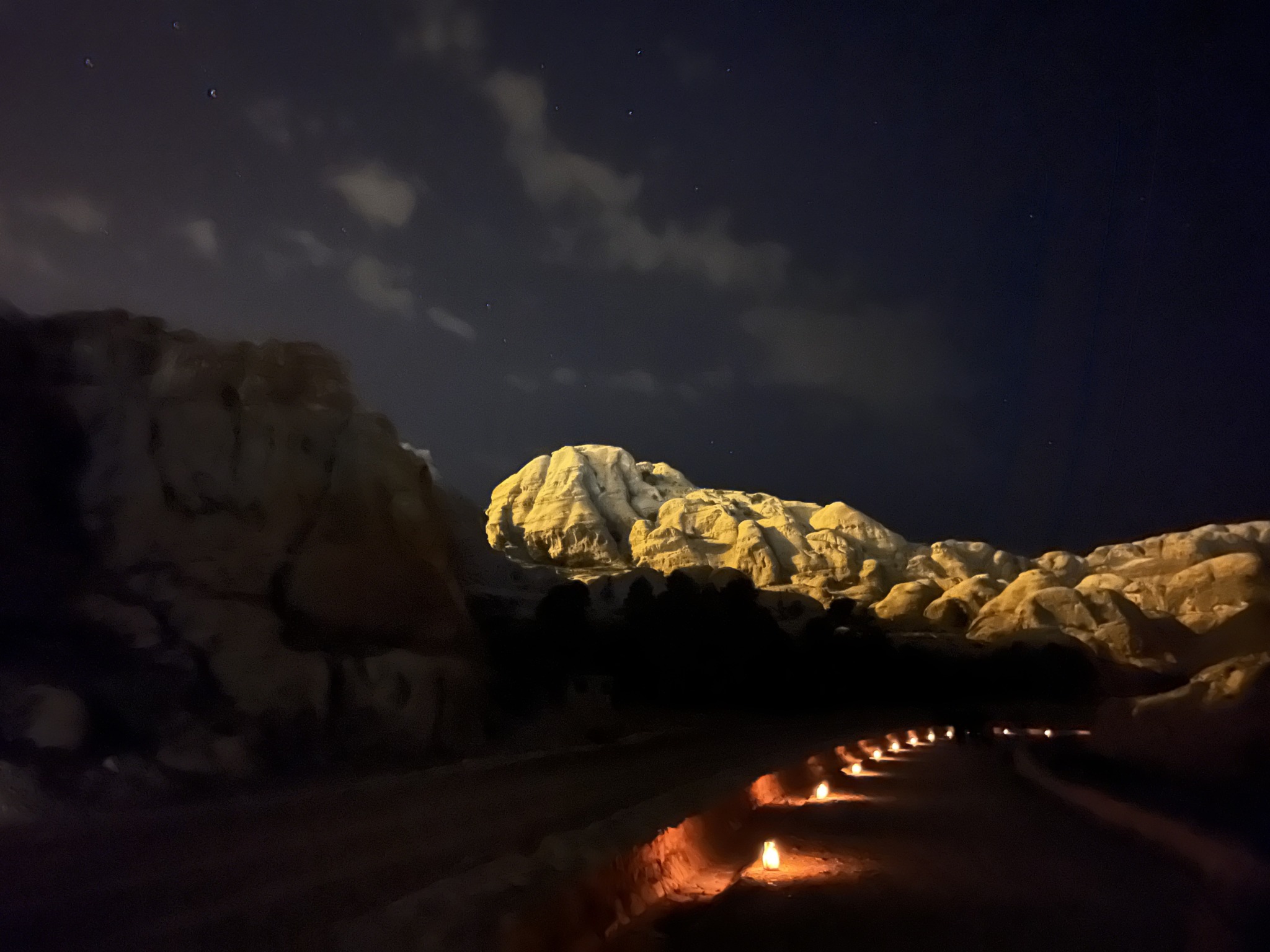
From the visitor center to the Treasury, more than 1,000 candles illuminate the path. The Treasury is lit up as the Bedouins play music for around 40 minutes before being told a brief history of Petra's development.
Not only is Petra a wonderful place to see, the history of the Nabataeans is fascinating.
Full guide to Petra here!
If you have extra time in Petra check out “ Little Petra ” also known as Siq al-Barid. It's an archaeological site located north of Petra and the town of Wadi Musa with smaller versions of buildings carved into sandstone.
We drove from Petra on to the Dead Sea and made some stops along the way. First was the Crusader Castle or Kerak , which was built in 1132 A.D.
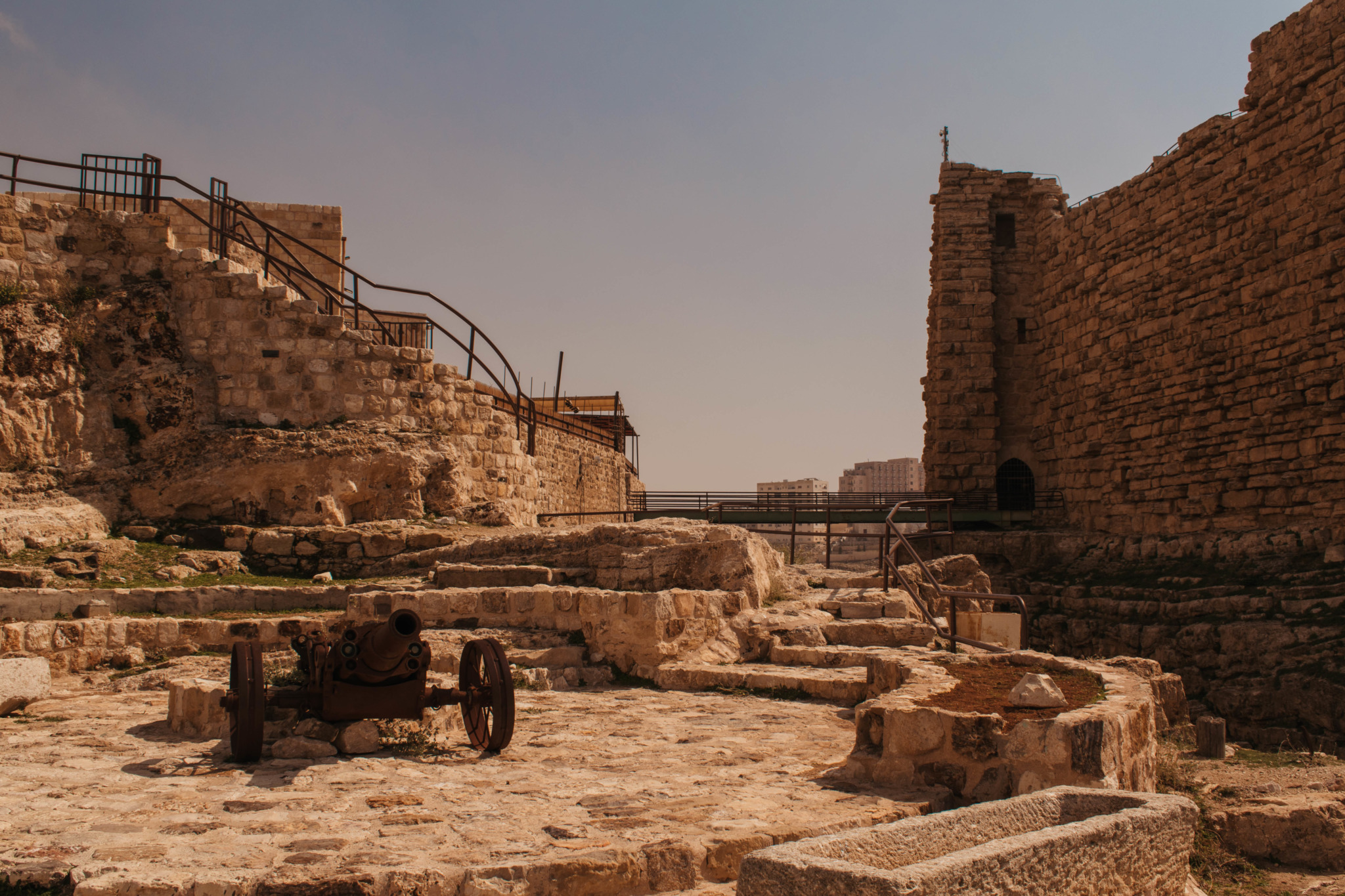
This fortified castle is one of the largest in Jordan, and gives stunning views. Built like a labyrinth, the castle held prisoners and you can walk through where they were held.
After exploring the castle we had lunch and then made our way to Wadi Mujib .
We had a quick stop at the “Grand Canyon of Jordan” with sweeping views and the wind whipping the cavernous gorge as it carves it's way down the the Dead Sea.
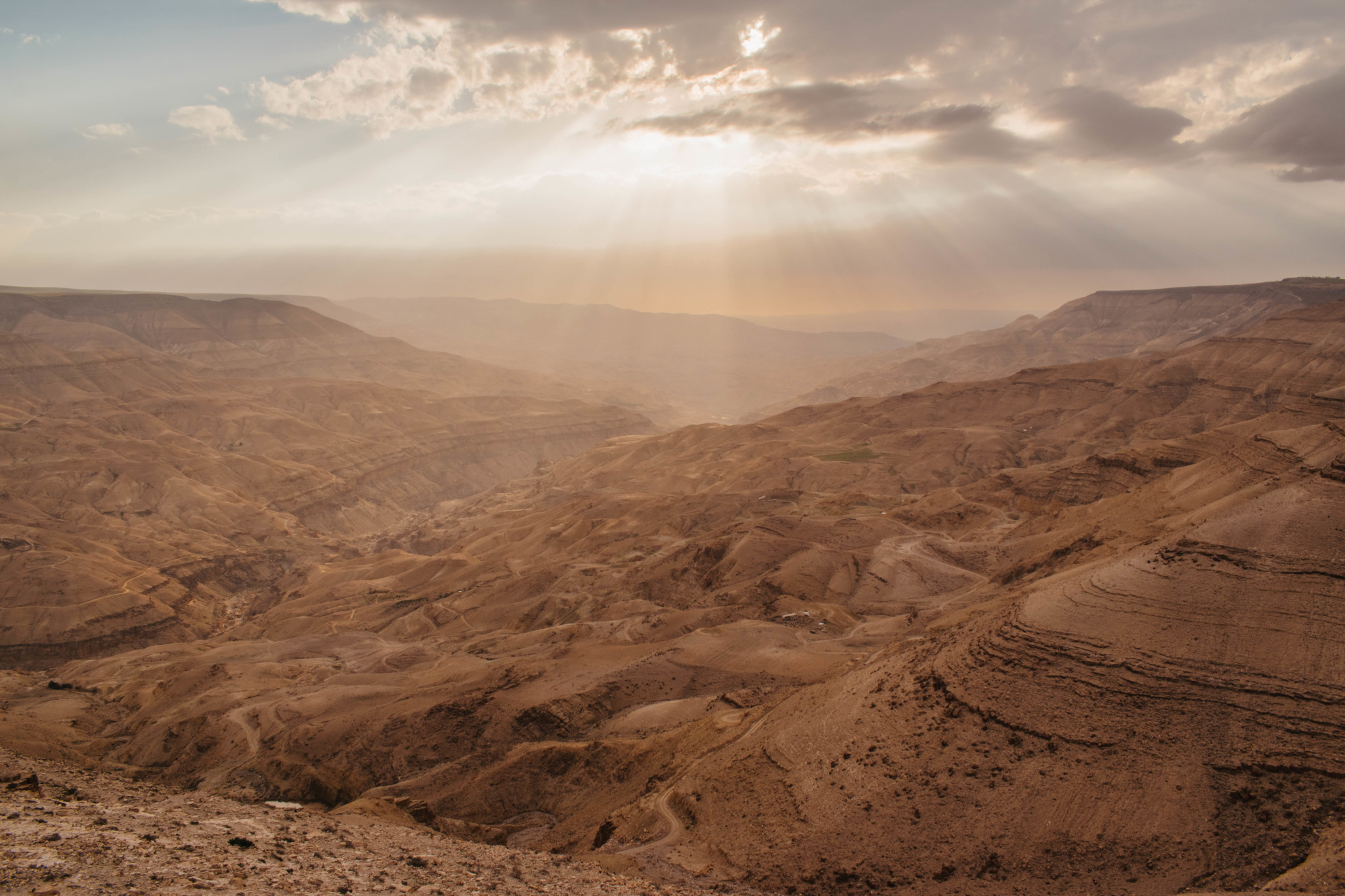
We arrived just in time for sunset and a dip at the lowest place on earth, the Dead Sea !
I absolutely love how Globus organized our Dead Sea experience. We stayed at a lovely resort: Movenpick Resort and Spa at the Dead Sea which gives you private beach access. Having gone to the Dead Sea in Israel, I can say this is a truly enjoyable experience.

Well, because the water is 34 salinity, super salty, nothing lives in it! But this also means you can easily float in it! You'll literally feel like a cork bobbing on top of the water. It's a sensation unlike anything else I've ever experienced. You can see me float in the Dead Sea here !
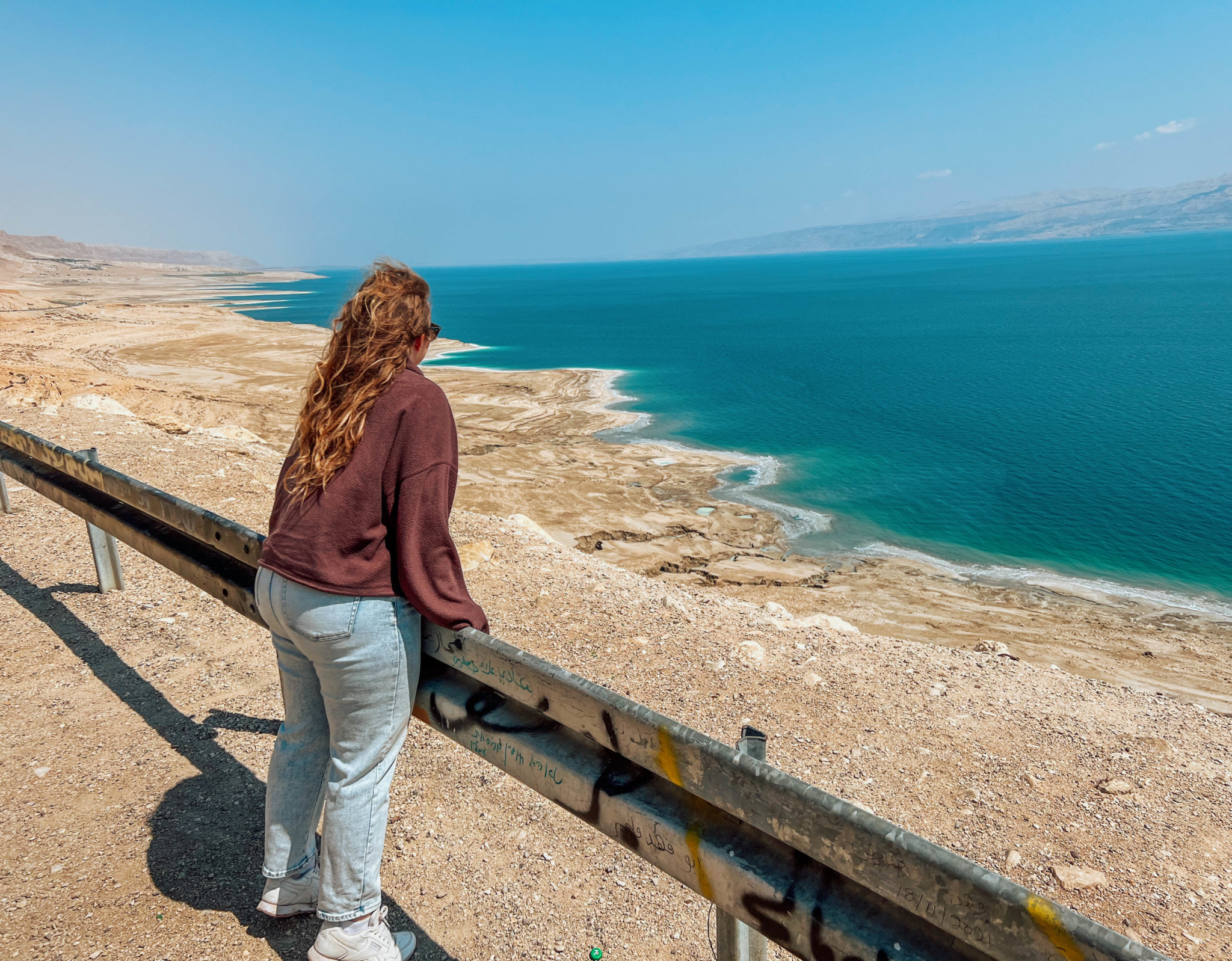
DO NOT: dive, splash, or get the water in your eyes. It will burn. I would also avoid getting it in your mouth. I recommend about 20 minutes at a time for a float because it can cause dehydration.
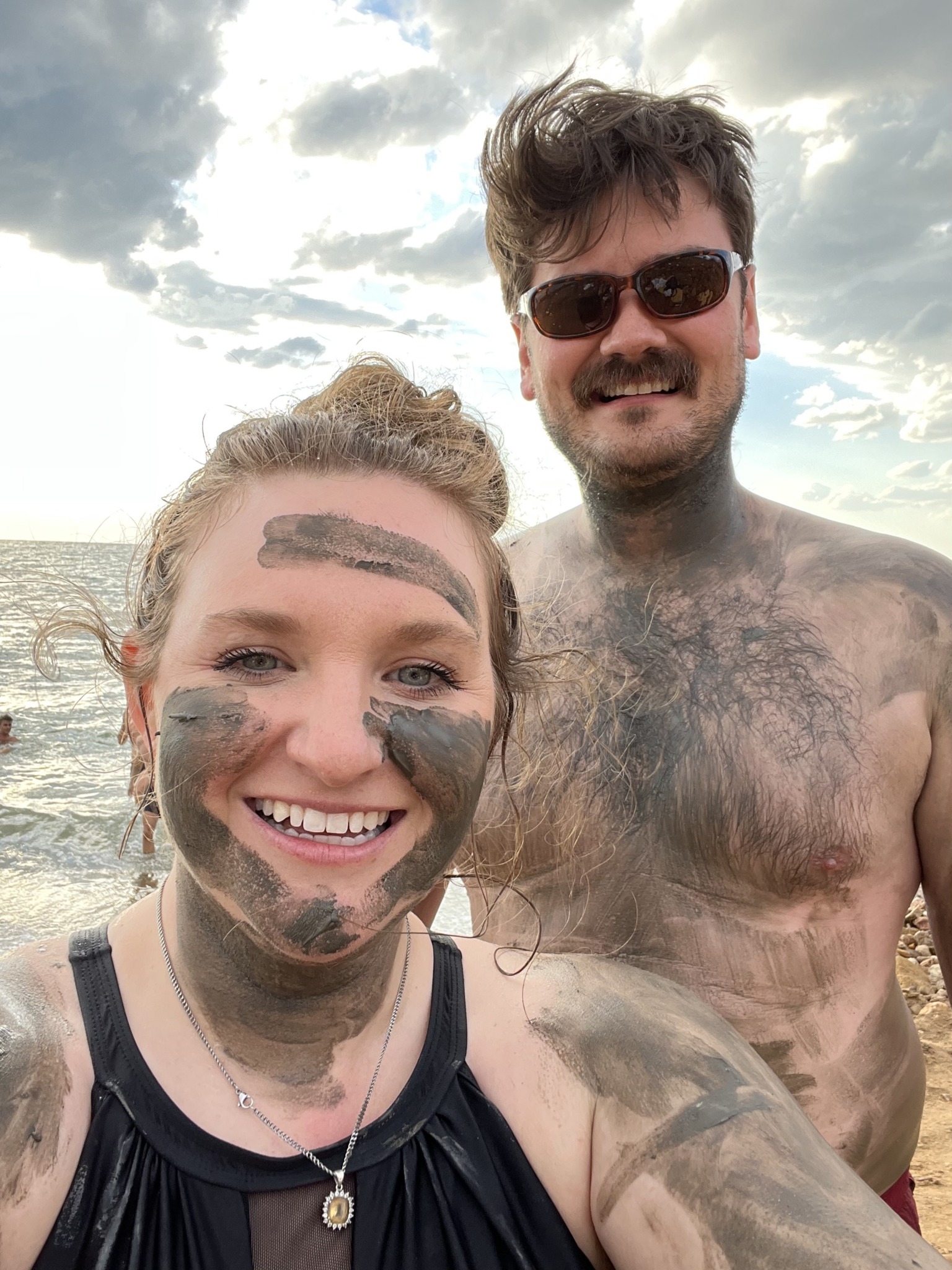
It's a bit tricky getting into the water as there are salt formations that can be tough on your feet. if you have water shoes or flip flops you can opt for that, or just walk in carefully like I did.
But don't be alarmed! The minerals are very good for your skin. I also recommend lathering up with some Dead Sea mud and enjoying the ritual of washing it off in the water. My skin felt so smooth after!
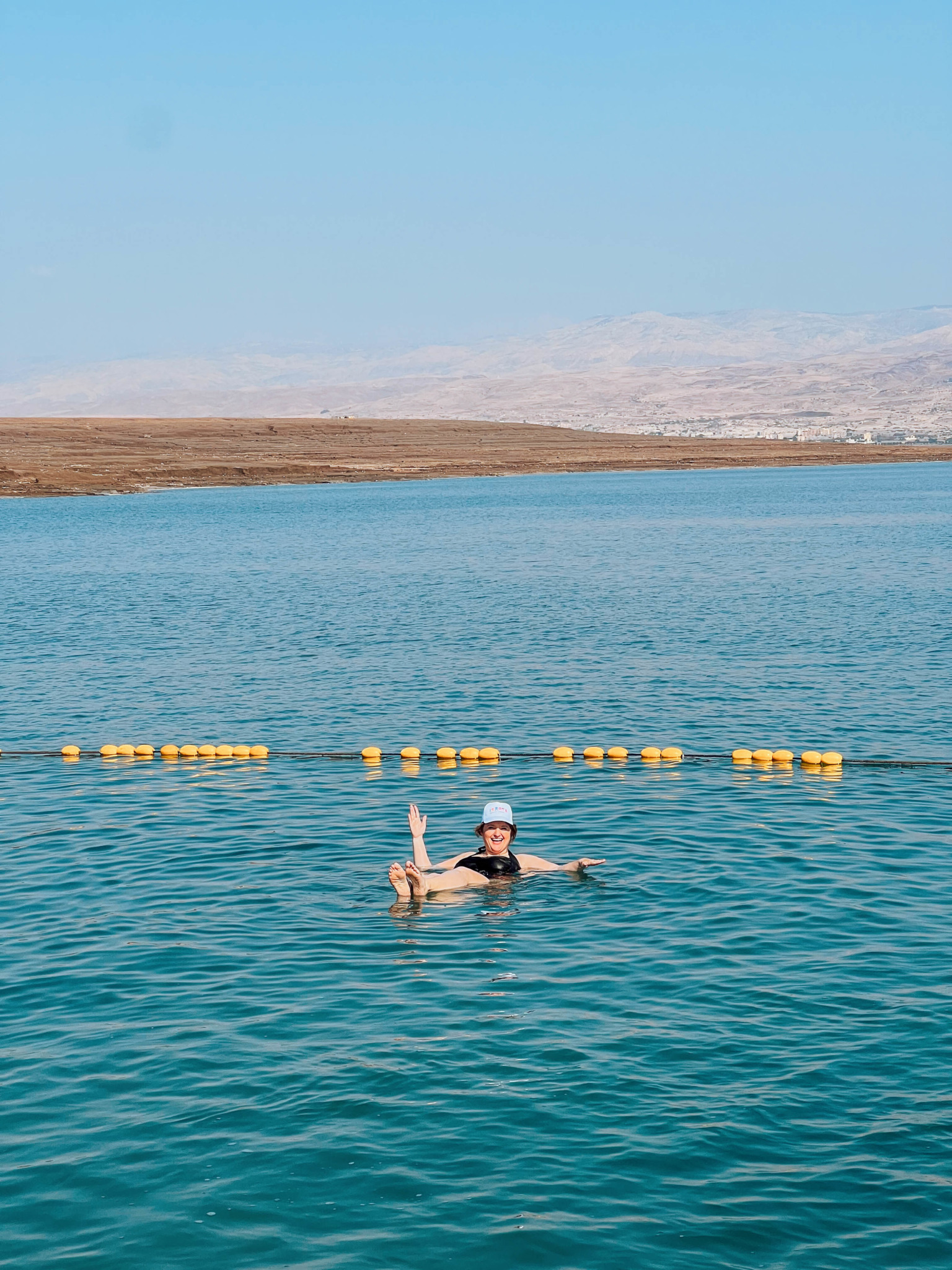
Where to stay at the Dead Sea : As I mentioned above, we stayed at the Movenpick Resort . This gorgeous, large hotel greets you with sweet tea and comfortable, spacious rooms. The highlight, of course, is your access to the Dead Sea. There are lifeguards here to help you enter the water – this was especially nice to not hurt my feet on the salt formations.

The resort offers pools, a spa, and many restaurants on the property. We had pina colodas and enjoyed sunset at the beach bar.
In the morning we had time for another dip in the Dead Sea, so mud up and go for it!
Then we headed to some of the most moving religious sites. I was excited to see the place where Jesus was Baptized and Moses saw the Promised Land , but it was really an emotional experience.
Whether you're religious or not, we've grown up with stories from the Bible and its historical significance has touched the world. To see it come to life was truly an experience. I was raised Catholic and going to these places and hearing the descriptions is unlike anything I've ever experienced before.
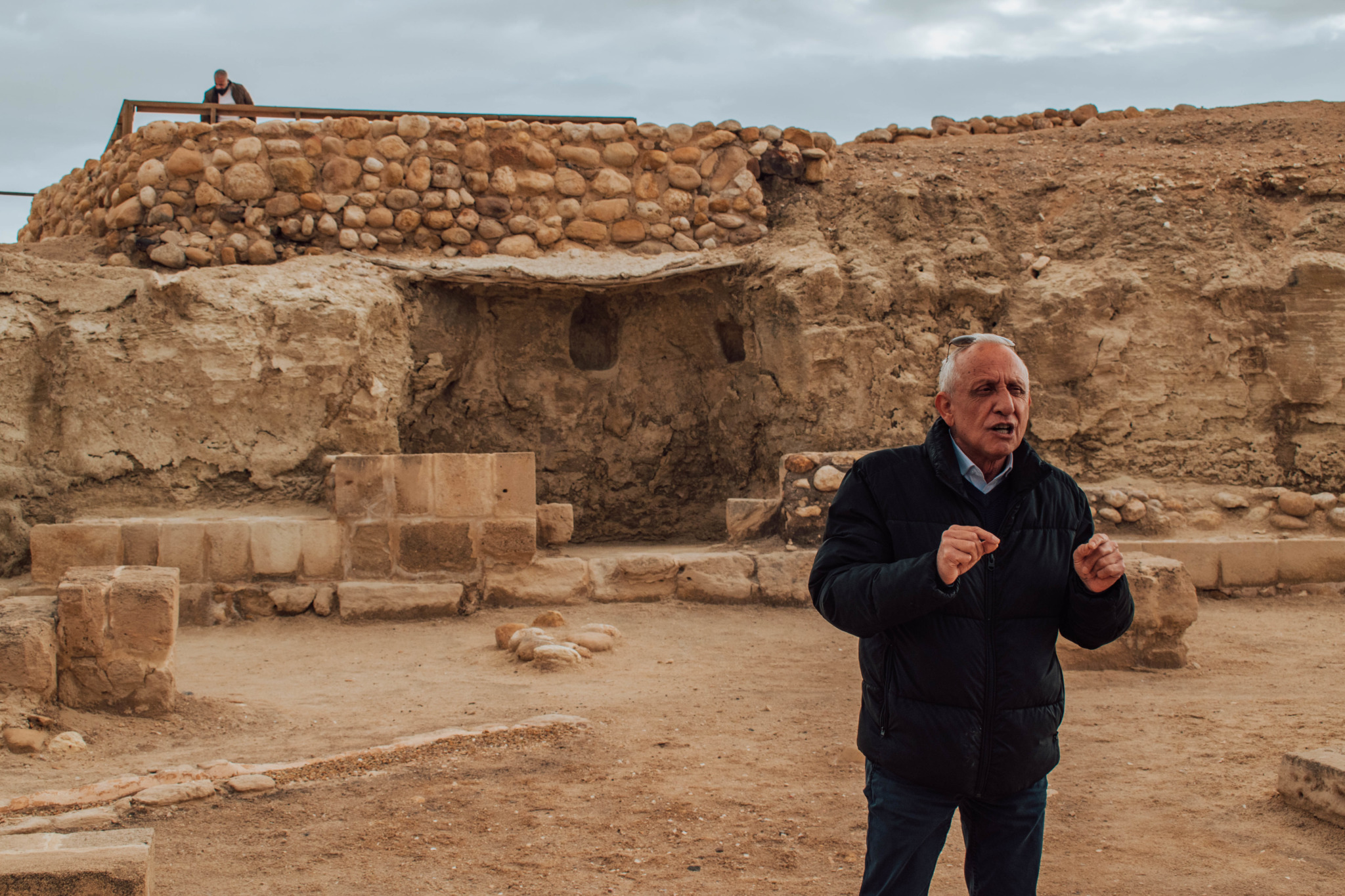
Our guide, Rustom Mkhjian, is the esteemed Director General of Bethany Beyond the Jordan , who shared an outpouring of love and enthusiasm for these sights. We saw the spot where Elijah was taken in to heaven in a chariot of fire, the spot where John the Baptist lived and performed miracles, and the place where John baptized Jesus in the Jordan River.
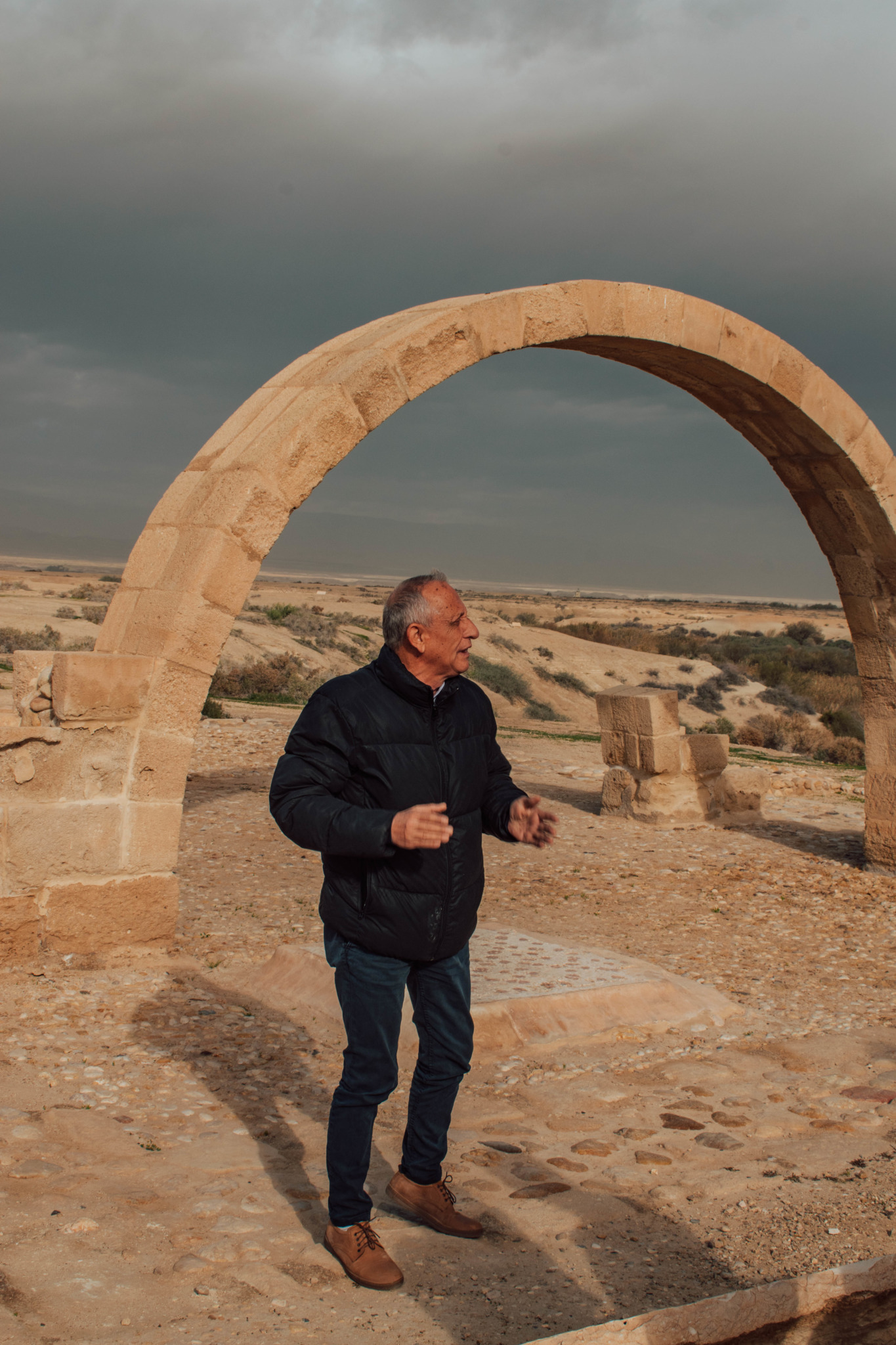
The baptism site of Jesus was particularly moving, and because there weren't any crowds we got to go down and touch the water.
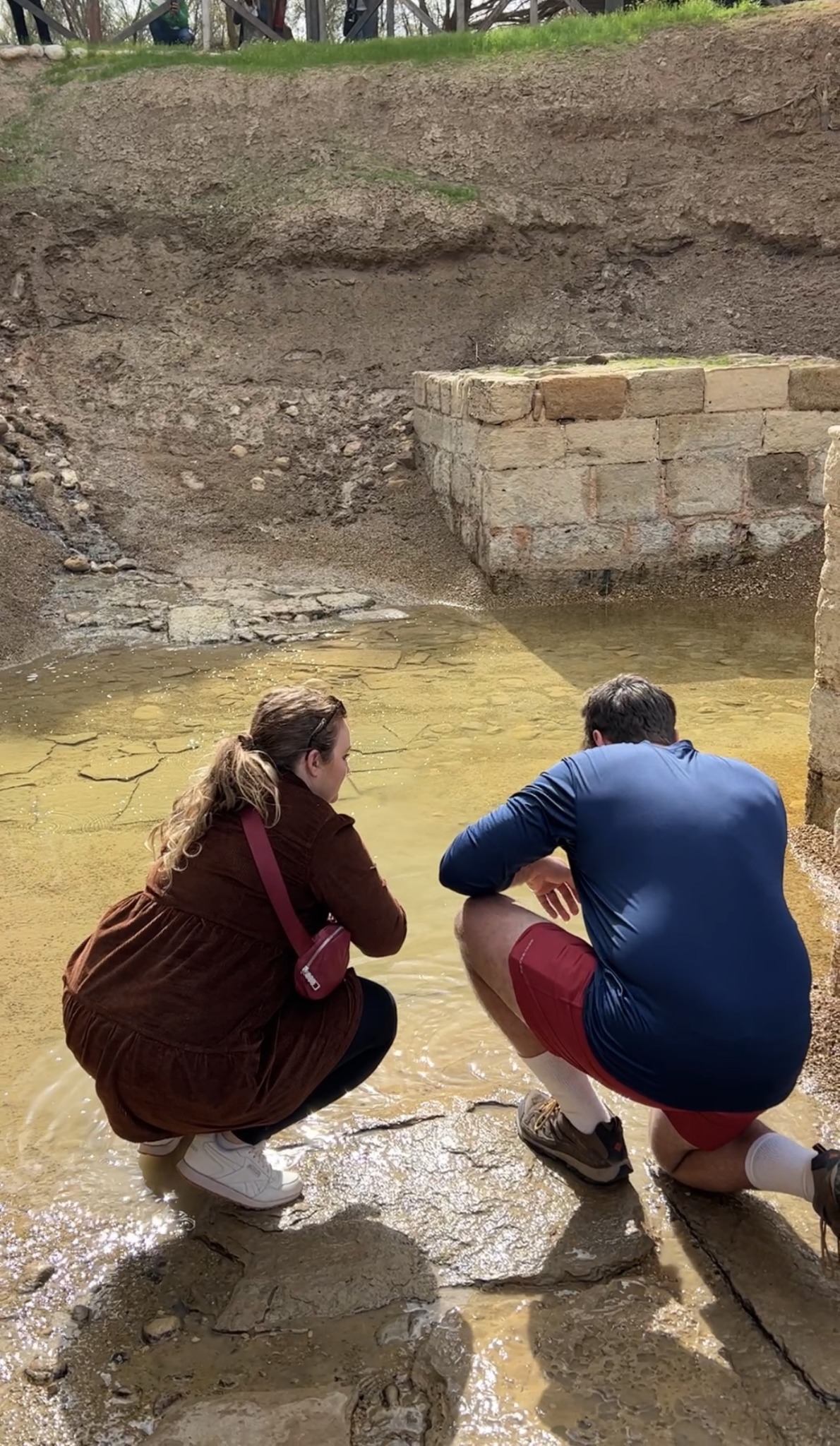
At the Jordan river you can see the border of Israel and you feel a certain kind of significance standing here. I also recommend stepping inside the Greek Orthodox St John the Baptist Church.

Next, we took a short drive to Madaba to see the world's oldest map of the Holy Land on the floor of St. George's Church. Known as the City of Mosaics the incredibly numerous mosaics lay untouched for over 1,000 years until they were uncovered when a new building project was started.
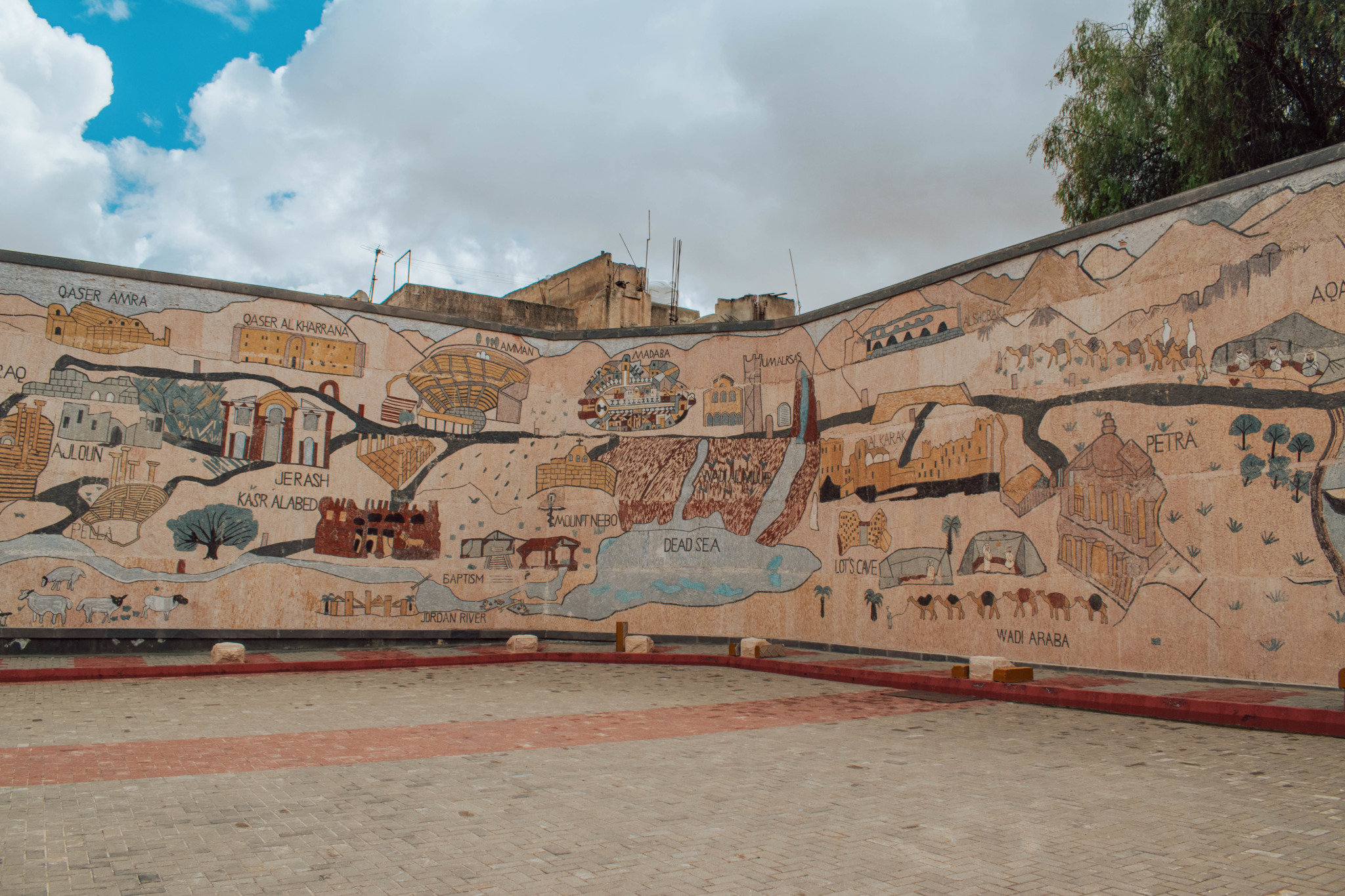
The Madaba Archaeological Park and Museum contains the ruins of several Byzantine churches, as well as the stunning Madaba Mosaic Map and the Hippolytus Hall, part of a 6th century mansion.

From here, we went to St. George's Church to see the mosaic map of Jerusalem of the floor in the church. The Mosaic Map was created in the 6th Century to help pilgrims get around the Holy Land. The Holy Land's sites are shown throughout Jordan, Israel, the Palestinian Territories, and Egypt's Sinai in detail. This helps prove the location of Jesus' baptism.
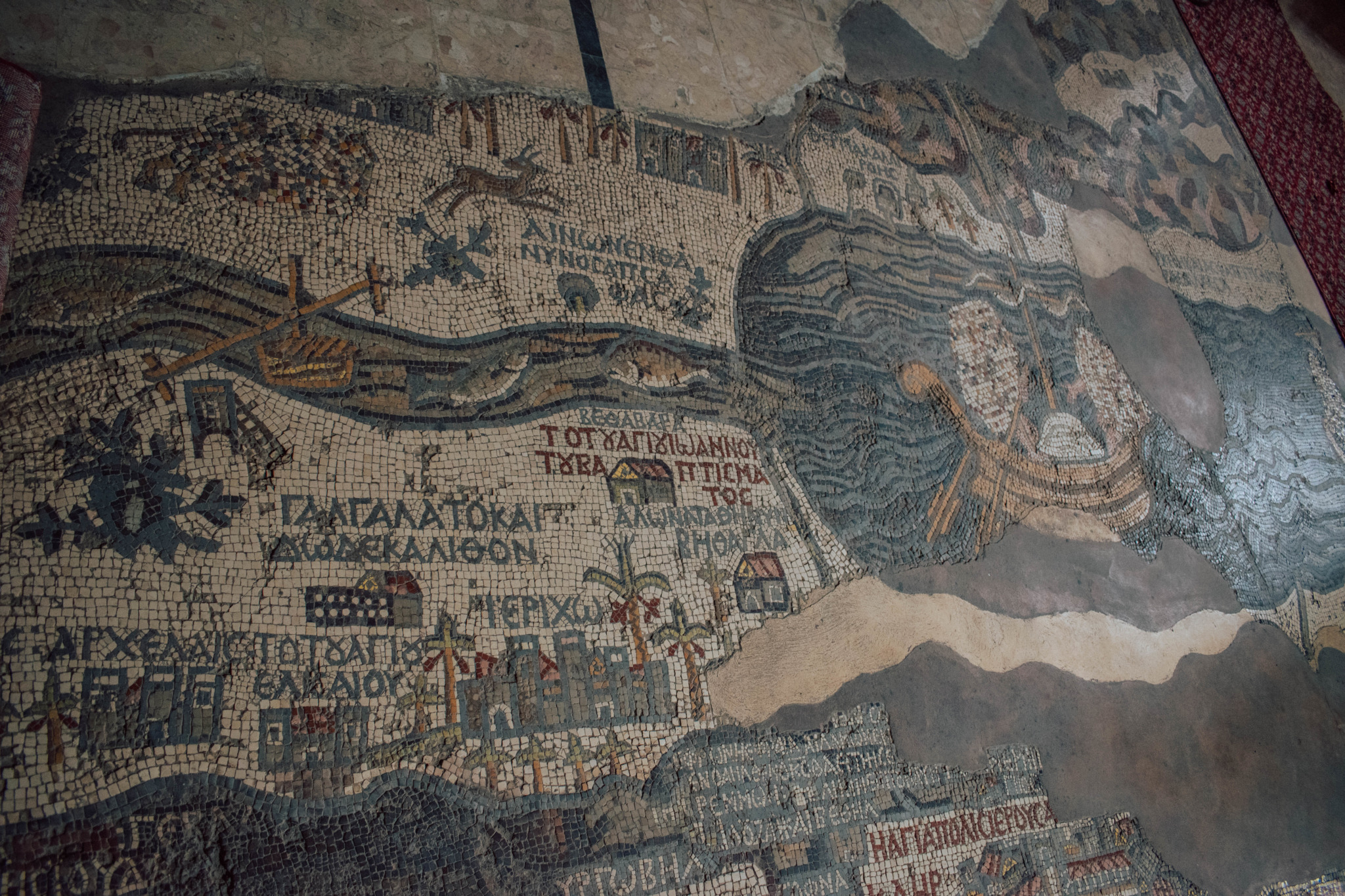
From the mosaics in Madaba, we made our way to Mount Nebo . This is where Moses surveyed the Promised Land of Canaan. God prohibited him from proceeding any farther, and he died before leading his people into it, according to the scroll. It is claimed that Moses was buried in this area, but no one knows exactly where it is.
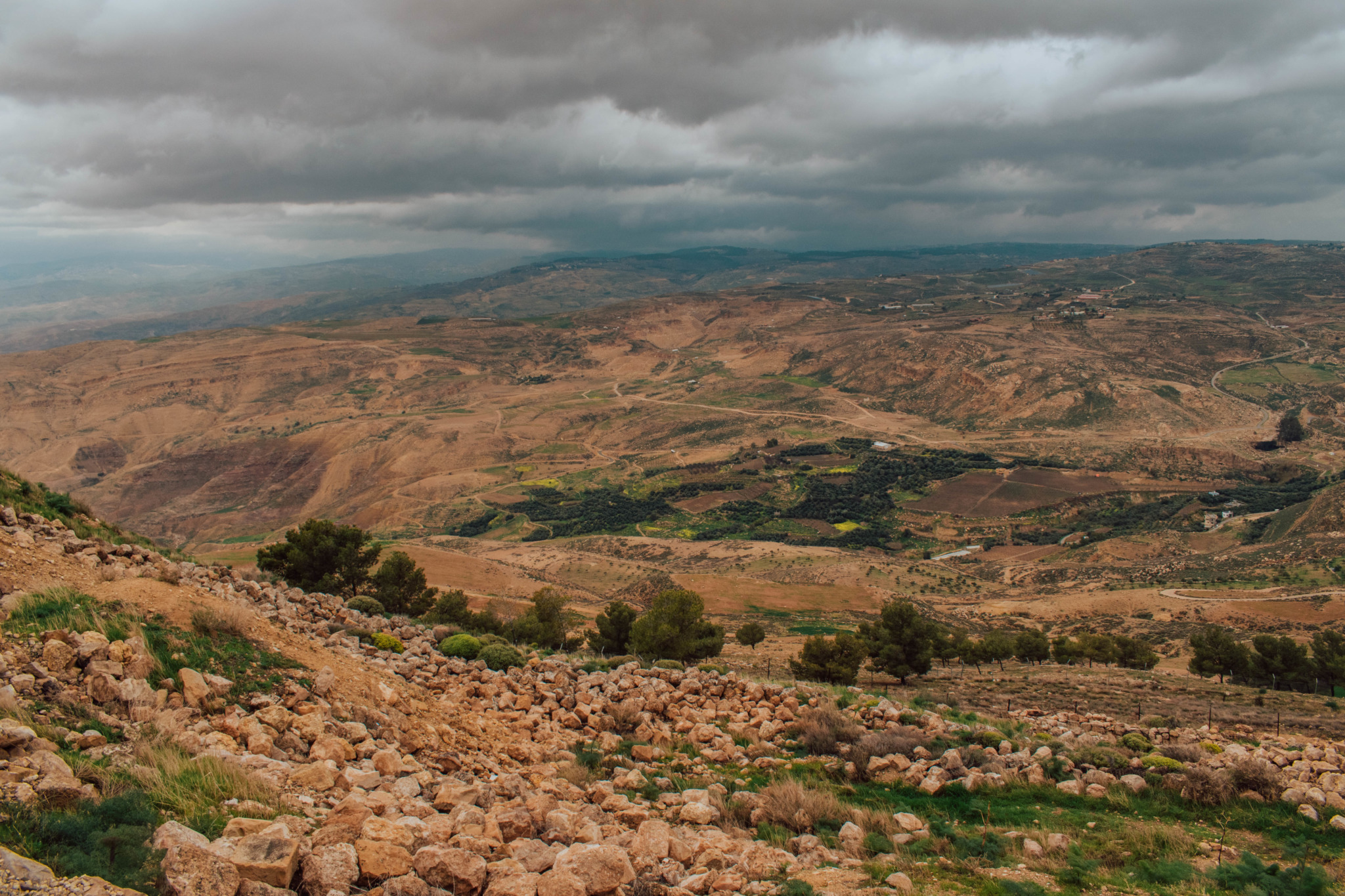
After a long day of touring, we headed back for our last night at the Dead Sea and one more sunset.
Globus arranges your easy transport back from the Dead Sea to Amman. It's about an hour's drive.
Our flight was early and Globus arranged to have a boxed breakfast ready to go. We had plenty of time to get to the airport and head home after a fabulous trip. You can check all the Globus Escape tours right here .
Of course there's more to see in Jordan. If you have time, you can extend your time in the desert at Wadi Rum or take more time in Petra. Also Aquada is a place to see the Red Sea and, if you're up for it, go diving.
This was a whirlwind tour of some of Jordan's most incredible sites. I hope this travel guide helps you plan your one week itinerary (or more!) for Jordan! I highly recommend making your trip easy with Globus !

This post is in collaboration with Globus, but all opinions are my own.
MEET THE AUTHOR
Helene Sula
I believe that one trip can change your life. It did for me. I'm a self proclaimed home body that quit her job, moved abroad, and more often than not, lives out of a carry-on bag. If I'm not traveling, I'm most likely re-reading Harry Potter or watching "Midnight in Paris" while snuggling my dogs. I'm a digital marketing expert who turned my love of travel into a full-time career. And I help others do it too.
Related Posts
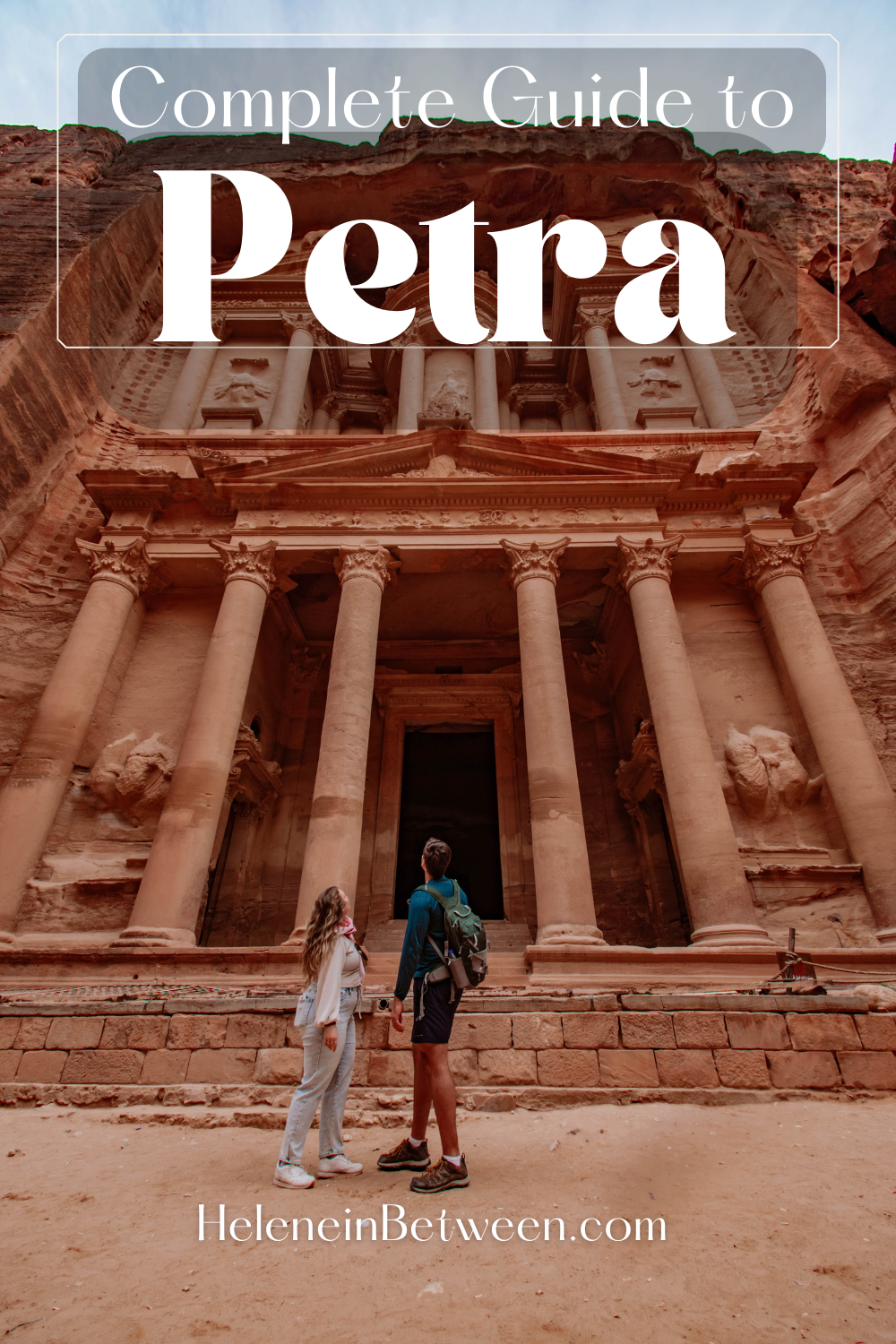
DO YOU LOVE STORIES?
Let me tell you a good one. I share behind the scenes travel mishaps and adventures on the road.
You're on the list! YAY! Please check your email to confirm your email.
There was an error submitting your subscription. Please try again.
Helene in Between Courses

- Instagram Content System
Easily manage your content while finding captions that WORK for you.
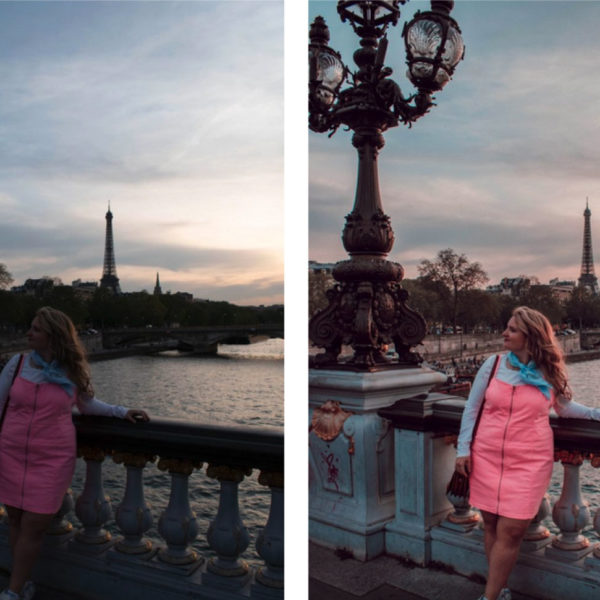
- The Lightroom Vault
140 presets + ALL the skills you need to edit like a pro.

- The Convert Course
Learn how to turn readers into followers + blog post templates
Join 560k+ Instagram Followers
Real life, attainable travel & inspiration to #livealittle at @heleneinbetween

Choose a Destination
Asia Austria Belgium Canada Denmark Estonia Europe Finland France
Quick Links
- Buying a Camera Guide
- Free Lightroom Presets
- Travel Tips
- Shop My Looks
The ultimate guide to tipping in the Middle East
Sep 27, 2024 • 3 min read

Whether you're in Qatar or Jordan, expect to tip in the Middle East. Getty Images
Tipping is an elusive custom that seems to change its rules across the globe – what is deemed a generous token of appreciation in some countries can offend the subtle cultural sensibilities of others.
When it comes to the Middle East , tipping is generally customary across the region. How much you tip largely depends on the country you’re in and the service being provided. Due to always-changing conversion rates, the below dollar amounts are in USD, unless otherwise specified.
Restaurants and bars
In the UAE , Qatar , Jordan and Saudi Arabia , servers in restaurants will expect a 10 to 15% tip at the end of a meal. Even in Dubai , where the government mandates 10% being added to bills at restaurants, hotels and bars, waitstaff will still expect a tip of up to 15%, or even 20%.
Hotel staff
Dubai’s government-mandated 10% service charge at hotels means that tipping is primarily reserved for those who are feeling particularly flashy. In the rest of the UAE, concierges expect a tip for significant requests, like securing a table at a popular restaurant or organizing a tour – between 110 and 130 dirhams should suffice. Tip porters around 7 dirhams per bag, and housekeeping staff around 10 to 11 dirhams per day.
In other popular Middle Eastern holiday destinations including Jordan, tip the local currency equivalent of $1.50 per bag (JD1 in Jordan) for porters, the same per day for housekeeping, and around $2 to the concierge for small favors if you require them.
Tour guides
In Dubai, the rest of the UAE and Qatar, tipping a tour guide or a private driver 10% of the booked service is a good way to go. After an excursion in other popular tourist countries in the Middle East, including Jordan, a slightly larger tip of between $25 to $35 (in local currency) for guides and $35 to $45 for driver guides is appropriate according to service, though 10% is often expected.
Taxi drivers
Dubai taxi drivers don’t expect tips, but round up the fare if you’re feeling generous. In most other Middle Eastern countries, including the rest of the UAE, Qatar and Saudi Arabia, tip taxi drivers around 10 to 15% of the overall fare. In Jordan, round up to the nearest dinar.
How much should you leave when visiting a mosque or a temple?
There isn’t really a hard-and-fast rule here, but try leaving the local currency equivalent of $1 to the person handing out robes and scarves to women, and 50 cents to the person who minds the shoes if there is one.
When should you give baksheesh?
When traveling in the Middle East and South Asia, you will often be asked for "baksheesh." The term often applies to a simple gratuity or service charge but can refer to all kinds of financial tokens of appreciation. If someone asks you for baksheesh without providing a service, this is considered begging, and so giving money is completely at your discretion, although not usually advisable. Baksheesh can be politely asked for by those who have provided a service, but it can be refused at any time and – like almost all tipping customs – is not mandatory, whatever you may be led to believe.
Explore related stories

Sep 22, 2024 • 6 min read
Luxuriate in the second annual ranking of The World’s 50 Best Hotels for 2024.

Sep 21, 2024 • 13 min read

Sep 4, 2024 • 14 min read

Aug 7, 2024 • 10 min read

Aug 1, 2024 • 11 min read

Jul 29, 2024 • 6 min read

Jul 27, 2024 • 4 min read

Jul 18, 2024 • 7 min read
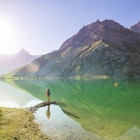
Jul 18, 2024 • 6 min read

Jul 17, 2024 • 8 min read

IMAGES
VIDEO
COMMENTS
Jordan. Middle East. From the ancient city of Petra to the breathtaking Dead Sea and sublime desert landscapes of Wadi Rum in between, Jordan has delighted visitors for centuries. Best Time to Visit. Best Places to Visit.
Rough Guides® is a trademark owned by Apa Group with its headquarters at 7 Bell Yard London WC2A 2JR, United Kingdom. Plan your visit to Jordan: find out where to go and what to do in Jordan with Rough Guides. Read about itineraries, activities, places to stay and travel essentials and get inspiration from the blog in the best guide to Jordan.
In this free guide, you will learn how to travel Jordan with confidence and discover the best places to visit. Discover more. Local Recommendations Experiencing Bethany Beyond the Jordan. Bethany Beyond the Jordan, a peaceful holy site, is a rare exception. A meditative place that is perfect for contemplation, exploration, and learning, this ...
Jordan is a relatively safe place to travel, with a very low violent crime rate from the UN of 1.6 per 100k inhabitants (75% lower than the global average). Attitudes toward foreigners are welcoming. I'd still recommend you try to avoid crowds and practice situational awareness; terrorist attacks have occurred near some tourist areas in Jordan over the years, but it's not common.
Day 4: Wadi Mujib & Dana Biosphere Reserve. Start day 4 of your 10-day Jordan itinerary by arriving early at Wadi Mujib. This popular spot draws tourists from around Jordan - and the world. Early arrival is a must, as there are no reservations to access the biosphere for canyoning.
If you are planning to visit Petra I recommend choosing the Jordan Pass. If you would choose to buy the one-day Petra ticket separately, it would cost you 50 JD ($70 US). You would pay another 40 JD ($56 US) for the visa, so your total cost would be 90 JD ($126 US). The cheapest option of the Jordan Pass is 70 JD ($100 US) and it already ...
8. Bring a reusable filtration water bottle. Tap water is usually not drinkable in Jordan, though some higher-end hotels have their own water purification systems. Environmental education and recycling facilities are scarce, and you will see plastics and other rubbish littering the otherwise lovely landscapes.
Local Customs. Greetings: When it comes to greetings in Jordan, you will often see men hugging and cheek kissing (at least twice!) and women will often do the same. However, you will rarely see men and women in such an embrace. Shaking hands between men and women is totally fine.
5. Madaba. Best place for ancient Christian sites. Just 20 minutes from Queen Alia International Airport, Madaba is a convenient and quiet place to rest your head on arrival in Jordan. A friendly and welcoming town for visitors of all faiths, Madaba is home to one of the largest Christian communities in Jordan.
Jordan Travel Guide As one of the most-visited Middle Eastern countries, Jordan offers an unparalleled blend of rich culture, ancient historical sights, and incredible natural landscapes. Throughout history, the Kingdom of Jordan has remained stable and untouched by the political climates of the Middle East, making it a great introduction for ...
Expect to pay around $5 USD for a non-alcoholic beverage at a nice restaurant, and upwards of $30 for a bottle of wine. You'll also find accommodations are pretty expensive and you don't have ton of options in places like Petra or the Dead Sea. Most places run around $150-$200 a night. Jordan was my first-ever trip to the Middle East.
How to Plan the Best Jordan 5-Day Itinerary (2024) Even before my first trip, I knew Jordan was a bucket list destination. Some of my own bucket list goals were in Jordan - thanks to pop culture and my desire for unusual and light-adventure destinations. But for a bucket list destination, Jordan is also quite distant for many travelers ...
Start Your Journey Now. 5-Day Jordan Highlights Tour: Amman, Petra, Wadi Rum & Dead Sea Adventure. Dive deeper into Jordan's cultural and natural wonders with this 5-day tour. Experience the vibrant city of Amman, explore the majestic Petra, ride through the dramatic desert of Wadi Rum, and relax at the Dead Sea.
Explore local culture with an Jordan tour guide through these unique excursions: Wadi Mujib Siq Trail Hiking Experience from Amman. Petra & Wadi Rum from Aqaba. Private Tour Madaba, Mount Nebo, and Dead Sea Day Trip with Amman Sightseeing from Amman. Bethany Baptism Jordan River Site and As-Salt City Visit from Amman.
Travel Guide / Jordan; Jordan Travel Guide. There's rarely a traveller that leaves Jordan unimpressed by its sights or unmoved by its people's virtues. Best-known for its centrepiece, the archaeological site of Petra, this Middle Eastern nation is breathtaking in both its golden desert attractions, epic experiences and open hospitality, so ...
WELCOME TO. JORDAN TOURISM BOARD. Please Select Language / Region. Select English - International English - North America عربي Deutsch Italiano.
Money in Jordan. The Jordanian unit of currency is the dinar, abbreviated to JD (or JOD). Most people refer to the dinar as a "jaydee" or a "lira". One dinar is divided into 1000 fils or 100 piastres (qirsh). Locals always think in piastres; they only refer to fils when talking to foreigners.
Bookmark these Jordan travel itineraries and this Jordan travel guide on Pinterest to read later. 10 day Jordan Itinerary. With 10 days in Jordan, you can expand some of the stops on the 7 day Jordan itinerary but follow the same basic loop of the plan. Spend a night in Wadi Rum, two in Petra and in the warmer months, head further south to Aqaba.
Get your detailed 10-day itinerary (plus 7 and 3 day express journeys) for just $19.99. Get it Now! This detailed digital Jordan Itinerary Guide is delivered immediately to your email inbox. If you have any questions about this itinerary, please contact me at [email protected].
Guidebooks. Our worldwide travel correspondents bring you the best and most up-to-date coverage of over 7,500 global destinations. Get information on Jordan Travel Guide - Expert Picks for your ...
Jordan's weather is at its loveliest from late March to April, when wildflowers dot the briefly green countryside. Between June and August, daytime temperatures can soar, making sightseeing tough-although in recent years, with the onset of climate change, the weather has been less predictable and milder temperatures have been registered ...
Jordan (Arabic: الأردنّ, al-Urdunn) is an Arab kingdom in the Middle East, at the crossroads of Asia, Africa and Europe. Jordan has been repeatedly called an "oasis of stability" in the Middle East. Since the 1940s, millions have immigrated to Jordan for a better life.
Perfect Jordan Itinerary and Travel Guide - Helene in Between. I share behind the scenes travel mishaps and adventures on the road. Lifestyle and Travel blog helping Bloggers Succeed Online. Jordan, with its spectacular desert scenery, fascinating archeological sites, delectable cuisine, and fair weather, is one of the best places to explore in ...
Tour guides. In Dubai, the rest of the UAE and Qatar, tipping a tour guide or a private driver 10% of the booked service is a good way to go. After an excursion in other popular tourist countries in the Middle East, including Jordan, a slightly larger tip of between $25 to $35 (in local currency) for guides and $35 to $45 for driver guides is appropriate according to service, though 10% is ...